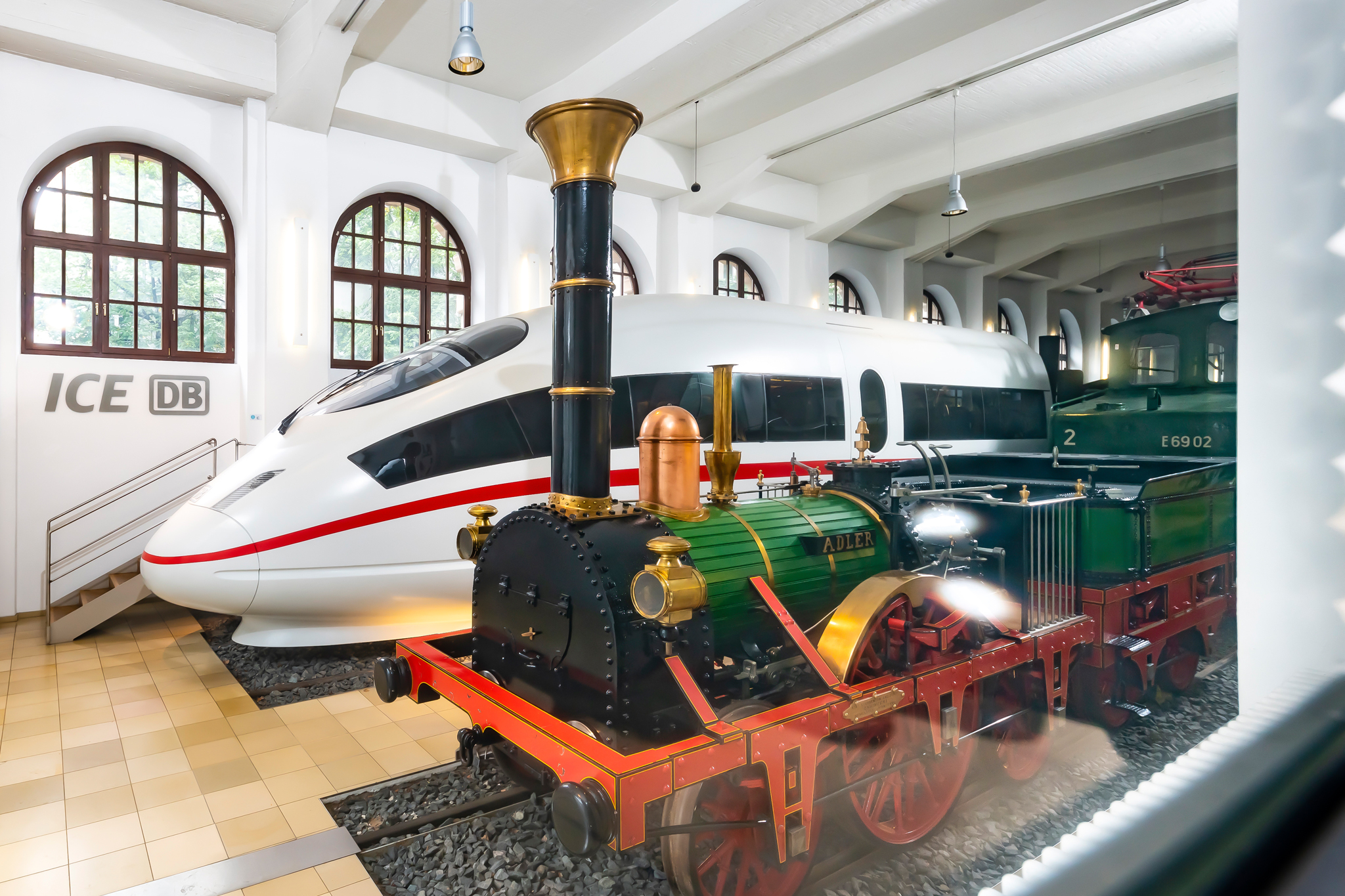

The history of the railway in Germany
Permanent exhibition.
Since Oct 2005
Across two floors, we take you on a journey through more than 200 years of railway history and its relationship with technology, economy, society and culture.
Germany's rail history started modestly: the country's first line, which ran between Nuremberg and Fürth and opened in 1835, was just 6 km long. The "Adler" – the locomotive imported from Britain to operate the line – introduced a new means of travel to an astonished public: fast and comfortable, affordable for all and extremely profitable for the railway pioneers. It was from here that the triumphant advance of the railway began, transforming society, landscapes and cities from the ground up and catapulting Germany from an agrarian society into the industrial age. As the world entered the 20th century, this new transport system entered its golden era, an age of magnificent station buildings and powerful steam locomotives. A wealth of fascinating original objects and models vividly illustrate this development. This epoch came to an end with the First World War, whose brutal battles with hundreds of thousands of casualties were enabled not least by the new means of mass transport that the railway provided.
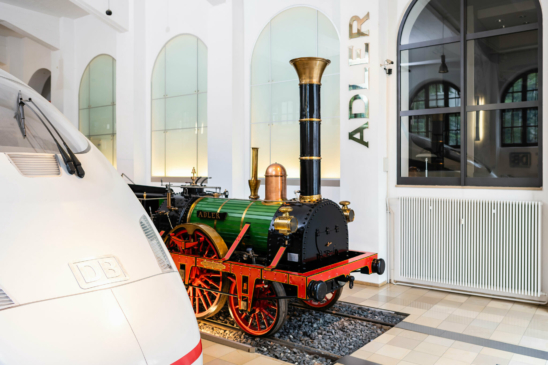
Four years of war exhausted the resilience of Germany's railways. With the creation of the Deutsche Reichsbahn (German State Railway) in 1920, which was re-established as a privately operated enterprise named Deutsche Reichsbahn-Gesellschaft in 1924, Germany's new democratic government hoped to enable the urgently needed renewal of infrastructure and rolling stock. In addition, the Reichsbahn's profits were earmarked to pay war reparations to the victorious powers. The "Golden Twenties", a brief flourishing of technological progress and economic growth, was followed by the darkest chapter in German railway history: the Reichsbahn's role in the crimes of National Socialism. Films and original objects show how rapidly the company was gripped by Nazi propaganda efforts and organisational changes. Documents and eyewitness accounts reveal how the Reichsbahn willingly enabled the Holocaust with the deportation of millions of Jews, Sinti and Roma to the extermination camps.
In 1949, the Federal Republic of Germany (West Germany) and the German Democratic Republic (East Germany) were founded, and it became inevitable that Deutsche Reichsbahn, the German national railway, would be split into two companies. In the West, the newly founded Deutsche Bundesbahn had to hold its own against growing competition from private cars; in the East, where the "Deutsche Reichsbahn" name was retained, the railway was an integral part of the socialist planned economy. This area of the exhibition features numerous interactive and audio-visual elements, such as the stories of contemporary witnesses or the device used by the Bundesbahn to test drivers' reaction speeds. Museum visitors are taken on an exciting journey of exploration through the decades from the end of the Second World War to the epochal fall of the Berlin Wall in November 1989 – a period marked by the German economic miracle, the Cold War, huge technological progress and the railway's loss of dominance.
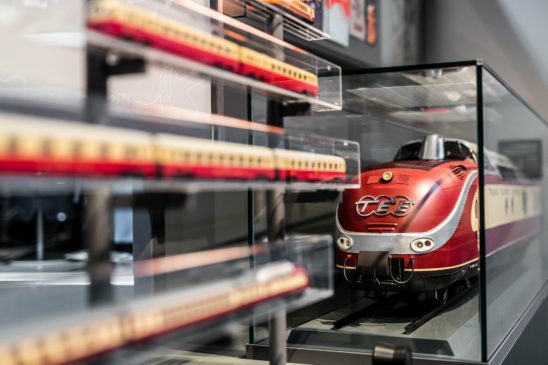
A futuristic-looking room, entirely in Deutsche Bahn's trademark red colour scheme, houses the final stage of the journey through 200 years of railway history. This area explores the changes that followed German reunification. Accompanied by era-defining trends such as digitalisation and globalisation, a modern, privately managed company, Deutsche Bahn AG, was created in 1994 from the two ailing state railways in East and West. The introduction of high-speed ICE trains and the "station renaissance" along with digital services such as online tickets and mobile apps have opened up new ways to attract customers. The exhibition does not shy away from more problematic aspects of recent railway history, such as the closure of branch lines or the controversy surrounding the major Stuttgart 21 project.
Download our App
- Apple App Store
- Google Playstore
Visit the DB Museum
Address & information desk.
Deutsche Bahn Stiftung gGmbH DB Museum Lessingstrasse 6 90443 Nuremberg
Opening hours
Tuesday to Friday 9 to 17 o'clock Saturday, Sunday, holidays 10 to 18 o'clock Monday closed
Admission prices
More exhibitions.
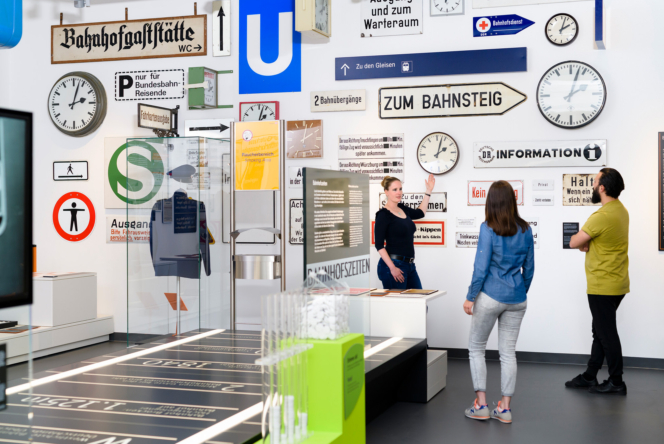
Bahnhofszeiten
Since May 20
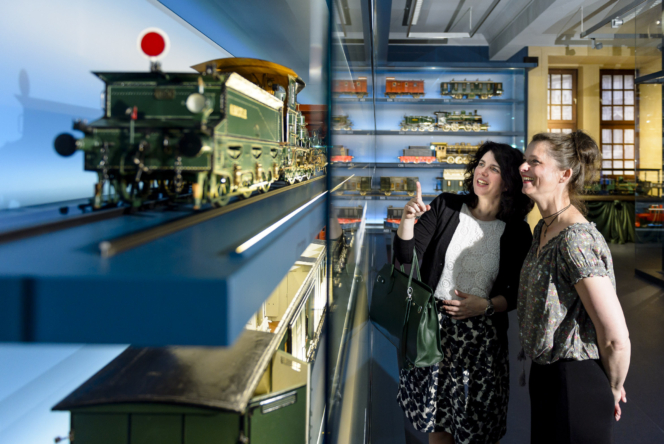
Modellarium
Since Apr 15
- I'm looking for...
- Information
- See all InTrans staff
- View completed research projects
- View in-progress research projects
- Browse research reports and tech transfer summaries
- Learn about InTrans
- Our focus on infrastructure
- Our focus on Safety
- Our focus on mobility, data analytics and resiliency
- Our focus on construction management
- Our focus on outreach and education
- Find contact and location information
Institute for Transportation
InTrans | News
InTrans / Aug 16, 2016
Trains: A history
Go magazine.

Over 200 years ago, when locomotives were first being developed, people worried their speed would make passengers “unable to breath” or that “they would be shaken unconscious by the vibrations.”
But today we’re all the wiser. In fact, did you know that there are trains traveling at speeds well over 300 miles per hour (mph)?
Clearly, trains have changed dramatically since they first took to the rails. Like any other mode of transportation, trains, as we know them today, have been centuries in the making!
So, where did it all begin?
Today, it’s relatively simple to purchase a train ticket and travel freely—depending on what part of the world you’re in. But where did it all start? Is it possible to imagine how far we’ve come since then? Let’s try.
Railways existed as early as 1550, in Germany. These pathways of wooden rails called “wagonways” were the beginning of modern rail transport, making it easier for horse-drawn wagons or carts to move along dirt roads.

By the late 1700s, iron replaced the wooden rails and wheels as wagonways evolved into “tramways” and became popular throughout Europe. Horses still provided the “horsepower” for cargo until the steam-powered locomotive came into play in the early 1800s.
So, what’s a steam-powered locomotive?
The first steam locomotives originated in Great Britain at the dawn of the 19th century. Though the earliest steam-powered locomotives first pulled wagons full of coal, they would soon be engineered to accommodate their first passengers.
The steam-powered locomotive gets its fuel from burning combustible materials—like coal, wood, and oil—to produce steam. Then that steam moves different pieces of machinery that work together to drive the train forward!
The Golden Age
Did you know that in the United States, railroads have been around (almost) as long as the first European settlers? Americans have been using railroads since the 1820s!
Most of the early locomotives in America were imported from Great Britain, although the United States was quick to form a locomotive manufacturing industry of its own. American production of locomotives got off the ground in the early 1830s.
Railroads took off in the United States because cars and airplanes hadn’t been invented yet! Trains served as the most important mode of transportation during a period of time called “The Golden Age” of railroads, which lasted from the 1880s until the 1920s.
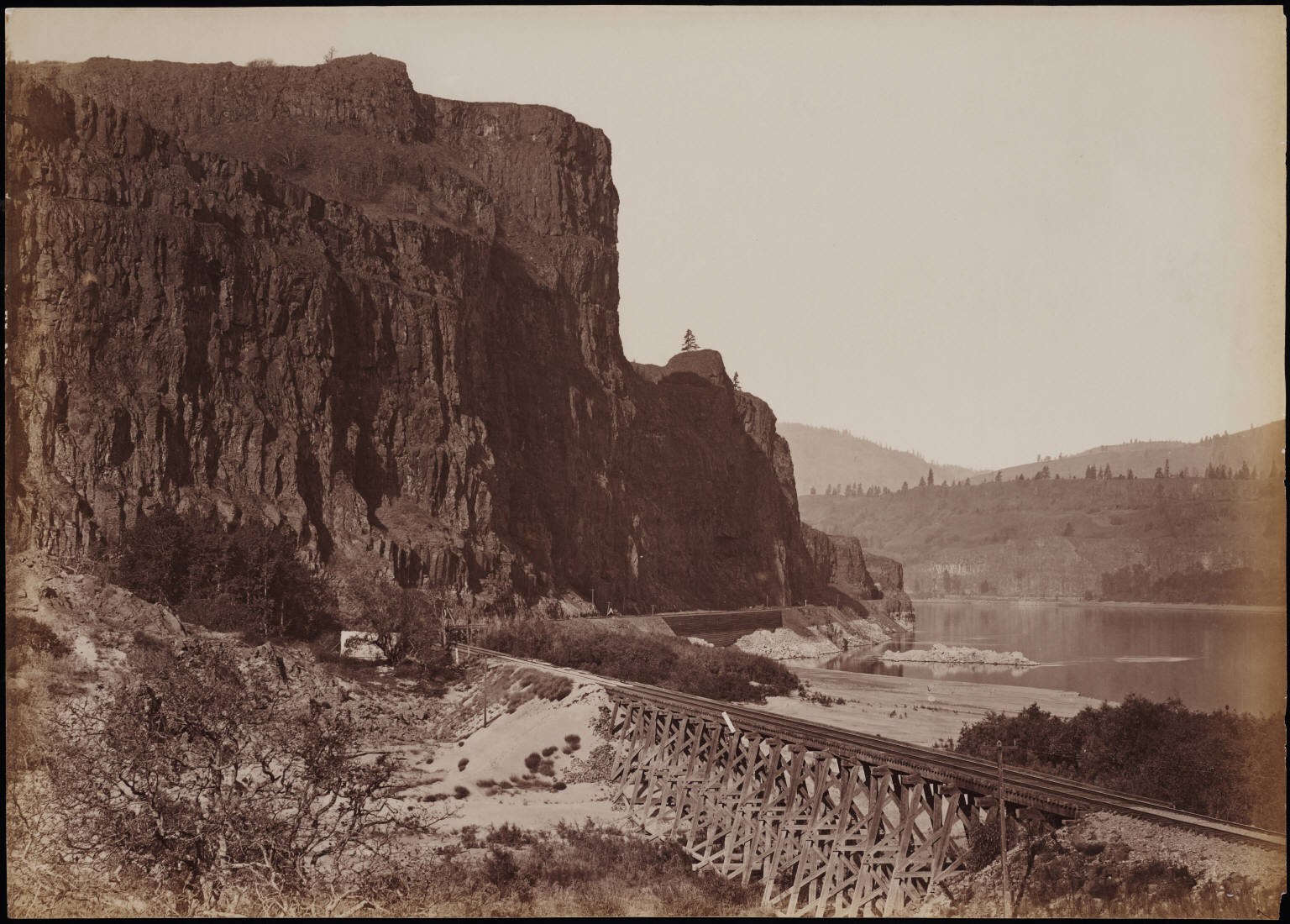
So, what happened? In the early 1900s, cars and airplanes were invented, and their popularity grew quickly within the United States. After the 1920s, cars and planes would supersede trains as the primary means of transportation.
The end of an era
But you see trains all the time, right?
As you probably could have guessed, trains didn’t disappear altogether, although steam-powered locomotives were gradually replaced with electric and diesel-powered locomotives beginning in the early 1900s.
Most steam-powered locomotives were retired from regular service routes by the 1980s, but a few are still in service as tourist or heritage lines. Heritage railways operate with the intention to recreate or preserve railways of the past, keeping their history alive.
Trains of today
So, the real question is, what types of trains are available today?
In our next article, we’ll take a closer look at the electric and diesel-powered locomotives that gradually replaced the steam-powered ones. But wait, there’s more! In the last 100 years of rail transport—just like the first 100—there have been major developments!
We’ll also take a look at high-speed trains riding at 100, 200, and even over 300 mph!
Are you up for the ride? Let’s go!
Related links
More about trains: http://www.dkfindout.com/uk/transport/history-trains/
By Hannah Postlethwait, Go! Staff Writer
Go! Magazine Article Index
Latest News
InTrans / Apr 01, 2024
InTrans releases En Route, annual report for 2023 calendar year
InTrans / Mar 27, 2024
Spreadsheet tool aids local agencies in optimizing gradation
InTrans / Mar 26, 2024
CP Tech Center reviews opening of concrete pavement to traffic
German Railways after 1920
See more RAILWAY HISTORY
Before World War One the German railway system was a collection of different companies each serving the particular state that they were in, run autonomously to each other. In 1918 the German Empire fell, and the country became a republic. This lead to the railway system being nationalised.
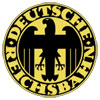
Deutsche Reichsbahn-Gesellschaft: 1920 - 1937
The Deutsche Reichseisenbahnen (German Imperial Railway) was formed on 1st April 1920. The Weimar Republic (so called because the first assembly of the government in 1919 was in the town of Weimar) took control of the states' railways in the following areas; Baden, Meckleberg, Oldenberg, Bavaria , Saxony, Wurtenberg, and Prussia .
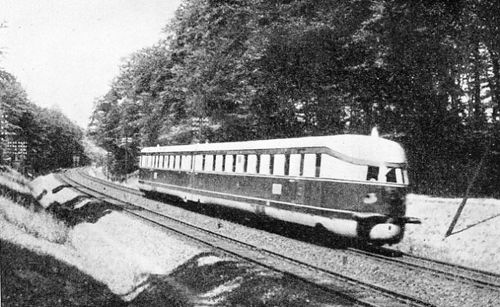
The "Flying Hamburger"
At the end of the war the Treaty of Versailles set out Germany's required reparations, and the Dawes Plan was introduced as a way to manage these payments. One part of the Dawes Plan was to use the profits from the state railway to pay back reparations. On 12th February 1924 the Deutsche Reichsbahn-Gesellschaft (DRG) was created as a state enterprise. Unfortunately the plan didn't work as intended, with the Great Depression severely hitting inter-war Germany and putting a large amount of strain on the DRG.

DRG Class 05 Locomotive manufactured by Borsig.
What the DRG did achieve was standardisation. Before being nationalised each regional railway would have their own locomotives, but now under one company a level of standardisation was attained, but this was also hampered by the poor economy. Despite this there were some achievements such as the Flying Hamburger high-speed train in the late 1930s, which had a top speed of 99mph (160kph) on the Berlin-Hamburg line, and the streamlined Borsig steam engines, which reflected the design aesthetics of the time.
Deutsche Reichsbahn: 1937 - 1949
From 10th February 1937 the DRG was placed under Reich sovereignty and renamed the Deutsche Reichsbahn . In 1938 the DR absorbed the Austrian railway system after the Anschluss (German annexation of Austria). During the period up to the end of World War Two the DR was used for the rapid movement of troops.
The build-up to the German invasion of Russia was the largest troop deployment by rail in history. The national railway services of occupied countries were also run by the DR apart from in Russia, where the Russian Broad Gauge was not compatible with the rest of the European network. As Russian forces withdrew they destroyed stock, denying its use to the Germans – who had to re-lay around 10,000 miles of track.
The DR also played its part in the Holocaust, transporting thousands of people to concentration camps. This period is a black stain on the history of the railway as those being transported were often charged for their journey, with the profits going to Deutsche Reichsbahn .
When Germany surrendered in 1945 the Potsdam Agreement split the country into administrative zones, each looked after by the USA, the UK, France, and Russia with each of these countries overseeing the running of the railways in each zone. In 1949 the Soviet Zone became a self-declared state, and the country was split into East and West Germany. The railways in East Germany retained the title of Deutsche Reichsbahn – the three railway systems in the west had already merged into the Deutsche Bundesbahn .

Deutsche Bundesbahn - West Germany: 1949 - 1994
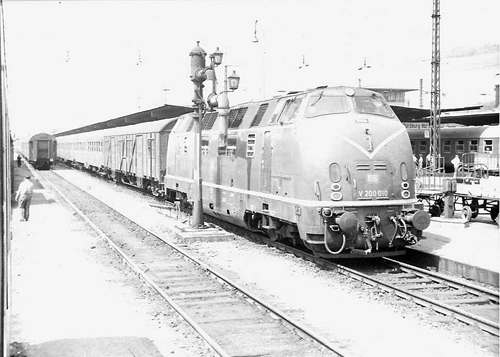
V200 Diesel Locomotive pulling a passenger train in West Germany in the early 1960s.
The first task for the DB was rebuilding the damage done to the network during the war. West Germany was not subject to war reparations, so the influx of capital made reconstruction a lot easier than in the east. New stock was built, and railbus services increased to stave off competition from motor transport. With increased electrification steam was phased out by 1977, and new trains such as the Trans-Europ Express were introduced.
After the TGV was introduced in France , DB looked at how to provide West Germany with a high-speed train. The solution was the Intercity-Express (ICE), and new high-speed lines were built.

Deutsche Reichsbahn - East Germany: 1949 - 1994
DR was the largest employer in East Germany. Electrification was much slower than in West Germany, with much of the previously electrified network equipment being claimed by Russia as reparations. Steam was relied on for much longer, until 1988, due to the relative cheapness of using Russian-made diesel locomotives.
Go Back To Top

Deutsche Bahn: 1994 - Present
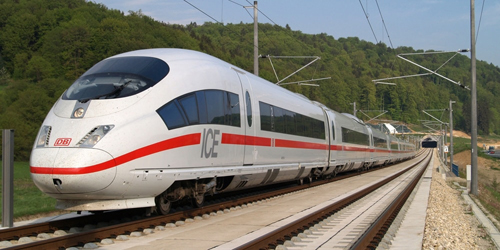
DB ICE-3 High-Speed Train. (Photo: DB)
Both companies continued separately for four years after German reunification in 1990, but merged in 1994 to become Deutsche Bahn AG , owned and run by the German government. In 1999 DB went through what was called Bahnreform , with the company assets split into five groups:
- DB Reise & Touristik AG (Long distance passenger services)
- DB Regio AG (Regional passenger services)
- DB Cargo AG (Freight – later renamed Railion AG)
- DB Netz AG (Infrastructure)
- DB Station & Service AG (Stations)
In December 2007 DB departments were again reformed into:
- DB Bahn (Passenger)
- DB Shenker (Logistics)
- DB Netze (Infrastructure and stations)
DB International Assets
In 2010 DB acquired Arriva, a multinational transport company that runs train and bus services in twelve countries. UK assets include Arriva Trains Wales , Chiltern Railways , Crosscountry, Grand Central Northern , and Arriva Rail London which runs Overground services. DB Shenker also run Transfesa , a freight transport company based in Madrid, and the UK arm of DB Cargo – which used to be EWS . DB Shenker also run the British Royal Train .
DB have also branched out into other international markets, running Trans-Eurasia Logistics as a joint venture with Russian Railways, to bring container trains from China to Germany. They are also assisting the California High-Speed Rail Authority (CHSRA) on the planning, design and implementation of the high speed line in that state.
Modelling German Railways
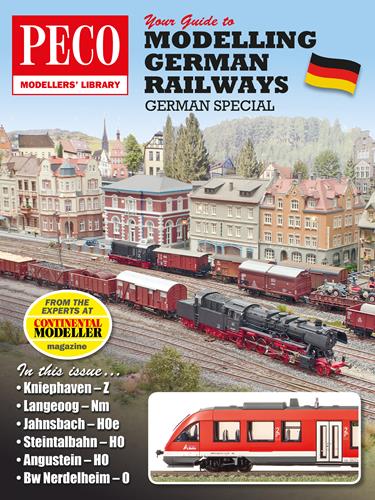
A good place to start is the Peco PEPM-207 Guide to Modelling German Railways, which is packed with information on all eras and scales of modelling layouts in Germany.
Manufacturers who produce German railway items include Roco , Fleischmann , Märklin , Trix , and Piko .
Train Travel in Germany
All About Train Travel and the German Railway
One of the best ways to discover Germany is by train. The German railway system is very well developed and reliable, and you can reach almost every city in Germany by train ; not to mention that watching the German landscape stream by your window is a very relaxing and comfortable way of traveling.
The German National Railway is called Deutsche Bahn, or DB for short. Here is an overview of the German Railway System that will help you decide what trains to take and how to get the best tickets for your train travel through Germany.
The German High Speed Train
If you want to travel as fast as possible from A to B, take the Intercity Express ( ICE - though it is not pronounced "ice" in German, it is referred to by its abbreviation). The German high speed train, which reaches speeds up to 300 kilometers per hour, is a signature silver snout takes only 4 hours from Berlin to Frankfurt and 6 hours from Munich to Berlin. It connects all major German cities.
The German Regional Train
If you want to travel at a different speed and the journey is your reward, take the regional (and cheaper) trains. They will stop more often but reach smaller German towns and villages. The regional trains are called Regional-Express or Regionalbahn.
The German Night Train
If you don’t want to miss a single day of your trip and want to save on hotels, take a night train. The trains leave in the early evening and as morning comes, you will have reached your destination. You can choose between seats, couchettes, or comfortable sleepers, and there are also deluxe suites with two to six beds, a private shower and toilet, available.
Tips for Train Travel in Germany
Where to Get Your Train Ticket:
With a standard train ticket you can board any train on the German Railway at any time. When you buy your ticket, you can choose between first and second class. Look for the large 1 or 2 next to the car door to find the right class.
There are various ways to purchase your train ticket:
- Online: The official website of the German Railway is available in English. Book tickets online and conveniently print them out at home. Keep your eyes open for online deals.
- Ticket Vending Machines: Almost every train station has a touch screen ticket vending machine where you can purchase tickets and make seat reservations up to the last minute. This service is available in English and five other languages. You can pay either cash or with a Maestro Card, and sometimes Visa or Mastercard are accepted.
- German Railway Ticket Counter: If you want to talk to an agent and get some personal advice, maps, and timetables, head to the ticket counters of the German Railway, called DB Reisezentrum . These ticket counters are located inside most train stations.
How to Save on Your Train Tickets:
You can get huge savings on long-distance train travel in Germany if you book your tickets in advance. Special rules apply to those tickets, for example you may be restricted to a particular day and train, or your round trip journey must start and end at the same train station.
Find out more about Special Train Tickets in Germany that will save you money.
How to Reserve Your Seat:
You can travel on most German trains without having a reserved seat, but you can also spare yourself the hassle of trying to find an empty seat by reserving it beforehand .
For 2 to 3 Euro, you can reserve your seat either online, at a ticket vending machine, or at the ticket counter.
A reservation is especially recommended when you take the train at peak times, such as Christmas or on a Friday afternoon, and it is required for night trains, so make sure you plan ahead.
Traveling by Train in Europe: Where, Why, and How
Train Travel in Morocco
About Single Europe Train Tickets
German Rail Map and Transportation Guide
Discount Train Tickets in Germany
Germany Guide: Planning Your Trip
Useful German Phrases for Train Travel
Getting Around Paris: Guide to Public Transportation
Taking the Train in Italy
How to Travel from Amsterdam to Dusseldorf by Train, Bus, Car, and Plane
Getting Around Germany
Italo High-Speed Trains
How to Travel from Rome to the Cinque Terre by Train, Bus, Car, and Plane
Guide to Bus and Train Travel in Spain
When Should I Buy My Train Tickets for Italy?
How to Enjoy a Quick Layover in London on a Budget
Privacy settings
Here you will find an overview of the types of cookies used on the website. You can set your consent for each category individually. Further information can be found in the privacy policy .
- Essential Cookies For the use of the website with all functions (e.g. user settings, watch lists, etc.)
- Statistics Statistics Cookies collect information anonymously. This information helps us to understand how our visitors use our website.
- Marketing In order to provide you with the best possible offer in cooperation with our partners, we use marketing tools. For example, in order to use our chatbot, you must activate this setting.
- External contents Required for viewing external media and third-party content. The provider may set cookies for its part. The respective data protection regulations of the provider apply.
Inspiring Germany
- Cities & Culture
- Nature & Outdoor Activities
- Royal Palaces & Castles
- Experience & Enjoy
- Current highlights
- Sustainable travel
- Barrier-free travel
- Easy language
- Federal states
Slow travel by train: 9 gorgeous rail routes
There are many compelling reasons for a holiday by train: travel in climate-friendly and comfortable style, all while enjoying breathtaking landscapes—completely stress-free!
A train journey has many advantages and is more entertaining: you can sit together with family or friends in your compartment and chat, play games, eat and drink. And what's more, you can sit back and savour the moment, as the scenery unfolds outside your window. Also important, travelling by train is a very environmentally-friendly way to discover a country. We have curated some exceptionally beautiful rail routes for you.
Renowned for its beauty: the Moselle route from Koblenz to Trier
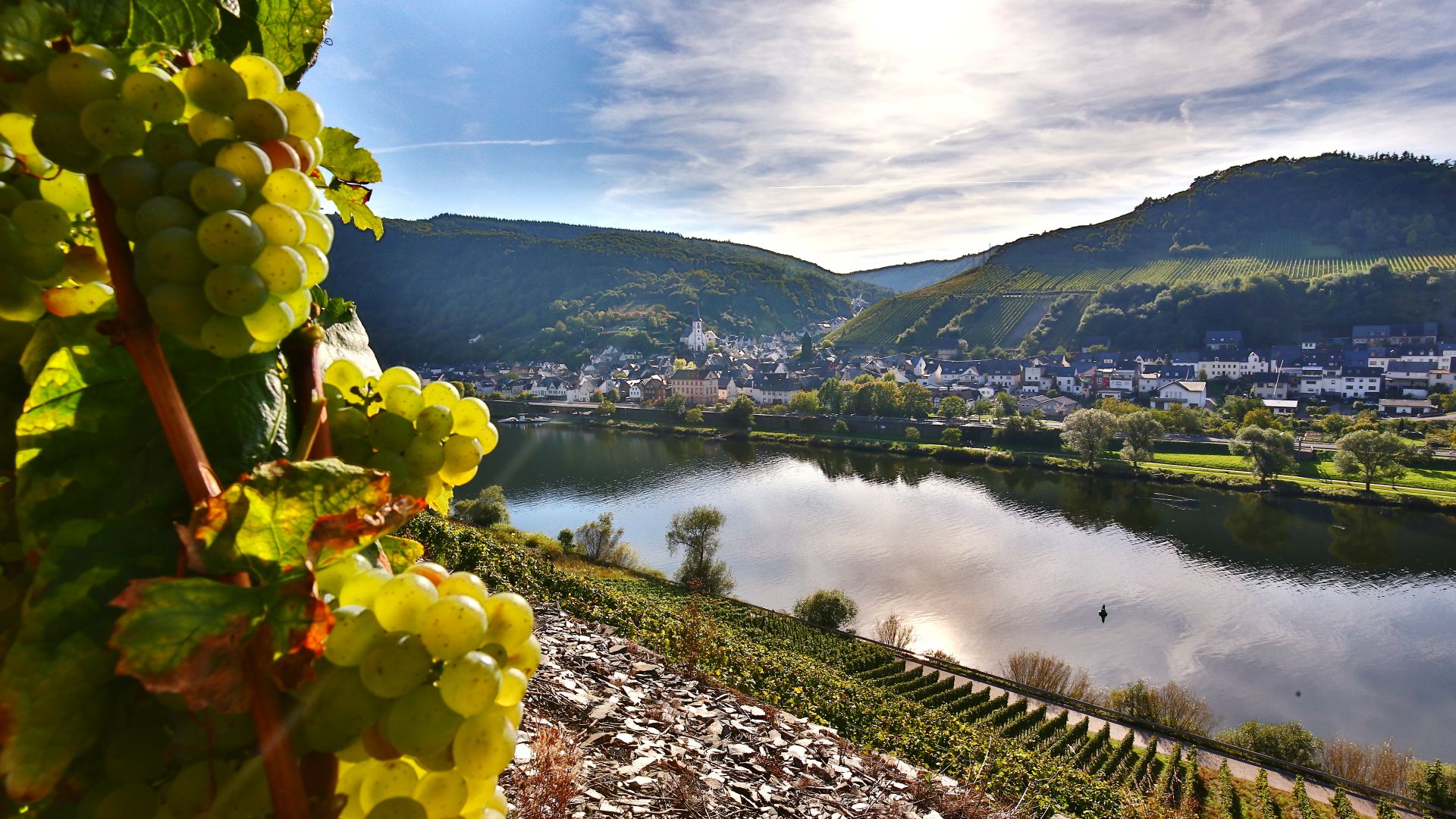
You can expect magnificent views of the Rhine's second-longest tributary: as the tracks wind through a beautiful landscape from the Moselle's confluence with the Rhine near Koblenz all the way to Trier , the train tracks curve gracefully through a stunning landscape. The train travels breathtakingly close to the steep mountain slopes right alongside the track. On this journey you can enjoy a spectacular panorama of stunning views and also pass through the Kaiser Wilhelm Tunnel: an impressive structure which, at 4,250 metres, was the longest railway tunnel in Germany before the Landrücken tunnel in Osthessen opened. Another attraction is the double-decker bridge near Bullay before you crossing the Moselle loop, where the river takes a 180-degree turn: a sightseeing tour by train!
Experience one of Germany's UNESCO World Heritage Sites by train
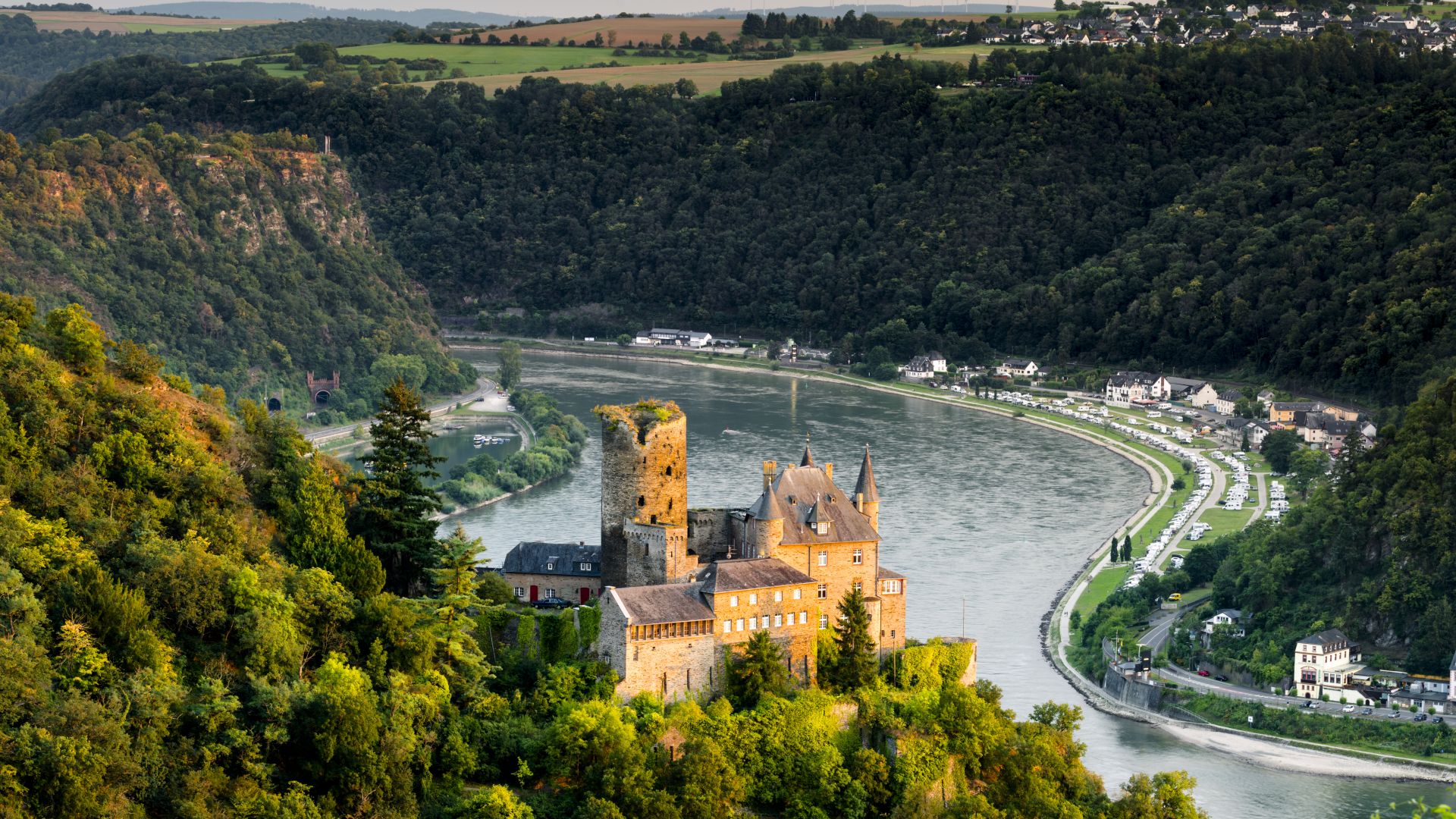
On the journey from Bingen to Koblenz, you won't be able to take your eyes off the view: after all, the journey leads you through the UNESCO World Heritage Site "Upper Middle Rhine Valley" and the landscape through your window is like something out of a fairy tale. Over a distance of 70 kilometres, this railway route winds its way past steep vineyards, impressive rock formations, romantic Old Towns and imposing castles on both sides of the Rhine. You'll also catch sight of the Lorelei, the famous symbol of the Rhine, from the train. Even though this train journey itself is gorgeous, it's also worth disembarking every so often to discover the towns along the way.
A delight for sea lovers and water enthusiasts: from Hamburg to Sylt by train
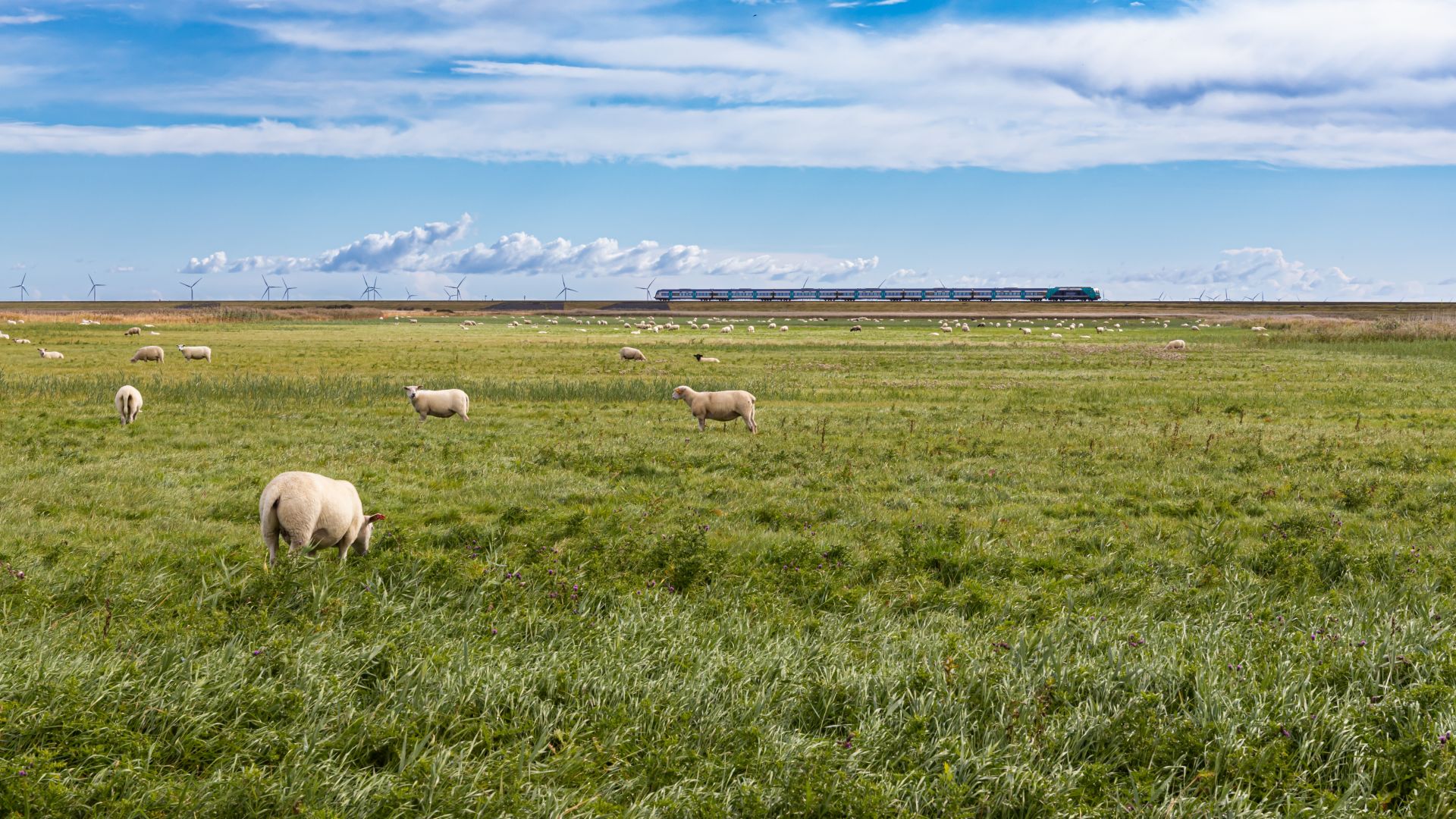
From the bright lights of the city directly to the sea: it takes less than two hours to get from Hamburg to the coastal town of Husum, and from there on to Sylt . This unique train journey never ceases to amaze: soon after leaving the station in Hamburg, the route leads through the quintessential North German marshland landscapes and, shortly after, crosses the North-Ostsee Canal on the Hochdonn High Bridge, at a height of 42 metres! On a clear day, you can gaze all the way to the port facilities of Brunsbüttel on the North Sea. After the stop in Husum, we headed towards the island: the highlight of this leg of the journey is definitely the eleven-kilometre long Hindenburg Dam, which runs through the Wadden Sea National Park and connects the North Frisian mainland with Sylt.
From Offenburg to Singen on Lake Constance with the Black Forest Railway
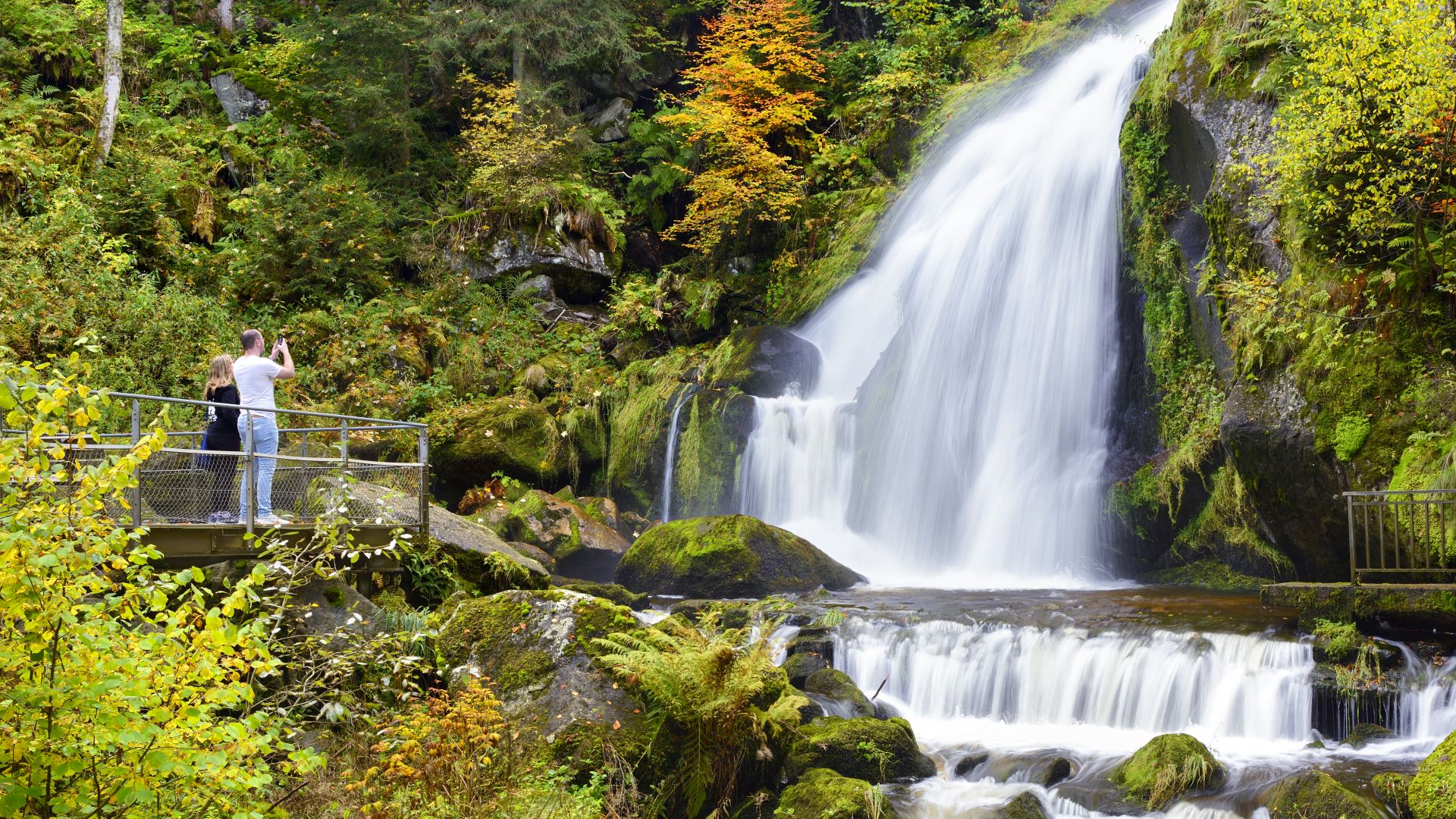
Sit back and marvel: on this route from Offenburg in Baden to the Swabian Sea – as Lake Constance is also known – you travel 150 kilometres through the dense pine forests, deep valleys and impressive mountain scenery of the Black Forest. During this journey, the train glides over the Hornberg Viaduct and travels through two exciting double loops that span several kilometres near Triberg. The train constantly changes direction, making little forward progress but rapidly gaining altitude. Take the opportunity to visit the impressive waterfalls in Triberg or the source of the Danube in Donaueschingen, the source and starting point of this unique river. If you choose not to make any of these stops, you can also take the Black Forest Railway to the town of Singen near Lake Constance in just under two hours.
Lake Constance Belt: from Radolfzell to Lindau
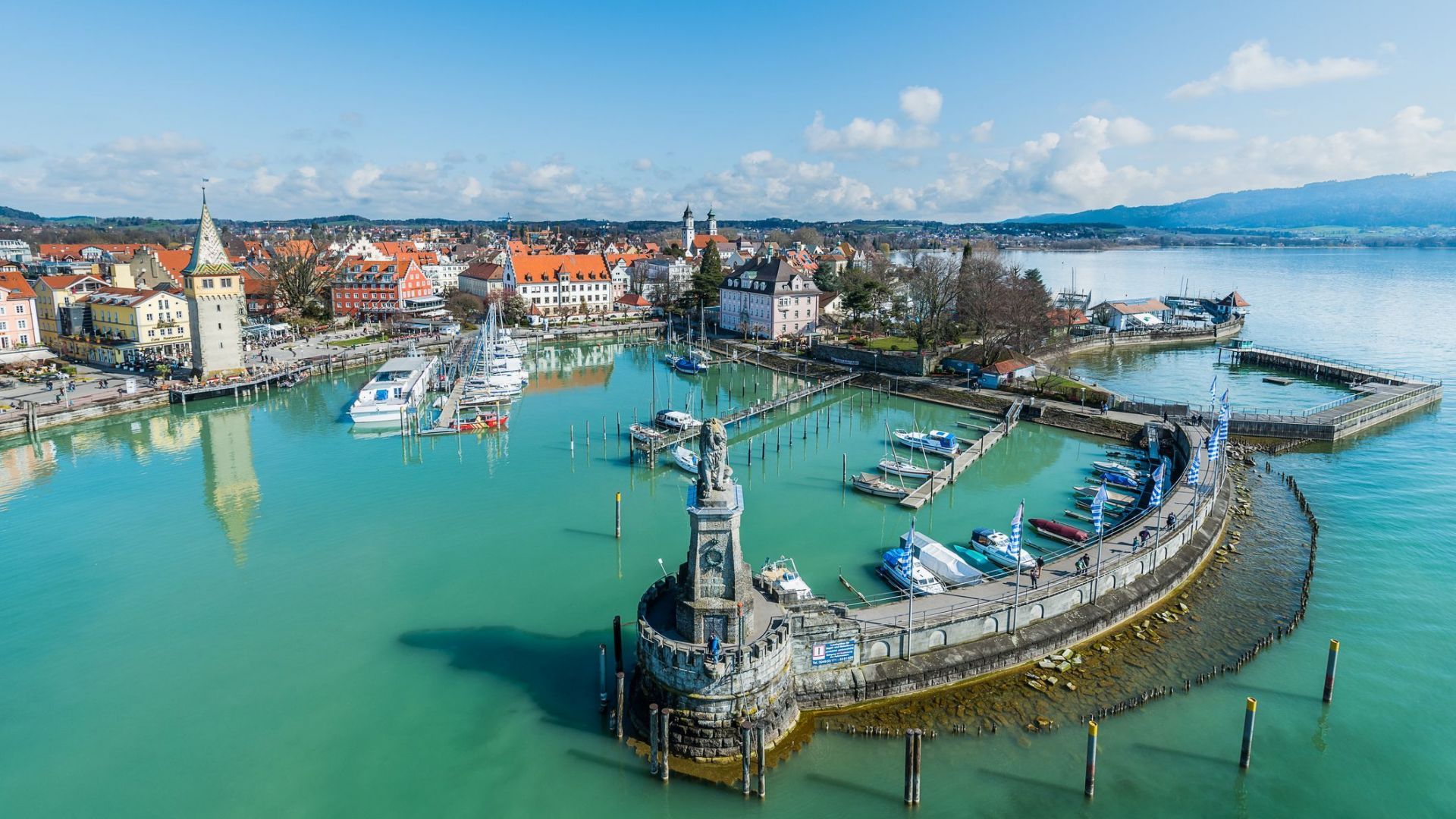
The route covers 74 kilometres and leads from Radolfzell via Friedrichshafen to Lindau along the northern shore of Lake Constance. If you manage to tear your gaze away from the water to watch the countryside go by, you will discover vineyards, meadows filled with flowers, apple orchards, the baroque pilgrimage church of Birnau or Salem Castle. Further in the distance, on a clear day you can even see the snow-covered peaks of the Alps: a truly outstanding backdrop! And when the white sails of the boats on the blue lake glow in the sun, or a Zeppelin glides through the sky, you'd want to travel this route all over again!
Do you dare to take a ride on the Höllentalbahn?
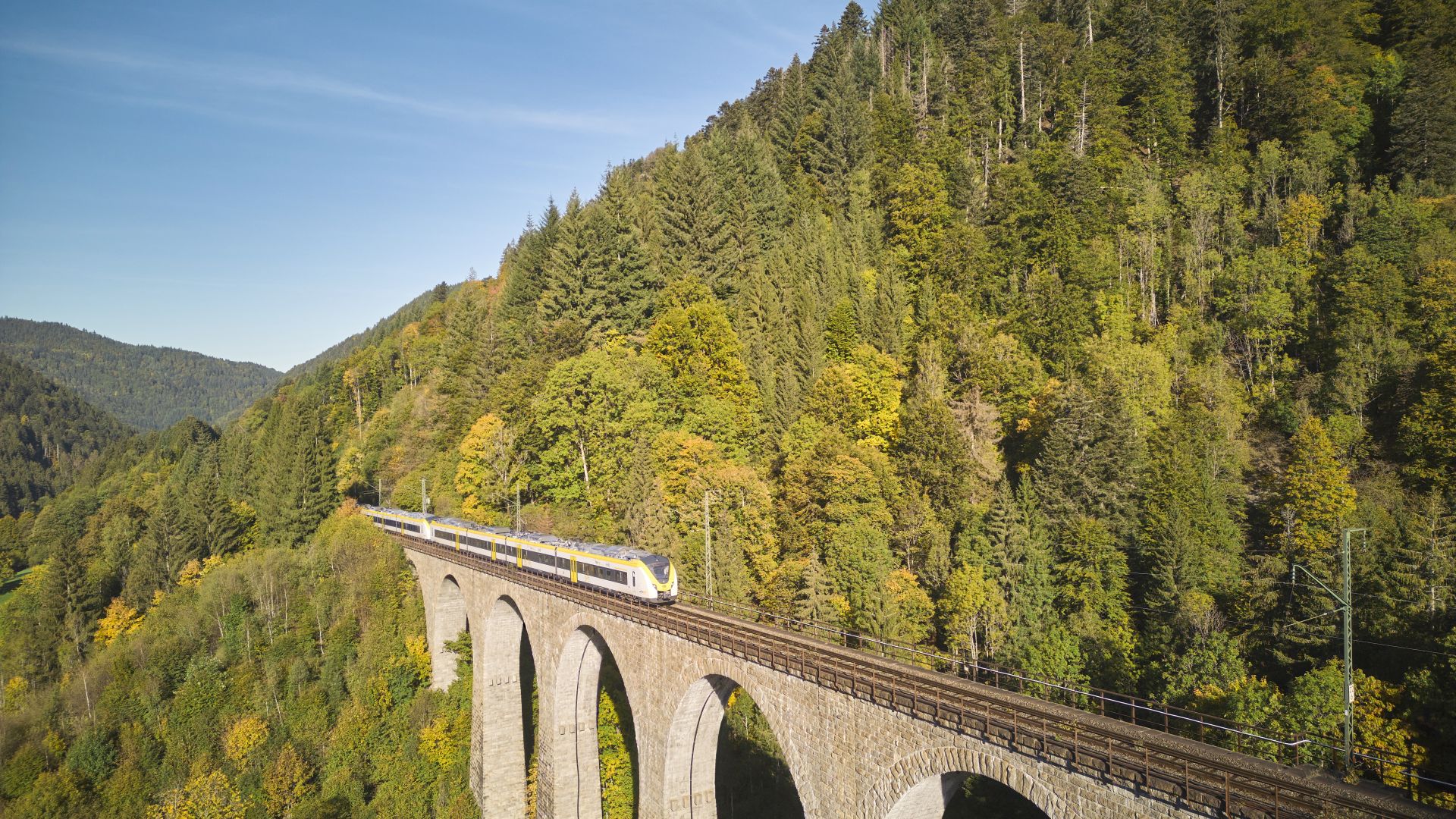
This route is definitely a special experience for the whole family: the Höllentalbahn runs between Freiburg im Breisgau and Donaueschingen , and is considered the steepest railway in Germany. On the section between Himmelreich and Hinterzarten, it climbs a total of 400 metres covering twelve kilometres. The remainder of the 76-kilometre journey is equally spectacular. It passes through nine tunnels and over numerous bridges, including the 224-metre-long Ravenna Viaduct, which spans the gorge of the same name. Along the way, you can gaze out at particularly beautiful views of the Black Forest, expansive valleys and Lake Titisee. This route can be a doubly gorgeous experience in the wintertime, when the forests are covered in snow.
Through two national park regions with the Fichtelbergbahn
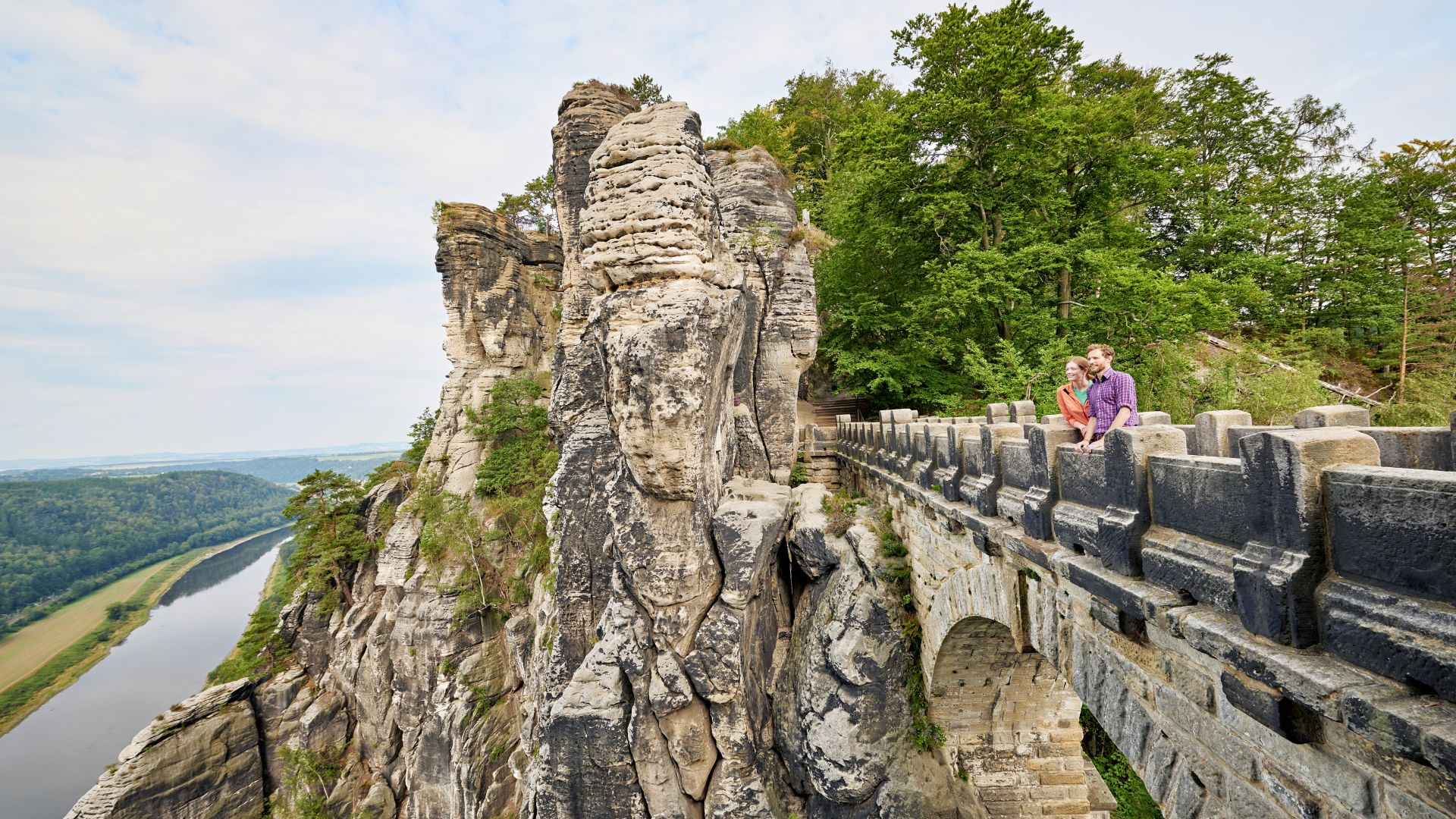
The "official" start of this journey is in Bad Schandau – a state-recognised Kneipp spa and health resort in the Eastern Ore Mountains. If you would like to extend your journey along this panoramic route on the German side, hop on the National Park Railway U28 in Schöna in the Elbe Valley, which connects Saxony and Bohemian Switzerland in the neighbouring Czech Republic. Gazing out of the window constantly rewards the eye, as unique rock formations, dense forests and spectacular valleys rush by. On the German section alone, the railway gains around 200 metres in altitude over a distance of 15.5 kilometres. The route climbs steeply, and the view is famously beautiful! The National Park Railway runs nine times a day in the Saxon Switzerland region, with many stops from which you can start your hikes.
From Stralsund to the "Rasender Roland" Rügen narrow-gauge railway
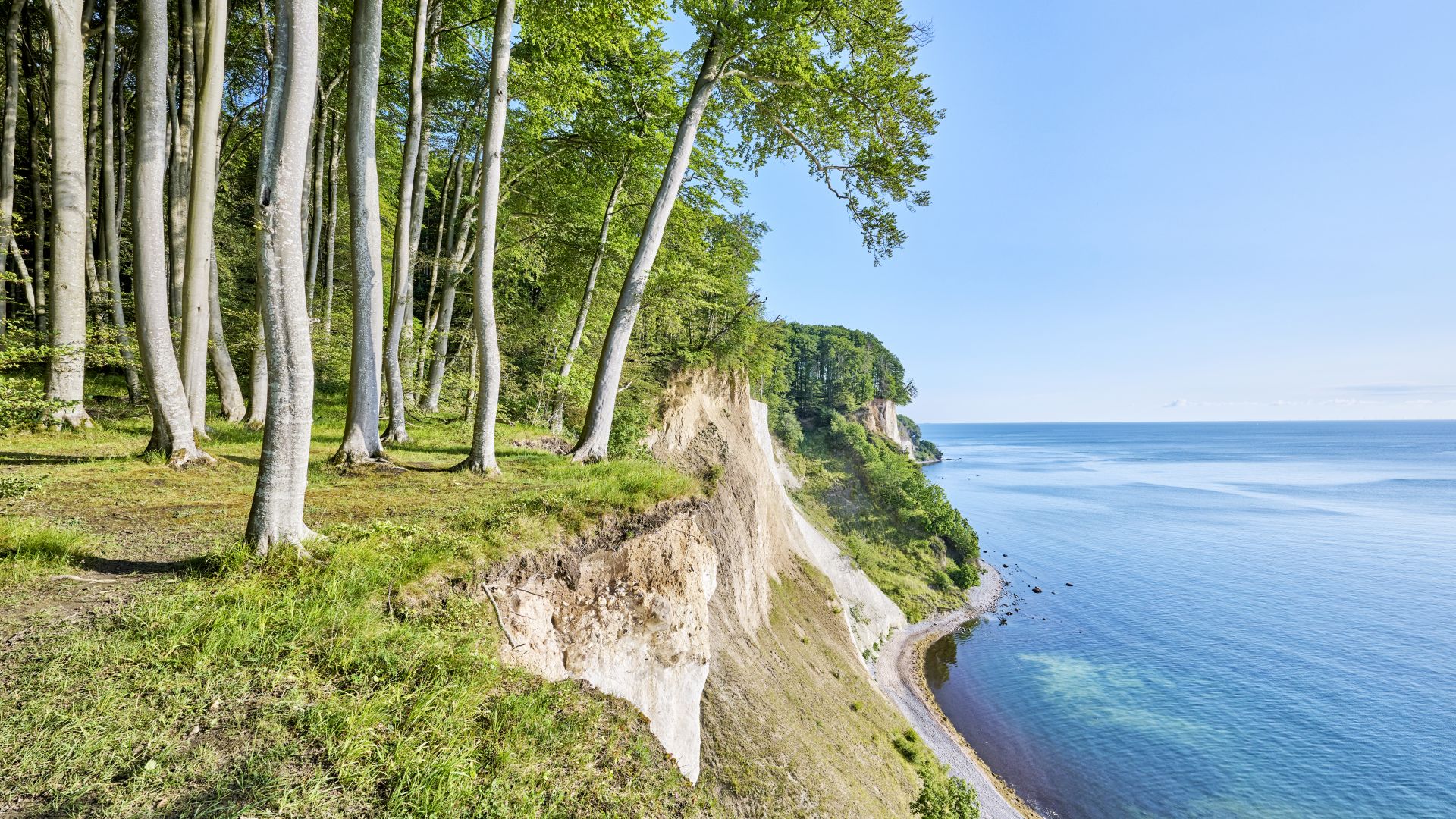
Is it possible to travel to Germany's largest island by train? Yes, it absolutely is. Your journey to the sea begins in the Hanseatic city of Stralsund , where you cross the "Strelasund" estuary via the Rügen Causeway: a scenic journey with a clear view of the boats coming and going, and a panorama of Straslund with its large shipyard. If you stay on the train as far as Sassnitz, you will pass the edge of the Jasmund National Park and see the famous chalk cliffs on Rügen : a highlight not only for nature lovers. To further explore the beautiful island in the Baltic Sea, consider taking a trip on the "Rasender Roland", the narrow-gauge railway with a nostalgic flair that travels along a 24-kilometre route to the island's famous seaside resorts at a steady 30 kilometres per hour. Starting from Putbus, it rattles and steams through gentle hilly landscapes, deciduous forests, and uphill to Jagdschloss Granitz, a popular excursion destination in Mecklenburg-Vorpommern. The Rügensche BäderBahn , as the "Rasende Roland" is officially known, ends in Göhren.
A nostalgic trip through the snowy landscape of the Harz Mountains: the Brocken Railway
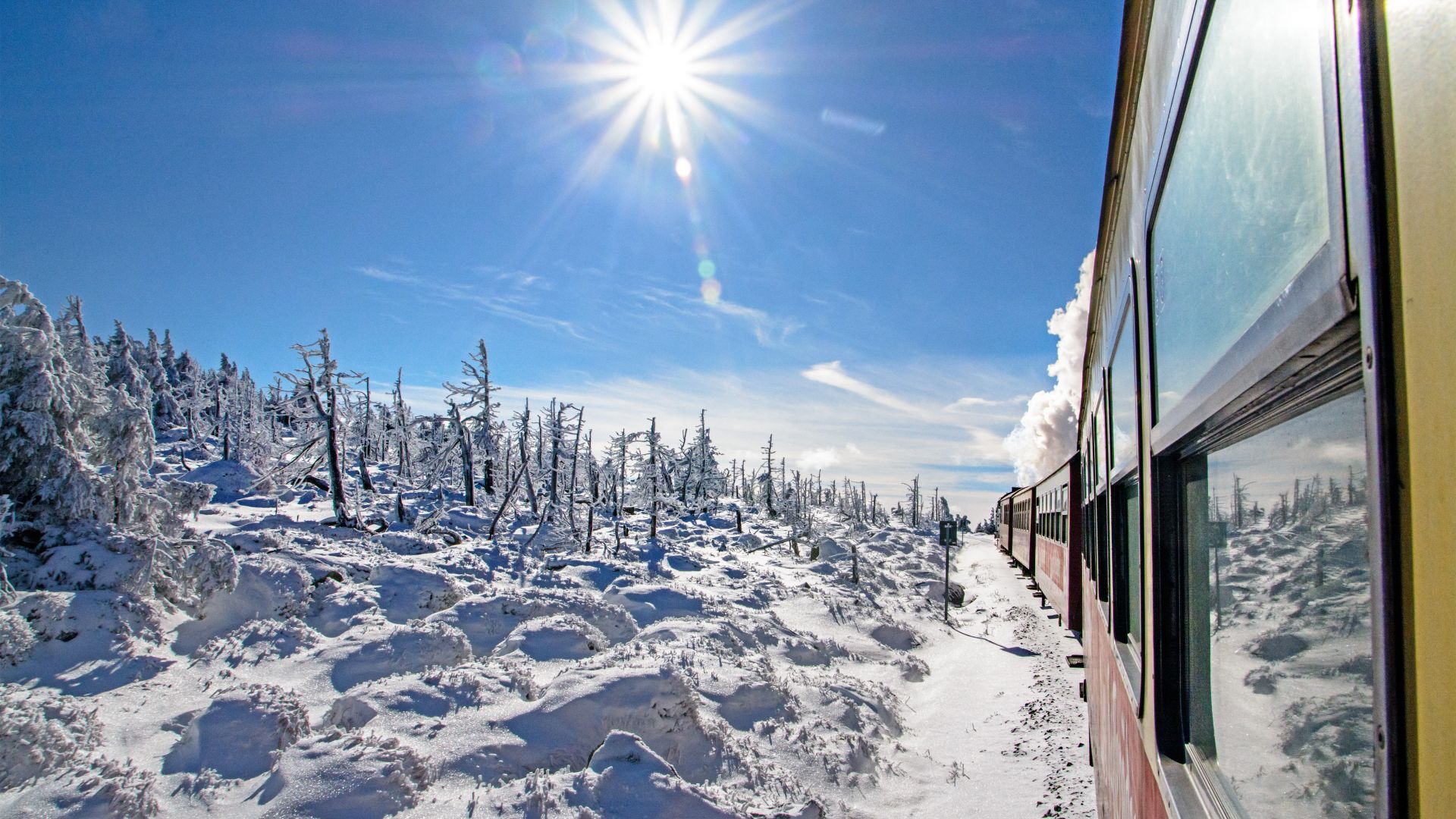
Ideally, you can plan to enjoy this train ride through the Upper Harz Mountains in the wintertime, when thick snow covers the fir trees, the landscape sleeps under a white blanket, and the crisp, clear mountain air on the Brocken fills your lungs. With the Brocken Railway , you ascend to the highest peak of the Harz National Park all the while enjoying the impressive panoramic views reaching far into the foothills. The Brocken Railway is a so-called "adhesion railway": this means that it travels to a height of 1,125 metres with around 700 horsepower without gears or similar aids. This makes the Brocken station the highest station of all German narrow-gauge adhesion railways. The starting point of this tour is the station in the village of Drei Annen Hohne, which belongs to Wernigerode in the Saxony-Anhalt district of Harz. From there, you can reach the summit in around 50 minutes on the Brocken Railway.
Discover more
Dine and sleep in regal style, museums - marvel and experiment, cities doubling up as film sets, this is the taste of germany, summer of football: germany 2024, german bread and baked goods.
Train travel in Germany
A guide to Germany for train travellers

Where to buy tickets for Germany
The trainline, booking platform.
The Trainline is a British digital rail and coach technology platform operating across Europe.
Omio is a German online travel comparison and booking website based in Berlin.
Deutsche Bahn
National operator.
The Deutsche Bahn AG is the national railway company of Germany, and a state-owned enterprise under the control of the German government.
Places to go in Germany

More places to go in Germany
What to expect from the weather in germany, accommodation, what are the business hours, what about travel visas, how much should you tip in germany, tickets & schedules, latest inspiration.

Related Content
Helpful links:, 14 things most worth knowing..., the ice (inter city express) services:, the ic services:, the ec services within germany:, the regio services:, the s-bahn services:, quiet zones:, bicycles on german trains:, detailed train guides, train travel guides:, the booking periods:, discounted prices:, booking tickets at stations:, seat reservations for journeys within germany:, seat reservations on international trains:, journeys with connections:, child tickets:, regional 'lander' tickets:, the national 'quer-duch-lands' ticket:, detailed guides to using tickets and rail passes:, the new national monthly flat-rate ticket, journeys from berlin, journeys from frankfurt (main), journeys from hamburg, journeys from köln / cologne, journeys from münchen / munich, scenic journeys:, international rail routes from germany:, holiday ideas:, notes on using the major stations:, detailed info on the major stations, please support showmethejourney, pan-european train travel guides:, related resources.
- Cities & Stations
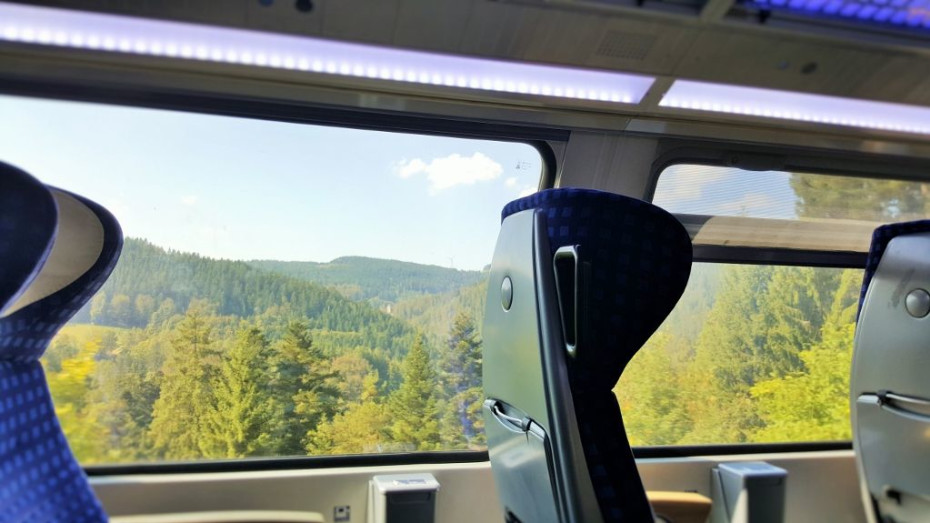
- Germany by train
Welcome to the guide on how to save money, time and confusion when travelling in Germany by train.
Travelling by train in Germany can be an incredible experience. It can boast some of the fastest and most fabulous trains in Europe, has impressive and efficient stations and offers a multitude of spectacular journeys .
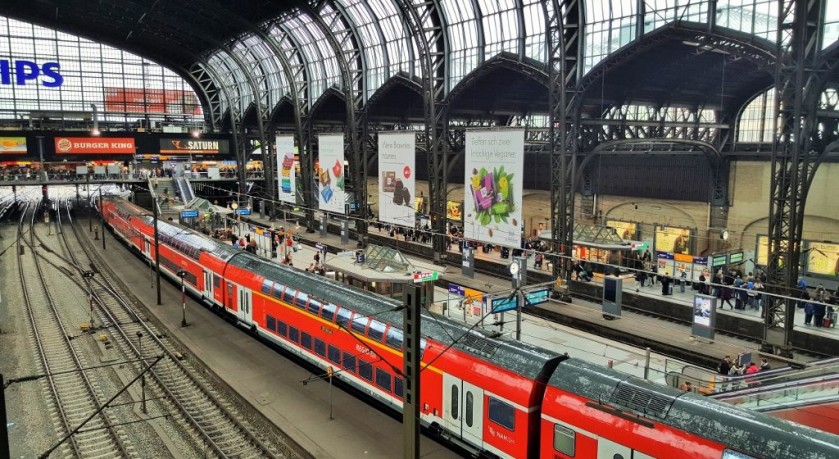
These are the fourten things that are particularly useful to know about German rail travel:
- The German national rail operator is DB (Deutsche Bahn) and it manages all of the national express train services - the ICE trains and the IC trains .
- The ICE trains also operate on international routes to and from Amsterdam, Brussels, Chur, Interlaken, Paris, Vienna and Zurich.
- DB does not operate sleeper trains, but ICE trains overnight on many routes.
- Many of the regional, Regio train services which link cities and towns on shorter distance routes are operated by other companies, but this doesn't affect how tickets can be purchased and used.
- Tickets for journeys by the ICE and ICE trains are typically placed on sale from 6 months ahead of the travel date.
- The discounted tickets are branded Sparschiene tickets - and an adult booking this type of ticket for 1st or 2nd class, can take up to four children aged 15 and under with them at no extra cost.
- Seat reservations are available, but optional, on the ICE and IC trains and have a fixed cost regardless of distance - they are only complimentary and included when booking the more expensive types of ticket .
- Tickets for journeys for the Regio trains aren't typically discounted, and also aren't usually available online.
- When booking the cheapest last minute tickets at the station, they will not be valid on the IC and ICE trains.
- The main central stations in each city are known as hauptbahnhofs, so on timetables these stations are named Hamburg Hbf and Stuttgart Hbf etc. 11 The signage at stations is bi-lingual, it is in English and German, as are the announcements on the express trains, but the station announcements will be in German only.
- The consistent features of the hauptbahnhofs include the information to help you find a train and where to wait for it, left-luggage lockers, step-free access and Reisezentrum travel desks - which sell tickets and reservations for trains across Europe.
- Local S-Bahn trains link the hauptbahnhofs to city centre locations in Berlin, Frankfurt (Main), Hamburg, Leipzig, Munchen and Stuttgart.
- The ICE trains travel up to 300 km/h on these high-speed routes:
- Berlin ↔ Wolfsburg
- Seigburg/Bonn ↔ Frankfurt Flughafen
- Mannheim ↔ Stuttgart
- Hannover ↔ Wurzburg
- Halle and Leipzig ↔ Nuremberg
- Ingolstadt ↔ Munich
- Baden-Baden ↔ Offenburg
- Plochingen ↔ Ulm (the first stage of what will be a Stuttgart ↔ Ulm line)

Travelling on the trains:
German train services are placed into these four categories: ICE, IC, Regio and S-Bahn.
DB (Deutsche Bahn) is the German national rail operator, but it doesn't manage all of the train services in the country. Regional (Regio) services in particular can be operated by other companies, but train tickets for these services are interchangeable. Meaning that if you book a ticket at a station valid for a Regio train, then it can be used on any 'Regio' train to your destination, no matter which company is providing the service.
Five different types of ICE trains are now used on routes within and to/from Germany.
The ICE services are express trains that spend some of their end-to-end journeys travelling on a high speed line. ICE trains travel on high speed lines for most of the journey between these cities:
- Berlin <> Hannover
- Hannover and Wolfsburg <> Frankfurt (Main) and Wurzburg
- Leipzig/Halle <> Erfurt
- Erfurt <> Nurnberg*
- Nurnberg <> Ingolstadt (on route to Munchen/Munich)
- Koln/Cologne <> Frankfurt Flughafen/Airport*
- Mannheim <> Stuttgart
- Stuttgart <> Ulm
- Mannheim <> Offenburg *Trains regularly travel at more than 285 km/h on these lines, but up to 270 km/h is the more usual speed on the other lines.
Note that there are no high speed lines between these cities:
- Koln/Cologne <> Hamburg
- Koln/Cologne <> Hannover
- Hamburg <> Hannover
- Hamburg <> Berlin but ICE trains still operate on these routes.
The IC services ae more conventional express trains, which are mainly used on long cross country routes that don't involve travelling on the high speed lines. Though IC trains can use the high speed lines for comparatively short sections of their journeys.
When there are no high speed lines between cities, the IC services often share the route with ICE services.
Two different types of train used for the IC services; one of which is the new double deck Intercity2 trains.
International EuroCity (EC) services provided by other national rail operators are slotted into the regular German train timetables.
If you will be taking a train journey between Berlin and either Dresden or Hamburg, you could be travelling on a Czech or Hungarian train. Or if you make a journey between north-west Germany and south-west Germany, you could find yourself boarding a Swiss train. And these are just some examples of when this can occur.
The Regio services comprises a broad range of trains because they provide these different functions:
1 Longer distance 'commuter' routes from/and to major cities including Berlin, Koln, Hamburg and Munchen. Regio services often share these routes with IC and ICE trains and when they do so, they can be a cheaper, but slightly slower alternative, to taking those express trains.
(2) The local and branch line services outside the major cities.
(3) Journeys of up to three hours which link smaller towns to regional capitals. On these routes some Regio services can be faster than others because they skip more stations - and those faster trains are usually designated as 'Regio Express' (RE) services. So check the timetables (the yellow Abfarht sheets at stations) before boarding Regio trains - taking the next train to depart MAY not be the quickest option.
The S-Bahn services are the local trains in urban areas of Germany.
Similar to the RER trains in Paris and Elizabeth line trains in London, the S-Bahn trains in Berlin, Frankfurt(Main), Hamburg and Munich/Munchen travel across the city centre, providing faster alternatives to the equivalents of taking the metro from the main 'hauptbahnhof' stations.
'Quiet' and 'Phone' seating areas/zones are available on all ICE trains and on most IC services. You can choose on a seating plan, whether you wish to travel in these zones when making a reservation,
Some form of on board catering will be available on all ICE and IC services and on the EC trains within Germany, but not on Regio services:
In summary:
- Restaurant cars = some ICE trains and the EC trains,
- Bar/bistro counter = all ICE trains, all EC trains, some IC trains
- Trolley services of refreshments = some IC trains (those which don't have bar/bistro counters).
- On demand at seat service in 1st class = all ICE trains
How you travel with a non-folding bike in Germany depends on the type of train service you will be traveling by. Standard (non-folding) bicycles can be taken on all DB trains, except the ICE 1 , ICE 2 , and the older variant of the ICE 3 trains, but special tickets / reservations usually have to be purchased prior to boarding.
ShowMeTheJourney's guide to booking these bike tickets for German train journeys is available here
Click on the buttons below to access info such as on board facilities, and what to look out for when boarding and travelling with luggage/bikes.
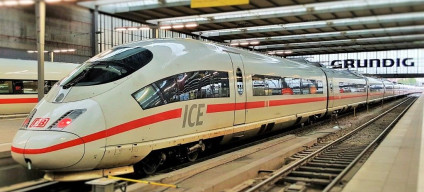
Check out the more detailed info:

Notes on the ticketing:
If you will be buying tickets at the last minute, looking up the train times on the DB website , before you set off for the station can be a good idea.
On most ICE routes the trains depart no more than hourly; and this also applies to some IC routes, and on most Regio routes too.
Though between some destinations the direct trains only depart every other hour; and some very long distance IC services only operate once per day.
Tickets are typically made available up to 6 months ahead of the travel date, but this booking period can be shorter when looking up journeys which involve travelling after the second Sunday in each December. The nationwide and international train timetables / schedules have a major annual update, which takes effect from the second Sunday in December. However, tickets can't be placed on sale until the new timetable is confirmed and this confirmation tends to occur around mid-October, there isn't a set date for this. So if you will be be looking up a journey for travel after the second Sunday in December and can't find any tickets on the route you want to take, it will be because the tickets haven't yet been made available.
The cheapest type of discounted tickets for journeys by the express ICE and IC services are the 'Super Sparpreis' tickets. They can be booked from 6 months ahead of your travel date - the further ahead you can book, the cheaper the prices will be, because only limited numbers of discounted tickets will be available at the very cheapest prices.
On the majority of ICE and IC journeys within Germany the cheapest 'Super Sparpreis' ticket price is now €17.90, this is a newly lowered price. Whether these prices will be available when you book depends on how quickly the tickets at the lowest prices sell out. On the longer distance routes those €17.90 fares can be hard to find if you're not booking at least 3 months ahead.
They will sell out fastest on the most popular departures, so trains leaving at different times on the same day can have different ticket prices. Therefore if you can be flexible re: your departure times then it’s usually worthwhile searching through ‘earlier/later’ departures to find the cheapest fares; or use the ‘Saver Fare’ facility on the DB website. You might save more than €40 by taking trains that are departing earlier or later in the day.
Super Sparpreis and Sparpreis tickets are train specific, you must travel on the train you have selected; this also applies if you haven’t reserved.
Tickets for journeys by S-Bahn trains and nearly all Regio trains aren't discounted, so they cost the same if you buy them last minute at the station; and because they're not discounted, they're not usually available online
However, when you book tickets at a station it will be train service specific. Because the tickets for journeys by Regio trains are cheaper when booked at a station, they can't be used to travel on an IC or ICE train. So once you have booked tickets for a journey by Regio train, you can't then just hop on any next train to your destination - you can only take a Regio train.
Reservations are now only automatically included when booking 1st class Flexpreise tickets, or when booking Flexpreise Plus tickets for 1st and 2nd class travel. When purchasing the cheaper Super Sparpreis and Sparpreis tickets for journeys by express train, you can opt to either:
- travel 2nd class and add a seat reservation for an additional fee of €4.90.
- book 1st class / upgrade a 2nd class ticket to 1st class and add a seat reservation for an additional fee of €5.90. When booking Flexpreise tickets for travel in 2nd class, you can add a seat reservation for an additional fee of €4.90.
Seat reservations are not available on Regio trains.
If you will be using a rail pass on trains within Germany, seat reservations are optional in both 1st AND 2nd class on IC and ICE trains; but the availability of seats isn't guaranteed if you haven't reserved .
Making reservations is OPTIONAL on some international train services/routes, including:
- ICE trains to/from Austria, Belgium, The Netherlands and Switzerland.
- EC trains to/from Denmark (outside summer months), Hungary , Switzerland and The Czech Republic .
- IC trains to/from The Netherlands and Switzerland
- Railjet trains to/from Austria and Hungary
Although reservations are automatically included when booking 1st class tickets.
However in contrast reservations ARE compulsory on:
- DB-SNCF trains to/from France
- EC trains to/from Croatia , Denmark (summer only), Italy , Poland and Slovenia ,
- All overnight trains from/to Germany.
These compulsory international train reservations are automatically INCLUDED when booking 1st AND 2nd class tickets online or at stations Though rail pass users have to book reservations before boarding these trains.
Often making a change of train can save money in comparison to taking the direct ICE trains. The connections are usually designed to make the changing of trains as simple as possible.
On many routes taken by ICE trains, the timetable is set up so that in one hour there will be a direct ICE train between cities. Then in the alternate hours, a 5 – 10 min connection between ICE trains is required to complete a journey.
However IC and ICE trains AREN'T exceptionally punctual, so allowing a minimum of 30mins to make a connection between long distance trains can be the best option.
If your journey involves making a connection between two trains at a Hauptbahnhof and you miss the connection due to a late arrival of a train, tickets and reservations can be re-arranged for a subsequent train free of charge at a Reisezentrum travel desk.
These have recently changed for the better .
- For journeys by the express trains, the EC , IC and ICE trains , an adult (on German railways an adult is a person aged 15 and over) can now take up to four children aged 6 - 14 with them at no additional charge. The change is that this policy only previously applied when parents or grandparents were accompanying the children. Their ages will need to be entered when booking , so you can't just turn up at the station and hop on board; the kids will still require tickets, but in effect they will be complimentary. These new terms also apply to 1st class tickets and it doesn't matter which type of ticket is chosen; and it also applies to international journeys by these specific trains (except for the ICE trains to/from Paris).
- For journeys by the the Regio and S-Bahn trains the former child ticket policy applies, namely a parent or grandparent can take up to four children aged 6 - 14 with at no charge
- Children aged 5 and under travel for free on all trains.
- Children aged 6-14 travelling unaccompanied by adults, or when travelling in a party of more than 6 people will be charged 50% of the adult rate.
If you are planning a day trip by train within a particular region in Germany , these regional day tickets can be great value for money, they cost from €23 - 31 for an individual, but up to four other people can be added to the ticket for only €3 - 7 per person. Meaning that, for example, five adults can explore anywhere in Bavaria in a day by train for only €52.
Though these 'Lander' tickets can be used to travel only on Regio and S-Bahn services and not on the express IC and ICE trains.
If you want to travel between regions , then the Quer-Duch-Lands-Ticket (see below) can be a good option.
Also known as the Day Ticket , this Quer-Duch-Lands-Ticket allows for travel anywhere in Germany for a day, as long as you travel only on Regio and S-Bahn services and not on the express IC and ICE trains.
Though using this ticket becomes a particularly good option if you will be travelling in a group. That's because the base price for one Adult is €42, but up to four other adults can travel on the ticket for only an additional €7 per person.
This ticket can be used for making a long-ish day trip by train, OR a multi-destination single day itinerary, OR as a cheaper, but slower alternative to taking the ICE and IC trains when the cheapest express train tickets have sold out.

The journey guides include access to booking links and information about the trains, tickets and destination stations. Plus for the scenic routes there are insights on how to make the most of the rides on the trains.
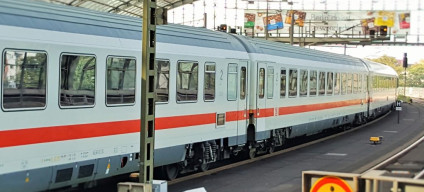
Search for a journey:
- Frankfurt (Main)
- Köln / Cologne / Koeln
- München / Munich
- No Matching Cities
- List is empty.
Seven beautiful journeys through river valleys and gorges:
- Bonn > Koblenz > Bingen - (Mainz)
- Koblenz <> Trier
- Dresden > Bad Schandau > over the Czech border to Decin
- Regensburg <> Passau
- Ulm <> Tuttingen
- Heidelberg <> Neckarelz
- Naumbrg > Jena > Saalfeld
Five lovely routes through forests:
- Offenburg > Singen > Konstanz
- Stuttgart <> Singen
- Freiburg <> Donaueschingen
- Seebrugg <> Titisee
- Platling <> Bayerisch Eisenstein
Six wonderful Alpine journeys:
- Rosenheim <> Berchtesgaden
- Kempten > Immenstadt > Lindau
- Ulm <> Goppingen
- Kempten > Reutte > Garmisch
- Murnau > Garmishch > Mittenwald > Seefeld
- Murnau <> Oberammergau
Short videos showcasing some of these journeys have been uploaded to the ShowMeTheJourney channel on YouTube .

Let the train take you to beautiful locations:

Six things that are good to know:
1 . The main central stations in Germany cities are named ‘Hauptbahnhofs’ and this is universal across the country. The names of landmarks or notable people etc are not used for the names of hauptbahnhofs. 'Hauptbahnhof' is usually shortened to 'hbf' on timetables, departure screens and the DB website.
2 . In some cities including Berlin, Hamburg and Munchen/Munich, long distance trains can call at other stations in the city, before they arrive at the hauptbahnhof/hbf.
So avoid seeing the name of the city on the signage at a station and assuming you've arrived in the city centre. In German cities anything but 'hbf' in a station name indicates that the station is NOT the main, city centre station.
3. All hauptbahnhofs house Reisezentrum (travel desks) at which tickets and reservations on most European international trains can be arranged - without paying booking fees. European train services that can be booked at a Reisezentrum desks include trains that DON'T travel to/from Germany.
Therefore Reisezentrums can be a great resource if you're following a Eurail or InterRail pass itinerary. You can avoid the booking fees payable on the Eurail and InterRail online reservation services; AND the booking fees payable when arranging reservations at stations in Belgium, Switzerland and The Netherlands.
4. You won't go hungry at a hauptbahnhof. The largest German stations usually house 'food courts' with multiple dining options, though 'fine dining' restaurants are less common. Numerous take-away outlets will sell food that is of better quality than you will find on any train.
5. All hauptbahnhofs have coin operated left luggage lockers, which can be accessed during the stations opening hours
When depositing bags you must pay for an initial 24 hours - even if you will be only depositing a bag for a couple of hours. Then on collection you pay the balance if you have left your bag for more than 24 hrs; the charge will rise per day, but keep in mind that you may have to pay in excess of 20 euros in coins, you can't use cards or notes.
Change machines for converting notes into coins can be available, though in our experience they tend to be unreliable. What we do is to collect coins during a trip and put them wherever we have stashed the key, which will open the locker.
6. The German word for platform/track is 'gleis'. At non terminal stations the gleis will be divided into zones. There will be information on the gleis showing in which zones each coach on the trains using that gleis will be located.
So if you have a reserved seat, or want to travel in a specific part of the train, then you can wait in the corresponding zone. You can usually only find out the specific zone info when you are on the platform/track/gleis.
Click the buttons below to discover how to travel to and from the stations by public transport, plus links to additional info including the station and city websites.

This second version of ShowMeTheJourney is exciting and new, so we are genuinely thrilled that you are here and reading this, but we also need your help. We’re striving not to let anything get in the way of providing the most useful service possible, hence a facility has been set up with DonorBox which can be used to support the running costs and make improvements.
Instead of advertising or paywalls, your financial support will make a positive difference to delivering an enhanced service, as there’s a lot of ideas which we want to make happen.
So if you have found the info provided here to be useful, please go here to say thank you .

Help keep us advertising and paywall free!
This second version of ShowMeTheJourney is exciting and new, so we are genuinely thrilled that you are here and reading this, but we also need your help.
We’re striving not to let anything get in the way of providing the most useful service possible, hence a facility has been set up with DonorBox which can be used to support the running costs and make improvements.
So if you have found the info provided here to be useful, please consider saying thank you.
See if there’s a unique journey guide for your trip, featuring info on the trains, tickets & stations.
- Austria by train
- Wien / Vienna
- Belgium by train
- Bruxelles / Brussels
- Czechia by train
- Praha / Prague / Prag
- Denmark by train
- København / Copenhagen
- France by train
- Great Britain by train
- Hungary by train
- Italy by train
- Firenze / Florence
- Milano / Milan / Mailand
- Roma / Rome
- Torino / Turin
- Venezia / Venice / Venedig
- Netherlands by train
- Norway by train
- Poland by train
- Warszawa / Warsaw
- Spain by train
- Sweden by train
- Switzerland by train
- Basel / Bâle
- Genève / Geneva
- Zürich / Zurich

This is one of more than 100 train travel guides available on ShowMeTheJourney , which will make it easier to take the train journeys you want or need to make. As always, all images were captured on trips taken by ShowMeTheJourney.

- Europe by Train
- Journey Guides
- Rail Stations
- Trip Planning
- Travel Articles
- Tips from 100s of journeys
- How to take a night train
- Good to know about daytime trains
- Travelling with Children
- Taking Bikes on Trains
- Travelling with Luggage
- Taking dogs on trains
- Common benefits of first class travel
- Journeys with multiple connections
- Money saving advice
- The best permanent deals and offers
- Intro to seat reservations
- Step-by-step booking guides
- InterRail/Eurail
- Access over 500 rail holidays
- Save 5% on more than 30 Swiss rail holidays
- Book a range of Swiss rail passes
- Buy Half Fare Cards for Switzerland
- Book train tickets with Trainline
- Book rail holidays worldwide with Bookmundi

- Travel Guide
- Natural Wonders
The World by "Siege"
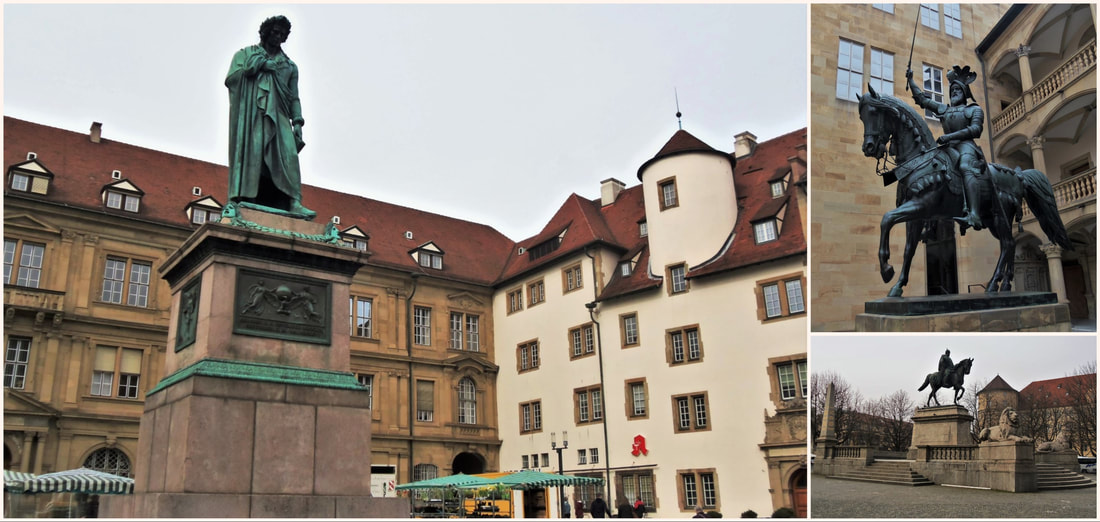
- The Paleontological Museum
- The Egyptian Museum
- Glyptothek (history museum)
- Staatliche Antikensammlungen (neoclassical)
- Lenbachhaus (19th & 20th century art
- . . . and many more

A great adventureI! I don't mind driving when I travel to Europe, but the idea of train hopping from city to city sounds fun. I'll have to do it that way sometime.
Thanks for visiting my page! I find the trains to be very convenient, especially since I only travel with a backpack.
great intro through southern germany! I've been to munich many times for work, and admit I haven't been able to travel around much outside of the city. your post is giving me good reasons to explore next time!
Thank you. Some of the smaller towns in the area look amazing too. In the future, I hope to focus on less traveled destinations.
Oh how I miss Bavaria! I had a great time visiting Munich and can't wait to see more of it.
It is definitely worth a repeat, but I plan on exploring the northern parts of Germany next time.
This brings back great memories of our road trip through southern Germany and Europe in the Alps. Nuremberg is probably our favorite German city because of such rich history.
If I had more time, I would like to have ventured down into Switzerland and Austria. Maybe on the next round.
How long did this all take you? Seems like a great selection of towns to cover off on one trip. How good are beer vending machines in hotels?!
Due to buy schedule at the time, I could only make a quick trip. This amazing journey took place over the course of 6 days (not including my arrival and departure). And yes, that vending machine was a pleasant welcome to Germany. Seems like it was around 3 to 5 euros depending on selection, small bottles of wine too.
Leave a Reply.
Chris J. Baxter "Siege" is an experienced world traveler with a B.A. in Anthropology, a background in healthcare, and an unquenchable thirst for adventure.

Travel Europe on a Budget
The Savvy Backpacker
City Guides .\33 a132798-3f3b-4585-954d-7e70cf863447{fill:#231f20}
Germany train guide – how to travel germany by train.
How to travel Germany by train — tips for buying German train tickets and advice for navigating Germany by rail.
Transportation
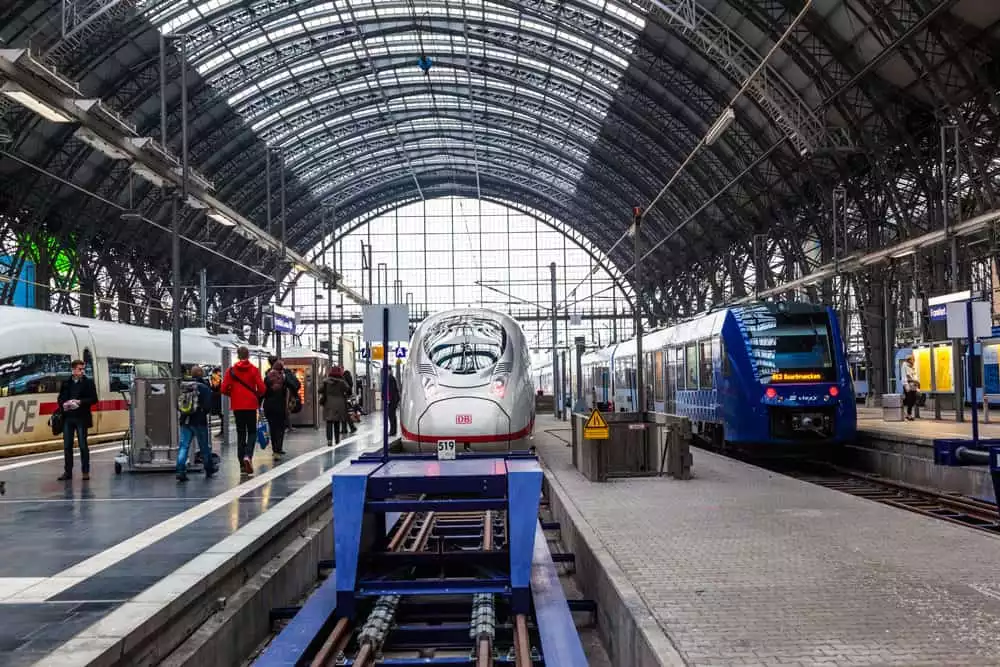
Germany has one of Europe’s greatest rail networks. The trains are fast, frequent, and famous for being punctual. As an added bonus, it’s very easy to book German train tickets online no matter where you’re from. So keep reading because in this Germany Train Guide we’ll cover everything you need to know about traveling through Germany by train—from navigating the system to buying train tickets for the cheapest price.
How To Buy German Train Tickets
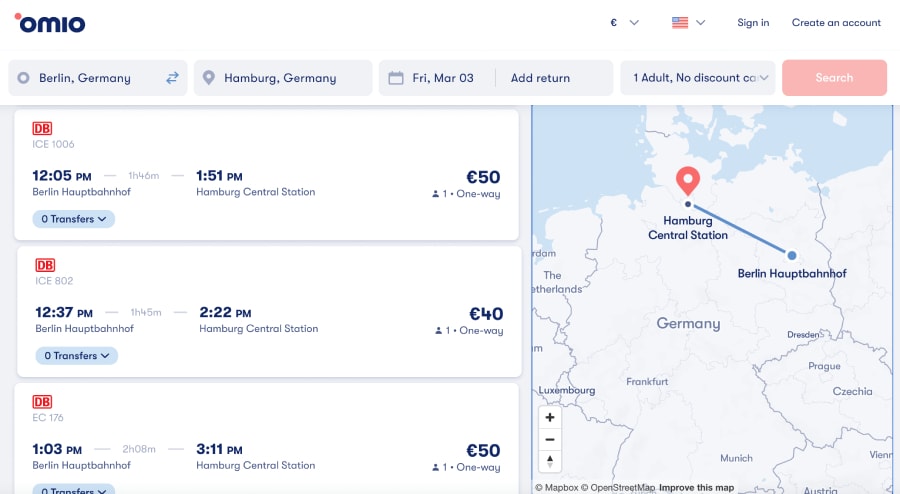
Buying German train tickets is fairly painless since Germany’s rail system’s website is logical and it accepts payments from international credit cards without any hassle. There are also other ways to save (booking early, special tickets, etc.) that we’ll cover below.
Travel Tip: Most train tickets in Germany are now electronic so having reliable high-speed data for your phone is super helpful when traveling by train. Here are a few articles I’ve written to help you get cheap mobile data in Germany: Guide To Mobile Data Plans and Smartphone Phones in Europe , and How To Buy A SIM Card and Mobile Data Plans in Europe .
Where To Buy German Train Tickets
Here are a few places to buy train tickets:
Omio (Recommended)
Omio is a search engine that lets you compare and book trains anywhere in Europe. It allows you easily book tickets with your credit card at essentially the same prices as the Deutsche Bahn website — there is a very small service charge.
Additionally, Omio searches routes for multiple rail services across Europe so it’s great for international trips (since it can easily combine rail journeys of multiple countries).
Train tickets sold via Omio are electronic—simply show the conductor the ticket on your phone (you can also print the ticket if you wish).
TrainLine (Recommended)
TrainLine is another third-party booking site that connects directly to Germany’s National Rail Network and it gives you the same prices you’d find there. They also take international credit card payments without any hassle.
Additionally, it searches routes for multiple rail services across Europe so it’s great for international trips (since it can easily combine rail journeys of multiple countries).
Train tickets sold via TrainLine are electronic — simply show the conductor the ticket on your phone (you can also print the ticket if you wish).
Buying German Train Tickets via Deutsche Bahn—aka the German Rail System
You can buy German train tickets directly through Germany’s national rail system — Deutsche Bahn (www.bahn.de). It accepts most international credit cards and tickets can be sent to you electronically or printed at home.
While rare, sometimes you might encounter some translation issues when using Deutsche Bahn—which is why I prefer using Omio or TrainLine .
NOTE: German train tickets can be purchased about six months in advance.
Buying German Train Tickets At The Train Station
You always have the option to buy your train tickets from any train station in Germany. Every train station will have automated ticket machines and ticket windows. All the machines have an English-language option and most employees staffing the ticket windows will speak English.
DO I NEED TO BUY GERMAN TRAIN TICKETS IN ADVANCE?

Long-Distance Trains
Yes. For high-speed/long-distance trains in Germany, you should book early to get the best price—fares rise as the departure date approaches. For example, a ticket purchased on the day of travel can cost 3x-4x the price as one bought a month or two in advance.
These high-speed trains include InterCity Express (ICE), ICE Sprinter, InterCity (IC), Eurocity (EC).

Regional Trains
No. These trains have a fixed price based on the distance traveled. Simply show up at the station, buy your ticket, and hop on the train. These trains are obviously slower and you’ll have more connections. However, you can book them via the Omio or TrainLine app simply for the convenience of not needing to buy them at the station.
Types of German Train Tickets
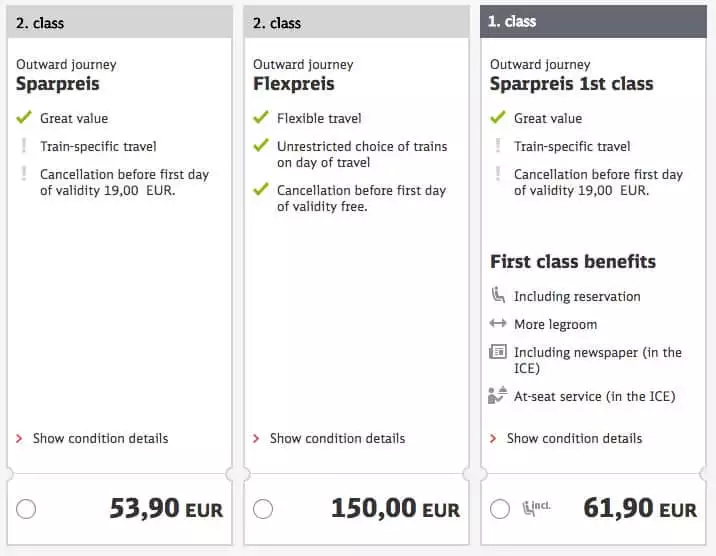
There are two standard ticket types:
- Sparpreis: Sparpreis is a budget ticket that’s valid for a specific route (i.e. it’s not flexible). There is also a first-class version that has the same limitations but you get a few extra perks like nicer seats, more legroom, and access to a nice lounge in large stations — sometimes the first-class and second-class tickets are virtually the same prices so treat yo self.
- Flexpreis: The Flexpreis is a full-price ticket but it offers a lot more flexibility — it’s valid on any train of the day and you can cancel the ticket before the day of travel. It’s also a lot more expensive.
HOW TO COLLECT YOUR TRAIN TICKETS
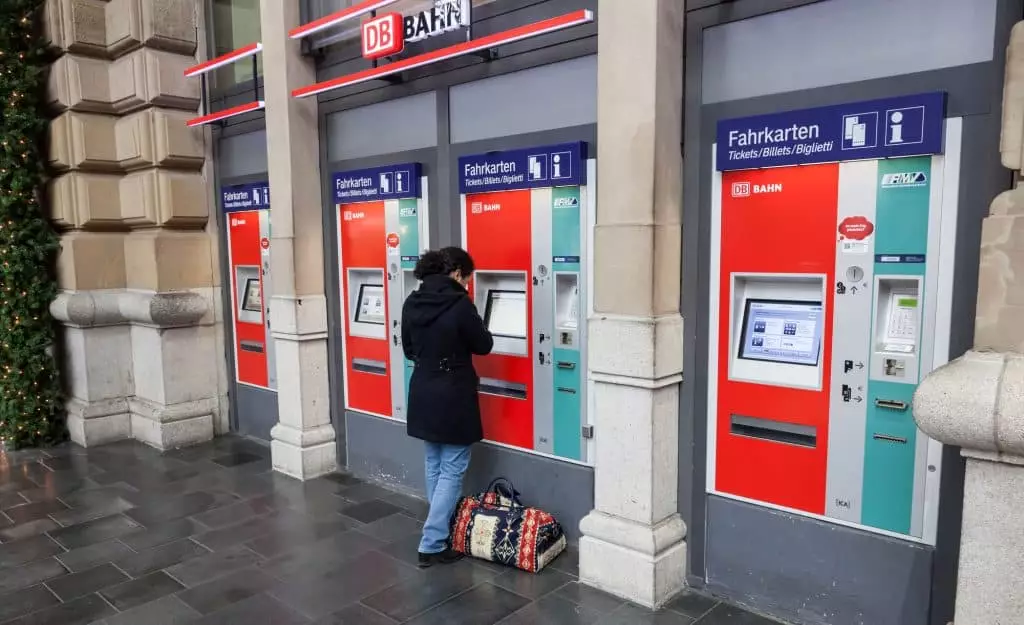
All digital and printed tickets have a QR code that the conductor will scan when they check tickets on the train. It’s super easy.
- Digital Tickets: You can download the ticket as a PDF and save it to your smartphone, tablet, or laptop. This is the easiest way.
- Print: You can also print the PDF.
- DB Navigator App: You can have the ticket loaded to your DB Navigator app.
- Print at the Station: Most of the time you can print your ticket at the station. You’ll be given a code that you type into the ticket machine and it will print there. You can also go to the customer service counter.
- By Mail: Yes, you can get printed tickets mailed to you at an extra cost — I think it’s around €5 and takes a while to arrive.
Tips For Using German Trains
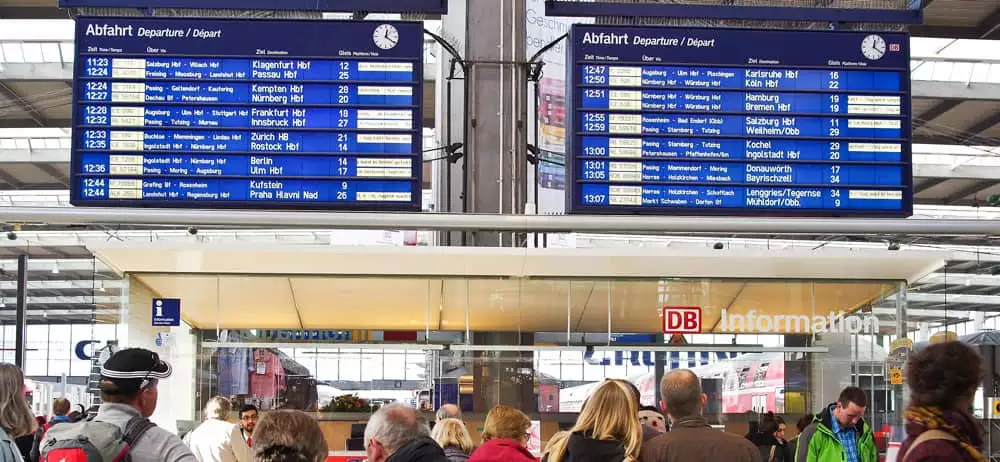
First, we recommend getting to the train station about 20 minutes early so you can find your train platform in plenty of time — by the way, there is no check-in… you simply get on the train. Most are easy to navigate but it’s best to play it safe. Also, if you’re printing a ticket at the station you should leave more time because there can be lines to use the machines.
Once you have your tickets sorted, look at the departure board. This will tell you where to find your train. Pay attention to the board as the platform can sometimes change. Don’t worry if you don’t see your train on the board because they may not list it until it’s closer to departure time.
After you’ve found the platform, use the signs in the station to locate the train. Almost everything should be in English and most Germans speak excellent English.
When the train pulls you’ll want to find your correct car if you have assigned seats (if not, just sit in any non-reserved seat). Each train car will have a number on it so it’s easier to find the car while outside the train than to walk through the train to get to your car. From here, all you gotta do is find your seat.
There is plenty of luggage storage on the train—both above/behind the seats and in the luggage racks at the end of the cars.
Eventually, the conductor will come by to check your tickets.
Rail Passes for Germany
Another great thing about German train travel is that rail passes can actually be a pretty good deal. That’s because they don’t require rail pass users to make reservations — even on the expensive high-speed trains (the exception is overnight trains). So all you gotta do is hop on any train and go.
Check out Eurail.com for the various rail pass options.
Eurail Pass Vs Single Tickets: What’s Cheaper?
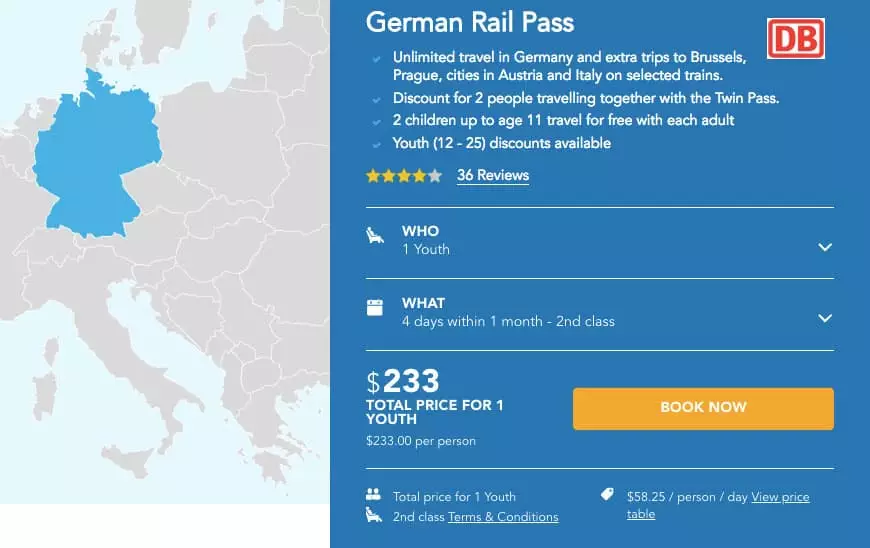
So what’s a better deal—a Eurail pass or single tickets. Well, it depends…
First, you need to look at the per day/per ride cost of the pass — i.e. divide the total cost of the pass by the number of rides it gives you. If you go to Eurail they do a pretty good job of breaking down the per-day price. So, in the image above, a pass that gives four travel days in a month costs $58 (€50) per travel day.
From here you need to estimate how much a single ticket would cost.
The price of a single ticket will vary greatly based on when you buy it and the travel distance. So let’s take a look at a Munich to Berlin ticket.
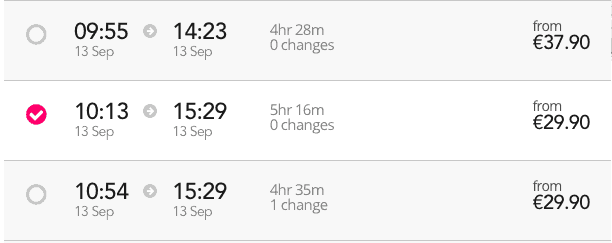
If you buy this ticket four months in advance the price is around €30-€40. So this is quite a bit cheaper than the pass.
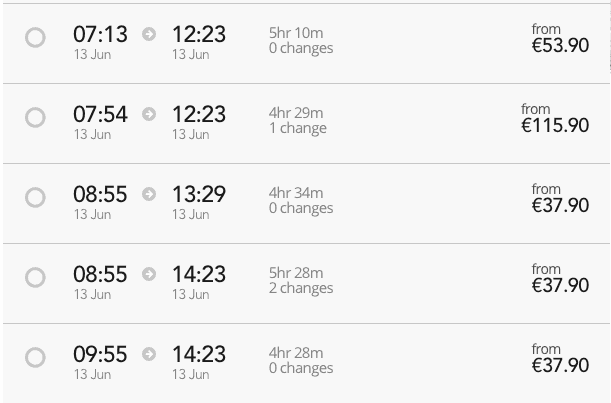
If you buy tickets one month in advance the prices are still fairly affordable at €40-€54. This ends up being a little cheaper or about the same as the pass.
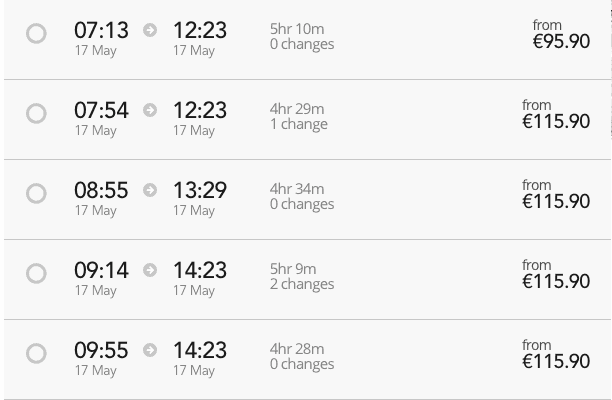
However, when you book less than a week in advance the price skyrockets to well over €50 so a pass is a way better deal.
In conclusion:
Single tickets are almost always cheaper if you buy them a few months in advance but you lose out on flexibility as you have to ride that specific train. Rail passes usually end up being a better deal if your plans aren’t set in stone as you can choose what trains you take on a whim. So we recommend visiting Eurail to see what passes might work for your trip and then do some simple math comparisons.
More Rail Pass Considerations
- 28 & Older: If you’re 28 and over then you’re required to buy a first-class rail pass. This does jack the price up a good amount so it’s less of a deal when compared to 2nd-class single tickets.
- German Rail Twin Pass: When two people travel together they get a 50% discount on the second pass (this is good for both 1st and 2nd class passes). You’ll have to travel on the same train because you’re only given one pass with both your names on it.
More Tips For Riding Trains in Germany
- The Departures Board: You’ll find your train platform via the departure board at the train station. Don’t worry if you don’t see your train because they often only display trains departing within the next 10-20 minutes.
- Self-Service Machines Are In English: Don’t worry if you don’t speak German because the ticket machines (and train station signs) are all in English.
- DB Navigator App: Download Deutsche Bahn’s official app to book tickets, check timetables, and do other helpful stuff.
- Download The Rail Planner App: There are a number of rail apps but we like the Eurail App — it essentially has the timetables/info for every train in Europe and it doesn’t require an internet connection.
- Cheap Tickets Are Non-Refundable: One downside to cheap tickets is that they’re non-refundable and there is a fee to change (but you can’t do it on the day of travel).
- Pack A Picnic: You’re allowed to bring your own food and alcohol on trains. It’s great for those long train rides.
- Luggage: There aren’t any weight limits on luggage and you can bring as much as you want (well, as much as you can carry). Simply bring it on and store it above your head, behind your seat, or in the luggage racks in each car.
- Making Connections: Your trip might require you to change trains along the journey. Don’t worry if there isn’t much time between trains as switching trains are usually fairly quick and easy (it’s not like flying).
- Get To The Train Station Early: Train stations are usually fairly easy to navigate but they can be a little confusing.
- Changing Stations: Some routes might have you switch train stations in a city to make the journey — pay attention to this because stations are usually far apart.
More Articles About Traveling In Germany
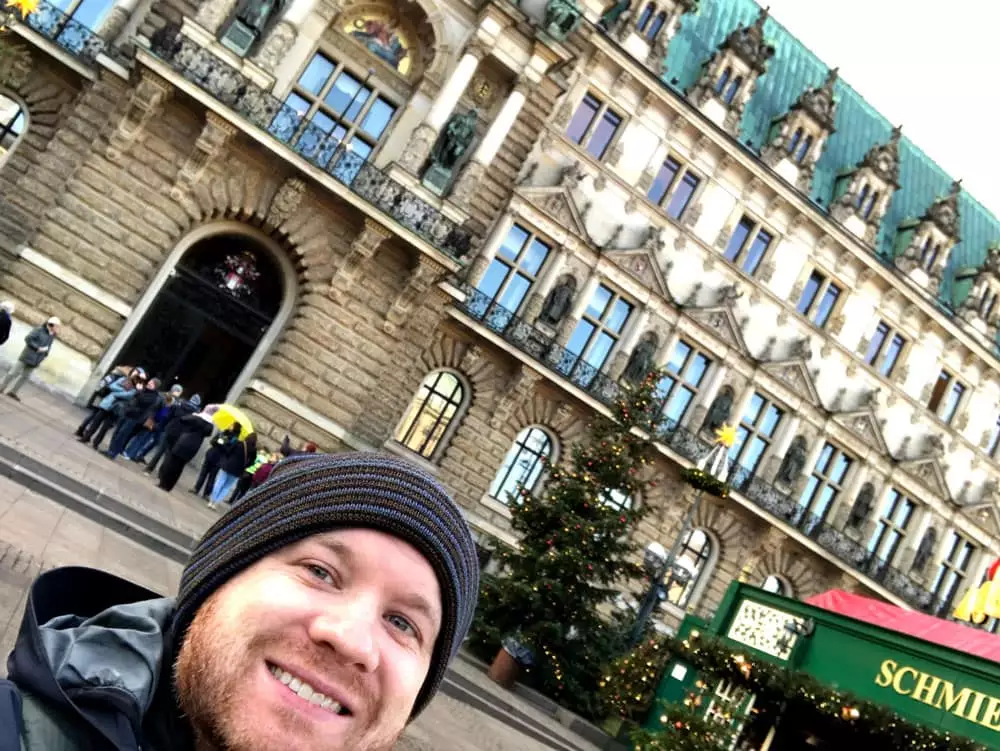
- Berlin City Guide : What to do, see, and eat in Berlin.
- Best Hostels in Berlin : The best cheap places to stay in Berlin.
- How To Choose The Best Travel Insurance : Travel insurance will help cover those non-refundable train tickets if something goes wrong during your trip.
- Packing List For Europe Travel : Tips on packing light — which makes train travel much easier.
- How To Buy Train Tickets In Germany : In-depth guide to buying Germany train tickets.
- Recent Posts
- Best Prepaid UK eSIM | Data Plan Buyer’s Guide - April 21, 2024
- How to Avoid Pickpockets in Europe — Tips for Outsmarting the Thieves - April 19, 2024
- Best Prepaid eSIM For Italy | Data Plan Buyer’s Guide - April 18, 2024

No Funny Business
The Savvy Backpacker is reader-supported. That means when you buy products/services through links on the site, I may earn an affiliate commission—it doesn’t cost you anything extra and it helps support the site.
Thanks For Reading! — James
Questions? Learn more about our Strict Advertising Policy and How To Support Us .
Related Reads
How to purchase train tickets for europe | strategies for buying european train tickets.
Tips on the easiest and cheapest ways to buy train tickets in Europe.
Complete Guide To Train Travel In Europe | How To Travel Europe By Train
Our step-by-step guide to traveling Europe by train.
Italy Train Guide — How To Travel Italy By Train
How to travel Italy by train — tips for buying Italian train tickets and advice for navigating Italy by rail.
France Train Guide — How To Travel France By Train
How to travel France by train—tips for buying French train tickets and advice for navigating France by rail.
City Guides
Choosing travel insurance, travel packing lists, budget travel newsletter.
The best budget travel tips sent straight to your inbox.
Join My Journey
Europe travel tips, advertising & privacy policies.
TheSavvyBackpacker.com is a participant in the Amazon Services LLC Associates Program, an affiliate advertising program designed to provide a means for sites to earn advertising fees by advertising and linking to amazon.com.
© 2010 - 2024 The Savvy Backpacker
Website Design by FHOKE
Exploring Germany through Train Travel: A Perfect Itinerary
by Beau Ragland
assisted by Avo AI technology
Last Updated: 10/10/2023
Welcome to another exciting journey with Voyista--this time on the rails of Germany, where we'll discover charming towns, vibrant cities, and an enchanting landscape. Get ready for an adventure as we explore the highest, fastest, and most picturesque train routes!
Discovering the Joy of German Trains
Germany is home to some of the best and most efficient train networks in Europe. Traveling by train is sustainable and offers the best chance for sightseeing, especially when traveling across Germany's diverse landscapes. Those who have chosen to traverse Germany by train know this affords the best opportunity to smile at a stranger, start a conversation over a cup of coffee, or simply watch as the scenery shifts and shapes outside your window. Our Avopass app will be your dedicated travel companion throughout your train journey, providing all necessary information in real-time.
A Perfect Train Itinerary: From Berlin to Munich
The adventure kicks off in Germany's buzzing capital, Berlin. While there, you can explore historical sites such as the Brandenburg Gate, the Berlin Wall, and the Museum Island. Once you've soaked in all that Berlin has to offer, it's time to take the train to Leipzig. Abuzz with overwhelming architecture, this city had a significant role in triggering the fall of communism in Eastern Europe.
Next stop, Nuremberg. Before World War II, Nuremberg was the unofficial capital of the Holy Roman Empire. Today, this city is a must-visit for history buffs, with attractions such as the Nuremberg Castle, Nazi party rally grounds, and Memorium Nuremberg Trials.
Our final stop will be Munich. The heart of Bavaria, Munich offers a welcoming blend of traditional and modern culture. The city has numerous beer halls, including the famous Hofbräuhaus. And let's not forget about the celebrated Marienplatz--the central square in the city's heart.
Avopass doesn't only include directions to these destinations; we also provide recommendations of what to do once you've arrived, along with easy ticket purchases to top attractions like the Brandenburg Gate and the Nuremberg Castle.
What Sets Voyista Apart
Here at Voyista, we believe in effortless travel. With our innovative Avopass app, we've replaced traditional bus tours with personalized guidance on train schedules, tickets, and more, available 24/7 offline. No more haggling with bus drivers over tickets or schedules, no more missing out on sights while you fuss over bookings. Furthermore, we've prioritized sustainability, reducing travelers' carbon footprint by opting for trains over planes whenever possible.
Traveling across Germany by train offers experiences akin to a beautifully cut montage of the country's history, culture, and landscapes. You'll have full autonomy, meet incredible people, and live your best, eco-friendly travel life. And at Voyista, we've made it our mission to facilitate these life-altering journeys, connecting people and places through sustainable and affordable travel.
OUR RECOMMENDATION:

The Man in Seat 61
A beginner's guide to
Train travel in germany.
- Buy train tickets
- Buy ferry tickets
- Book a hotel
- Privacy & cookies
- Home
Train travel UK & Ireland...
Train travel in europe..., train travel in asia..., train travel in africa..., train travel in america..., train travel in australasia, inter-city train tickets from €12.90.
Deutsche Bahn (German Railways) high-speed IC and ICE trains are easily the best way to travel between major town & cities all over Germany, in comfort at ground level. DB's ICE trains travel at up to 186 mph from city centre to city centre, and if you pre-book direct with the operator you can find some really cheap fares.
Train travel within Germany
International trains to & from Germany
Station guides, general train travel information, useful country information, how to check train times & buy tickets.
To check times & prices and to buy tickets in advance go to the German Railways website int.bahn.de ( on a mobile device, use this link ).
Anyone from any country can use bahn.de, all international credit cards accepted, you print your own ticket or can simply show it on your laptop or phone.
Tip: I recommend registering when prompted, so you can log in, check all your bookings and re-print your tickets at any time.
Do you need to book in advance?
When does booking open.
Booking now opens up to 6 months ahead for German domestic tickets.
It was increased to 6 months from the previous 92 days in 2016. However, the booking period is often less than this for dates immediately after the timetable changes at midnight on the 2nd Saturday in December. Bookings for dates after the mid-December timetable change, including the Christmas period, usually open in mid-October.
Flexpreis or Sparpreis?
If you use int.bahn.de to book a long-distance train it initially shows the cheapest fare available against each train.
If you click on that fare, you'll then see a range of fares, Super Sparpreis , Sparpreis & Flexpreis .
Flexpreis is the full-price flexible fare. A Flexpreis ticket can be bought online or at the station on the day of travel, the price in fact varies slightly on different dates, but not by a huge amount. They are refundable, good for any train that day, just hop on and find any empty unreserved seat, seat reservation on long distance IC, ICE & EC trains is optional for a small extra charge, €4.90 in 2nd class, €5.90 in 1st class.
Sparpreis & Super Sparpreis fares are limited-availability advance-purchase fares, from €12.90, €19.90, €29.90, €39.90 and so on, the price varies significantly depending how far ahead you book and how popular that date, day and train is. Spar is German for save . Sparpreis & Super Sparpreis fares only allow travel on the specific train you book, although if your journey involves a connecting regional train you can use any regional train on the regional part of the route. Prices vary like air fares, rising as departure approaches and the cheaper tickets are sold. They disappear a few days before departure, leaving only the Flexpreis fare.
Super Sparpreis = no refunds, no changes. Sparpreis fares are refundable (although for a DB credit voucher, not cash) up to the day before departure with a small fee deducted, no changes or refunds allowed from the day of departure onwards.
- Children go free! On DB trains, children under 6 go free, no ticket needed. Children over 6 but aged under 15 also go free if they travel accompanied by a fare-paying adult, a great offer. Book your tickets at int.bahn.de and it will work all this out for you.
Only one passenger name is needed
Only one name is necessary as I.D. to support a print-at-home ticket, even if that ticket covers several passengers.
If you buy hard copy tickets at a station, no name at all is needed.
Incidentally, until 2016 you had to show the credit/debit card used for the booking when using print-at-home tickets. I'm glad to say that this changed in October 2016, all you now need is a passport or other recognised ID to support a print-at-home online ticket. You may or may not be asked for it by the conductor.
Tips for using int.bahn.de
Stopovers . If you'd like a stopover en route, but still want a cheap saver fare from end to end, no problem. Go to int.bahn.de and enter your start and end point, simply click Stopover , enter the place where you want to stop off, enter the number of hours stopover and off you go. Maximum 2 days validity with a Sparpreis fare.
Alternatives to using bahn.de: Bahn.de is one of the best train operator sites, but if for any reason you want an alternative site which can also book DB trains at DB prices, try these two:
Raileurope.com has a direct connection to DB's ticketing system so it sells the same trains, same prices, same print-at-home tickets at Bahn.de, but with a small booking fee. It accepts all international credit cards so can be used by anyone from any country. Raileurope.com also connects to the French, Italian & Spanish ticketing systems so can easily book multi-operator journeys such as Munich to Naples (which involves DB and Trenitalia) or Frankfurt to Bordeaux (which involves DB and SNCF). Raileurope.com is also capable of splitting the booking to book some cross-Germany journeys (for example, Brussels to Poland) for which you'd have to manually split the booking at some logical point within Germany if you wanted to use bahn.de.
Thetrainline.com also has a connection to DB's system, so can sell print-at-home tickets (but not those which need to be posted) for DB train at the same prices as DB, but with a small booking fee.
Competing lo-cost operator: Flixtrain
Almost all long-distance trains in Germany are operated by Deutsche Bahn (DB), the State-owned German Federal Railways. But there is now one other long-distance operator worth mentioning.
Buy tickets by phone in the UK
If you live in the UK you can buy German train tickets direct from Deutsche Bahn on their English-speaking telesales line, 00 49 (0)30 311 68 29 04 . Lines open 08:30-20:00 Monday-Friday, 09:00-13:00 Saturday & Sunday UK time, 1.5% fee for phone bookings.
Custom-made tours of Germany by train
Railbookers are a train travel specialist who can put together a tour of Germany for you as a package, including rail travel, hotels & transfers. On their website you'll find a range of suggested tours & breaks which can be varied or customised to your own requirements. And as you're booking a package, they'll take care of you if anything happens to one part of the itinerary such as a strike or delay. They now have offices in the UK, USA & Australia.
Tailor Made Rail can arrange tours of Germany by train, they have suggested itineraries or they can organise a trip based on your own requirements, they welcome complex itineraries! As it's a package, they'll take care of you if anything happens on one part of the trip, for example, a national strike. They're TTA-protected - like ATOL, but not only for agencies that sell air travel.
Call their dedicated seat61 phone line 020 3778 1461 and quote seat 61 when booking. From outside the UK call +44 20 3778 1461. Lines open 09:00-17:30 Monday-Friday. Their website is www.tailormaderail.com/destinations/germany .
Back to top
DB's discount card: Bahncard
What are bahncards.
You get the discount on German domestic journeys, and on international journeys to, from or across Germany.
However, for international journeys the discount will not normally be the full 25% or 50% as the reduction is not necessarily applied to the part outside Germany (test it before buying a Bahncard to see what actual effect a Bahncard has - see my top tip below).
Man in Seat 61's top tip: Before buying a Bahncard, run an enquiry for the journeys you actually plan to make, using int.bahn.de (a) as normal and (b) with a Bahncard 25 or Bahncard 50 discount added. See what it does to prices. If you see no difference, the discount may not apply to your particular journey. If you see a difference, do the savings justify the cost of the card?
Types of Bahncard
Each type of Bahncard can be bought for either 2nd class or 1st class.
Check prices & buy a Bahncard
Special regional tickets.
These one-day unlimited travel passes are well worth knowing about, even though they're not valid on fast long-distance trains, only on slower regional trains. If you want a railpass valid on all trains, including high-speed and long-distance ones, see the German Rail Pass section below .
Deutschland ticket
Unlimited travel on regional transport nationwide for €49 a month
From 1 May 2023 Germany offers unlimited travel on regional transport nationwide for €49 per month. This is the successor to the popular (but temporary) €9 ticket created after the pandemic to address the cost-of-living crisis. Unlike the €9 ticket, the Deutschlandticket will be a permanent product.
The Deutschland ticket is good for all regional trains run by DB and by other operators across the whole of Germany ()marked R, RE, RB, IRE or S-Bahn in the timetable) and other types of local & regional transport including local buses, city buses, trams & U-Bahn.
It's even valid on the famous Harz Railway , including steam-hauled trains, but not on the branch line up the Brocken.
It's not valid on long-distance ICE & IC trains or similar long-distance trains classified EuroCity, Eurostar, TGV, Railjet, Westbahn, Flixtrain or Snälltåget. So yes, you could cross Germany with it if you wanted, but only using slower regional trains.
The Deutschland ticket covers journeys wholly within Germany, with a few exceptions: For example, it's valid on cross-border regional trains to/from Salzburg in Austria, to/from Venlo, Arnhem, Hengelo & Enschede in the Netherlands, to/from Basel Bad Bf & Basel SBB in Switzerland, and to/from Zgorzelec in Poland. But remember, only on the regional trains (marked R, RE, RB, BRB and so on), not EC, RJ, RJX, IC or ICE long-distance trains or privately-run Westbahn (WB) trains.
It's valid from the 1st of the month to the end of the month : Unlike normal passes or season ticket which can start on any date you choose, each month's Deutschland ticket is valid from the 1st of the month to the last day of the month. So if you bought one on 30 May, that would be a 'May' Deutschland ticket valid from 1 to 31 May and you'd only get 2 days use out of it, 30 & 31 May - but it would still cost €49!
Only sold as a rolling monthly subscription : It's aimed at commuters not tourists, so the Deutschland ticket is only sold as a rolling monthly subscription or one-off annual payment. However, you can cancel the monthly subscription it at any time, even after paying for only 1 month, just be aware that most vendors require you to cancel before the 10th of the month to avoid paying for the following month's €49 Deutschland ticket. Most vendors require payment by direct debit, a few allow payment by credit card.
Children : As it's aimed at commuters, there's no child version and no provision to add children to your account. However, a child can travel on an adult ticket (just not the other way around). If you want to buy Deutschland tickets for yourself and your children, use RMVgo app at sites.rmv.de/en/deutschlandticket , the Rhein-Main Lander, because this (unlike other Landers' apps) allows one person to open an account and buy Deutschland tickets for multiple people including children, with a credit card in one transaction. The catch? It may not accept non-German addresses, my correspondent had to use the address of his German hotel but successfully bought tickets for himself and his kids. Feedback would be appreciated .
If you only want a Deutschland ticket for one month to enjoy a one month's unlimited travel on regional trains across Germany, buy a Deutschland ticket before the 10th of that month by setting up a monthly credit card payment. Then make sure you cancel the subscription before the 10th of that same month to avoid paying for the following month.
How to buy a Deutschland ticket:
Don't bother trying to use the German Railways (DB) website www.bahn.com to buy a Deutschland ticket as it only accepts payment by direct debit and setting up a direct debit with a non-German bank account results in an error message. #fail!
The easiest way for foreign visitors to buy a Deutschland ticket is to buy from Bremen area transit authority VBN using their FahrPlaner app because (a) it accepts payment by credit card, (b) it's in English, and (c) it has no problem with overseas users, overseas addresses or UK postcodes. #result!
Step 1, download the FahrPlaner app for iPhone or MFahrPlaner app for Android (please let me know if those links stop working).
Step 2, the app should open in English. Click the menu icon top left and go to Tickets . Then select Deutschlandticket.
Step 3, click the red PROCEED TO LOGIN button at the bottom. Then click Sign up for free and register, it lists most countries including United Kingdom and United States and has no problem with UK postcodes.
Step 4, select Credit Card and buy your Deutschland ticket.
This is a rolling subscription which you can cancel at any time.
You show the Deutschland Ticket as a QR code in the app on your phone. Easy!
If you only want one Deutschland ticket for one month, buy it before the 10th of the month then cancel your subscription also before the 10th of the month. That prevents payment being taken for the following month.
To cancel the subscription, you must open the order confirmation email they sent you when you bought it and click on the cancellation link. You cannot cancel your subscription from the app.
If you have children, you'll need to use the RMVgo app instead, see the paragraph about children above.
Quer-durchs-Land-Ticket
Unlimited regional off-peak train travel, €46.
The Quer-durchs-Land-Ticket ( Day Ticket for Germany ) gives a day's unlimited travel from 09:00 weekdays or from 00:00 Saturdays & Sundays, until 03:00 the following morning on all regional & regional-express trains (RE, RB, IRE, S-Bahn) throughout the whole of Germany.
The first traveller pays €46, each additional passenger pays just €9 to be added to the same ticket, up to a maximum total of 5 passengers.
You can't use fast IC, ICE or EC trains, only slower regional trains, so a long-distance journey which could be made on a fast direct IC or ICE train could be very slow and involve several changes if made using purely regional trains. But it can be a very cheap way to go, especially if you haven't been able to book a cheap advance-purchase ticket for an ICE or IC train.
For more information, see int.bahn.de/en/offers/regional/day-ticket-germany .
To buy a ticket online and print it out yourself, see int.bahn.de/en/offers/regional/day-ticket-germany .
Alternatively, these tickets can be bought on the day of travel from the self-service ticket machines at German stations, although it costs €2 more if you buy from a staffed counter.
Lander tickets
Bayern ticket, schönes-wochenende-ticket : discontinued, railpasses for germany, interrail germany pass: click to check prices & buy online, german rail pass, maps of the german rail network, what are german trains like , intercity express (ice).
InterCity Express high-speed trains, usually known as ICE, are German Railways' front-rank trains, travelling at up to 200 km/h (186 mph, ICE3), 280 km/h (175 mph, ICE1 & ICE2) or 250 km/h (155 mph, ICE4). They have 1st & 2nd class, a restaurant car, power sockets at all seats & free WiFi. More about ICE trains .
InterCity trains (IC)
InterCity trains travel at up to 200 km/h (125 mph), usually using a locomotive and conventional carriages. Some InterCity trains cross borders into neighbouring countries and these may be classified EuroCity (EC) rather than InterCity. Power sockets at all seats, and usually some sort of refreshment service. More about IC trains .
A German Intercity train at Amsterdam Centraal .
2nd class seating on an Intercity train. Larger photo .
Regional trains
Regional trains are shown as R, RB, RE and so on, where RE is a faster regional express. Some are operated by Deutsche Bahn (DB, German Railways), others are outsourced to private operators such as Abellio, Metronom, Erixx, but still run as part of the national network with tickets sold by DB at int.bahn.de . They come in many different shapes and sizes, some single-deck, some double-deck. No catering, so bring your own food & drink. No seat reservation necessary or possible, you sit where you like.
Sleeper trains
There are several German domestic routes where a sleeper is an option. These are now run by ÖBB (Austrian Railways) and branded Nightjet:
Düsseldorf, Cologne, Koblenz < > Munich, see the Nightjet page .
Hamburg, Hannover < > Munich, see the Nightjet New Generation page .
Seat numbering plans : Click here
Travel tips.
Language problems?
First-time visitors often think this will be a problem, but it hardly ever is. At stations, signs are usually in English as well as German, or they use easy-to-understand pictograms. On-train announcements on long-distance trains are often made in English as well as German.
Food & drink on German trains
Most long-distance trains have at least a bistro car serving tea, coffee, wine, beer & snacks from a counter, with some tables nearby if you'd want to eat and drink in the bistro car rather than take it back to your seat. See sample ICE bistro menu . Many German long-distance trains have a proper sit-down waiter-service restaurant car. In first class on ICE you'll often be asked if you want to order food or drink, and it will be brought and served at your seat.
Alternatively, feel free to bring your own food and drink (even a bottle of wine, if you like) onto the train, there's no rules against that on the rails.
Luggage on trains
There are no baggage fees or weight limits, and you don't check your bags in, you simply take them with you onto the train, placing them on the racks at the end of each car or amongst the seats, or above your head. It's usually possible to keep all your bags in sight. More about luggage on trains .
Should you reserve a seat or not?
Reserving a seat is optional on most German trains. You can add a reserved seat to your booking for €4.90 in 2nd class, €5.90 in 1st class.
If you don't reserve, you simply sit in any empty unreserved seat. Small LED displays above each seat show which seats are reserved between which stations, and which seats are free. Travelling alone, middle of the day, mid-week in February, you'll have plenty of seats to choose from. But a family group, travelling on a Friday afternoon in July would be well advised to reserve seats. And for any long journey it's best to be on the safe side and reserve.
You can make a seat reservation separately (i.e. after buying your ticket) by going to int.bahn.de , clicking in the from or to field to open the parameters panel, set up an enquiry and run it by clicking Book seat only .
On the seat reservation display for each seat:
ggf. reserviert - this means the train's on-board reservation system hasn't been updated with the latest information from the main DB reservation system. Usually all of the seats show this message if this happens. Seat reservations are still valid, but cannot be shown on the LED displays, so you can sit in these seats but you could be asked to move if someone shows up with a reservation.
ggf. freigeben - this is a last-minute reservation seat. You can sit in it if you like, but will have to move if someone shows up with a reservation.
bahn.comfort - travellers holding a frequent traveller BahnCard have priority for these seats. You can sit in these seats but someone with a BahnCard may show up and claim it. Though how they'd know you didn't have a BahnCard and so ask you to move is another question!
Schwerbehinderte means that seat is reserved for people with disabilities.
First class lounges at stations
There are lounges for holders of certain types of first class ticket at Berlin, Bremen, Dresden, Düsseldorf, Frankfurt am Main, Frankfurt Main Airport, Hamburg, Hanover, Cologne, Leipzig, Mannheim, Munich, Nuremberg, Stuttgart. Follow the signs to the DB Lounge . They're typically open 07:00-21:00 daily, search int.bahn.de for details. The lounges offer complimentary tea, coffee, soft drinks, beer & snacks. Unfortunately, only holders of expensive 1st class Flexpreis tickets get lounge access, you don't get access with 1st class Sparpreis or Super Sparpreis fares or 1st class Interrail or Eurail passes.
Left luggage at stations
All German stations except the smallest have left-luggage lockers in various sizes, up to suitcase-sized. More information on left luggage lockers & prices .
Bikes can be carried on all German trains if semi-dismantled & placed in a bike bag, they then travel as ordinary luggage.
Undismantled bikes are carried on most suburban & regional trains, you need a Bicycle Day Ticket ( Fahrradtageskarte ) which you can buy online at int.bahn.de (use the site search to find it) or at stations for a few euros.
Undismantled bikes are also carried on most InterCity trains , ICE-T & ICE4 trains for a fee as these have been fitted with bike racks, prior reservation required. Undismantled bicycles are not carried on high-speed ICE trains other than ICE-T & ICE4 .
To find a train that takes bikes, go to int.bahn.de , click in the from field to open the details panel and select Bicycle transport possible .
To book yourself and your bike on a train in Germany, go to int.bahn.de , click in the from field to open the details panel, click on Passenger, bicycles and add a bicycle to the booking. For more information, see the bicycles by train page .
Dogs & pets
Dogs can be taken on all German trains, sometimes free, sometimes for a small fee. For more information, see the dogs & pets page .
Places not served by the main rail network
Neuschwanstein, Germany's fairytale castle: See details here .
Eagles's Nest: See details here .
Take a good guidebook. For independent travel, the best guidebook is either the Lonely Planet or Rough Guide. Both guidebooks provide an excellent level of practical information and historical and cultural background. You won't regret buying one!
Buy in the UK from Amazon.co.uk
Or buy in the usa from amazon.com.
Or buy the Lonely Planets from the Lonely Planet website , with shipping worldwide. Alternatively, you can download just the chapters or areas you need in .PDF format from the Lonely Planet Website , from around £2.99 or US$4.95 a chapter.
Tours of Germany by train
Railbookers, railbookers.co.uk.
If you want to tour Germany by train, with all your train reservations and hotels sorted for you, contact rail travel specialists Railbookers and they'll create the best rail holiday for you, hassle-free. They take good care of their clients and get a lot of repeat business. They have offices in the UK, USA & Australia.
Tailor Made Rail, tailormaderail.com
Tailor Made Rail can arrange tours of Germany by train based on your own requirements, they welcome complex itineraries. As it's a package, they'll take care of you if anything happens on one part of the trip, for example, a national strike. They're TTA-protected - like ATOL, but not only for agencies that sell air travel.
Recommended hotels
Here are my suggested hotels conveniently located for arrival by train in key German cities, all with good or great reviews. You are unlikely to be disappointed by any hotel scoring over 8.0 out of 10 on Booking.com .
In Frankfurt
If you walk out of Hamburg Hbf's main eastern exit, you'll find a row of good hotels lined up in front of you on the opposite side of the Kirchenallee. The pick of these is the excellent 4-star Hotel Reichshof Hamburg , across the road and to the left with art deco-based design and great reviews. It has its own restaurant for lunch or dinner, although I'd still be tempted to try the beer & traditional German food at Nagel's bar, 150m south along the Kircheallee, restaurant-kneipe-hamburg.de .
The Hotel Europaischer Hof is another good choice and directly in front of you across the road when you walk out of the station. Other hotels next to Hamburg Hbf with good reviews include the 5-star Hotel Continental Novum (to the right of the Europaischer), Hotel Furst Bismarck (to the right of the Continental Novum), and the Hotel Atlantic Kempinski .
If you'd prefer a hotel right in the city centre, the Henri Hotel Hamburg Downtown is 5 minutes walk from the station on the city side, and gets really great reviews.
If you're on a budget, private rooms in the A&O Hotel start at around £33 for one person or £49 for two people booked at www.hostelworld.com . The A&O is an 11-minute 900m walk south of Hamburg Hbf, see walking map . Also try the innovative Cab20 capsule hotel , a 550m 6-minute walk from the station, see walking map .
Affordable hotels right next to Munich Hbf with good or great reviews include the reliable Eden Hotel Wolff or the NH Collection München , both directly across the road from the station's north side exit, ideal for an overnight stop between trains. I've used the Hotel Wolff myself.
Also consider the more upmarket 25 Hours Hotel The Royal Bavarian , Excelsior by Giesel or Mercure München City Center , all a stone's throw from the station with great reviews.
If you want to push the boat out, the luxurious 5-star Sofitel Munich Beyerpost is right outside the station's south side exit, located in the former Royal Bavarian Post Office building dating from 1896-1900. It comes complete with a spa with massage service and sauna.
If you're on a budget, the Wombat's Hostel Munich is close to the station's south side exit with private rooms & dorm beds, with good reviews.
Booking.com for hotels
I generally use Booking.com for hotels for 3 reasons:
(1) It keeps all my hotel bookings together in one place;
(2) I've come to trust Booking.com 's review scores;
(3) Booking.com usually offers a clearly-marked Free cancellation option.
Free cancellation means you can secure hotels risk-free even before trains open for booking, and if necessary change those bookings if your plans evolve.
If I'm only staying a night or two, I look for a hotel near the station to make arrival & departure easy. You can enter the station name (e.g. Berlin Hbf ) as search location. If staying longer, I look for a hotel close to the sights, entering the name of a city attraction as the search location, then using map view.
AirBnB: Airbnb.com
www.airbnb.com began in 2008 when two designers who had space to share hosted three travellers looking for a place to stay. AirBnB is a platform which connects hosts with guests, so you can now book a room in people's homes, or an apartment, flat or house which people want to rent out. It can be nicer than a hostel, cheaper than many hotels.
Backpacker hostels: Hostelworld.com
www.hostelworld.com : If you're on a tight budget, don't forget about backpacker hostels. Hostelworld offers online booking of cheap private rooms or dorm beds in backpacker hostels in Paris and most other European cities at rock-bottom prices.
Travel insurance & other tips
Always take out travel insurance.
You should take out travel insurance with at least £1m or preferably £5m medical cover from a reliable insurer. It should cover trip cancellation and loss of cash & belongings up to a reasonable limit. These days, check you're covered for covid-19-related issues, and use an insurer whose cover isn't invalidated by well-meant but excessive Foreign Office travel advice against non-essential travel. An annual policy is usually cheapest even for just 2 or 3 trips a year, I have an annual policy with Staysure.co.uk myself. Don't expect travel insurance to bail you out of every missed connection, see the advice on missed connections here . Here are some suggested insurers, I get a little commission if you buy through these links, feedback always welcome.
Get an eSIM with mobile data package
Don't rely on WiFi, download an eSIM with a European mobile data package and stay connected. Most newer mobile phones can download a virtual SIM including iPhone 11 & later, see device compatibility list . There's no need to buy a physical SIM card! Maya.net is a reliable eSIM data retailer with a 4.5 out of 5 Trustpilot rating and a range of packages including unlimited data .
Get a Curve card for foreign travel
Most banks give you a poor exchange rate then add a foreign transaction fee on top. A Curve MasterCard means no foreign transaction fees and gives you the mid-market exchange rate, at least up to a certain limit, £500 per month as I write this. The money you spend on your Curve card goes straight onto one of your existing debit or credit cards. And you can get a Curve card for free.
How it works: 1. Download the Curve app for iPhone or Android . 2. Enter your details & they'll send you a Curve MasterCard - they send to the UK and most European addresses. 3. Link your existing credit & debit cards to the app, you can link up to two cards with the free version of Curve, I link my normal debit card and my normal credit card. 4. Now use the Curve MasterCard to buy things online or in person or take cash from ATMs, exactly like a normal MasterCard. Curve does the currency conversion and puts the balance in your own currency onto whichever debit or credit card is currently selected in the Curve app. You can even change your mind about which card it goes onto, within 14 days of the transaction.
I have a Curve Blue card myself, it means I can buy a coffee on a foreign station on a card without being stung by fees and lousy exchange rates, just by tapping the Curve card on their card reader. The money goes through Curve to my normal debit card and is taken directly from my account (in fact I have the Curve card set up as payment card on Apple Pay on my iPhone, so can double-click my phone, let it do Face ID then tap the reader with the phone - even easier than getting a card out). I get a little commission if you sign up to Curve, but I recommend it here because I think it's great. See details, download the app and get a Curve card , they'll give you £5 cashback through that link.
Get a VPN for safe browsing. Why you need a VPN
When travelling you may use free public WiFi which is often insecure. A VPN encrypts your connection so it's always secure, even on unsecured WiFi. It also means you can select the geographic location of the IP address you browse with, to get around geoblocking which a surprising number of websites apply. See VPNs & why you need one explained . ExpressVPN is a best buy with a 4.7 out of 5 Trustpilot ranking which I use myself - I've signed up as an ExpressVPN affiliate, and if you go with expressvpn.com using this link you should see a special deal, 3 months free with an annual subscription. I also get some commission to help support this site.
Carry an Anker powerbank
Tickets, reservations, hotel bookings and Interrail or Eurail passes are often now held on your mobile phone. You daren't let it run out of power, and you can't always rely on the phone's internal battery or on being near a power outlet. I always carry an Anker powerbank which can recharge my phone several times over. Buy from Amazon.co.uk or Buy from Amazon.com .
Touring cities? Use hill walking shoes!
One of the best things I've done is swap my normal shoes for hill-walking shoes, in my case from Scarpa. They're intended for hiking across the Pennines not wandering around Florence, but the support and cushioning for hiking works equally well when you're on your feet all day exploring foreign cities. My feet used to give out first and limit my day, now the rest of me gives up before they do!
Back to home page

Get our Rail Planner app
Plan your trip, get extra discounts, and show your Pass as you go.

Our favorite spring routes
Celebrate spring with these 7 off-the-beaten-path train routes

All about seat reservations
Everything you need to know about booking your seats

Alternatives to Busy Routes
Travel between popular European cities without seat reservations

Through our Chatbot in the bottom right corner.

Ask the Community
Browse questions from fellow Eurail travellers, or ask your own!
- Plan your trip
- Suggested Itineraries
Germany Travel Itinerary
- Order overview
- Reservations overview
- My Trips & Travelers
- {{translatedTraveler}} {{#promotional}} {{currencySign}} {{standardPrice}} {{/promotional}} {{quantity}}x {{currencySign}} {{finalPrice}}
- Child {{childPasses}}x FREE
- {{translatedPassType}}
- {{translatedValidityPeriodDescription}}
- {{translatedClass}}
- Remove Pass(es)
- {{variant.localizedTravelPackDescription}} {{quantity}}x Free
- {{variant.localizedPassUpgradeDescription}} {{quantity}}x {{currency}} {{price}}
- Your order will arrive by {{expectedDeliveryDate}} 1 x {{currency}} {{price}}
Your cart is empty
Germany is impressive. Picture this: Natural and architectural wonders, distinctive dishes and beers, and a fascinating history. The country is a feast for the eyes, mouth, and mind. Our Germany itinerary takes you on an adventure through five major cities. From skyscrapers to historical landmarks, museums to parties, and a constant cool factor - we've got all interests covered.
We offer one-country passes to Germany at our dedicated German Rail Passes site.
Itinerary highlights
Cities visited on this trip:.
Click here or on the map to view this route in our Trip Planner

Frankfurt, Germany
Frankfurt is the financial capital of Europe - for proof, just look at its modern skyscrapers and the giant Euro Sculpture in front of the European Central Bank. Go to Main Tower and take an elevator to its viewing platform. On a clear day you’ll be able to see above the entire city, the river Main, and their surrounding areas. Another architectural delight is the My Zeil shopping center, located on Frankfurt’s bustling shopping street Zeil. The building’s remarkable curved glass roof and vortex-shaped facade has to be seen to be believed. Afterwards, step back into nature at the City Forest (Stadtwald), Germany’s biggest inner-city forest.
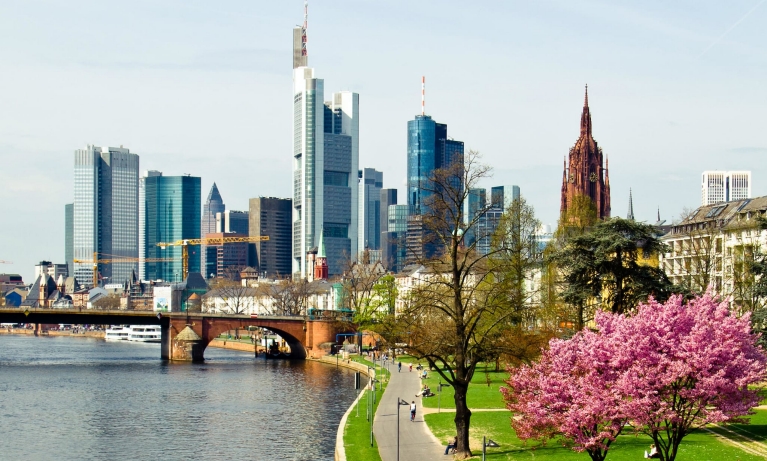
From Frankfurt to Cologne
Travel time:
Reservation needed:
Frankfurt am Main Hbf
Reservation optional
Cologne, Germany
Cologne (köln), germany.
The magnificent Cologne Cathedral (Kölner Dom) welcomes you when you arrive in Cologne – it lies on the doorstep of the main train station. Reach the top of the South Tower’s spiral staircase and be rewarded with a sweeping view over the river Rhine. The nearby Hohenzollern Bridge is covered with love padlocks. Cultural buffs have a smorgasbord of museums and galleries to discover. Modern art fans should go to Museum Ludwig . If you like big celebrations, time your visit for the crazy Carnival in February, or Christopher Street Day and the Cologne Lights Festival (Kölner Lichter) in July.
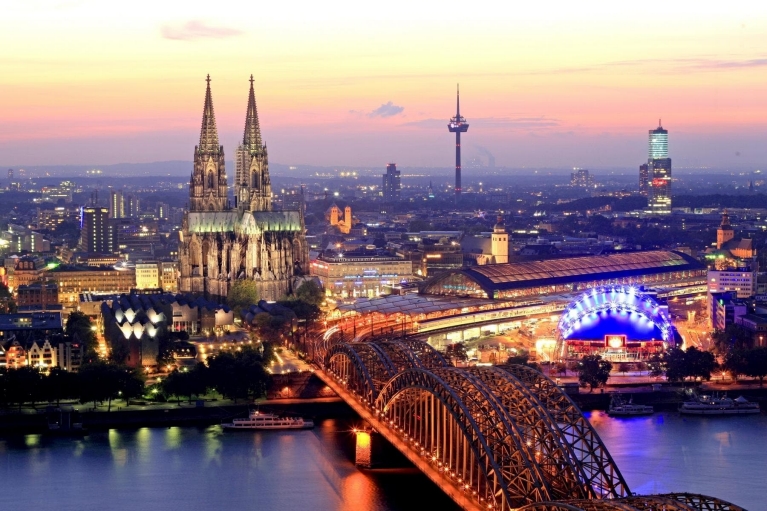
From Cologne to Berlin
Berlin, germany.
Berlin. The capital of cool. It has an exciting mix of history, culture, and nightlife, with discoveries at every corner. Make sure you add the East Side Gallery to your Berlin itinerary – it’s the world’s largest open-air gallery with murals painted across almost a mile (1.3 kilometers) of the former Berlin Wall. One of the most iconic symbols of the city is the 18 th century Brandenburg Gate . Minutes away lies the Holocaust Memorial . Its thought-provoking design and underlying museum leave a somber reminder worth reflecting on – definitely a must for your Germany itinerary.
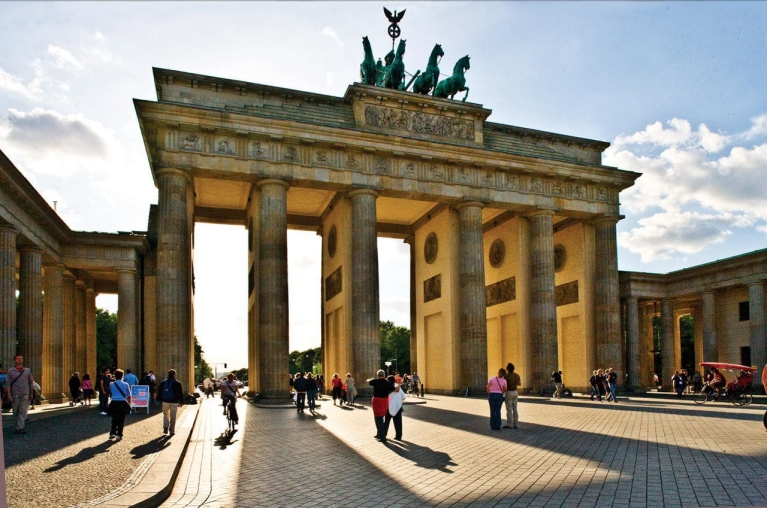
From Berlin to Dresden
Reservation required
Dresden, Germany
Dresden Hbf
Dresden is a cultural and architectural gem. It was called the “Jewel Box” thanks to its former role as the royal residence of the kings of Saxony. Most of Dresden’s historical center was destroyed by bombings in 1945, but much has been restored to its former glory. The city's inner old town holds several treasures, including Dresden's signature landmark the Church of Our Lady (Frauenkirche). Its ruins were left untouched for over 40 years after the bombings. Reopened in 2005, it now symbolizes hope and reconciliation. Semper Opera is another architectural masterpiece. It's an opera house, concert hall, and ballet stage, all in one grand setting.

From Dresden to Munich
Munich, germany.
München Hbf
Munich (München), Germany
Munich, Germany: home of proud Bavarians; kingdom of world-class beer. The main square Marienplatz is a great starting point for exploring the Old Town. Minutes away is the Hofbräuhaus , a definite must-see on your Munich itinerary. The world’s most famous beer hall has been around since 1589. Still up for more beer? Take a daytrip to Andechs Monastery , where Benedictine monks have been brewing beer since 1455. To gain an insight into the sad events of the Holocaust, visit the Dachau Concentration Camp . It provides a chilling account of the first National Socialist concentration camp. Tours are free.
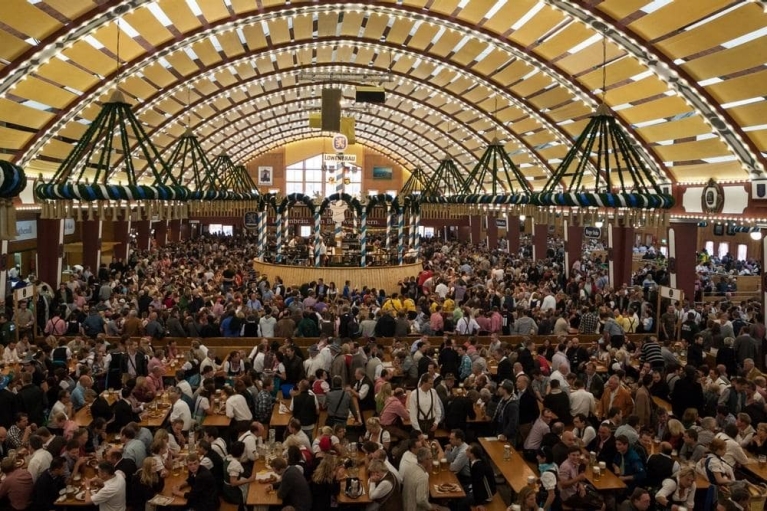
For this itinerary we recommend:
- The German Rail Pass
- Travel days: 4 days within 1 month
For ICE trains in Germany it's not mandatory to have a reservation. However, we recommend you to buy a reservation for these trains, especially if you're traveling in a group. If you travel without a reservation, you might get asked to leave your seat because someone else reserved it.
These reservations are not included in your Eurail Pass. Make sure to book your seats in advance, there are limited seats available for Eurail Pass holders. It's also possible to avoid reservations all together, simply by taking regional trains .
What are my Pass options?
German Rail Pass The ultimate Pass for train travel in Germany.
Eurail Global Pass Lets you travel in 33 countries, including Germany.

Related Pages
1 week in the netherlands.
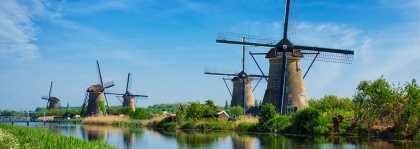
France Itinerary

Switzerland Itinerary

Austria itinerary

Change of currency
You cannot change the currency once you have a Pass in your cart. Remove the Pass, and then change the currency on the website header.
Main navigation
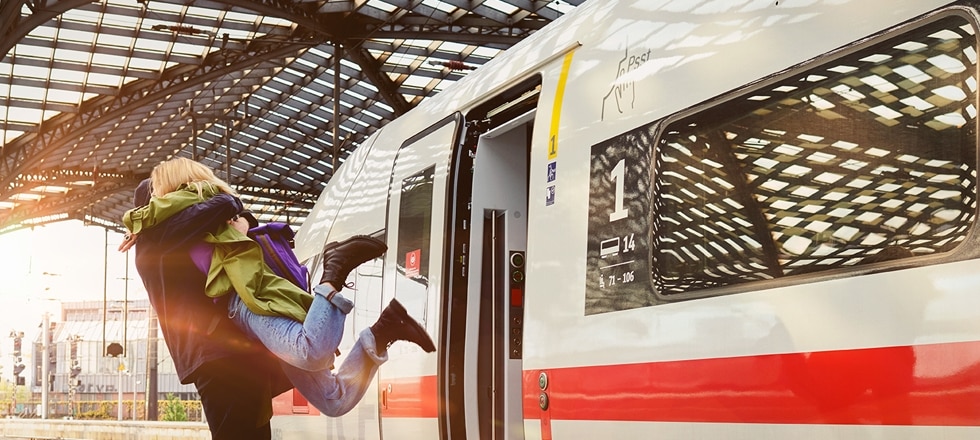
Affordable rail travel
Enjoy low-cost train travel from EUR 17.90 with the super saver fare.
Sie haben in Ihrem Browser JavaScript deaktiviert, dies wird jedoch von unserer Anwendung benötigt. Bitte aktivieren Sie JavaScript in Ihrem Browser.
Cheap Train Tickets | Timetables for Germany & Europe - Deutsche Bahn
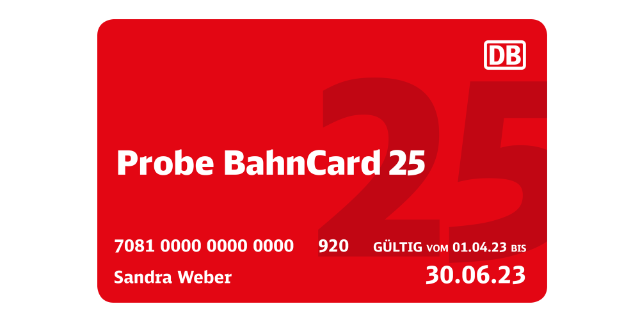
Save 25% for three months
Get the trial BahnCard 25 for three months in a subscription for EUR 17.90 and save 25% on your rail travel.
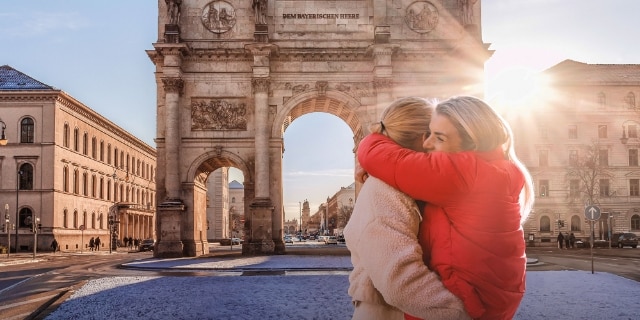
Travel flexibly with the flexible fare ticket
Relax and enjoy the journey, with no train-specific travel and the ability to make a stopover or travel at a different time.

Interrail: A flat rate for travelling Europe
Discover Europe by train: 33 countries , 1 ticket , 40,000 European destinations to choose from.
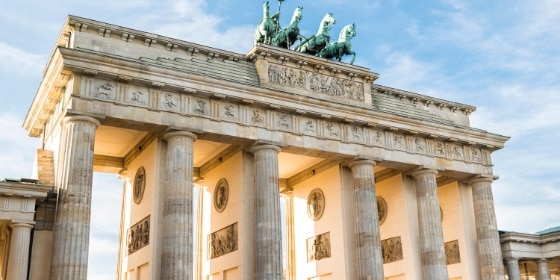
Brandenburg-Berlin-Ticket
Experience the culture and nightlife of the capital city Berlin ! Discover at the same time the nature and charming towns in the surrounding Brandenburg region .

Eurail Pass
- Discover all of Europe
- Valid in over 33 countries
- Valid for those who are NOT residents of Europe/Turkey/Russia

Seat reservation
Reserve your seat online for a relaxed and convenient trip. Enjoy the journey.
Tickets & offers
- Saver and flexible fares
- Regional offers
- Travel pass offers
- Night trains
Booking information
- Exchanges and cancellation
- Passenger rights
- DB Navigator app
- Payment options
Our train fleet
- Long-distance trains such as ICE, IC and EC
- Regional and S-Bahn trains
- Wifi on trains
- Travelling in first class

UEFA EURO 2024™
51 games in 10 cities: Environmentally friendly travel to the games by train.
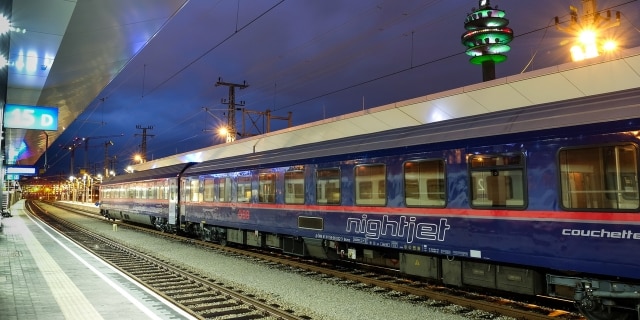
Overnight travel
Enjoy stress-free boarding in the evening and arrive at your destination after a good night’s sleep. Travel to over 25 major European cities like Vienna or Paris.

How to Take the Train in Germany: A Step by Step Guide!
Last Updated: March 21, 2024
*FYI - this post may contain affiliate links, which means we earn a commission at no extra cost to you if you purchase from them. Also, as an Amazon Associate I earn from qualifying purchases. Check out our Privacy Policy and Disclosure. for more info.
When it comes to the German rail system, I think one thing you could definitely say is… I have a LOT of feelings about it.
Train travel in Germany is a truly funny and misunderstood thing, shrouded in a romantic cloud of efficiency, speed and scenic bliss.
But while German trains are leaps and bounds better than train travel in many countries, it is far from the flawless and simple utopia many of us imagine in our heads.
From awkward seat shuffling and breathless running to impatient inspectors and stunningly muffled announcement quality, German train travel is a piece of work that, like a marriage, requires years of learning, understanding and patience.
Don’t worry though – I’ve endured the marital strife so you don’t have to. I lived in Germany for over five years, exploring the country (mostly) by train, and today I’m going to walk you through the process, from start to finish.
I hope you find it helpful!

Save this guide on how to travel Germany by train for later!
You’ll be very glad you did.
A Brief Introduction to the German Rail System
Let’s start with some basics on taking the train in Germany, which involves the largest rail network in Europe and over 33,000km of track!
Rail Providers in Germany
Operating over 40,000 trains a day, Deutsche Bahn is the national rail provider in Germany responsible for the vast majority of trains in the country.
When it works, it works great. However, when there are delays, travelling with them can be a bit of a nightmare, which is why the brand has become the butt of countless jokes regarding delays and high prices.
But bear in mind these jokes are often made by Germans who don’t realize how bad train systems can be in other countries.
Honestly, compared to many countries like Canada where I’m from, the German train system is fantastic, and still my go-to mode of transport around Germany.
It’s far from flawless but it’s still pretty great, especially when boarding at hubs like my former home of Munich, since there’s far fewer delays at the start of a journey!
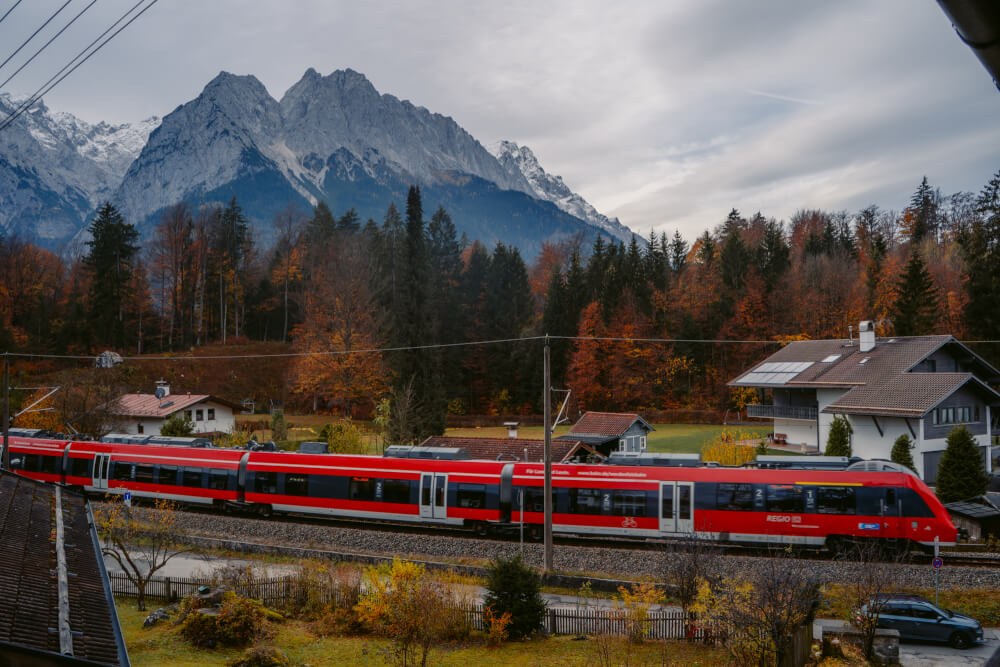
Another train operator you can consider in Germany is FlixTrain.
I’ve personally never taken them because in the time I lived in Germany, they were operating really limited routes and I still haven’t had a chance to try them. That said, their value proposition is super cheap fares starting at only 4.99 euro so definitely worth looking into if budget is a priority.
Flixtrain is fairly no frills – they only have one standard class and the buying process is straightforward so the rest of this post will focus on Deutsche Bahn trains and tickets.
NOTE: If you do book with Flixtrain though, be sure to double check that you are in fact booking a train, because this company also owns Flixbus, one of the biggest bus companies in Europe, and they’ll often show you buses alongside trains.
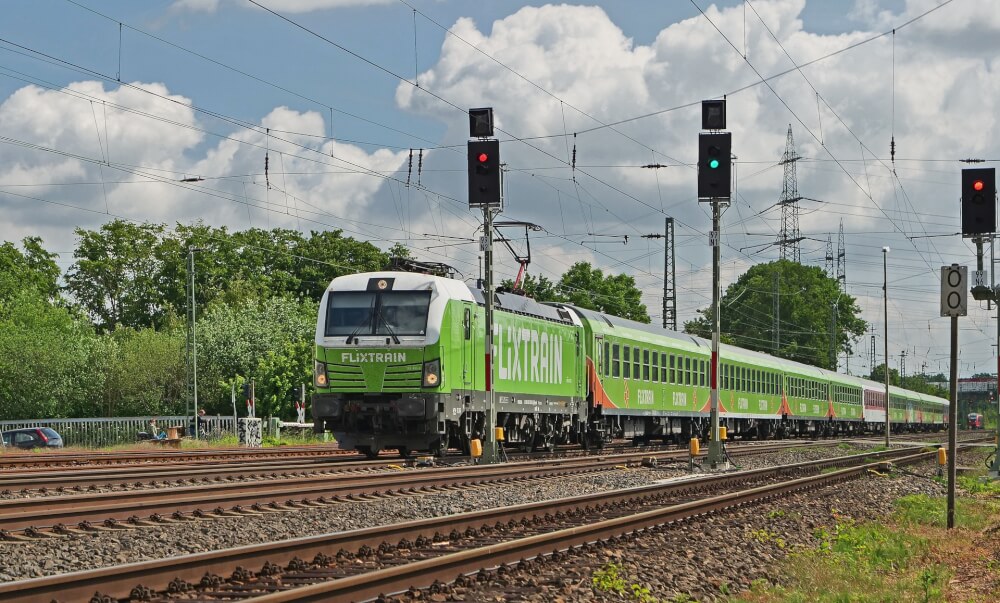
Now, let’s discuss…
Types of Trains
Broadly speaking, we can divide German trains into two three categories: long distance, regional, and local, such as S-Bahn or U-Bahn trains.
Understanding the difference between these is important, as they make a huge difference in journey time and cost, so I’m going to run through the most common ones, along with their abbreviations that typically show up in the train numbers and booking portals.
Long distance trains in Germany are used to connect larger cities and are therefore usually quicker, but typically require booking in advance, with reservations being a good idea in busy periods.
Under the German long distance train umbrella, we have…
- ICE: InterCityExpress trains, which are the fancy, high speed trains that get you between major cities, and can go up to 300km an hour. Especially quick are the ICE Sprinter trains which make even fewer stops than normal.
- IC: Intercity trains, which also travel between cities in Germany but are sometimes a bit slower than the ICE ones (maxing out at about 200km an hour) and often not as new or nice.
- EC: Eurocity trains, which travel between cities in Germany and elsewhere in Europe. These can look different than usual Deutsche Bahn trains because depending on the route, they may be operated by another country’s rail provider.
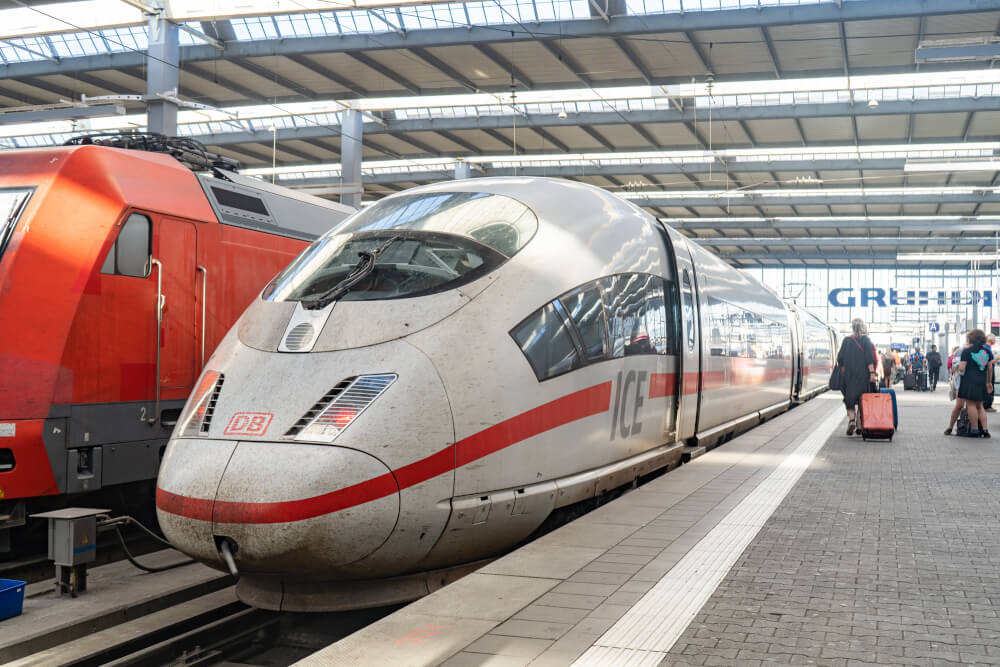
In contrast, regional trains cover shorter distances, typically within one state or region.
Reservations and assigned seats are not possible for these trains, their prices are fixed so buying in advance isn’t necessary, and they’re covered by a range of special deals which I’ll go over later.
Under this regional train umbrella, we have…
- IRE: Interregio-Express trains, which travel longer distances between regions but usually at much slower pace than the long-distance trains (and are therefore classified as a regional train as far as special deals are concerned)
- RE: Regional Express trains, which connect destinations in one region, but don’t stop at every stop on the route which can be faster than the…
- RB: Regional Bahn trains, which connect destinations in one region and do stop at every stop along a particular route
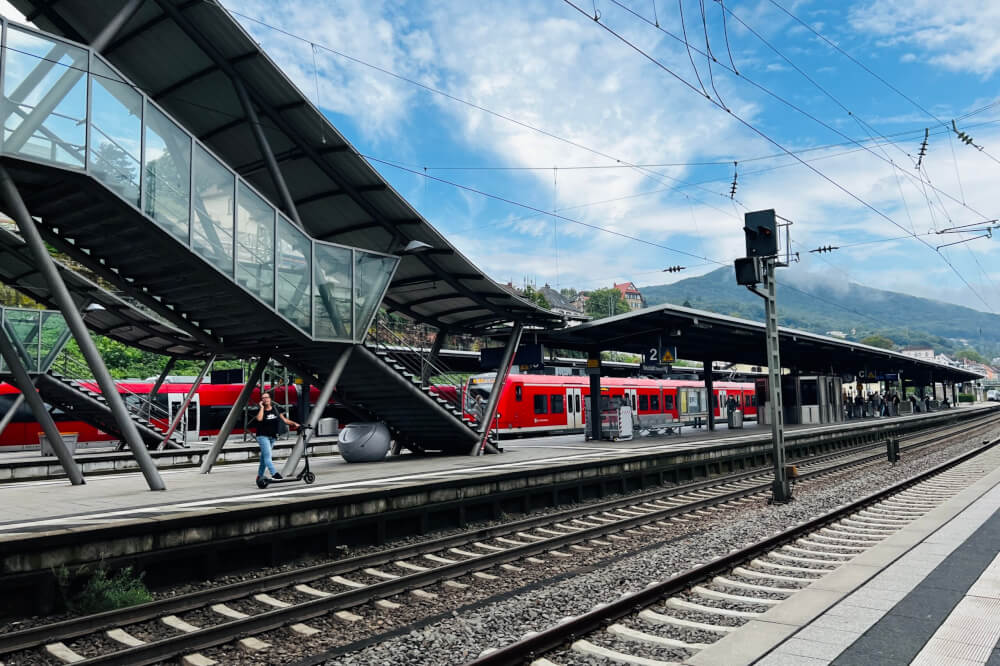
Lastly, on the local train front, we have options like…
- S-Bahn, which are trains that connect stops within cities and out to nearby suburbs, as well as…
- U-Bahn (in some cities) which are underground trains that connect stops within the city itself like the Subway or Metro
These are also typically covered by the special deals we’ll be discussing below.
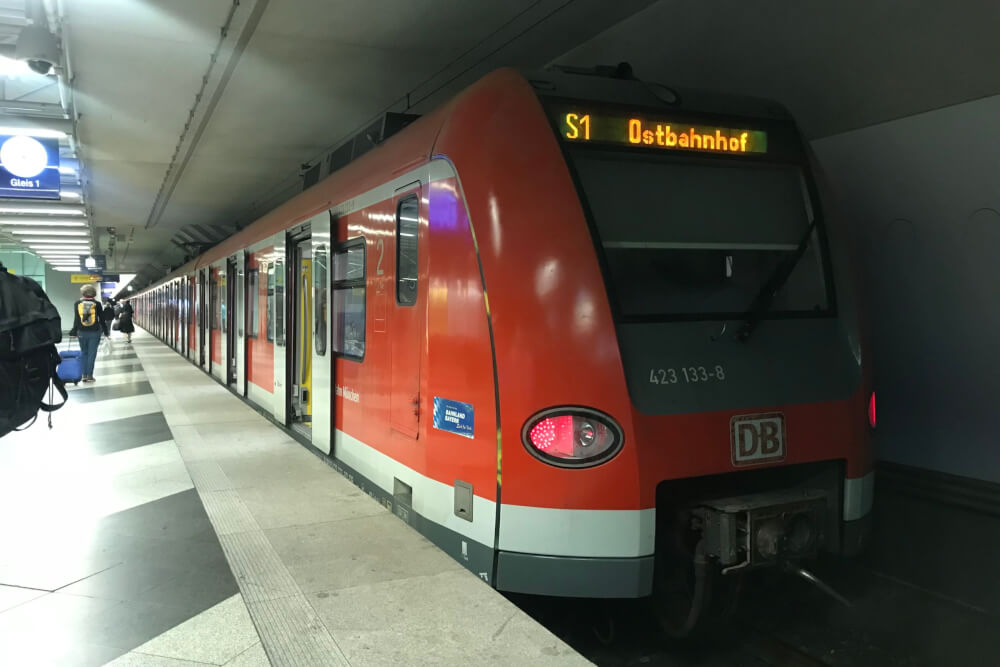
Now, with the basics covered, let’s go through step by step how to plan a train trip in Germany.
Step One: Decide if Train Travel in Germany is Right for You
First – let’s talk alternatives to train travel in Germany.
I’m a huge fan of German train travel, but there are other options for getting around that may be better suited to your specific trip and priorities.
Overall, I think taking the train in Germany is great if you’re looking for convenience, comfort and scenery.
The downside is however it can be quite expensive, especially if you don’t book in advance. It’s also not super convenient if you’re travelling with a lot of luggage (more than one big suitcase per person).
A more budget-friendly alternative may be taking buses, booking a ride share on services like BlaBlaCar or sometimes even flights if you’re booking with budget airlines like Ryanair , easyJet and Wizz Air .
Or, if your priority is freedom and getting off the beaten path, it may be worthwhile to rent a car.
Overall, if you’re torn and want to compare all your options at a glance, Omio is a great app that shows you planes, trains, and buses from Point A to Point B. From there, you can gauge whether train travel suits your needs.
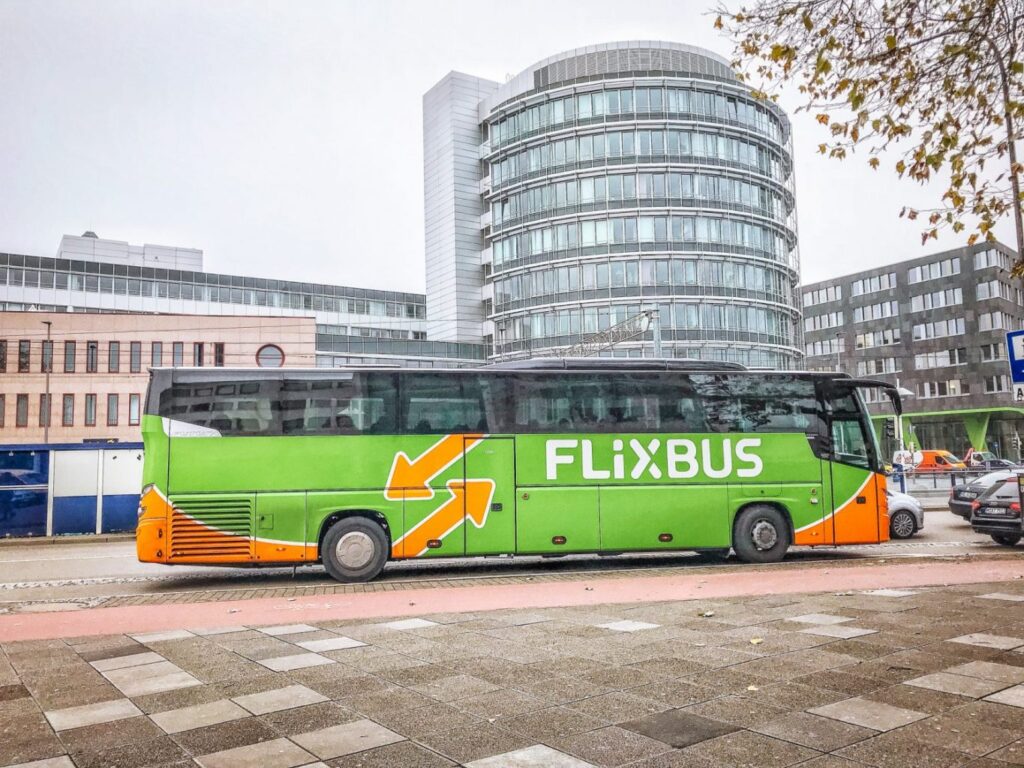
If/when you’ve decided you do indeed want to take the train, then we move onto…
Step Two: Buy Your Germany Train Tickets
The pricing of trains in Germany is dynamic, meaning the cost changes depending on when you buy it and what demand is like.
It is totally bananas to me that a ticket, when booked early, can be 20 euros but if you wait until the day before/day of it can go up to 180 euros.
But alas, I do not make the rules. If I did, everyone would get a free on-board puppy.
In any case, I’d advise booking tickets in advance online, because buying them on board isn’t usually possible, and buying in person from the information desk at the station does incur an extra service fee.
You can also buy tickets on machines at the station but I feel like this adds an extra element of stress, so be sure to book in advance whenever possible.
Now, there are a lot of considerations to be made when you go to buy train tickets in Germany. I’ll outline them all now.
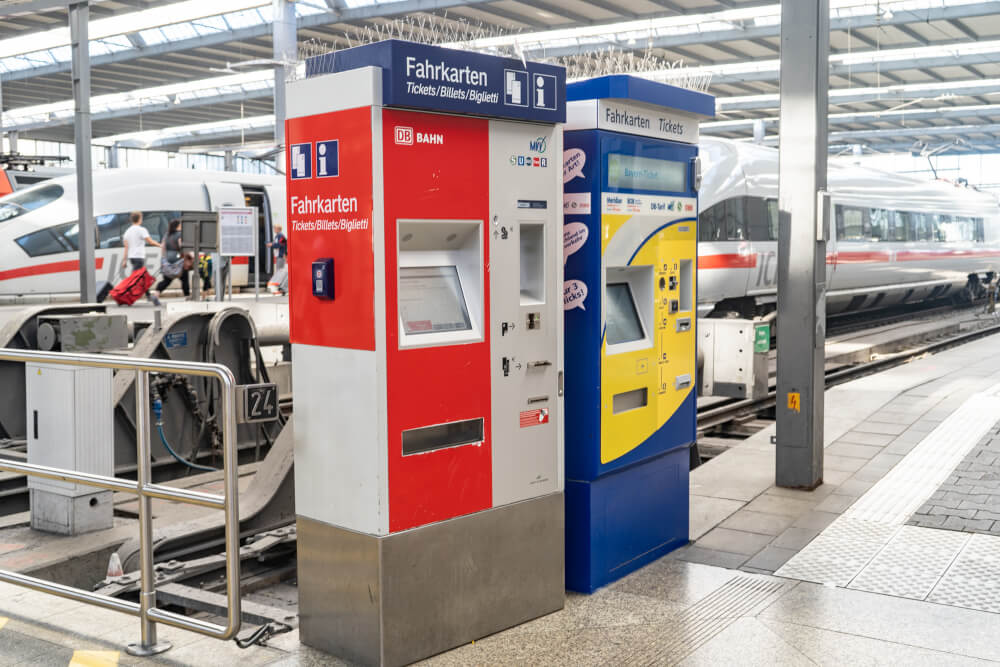
First off…
BahnCard vs No BahnCard
If you plan to stay a while and take a lot of trains in Germany, it may be worthwhile to purchase something known as a BahnCard.
These are cards that you purchase for a set fee that then give you discounts on most train journeys, either 25% or 50% depending on which one you buy.
While these cards are definitely more geared towards locals than tourists, sometimes the discounts can be so significant that you can make the cost up in just a few journeys, so it’s worth crunching the numbers.
Especially interesting for short term visitors are the Probe Bahncards, or Trial cards which allow you to buy a cheaper membership that’s essentially a trial for 3 months, rather than for a whole year.
These start at just 17.90 for the three months, an amount you can easily make up if you’re buying an expensive long-distance or last minute ticket. Just don’t forget to cancel your subscription 6 weeks before the expiry date, or it auto-converts to an annual one that of course costs more.
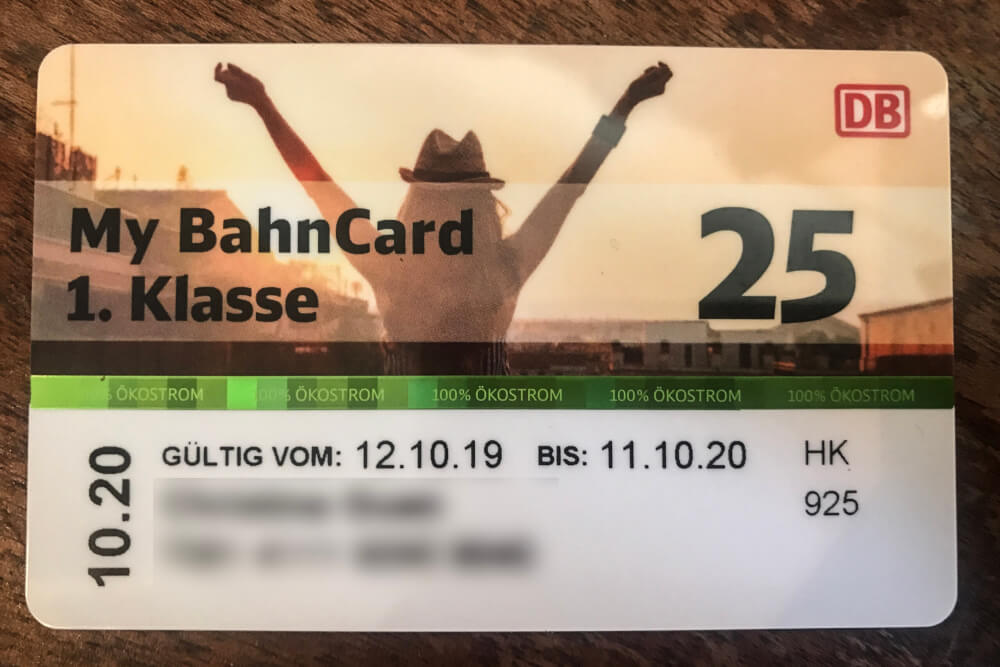
Honestly though, for most tourists visiting for a short time, there are better ways to save money on German train tickets.
So let’s move onto our next consideration which is…
Standard Tickets vs. Special Tickets or Rail Passes
If you are only booking a few train journeys during your time in Germany, the best option is most likely to just buy tickets for the journeys you’re taking, meaning hopping on the Deutsche Bahn app or website, entering Point A to Point B and buying tickets for each trip you plan to take.
Sometimes though this won’t be the way to get the best deal. So, I’m going to outline some options that may save you money depending on your circumstances.
First off – do know that there are age based discounts on Deutsche Bahn for the following groups:
- (FREE!) Children 6 & under
- (FREE with parents or grandparents) Children aged 6-14
- Youth (aged 15-26)
- Senior (age 65+)
So, to activate these discounts, be sure to specify your age and the age of those travelling with you when you go to search routes.
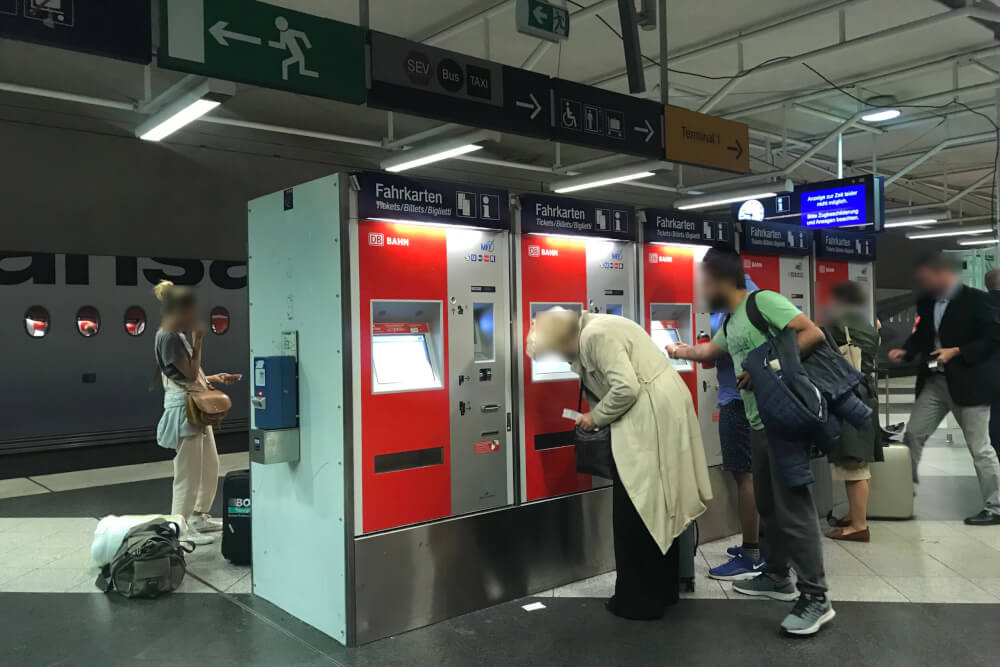
Now, if you are looking to save money on regional and local trains in Germany, there are few excellent options that are almost guaranteed to save you money, especially for day trips.
With one of these, you can genuinely save hundreds of euros over buying individual tickets the day-of.
If your travels are restricted to one German state, then look into buying a regional day ticket (known in German as Länder-Tickets ). These give you unlimited travel on regional trains for one day, with options up to five adults on one ticket.
The savings with these are also better the more people you bring, with a base fee, then a small additional fee for every extra person, so definitely worth considering if you’re travelling in a group.
Here are the different regional tickets you can buy:
- Baden-Württemberg-Ticket
- Bayern-Ticket
- Brandenburg-Berlin-Ticket
- Hessen-Ticket
- Mecklenburg-Vorpommern-Ticket
- Niedersachsen-Ticket
- Rheinland-Pfalz-Ticket
- Saarland-Ticket
- Sachsen-Anhalt-Ticket
- Schleswig-Holstein-Ticket
- SchönerTagTicket NRW
- Thüringen-Ticket
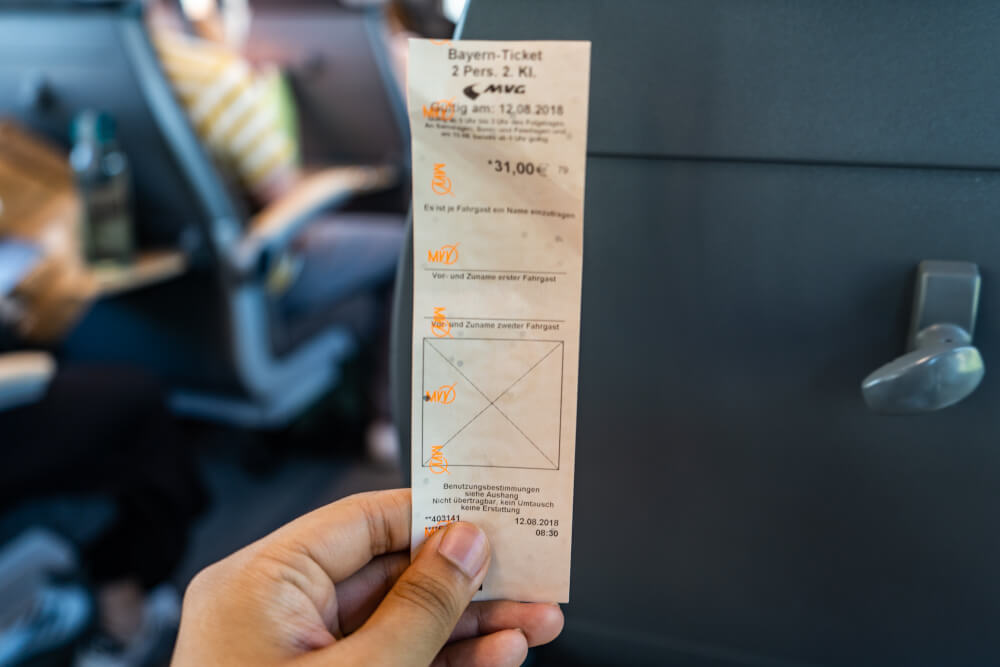
They also have a Germany-wide version of this ticket if you plan to travel across states, known as the Quer-durchs-Land-Ticket.
BUT, an even better deal if you plan to use regional trains exclusively across Germany is a relatively new offering known as the Deutschland ticket.
This golden ticket is only 49 euro a month and gets you unlimited travel on regional trains for that whole month. Considering a one-day Quer-durchs-Land Ticket is already 44 euro, getting the Deutschland Ticket is pretty much a no-brainer if you’ll be taking regional trains for more than one day.
BUT the catch is, this ticket is more geared towards locals, and therefore is offered on a subscription basis. So long as you cancel your subscription in time though, then you can easily just use it for one month or as you need.
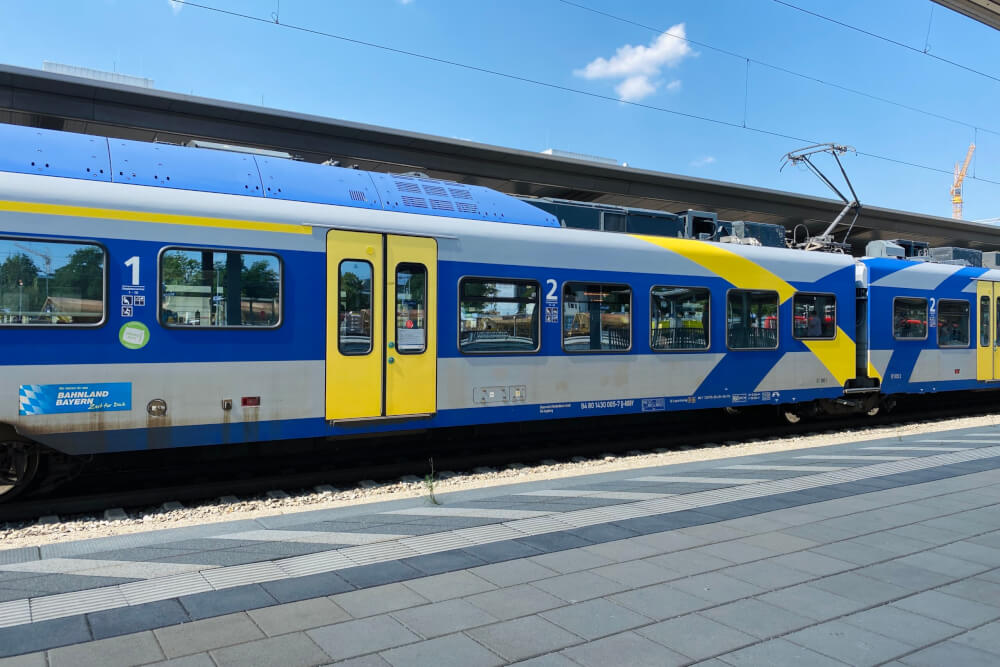
Unfortunately, saving money on long distance trains is less simple. Generally, your best bet is just booking early. The earlier you book, the cheaper it’ll be.
If you can’t book in advance though, a potential cost saver could be a rail pass.
If you are just travelling within Germany, there is a German rail pass you can buy for unlimited journeys either on a flex basis, meaning for a few days within a set period or on a consecutive basis, meaning a set number of days in a row.
If you are travelling to other countries in Europe, it may be worth getting a Eurail pass , also known as an Interrail Pass when you’re a resident of Europe.
Used properly, these passes can save you a lot of money, but only in certain situations so for more information on that, be sure to read my full Eurail review.
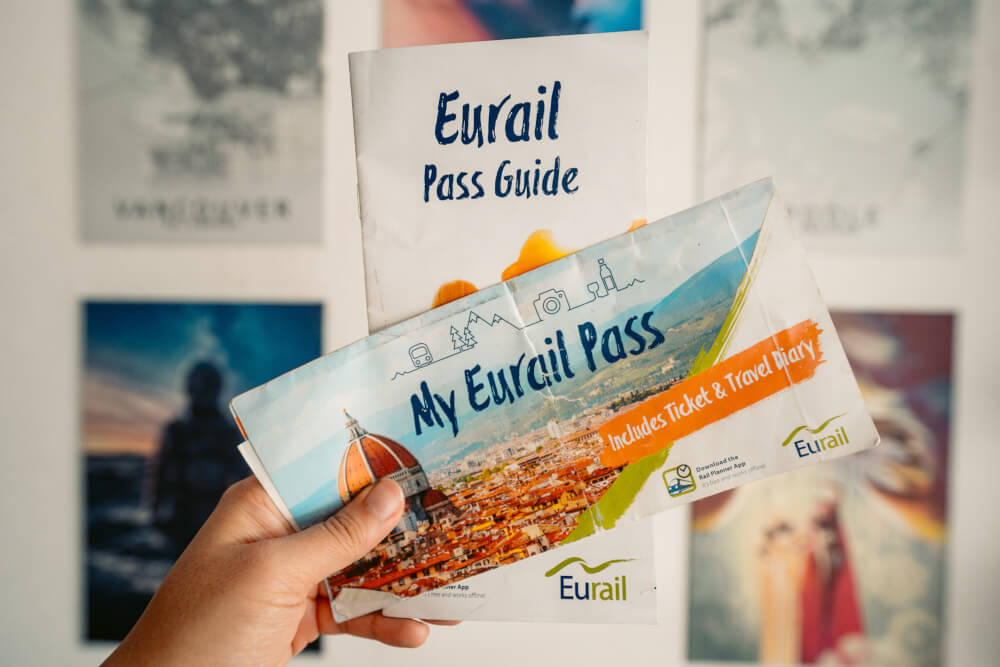
Now, when you go to buy tickets, you can either do so in person or online.
Online, you can either buy tickets directly through Deutsche Bahn (website or DB Navigator app) or through a third party website.
Booking direct with Deutsche Bahn will pretty much always be the cheapest option, but if you’re planning a big trip with lots of trains or buses in other countries, then a 3rd party like Omio or Trainline might be worth it just to keep all your tickets in one place.
NOTE: When choosing your journey, always prioritize direct connections or routes that make fewer stops. These will usually cost more, but trust me, it’s worth every penny! Transfers are simple enough when trains run on time, but as soon as you’re hit with a delay, that can disrupt your entire journey and make things 100x more stressful.
Whether you buy from Deutsche Bahn or from a third party though, there are several considerations to make, so I’ll run through them now.
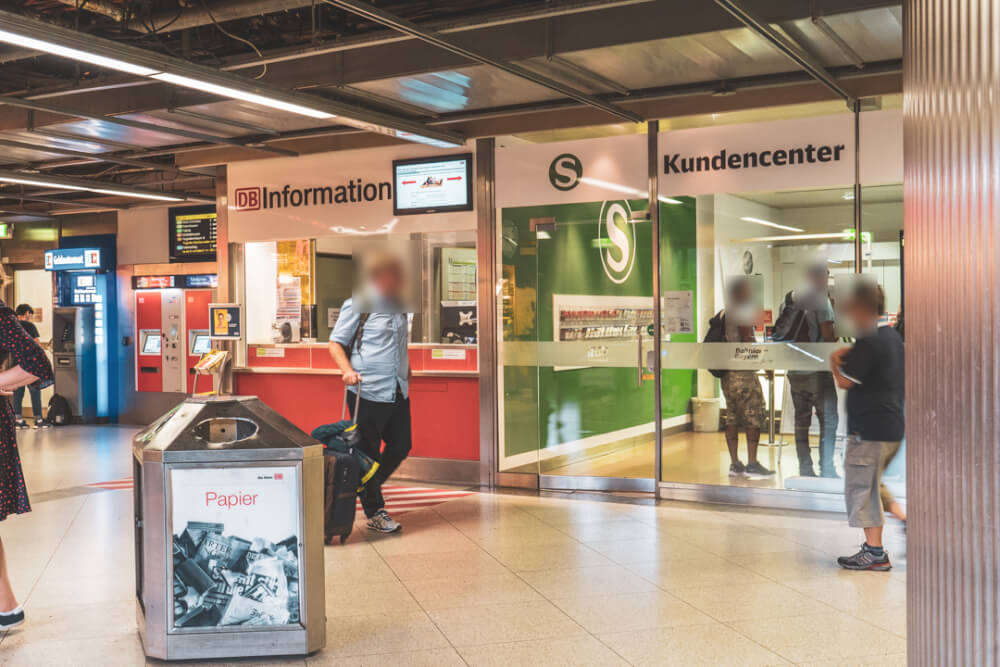
1st vs 2nd class on German Trains
The first time I got to sit on a 1st class German train, I had extremely high expectations.
Part of my brain flashed to a sepia-toned flashback of glamour train travel in the 60s, with fizzy champagne flowing and a steak dinner served right to my seat. I knew this wasn’t going to happen, so I dialled it down. I once took a first class train in Italy and they gave us coffee and snacks. I therefore looked forward to said coffee and snack.
German trains? You get pretty much nothing. So no, the difference isn’t stark, but there are some instances where I think splurging on first class is worth it.
On regional trains, there isn’t a dramatic difference between first and second class seats.
The main perk is it’s generally quieter and sometimes the seats are slightly comfier. So, I would go for first class in regional trains if a) the price difference isn’t much/doesn’t matter, b) you want extra privacy or c) it’s a busy time and you want to secure your chances at having a seat (and space for your stuff).

On long distance trains however, there’s definitely a bigger difference between first and second class, especially on ICE trains.
In first class, the seats are more comfortable, a reservation is included, you can get food/drinks ordered to your seat, and for introverts like me, there are even single seats you can reserve so you don’t have to sit next to anyone.
If any of these perks sound appealing to you, then I’d say it’s worth the extra cost (which is sometimes minimal if you book early enough).
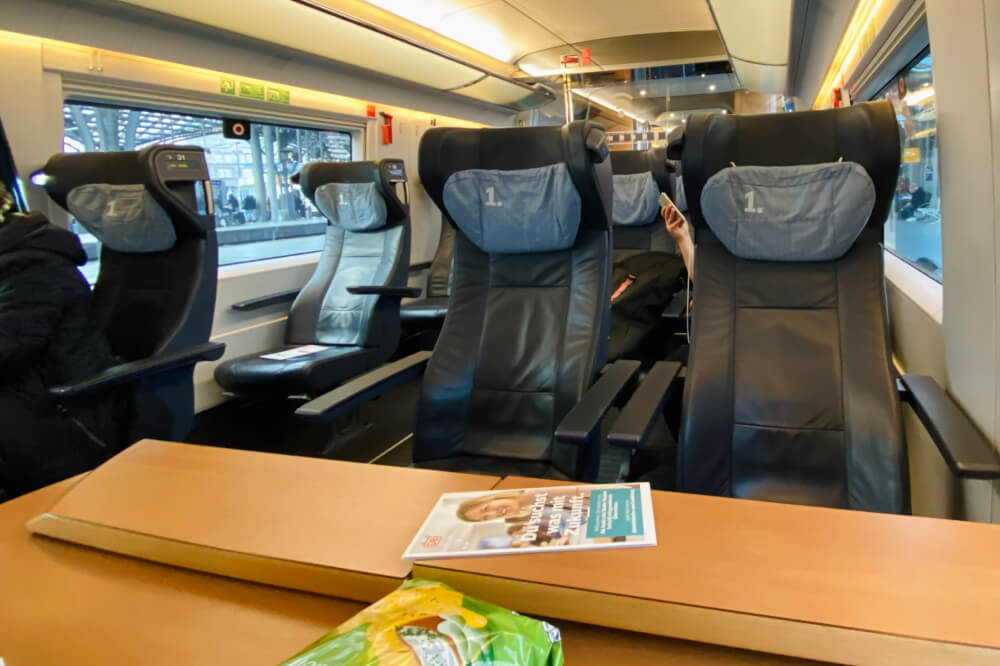
The next consideration is…
Reserved vs. Unreserved seats
Reservations are pretty much never mandatory on German long distance trains, and aren’t even possible on regional trains, S-Bahn or U-Bahn.
That said, I would highly advise making a reservation if you’re at all an anxious traveller, or if you’ll be travelling during a busy period.
The cost is only about 5 euro and having that peace of mind for me is more than worth it.
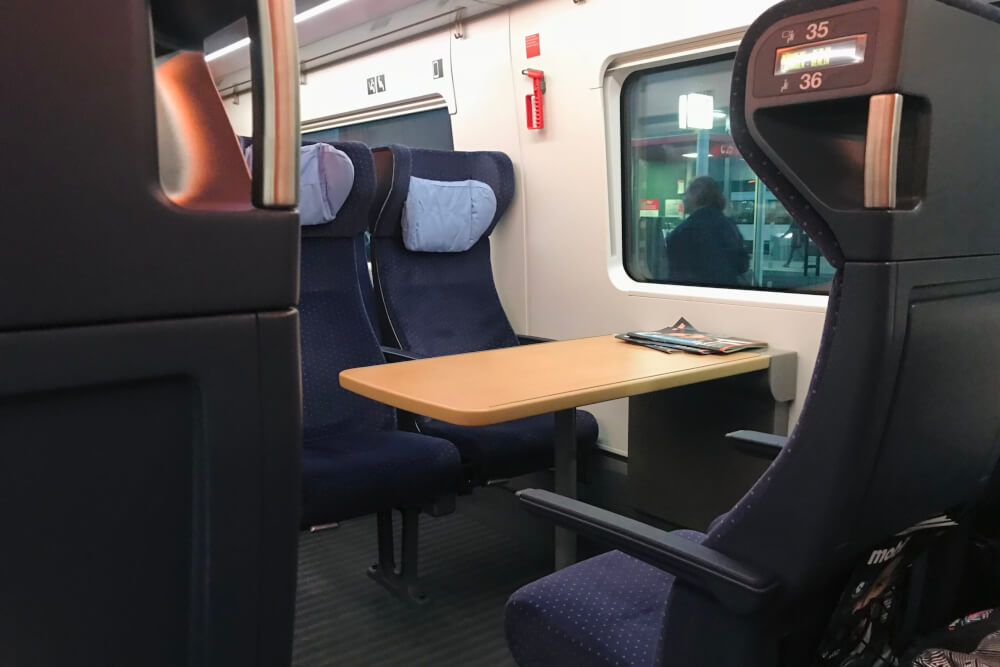
If you do end up reserving a seat, another consideration is…
Carriage and Seat Types
Some trains in Germany have different carriages intended for different purposes, such as…
- Silent/quiet carriages
- Cellphone carriages (where you can freely make calls)
- Family areas
- Bike zones (with additional space)
- Accessible zones
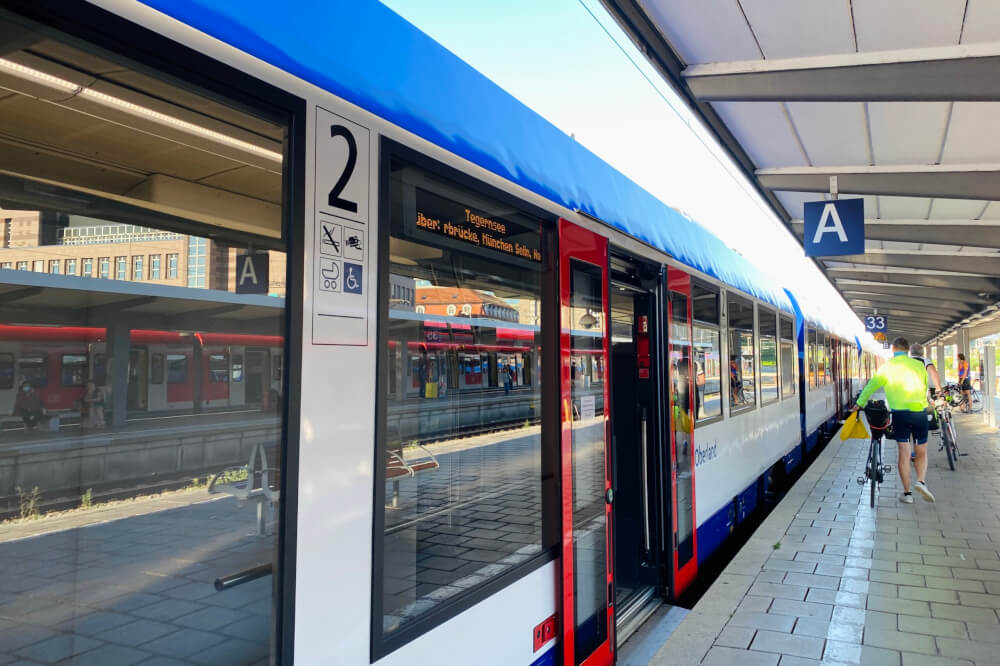
There are also different seating configurations for many long distance trains, with the two main choices being:
- Open saloon seating, which is your standard train set-up with seats in a carriage, sometimes with a table around which 4 people can sit facing each other OR
- Compartment seating, which are more old school closed compartments with seats facing each other. These are fun if you get them to yourself, or with your own group but can be a bit intimate if you’re sharing with strangers
You’re usually given an interactive map when you book a reservation, so you can also make other considerations like window vs aisle or how close you are to amenities like the bathroom, luggage racks or the on board restaurant.
Be sure to take some time to consider which seat you might want to reserve – not all seats are made equal!! With seats at the end of cars for instance, people will be coming in and out constantly to go to the bathroom, which isn’t ideal if you’re looking for a peaceful journey.
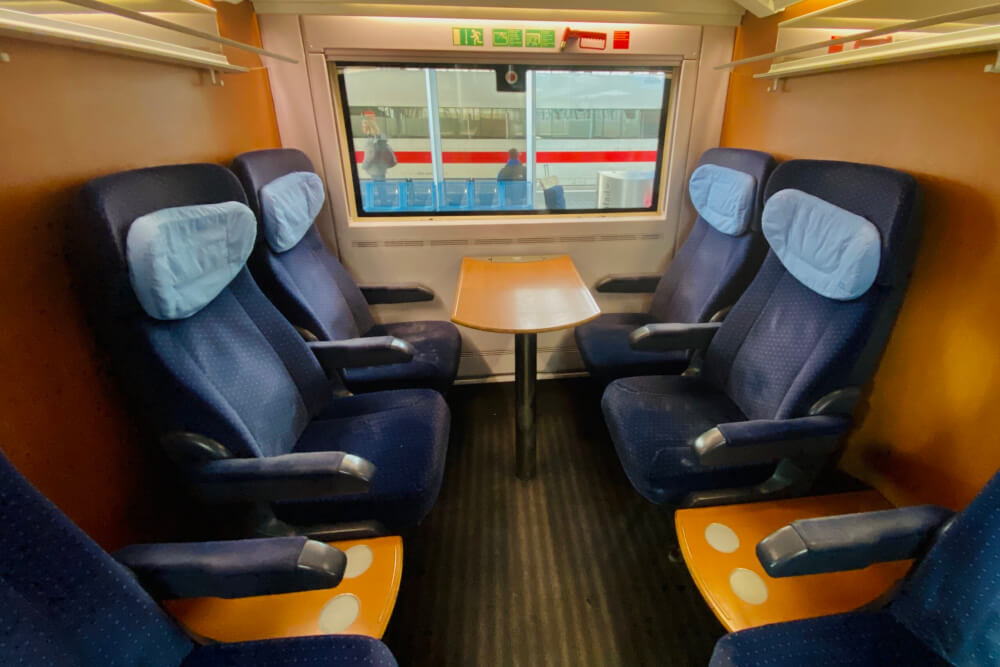
Another choice you’re given when buying tickets is…
Flexpreis vs Sparpreis
Essentially these are different versions of the same ticket, and make no impact on the destination/route, but do impact how flexible the terms of your ticket are.
The Sparpreis is essentially a ticket that is only valid for that one train and time you’re booking. In exchange for this lack of flexibility, the fare is much cheaper, especially with the Super Sparpreis (which is most limited in flexibility).
In contrast, the Flexpreis ticket gives you a lot more flexibility, usually allowing you to travel on any train that day for your chosen route, or with the Flexpreis Plus, even trains the day before or two days after.
Overall, I feel like the price difference is rarely justified for these Flexpreis tickets (sometimes it’s more than 5x!), but do what’s right for your own trip and priorities.

Lastly, there’s…
Bike/Pet Add-Ons
If you are travelling on German trains with a bike or with a pet, know that you’ll typically need to buy an additional ticket for them.
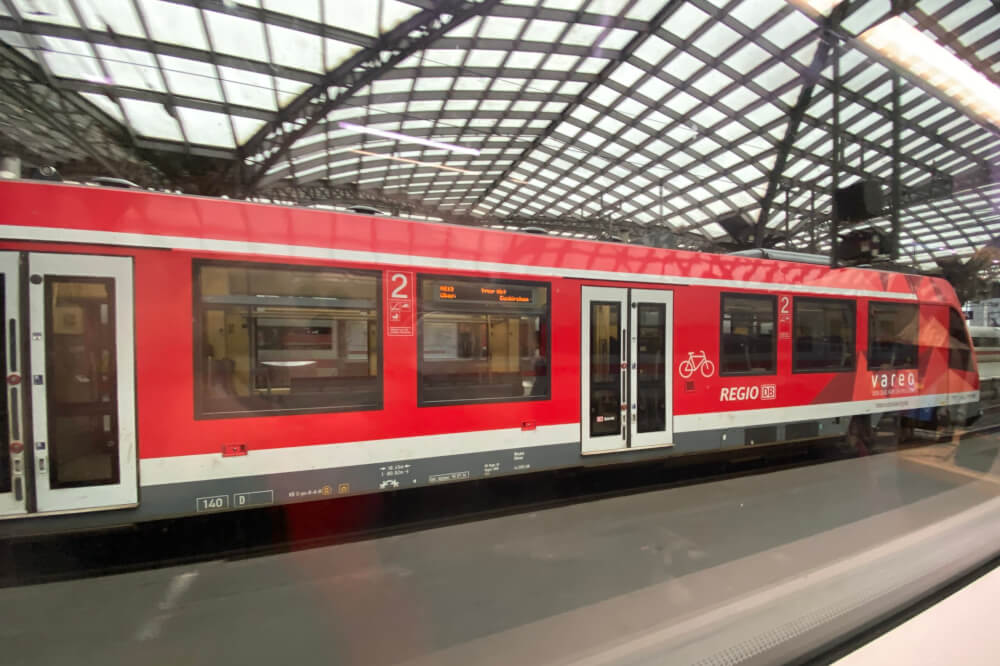
Alright with your tickets booked it’s time to move onto the day of your journey, with…
Step Three: Get Snacks
On the day of your journey, I highly recommend you get some food and drink to bring with you on the train (especially for longer trips). This is completely allowed on German trains!
While there are usually some food options on board with long distance trains, they tend to be fairly limited and pricey, so getting your own gives you more control. On regional/local trains, there is no food or drink sold on board at all.
So, at the very least, I’d get some water or something to drink. There’s often great options even at the train station itself.

Now let’s move onto…
Step Four: Arrive at the Station
First off, before leaving, double check that you are headed to the right station. Many major cities will have multiple stations like Munich, which has its Hauptbahnhof (Main Station) as well as Ostbahnhof (East Station) and other smaller ones.
If it’s your first time at this station, and if you’re in a big city, I recommend you arrive thirty minutes or more in advance of your departure time, because main stations in cities like Berlin, Munich & Hamburg can be very overwhelming, with multiple levels, shops and 20+ platforms.

Now, if you are taking public transport and arriving at the train station in a big city, you might find it tough to find where the trains actually are, because often these stations are multi level transport hubs servicing U-Bahn, trams and buses as well.
In any case, all you need to do is look for train symbols on signs like this which will point you in the direction of the platforms:
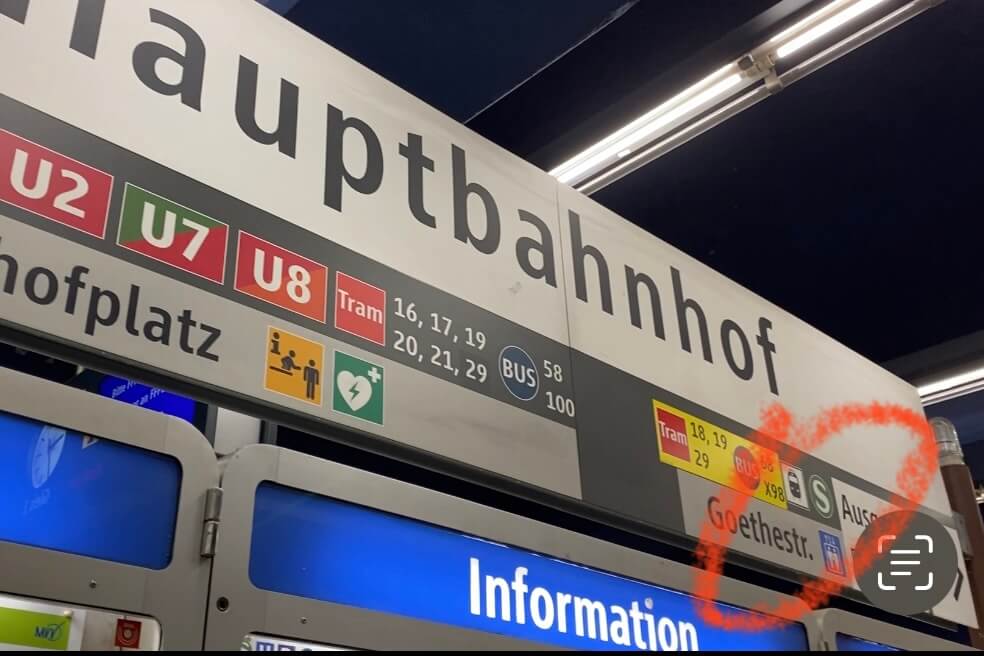
Now when you get to the station’s main concourse, your priority is finding out which platform your train is on. The Deutsche Bahn app will usually tell you in advance but I like to double check on the board just in case.
When looking at the board, remember that trains will not necessarily say your destination, but rather the final destination of the train, so if you don’t see the name of where YOU’RE travelling to, don’t panic.
Look for the time and train number, and (when available) the list of stops to see if your destination is listed, then figure it out from there. Beware that some cities like Munich and Cologne have a different name in German (München & Köln) and that’s likely the name that will show.
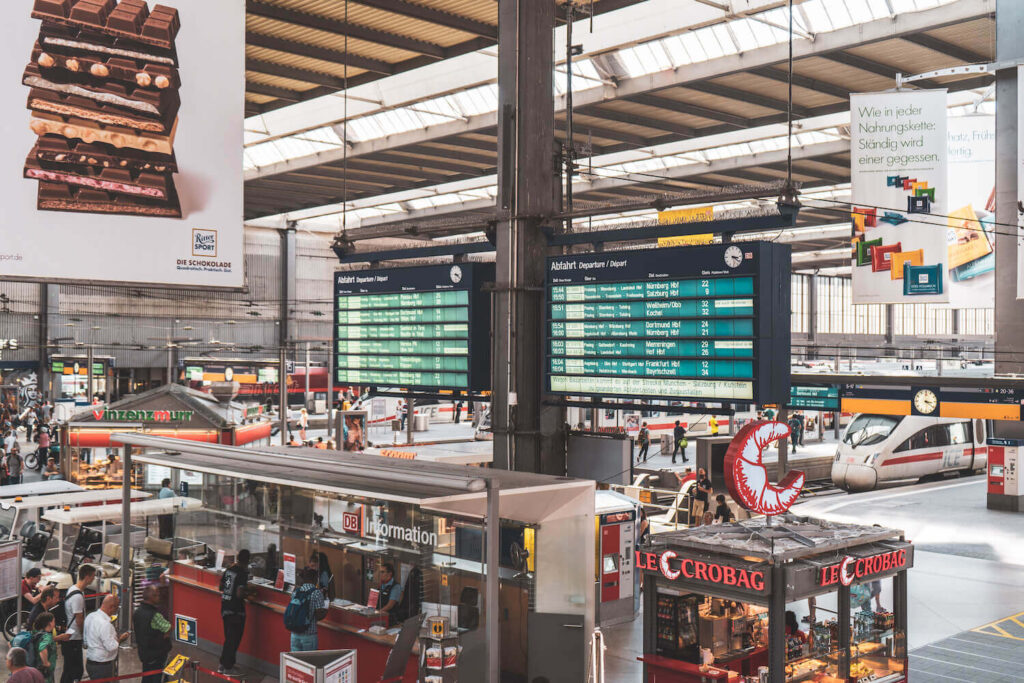
Next, it’s time to…
Step Five: Get to the Platform
Platform numbers will generally be very well marked so just look up for signs before making your way.
You will not need to have your ticket for this part, because there are no fare gates for German trains, and tickets are usually just checked on the train itself.
When you get onto your platform, double check it’s correct by confirming either on a platform screen or on the side of the train that you’re in the right place before proceeding to find your carriage.
NOTE: Some regional trains in Germany are divided trains that split at one point in the journey, which means only certain cars end up going to certain destinations. So, before you board, double check that the destination on your train carriage is actually where you want to go. In cases where the train splits, the sign will usually tell you which cars or which part of the platform to go to for your destination, so keep an eye out for that.
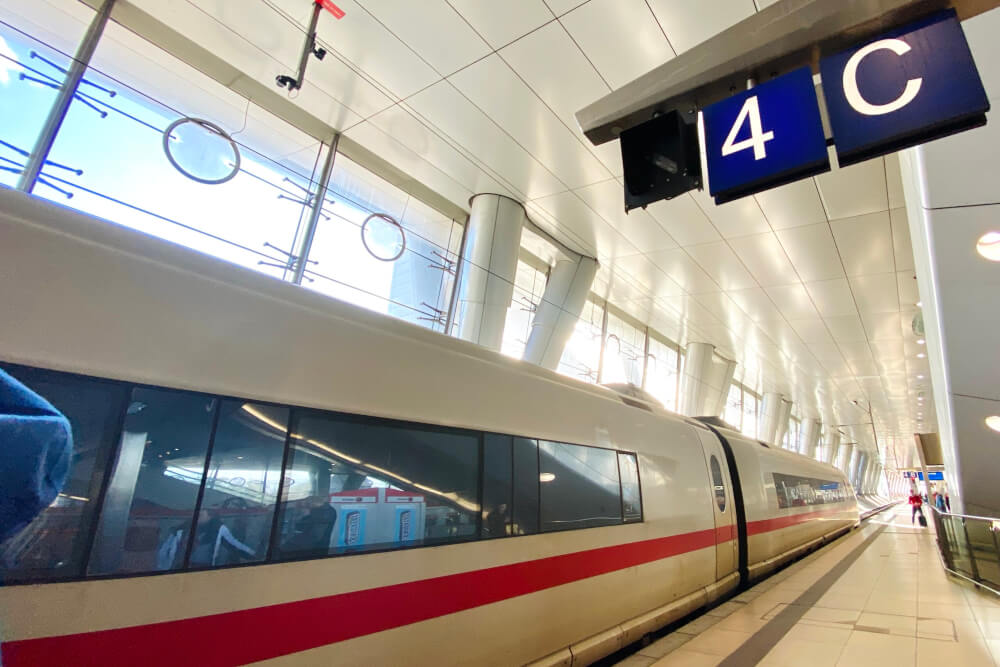
Next up, it’s time to…
Step Six: Find Your Carriage
If you have a reserved seat, then you’ll need to take some extra steps to make sure you get to the correct carriage once the train arrives.
German trains can be very long, so if you have a seat reservation, make sure you’re standing in the right part of the platform to get onto your carriage, otherwise you’ll have to awkwardly dodge and shuffle your way all throughout the length of the train.
With reserved seats, a handy thing to look out for are these charts that show you which part of the platform to stand on (marked by number/letter) depending on your carriage number.

If you do not have an assigned seat, then you simply need to board a carriage in the right class, then pick a free seat.
In these cases, look up at the platform sign and there should be a little diagram that explains which letter part of the platform to stand on for 1st class, 2nd class, and the meal car (depicted by a tiny knife and fork).
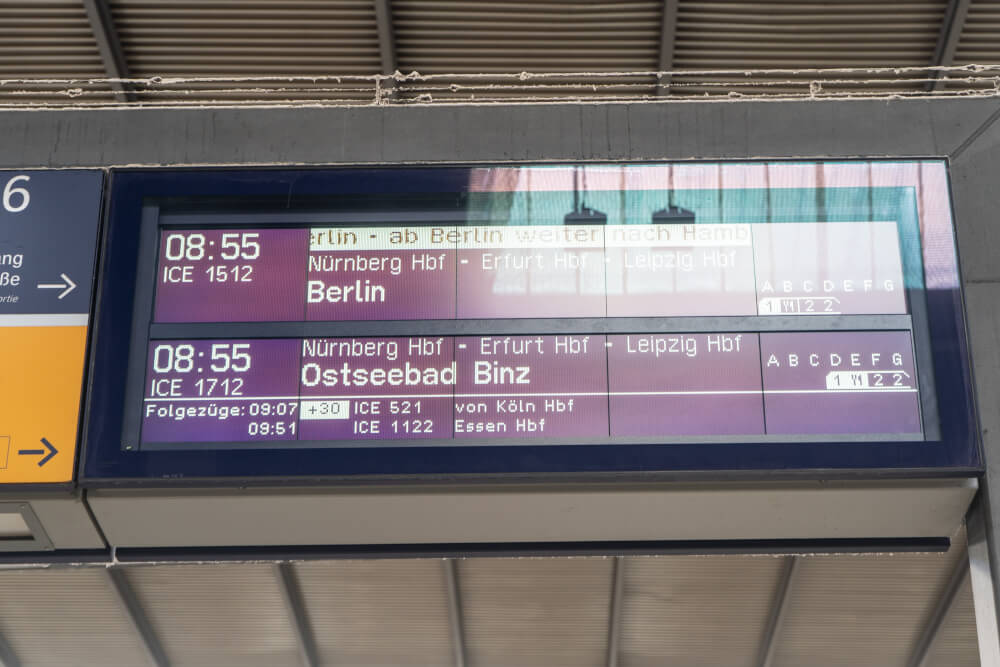
When picking a carriage to board, pay special attention to…
- The class number of the carriage (you may only board the class you’ve booked for)
- Whether they are special carriages meant for a certain purpose e.g quiet zone, bicycle zone
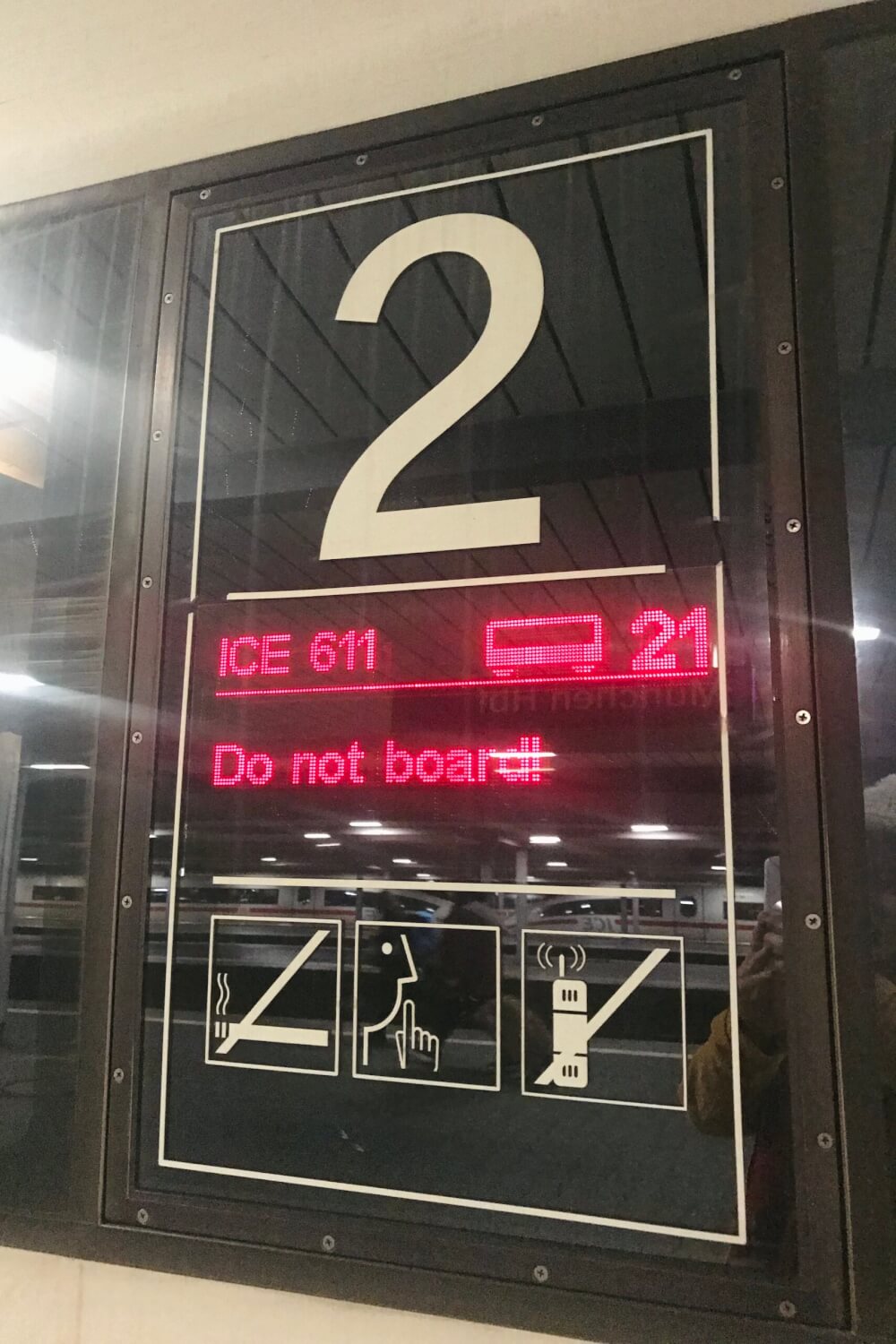
If you don’t have a reserved seat, then usually I find the farther you walk, the emptier the carriages will be.
Once you find or choose your carriage, then it’s time to hop on board.
If the door isn’t opening then look for a button like this <> and press it. This goes for the train doors as well as carriage doors.
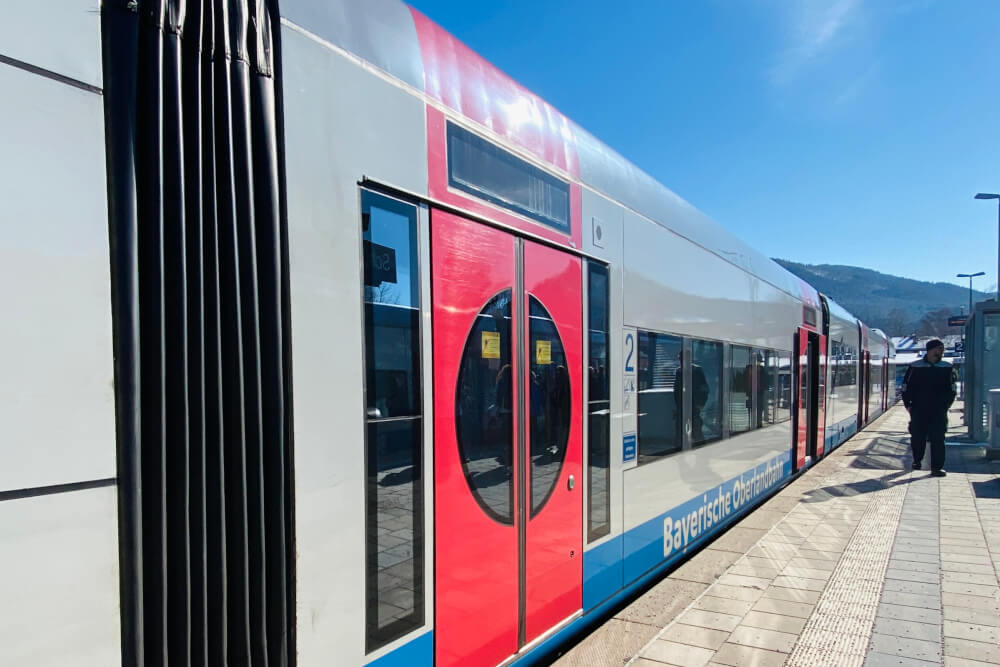
Now it’s time for…
Step Seven: Find Your Seat
First off, if your seat is assigned, try to make sure you go in through the correct door closest to your seat.
Long distance trains will usually write the seat numbers on the corresponding door, like so:
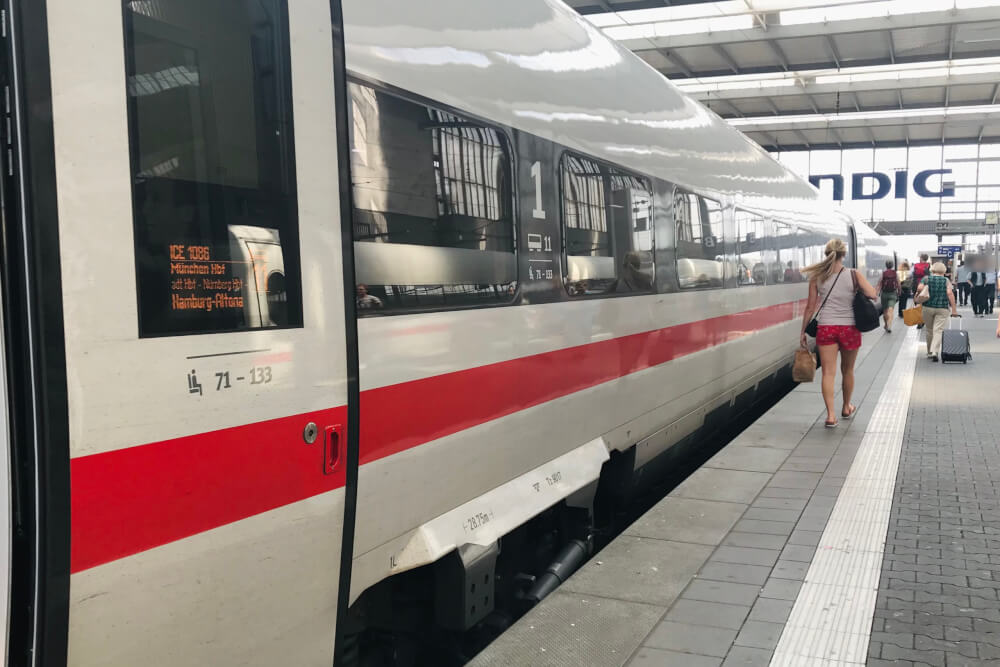
If you have large bags, keep an eye out for large luggage racks when you enter. These will usually be found on the ends of the carriages.
With smaller bags/suitcases, there is usually space above your seat for it, or sometimes under and between seats, as marked.
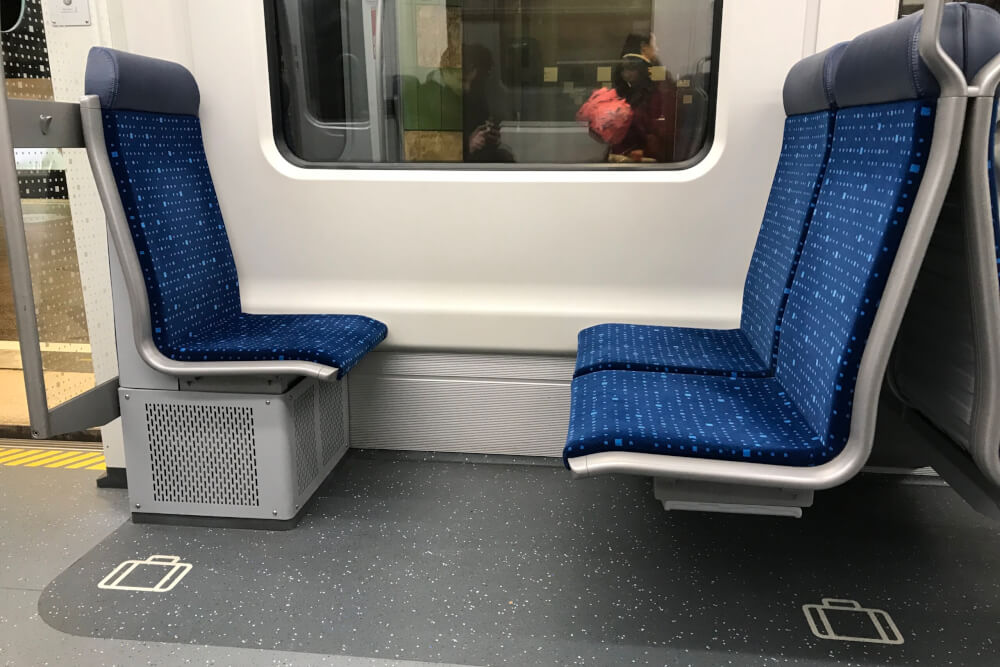
If you don’t have a reservation, before sitting down, make sure your seat isn’t reserved and make sure you’re not taking up a priority space if the train is looking full.
Seats that are reserved on long-distance trains will usually be marked on an electronic screen that shows you which part of the journey the seat is reserved for.
So let’s imagine you’re going from Munich to Berlin. The screen may show the seat is reserved for the whole journey, or for just a portion. If your journey doesn’t overlap with the reservation, then that sat is technically free.
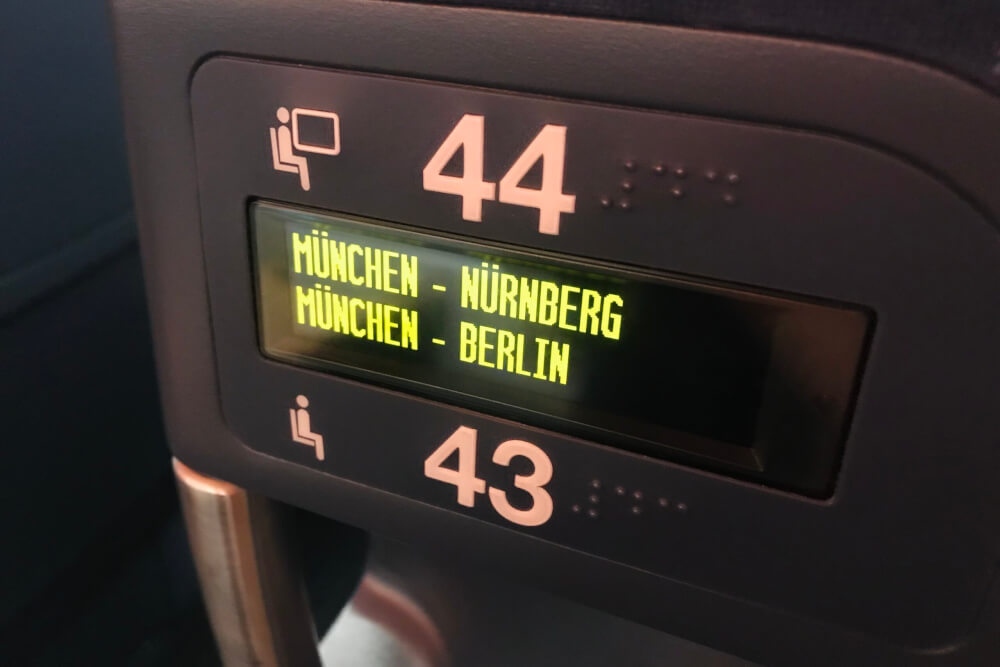
But do note however that the screen may sometimes say something else like..
- ggf. reserviert (possibly reserved)
- ggf. freigeben (possibly to release)
Both of these annoyingly mean that the seat might be reserved, or it might not, but either way you have to vacate it if the person with a reservation comes, so you kind of just have to sit there and hope for the best.
It is honestly the silliest system. To avoid this Russian Roulette of seating charts, be sure to just reserve yourself a seat. It’s worth it.
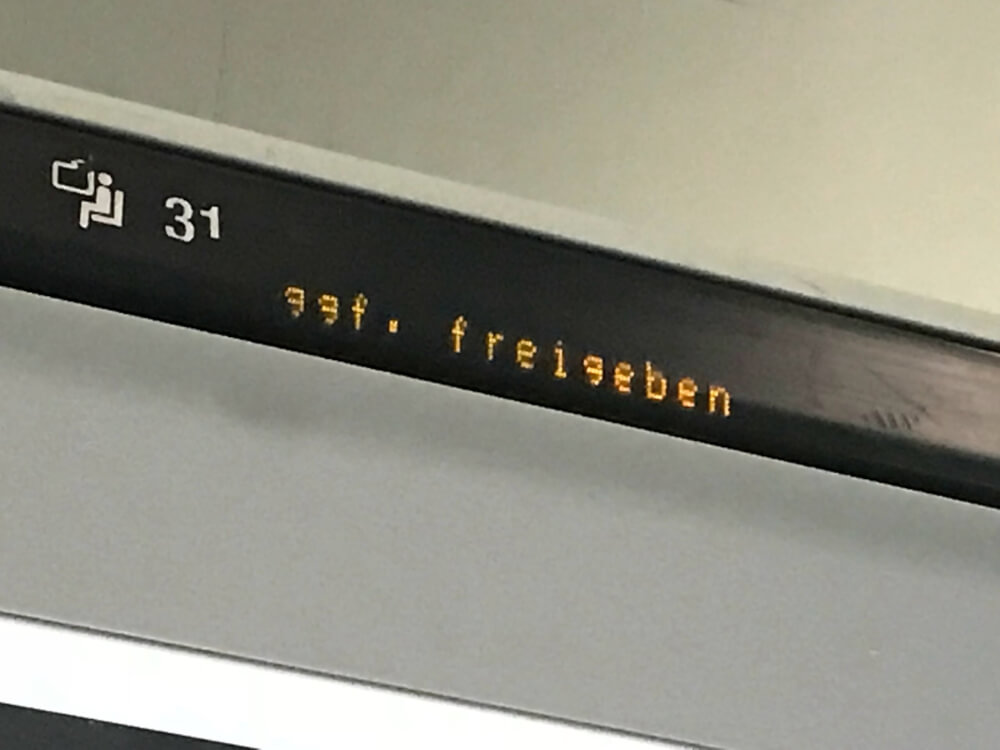
There are also some seats that are reserved for Bahn Comfort customers, i.e. VIP frequent travellers, so avoid those when you see them or an especially fancy-looking person might come kick you out of it.
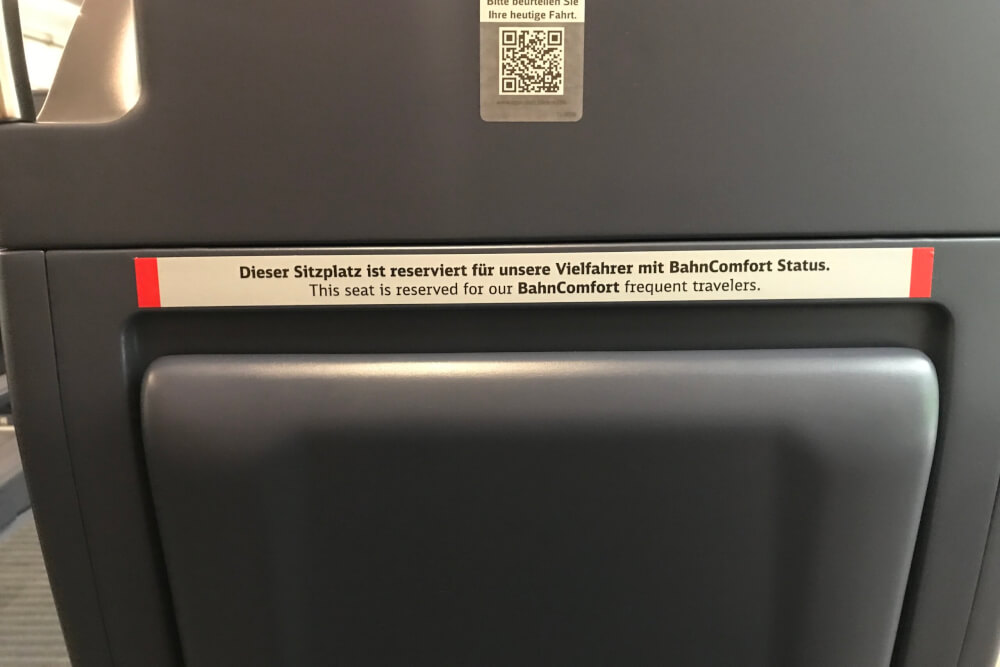
Now finally, onto…
Step Eight: Get Comfortable and Enjoy the Journey!
Once you’re all settled, you’re now in a good place to enjoy some of the hidden features and amenities of your train.
Okay, I say “hidden”, but what I mean is they’re easy to miss, especially if it’s your first time on board a German train.
So, be on the look out for…
Coat hooks: These can be found on the wall next to your seat – sometimes they may need to be pulled out. You can leave coats, scarves, etc. on those
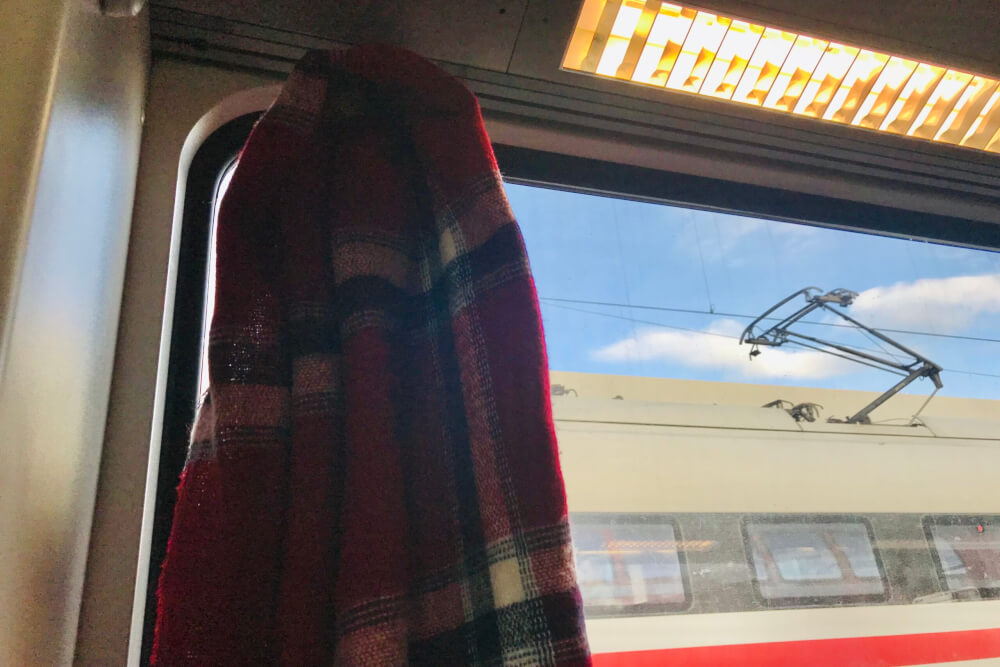
Plugs: Most trains will have an area to charge electronics. On ICE trains, usually the charging ports are in the middle part between two seats. On regional trains, the charging ports can often be found between seats or on the wall.
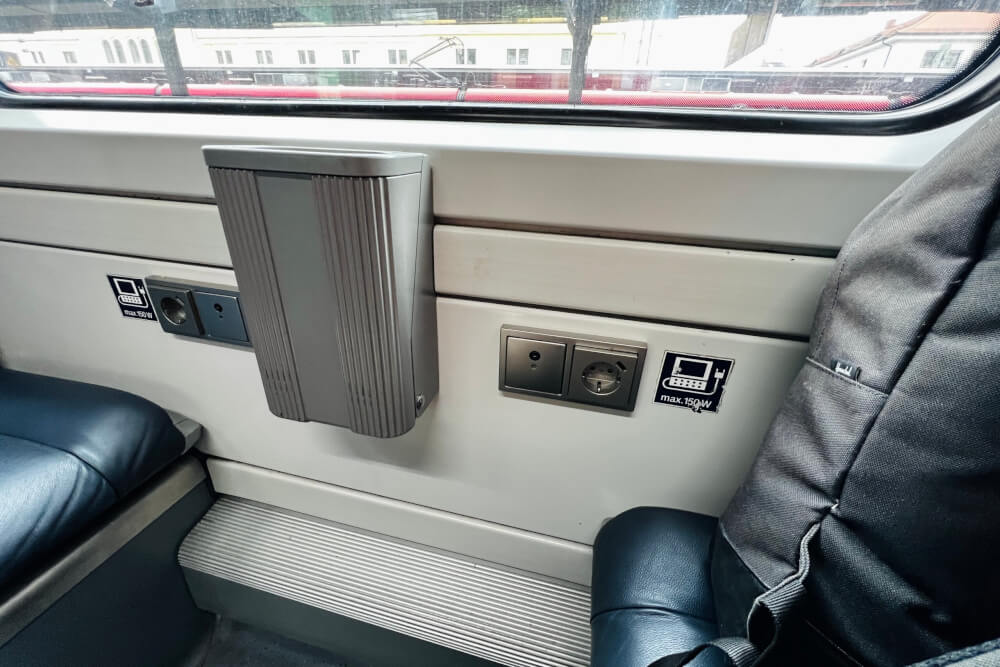
WiFi: Most long distance trains will say they have this but the quality is questionable depending on where you are. Many S-Bahn routes are starting to get WiFi too. Like with modern dating apps, be sure to try connecting, but don’t get your hopes up.

On-board restaurant or bistro: You’ll find these on long distance trains, and if you sit in first class, there’s often even table service straight to your seat.

Bathrooms: And of course, don’t forget to look for the on-board bathrooms (which are free). They’re typically marked by signs saying “WC”.
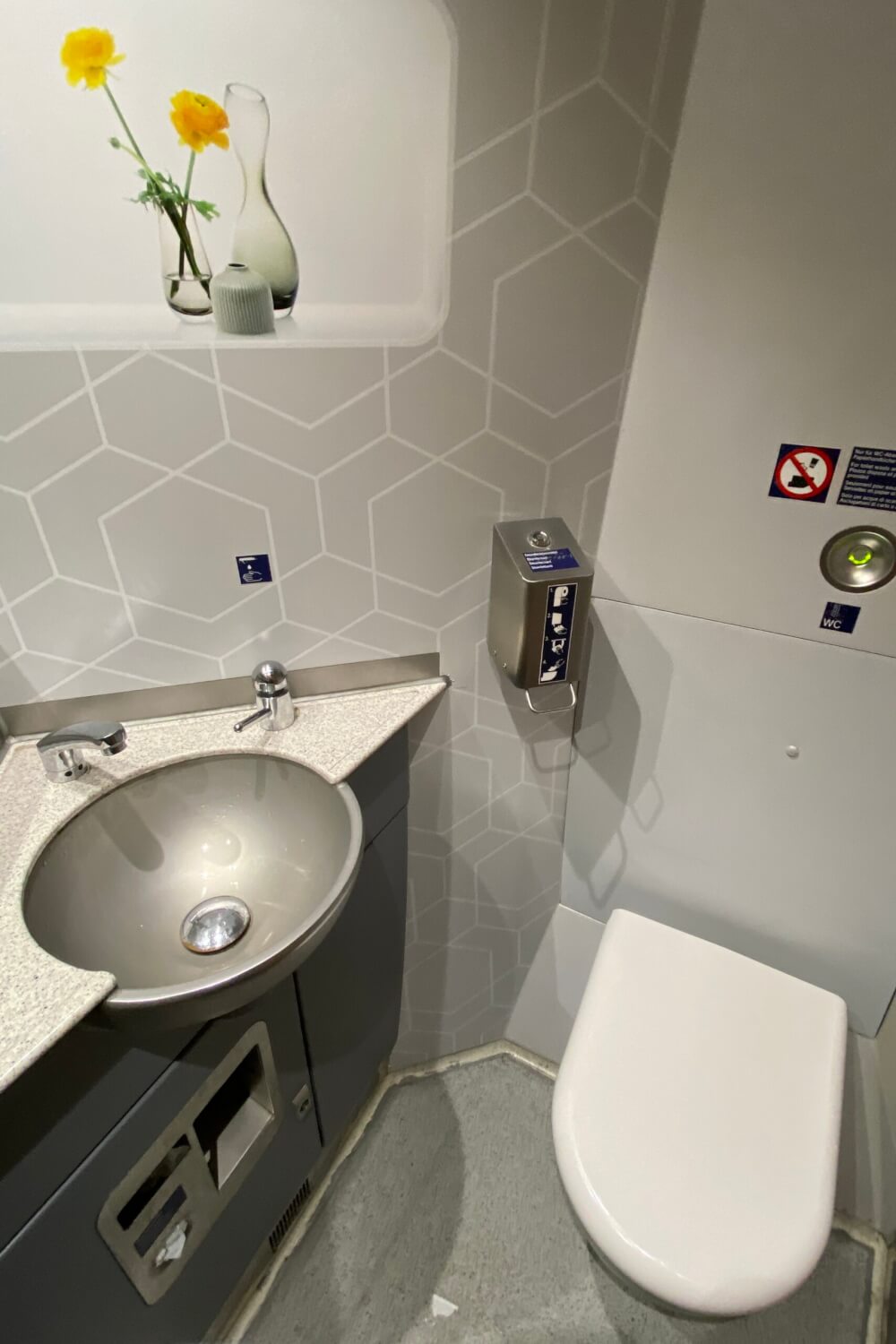
Now, as you get comfy, keep your ticket and ID handy in case controllers come on board. With long distance trains, you’re often able to check yourself in on the app so you don’t have to worry.
Otherwise, you just wait for a controller to come, at which point you show your ticket.
Getting your tickets checked by a controller tends to happen more often in high speed or long distance trains than the regional ones, but regardless just make sure you have your ticket and also some ID (preferably your passport) on you.
Sometimes they will want to verify your name if it’s a reserved ticket, and your age/residency as well depending on whether or not you’ve purchased a discounted fare.
I’ve had it before where they didn’t accept foreign IDs like driver’s licenses – only passports, so that’s why I’d recommend having that.
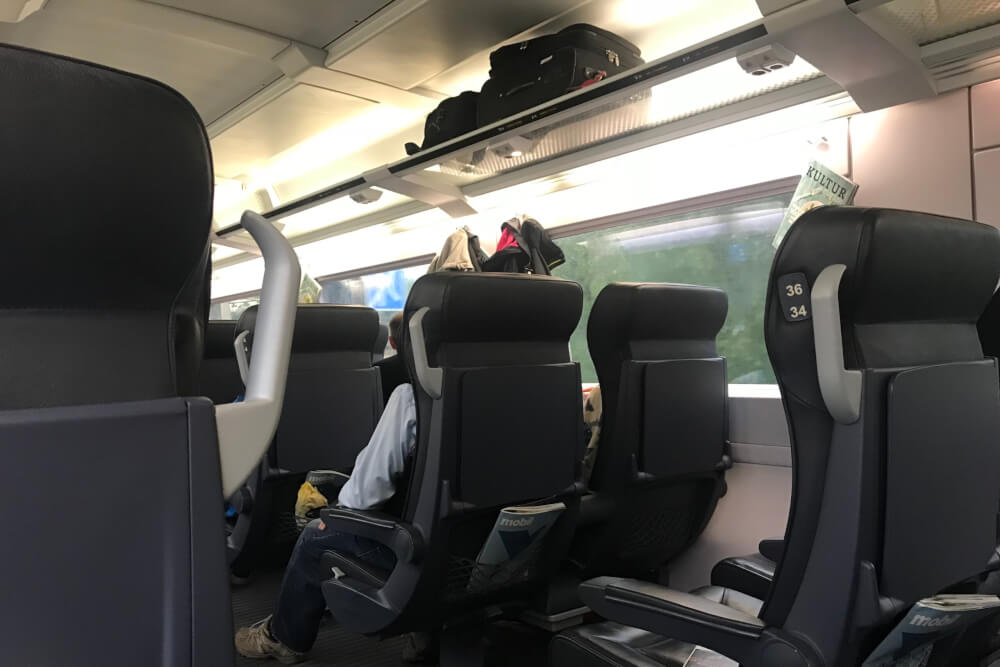
Now after your journey is complete, it’s onto…
Step Nine: Disembark
If you are not getting off at the end destination, then start prepping for disembarkation about 10 min before your arrival time. This gives you plenty of time to gather your belongings and bags in a rational, non-crazed manner.
To keep track of what time you’ll be arriving, keep an eye out for screens that show the scheduled arrival time/estimated arrival time.
Make sure you memorize the name of the stop you’re meant to get off at because most major German cities have multiple train stations and it gets a little confusing once you’re in the city. Like in Munich, you could accidentally get off at the East station instead of the Central Station, just because the names start the same.
And if you’re transferring onto another train, keep an eye out on signs/listen for announcements just before your arrive at your station because they will usually tell you which platforms to transfer on, and if there are any delays/disruptions for transfers.
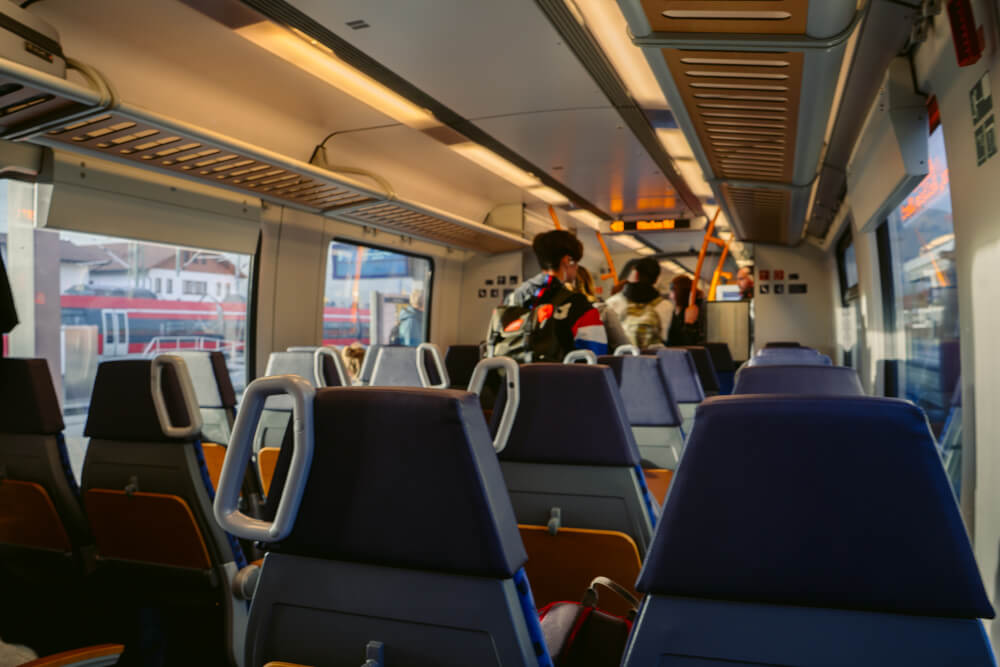
Upon arrival, if the door isn’t opening then again look for a button with the <> open symbol.
Once the doors are open, be careful getting off the train as there’s often a gap/step.
To navigate your way off the platform and onwards to wherever you need to go, keep an eye out for signs that will point you in the right direction.
If you are transferring onto another train, look around for big signs pointing to different platform numbers. If it’s a tight connection (10 min or less) you may want to speed walk or run, depending on how big the station is.
NOTE: Remember, you’re on a train platform, so to reach other platforms you need to either go via a tunnel underground or sometimes a bridge above ground. Keep an eye out for stairs/an elevator so you’re not panicking to find ways to reach your next platform.
If this is your final destination but you need a place to drop off your bags while you explore, most major train stations will have a paid left luggage area with lockers, which is great if you’re too early to check in to your accommodation, or just dropping in for the day.
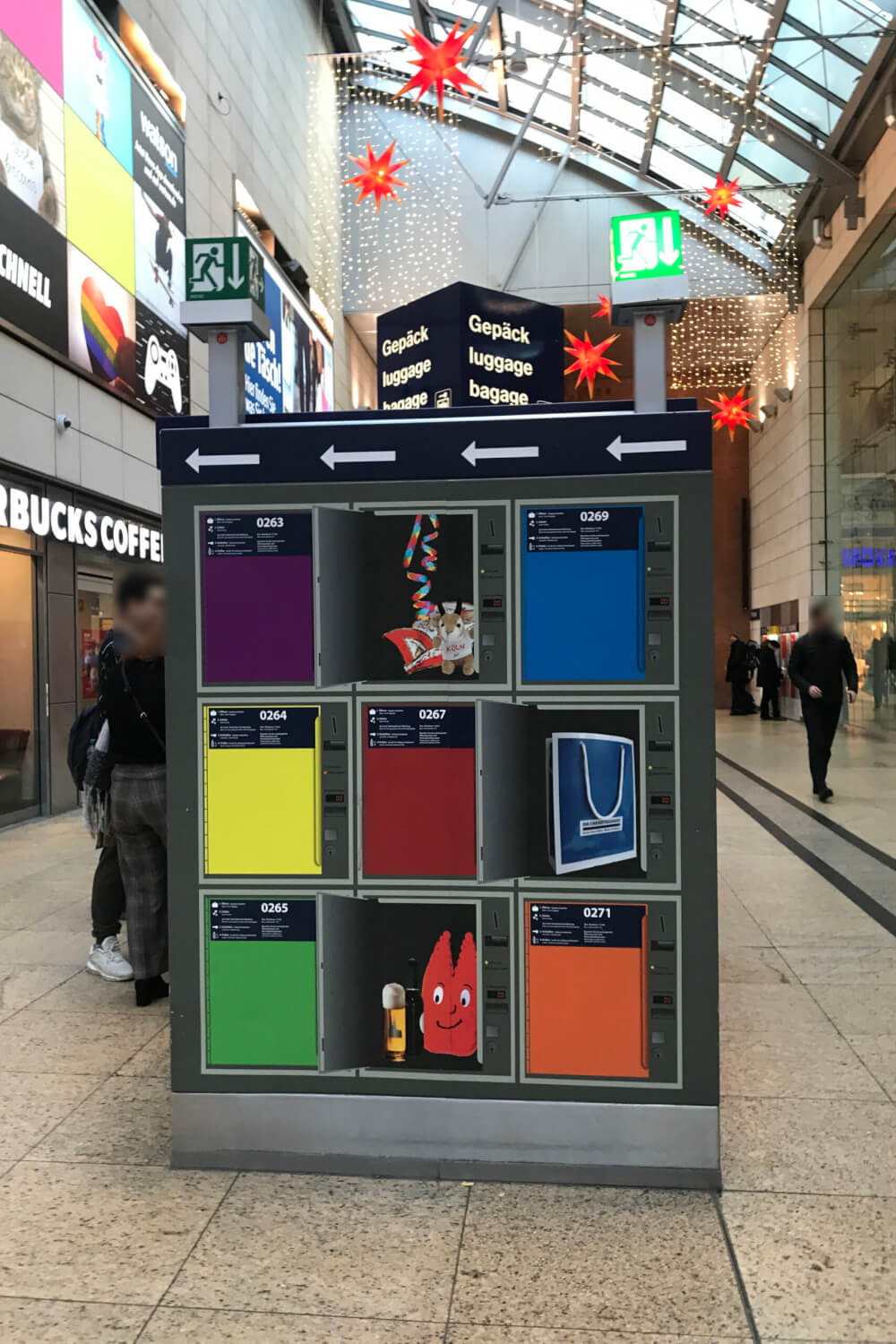
Remember that your train ticket is usually only valid for that specific train you boarded, so you won’t be able to use it for onward travel on the metro or bus unless you bought a special regional ticket or a City Ticket add-on.
Lastly, take note that in Germany, if the train is more than an hour delayed, you are entitled to compensation. Just make sure you get some proof of the delay, whether through an employee or through photos of signs showing the delay. You can then fill out a form or claim compensation through your DB app.

Final Tips for Taking the Train in Germany
Alright, we’ve gone through ALL the basics so now I’m going to simply leave you with some extra bonus tips on how to make the most of the German rail system!
Learn basic train-related vocabulary
The German rail system is very English-friendly for the most part, with many trains making announcements in English and most train attendants speaking at least some English as well.
That said, when you’re in a panicked state dealing with travel stress, sometimes it IS helpful to know some basic words, so here are a few to keep in mind that may be useful:
- Bahnhof: Train Station
- Hauptbahnhof (HBF): Central Train Station
- Gleis: Platform
- Abfaht: Departure
- Ziel: Destination
- Einsteigen : To board
- Aussteigen : To disembark
- Umsteigen : To change/transfer
- Zurückbleiben – To stand/stay back
- Endstation: Final stop
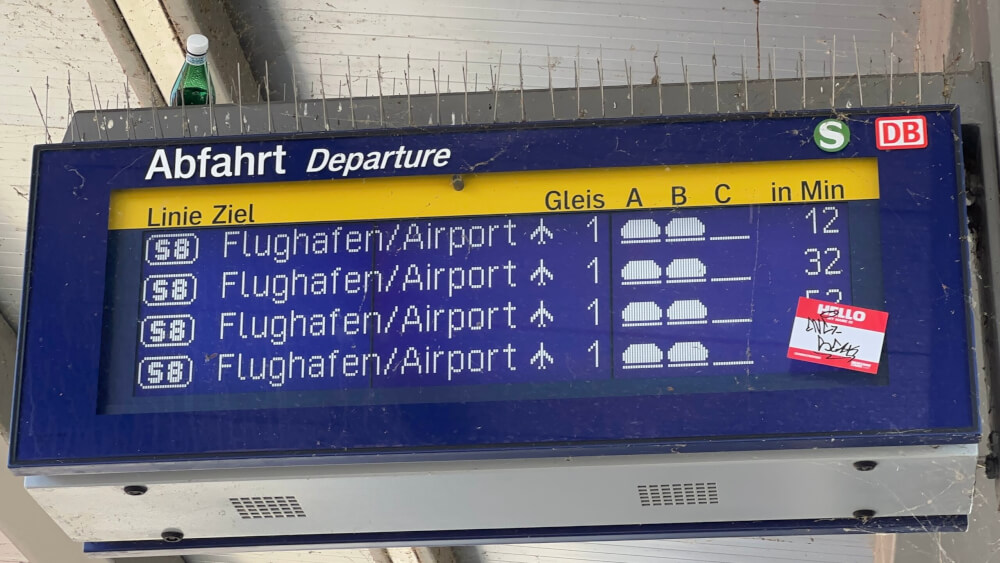
Download the DB Navigator App
I’ve said it so many times already, but the DB Navigator App is an amazing tool, and well worth downloading even if you’re only taking a few trips.
Google Maps does sync train info but it’s sometimes inaccurate or incomplete. The DB Navigator app is free and simple to use, plus it unlocks a bunch of bonus perks like self check-in. Highly recommend!
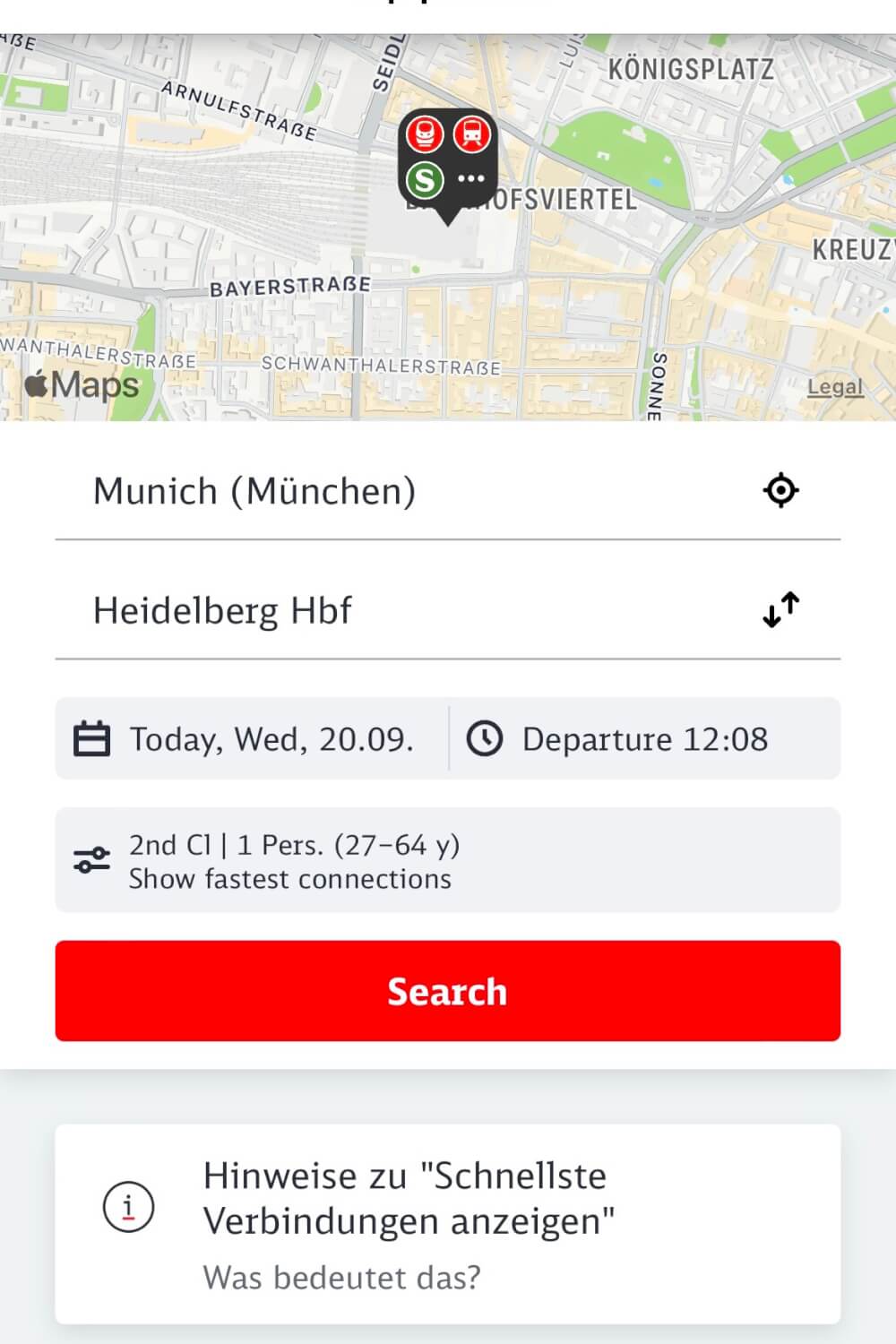
Make use of helpful search filters to find the right train
If you’re struggling to choose which trains to get, then the good news is there are many helpful tools built into the DB website/app.
If you’re travelling exclusively with a Regional Ticket or Deutschland-Ticket for instance, it may be helpful to click on “Mode of Transport” and then set it to “Local Transport Only” which will then filter out high speed trains and show you only the trains you can take with one of those tickets.
You can also ask them to only show the fastest connections, direct services only, trains with a minimum transfer time, or even specify what stopovers you want.
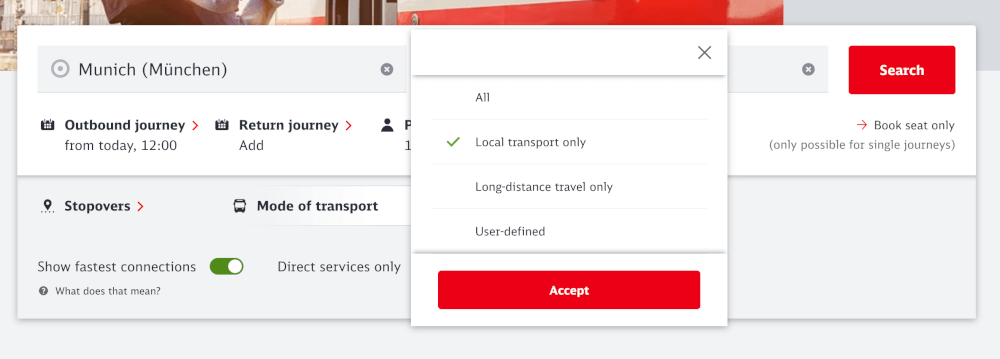
Avoid peak times
As a tourist, you have the luxury of flexibility, so try to plan your train trips around when other people aren’t travelling.
This will ensure the least stressful experience, and make sure you have room for you and your bags.
Some times to avoid include:
- Early morning (to avoid business travellers)
- 3-4pm during school days
- Early evenings just after work (again, to avoid business travellers)
- Weekends (Friday & Sunday evenings, plus Saturday & Sunday mornings especially)
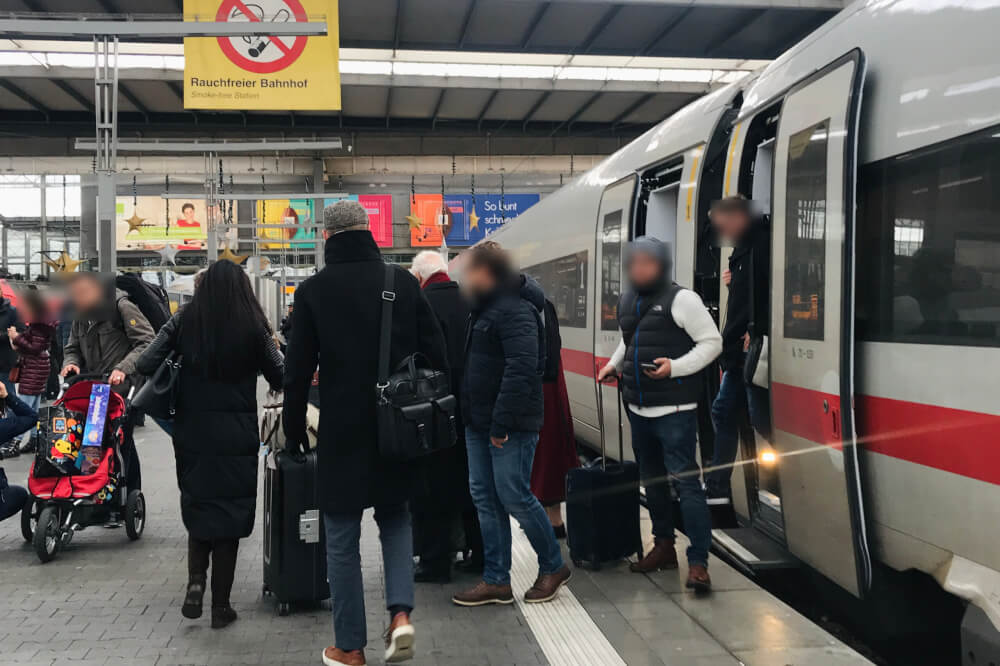
Use the bathroom on the train – bathrooms at the station cost money
As I mentioned in my Germany must-knows post, free public restrooms are quite rare in Germany, which means you’ll usually have to cough up 50 cents or more to pee at train stations.
NOTE: If you do end up using a paid train station toilet, usually the machine will print you a little coupon to use on a future purchase, so if you need to go, head to the toilet first before buying your train station snack.
Luckily, trains on board are free! So take care of business before disembarking.
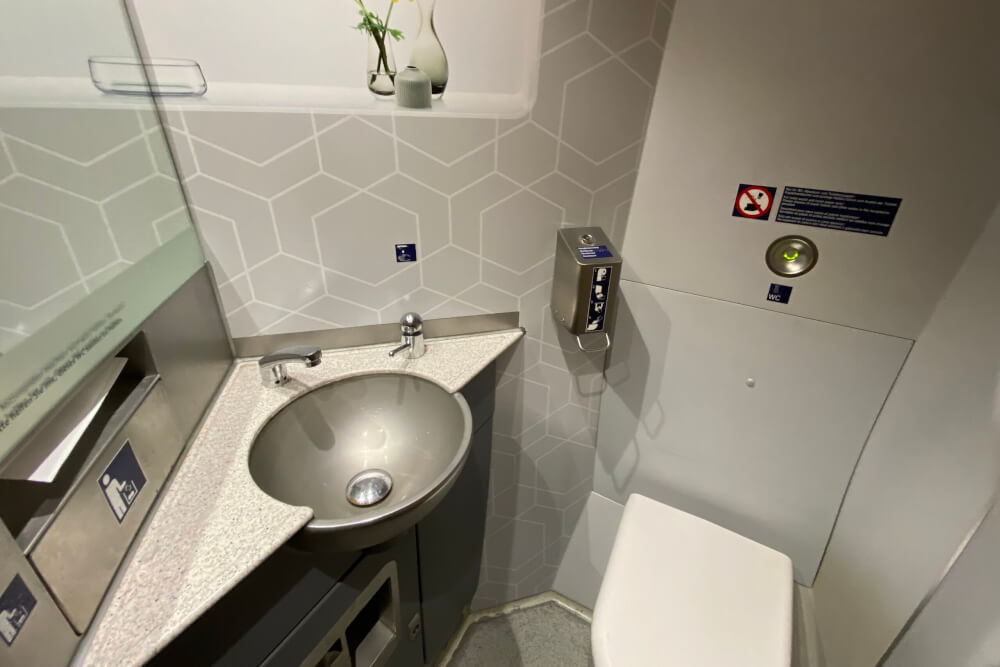
Don’t forget ID
Again, remember to have ID on you, even if it’s just a little day trip. Sometimes they will ask to see it.
NOTE: You might assume a driver’s license is okay, but I’ve had several instances where they’ve insisted on a passport because they don’t recognize foreign IDs.
It kind of depends on who checks you and how cranky they’re feeling that day, but if you’re from outside the EU, it’s a safer bet to just bring your passport… especially because it’s Germany, and your train might accidentally cross into Austria or something without you noticing.
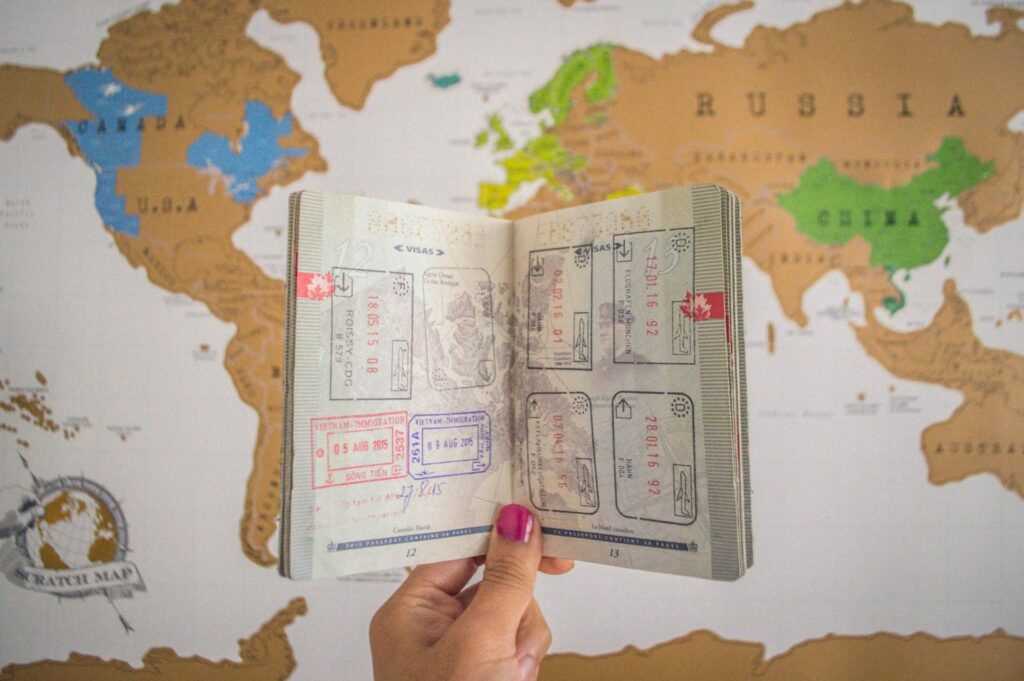
Beware of putting your bag in places you’re not supposed to
One time, I had a suitcase that was too huge and heavy to put in the overhead compartment, so I left it in the bike zone as no one was using it.
About an hour later, a cyclist got on and shouted at the top of his lungs “WHO IS THE HUMAN TRASHBUCKET THAT LEFT THIS SUITCASE HERE?” (Okay, just kidding – my German is bad and he probably didn’t phrase it like that but his tone did).
I was terrified, and was sitting pretty much right next to the suitcase. I had to meekly say it was mine and had the poor dude next to me try to hoist and cram it up in the overhead shelf.
I still have nightmares about it to this day.
So yes, don’t leave your bags where they’re not meant to be.

Learn the names of your destinations in German
Most places like Berlin or Frankfurt have the same name as in English, others like Munich (München) or Cologne (Köln) have a different name in German, so make sure you know the German name of your destination, and how to say it in German in case you need to ask for directions.
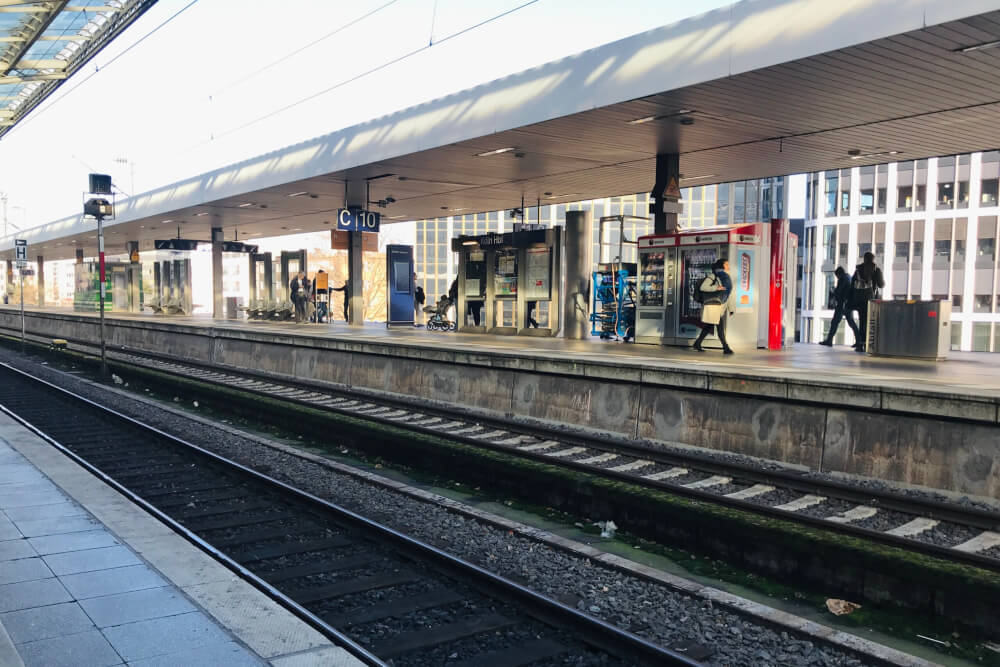
Similarly, learn how to say the names of trains the German way
For instance, ICE trains are not “ice” trains, but rather pronounced Ee Tsay Ay, like the German way of spelling it out.
Be sure to also ask for the U-Bahn, not the subway or Metro.
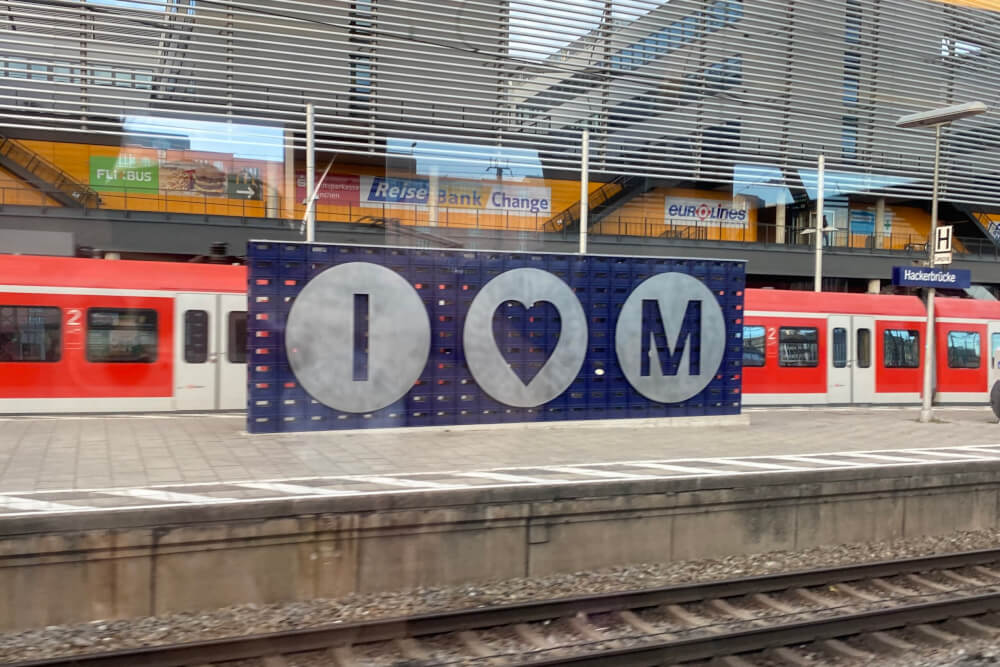
Don’t bank on the WiFi
The WiFi on German trains is hilariously bad considering how much you pay for those tickets… but yes, don’t rely on having WiFi (like setting aside a bunch of work to do on the train that requires it).
Cell service tends to be quite poor as well once you’re away from the big cities.
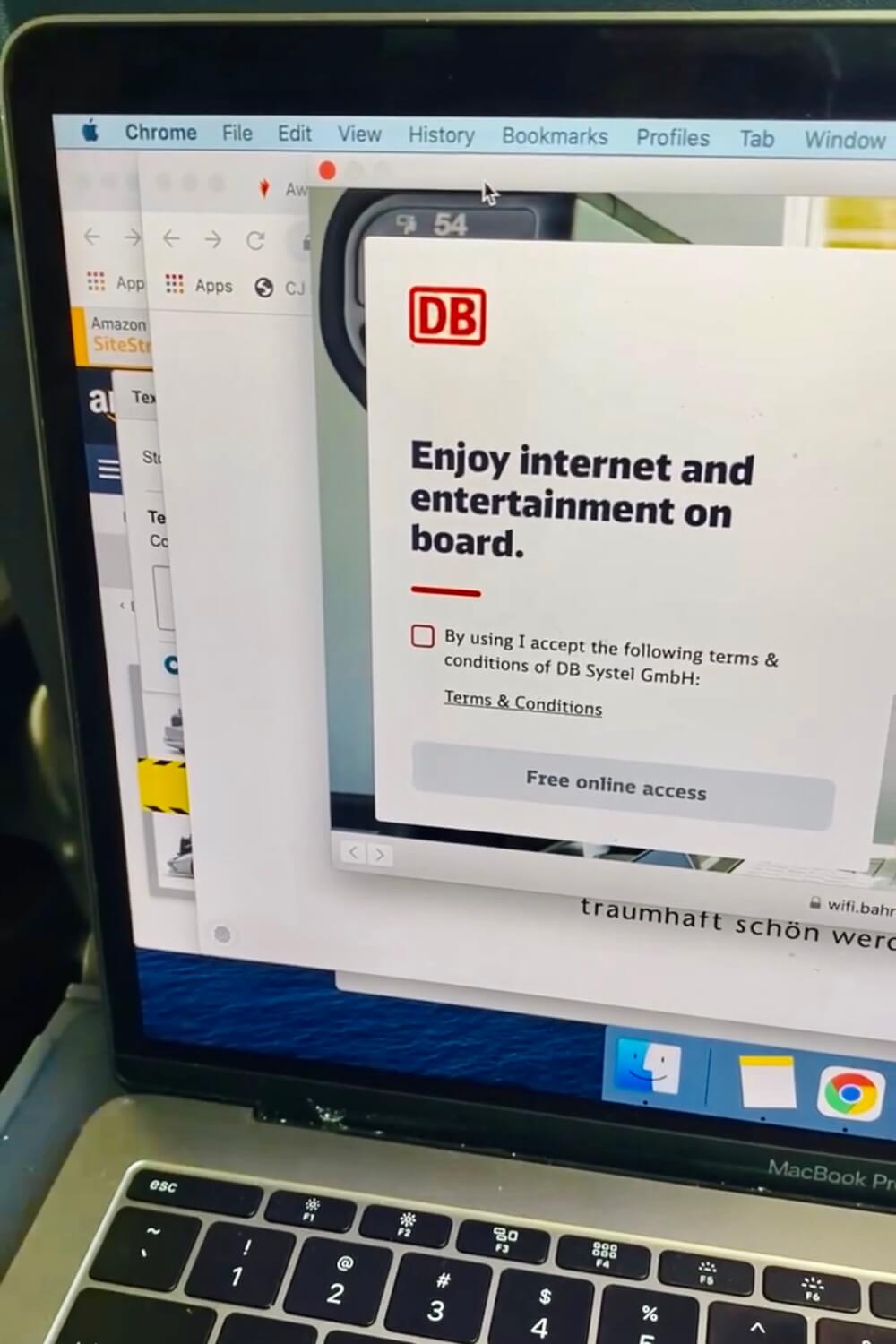
Know your route and stops
The last thing you want to do when travelling by train in Germany is relying solely on the announcements to know when to get off or what to do.
Seriously, mumbling seems to be a skill requirement for workers of DB. Mixed in with ambient train noise and the screeching of rails, I have had it far too many times where I’ve been unable to hear anything the conductor is saying.
They also seem to randomly translate in English when they feel like it, so a translation isn’t guaranteed if you don’t speak German. So, make sure you know your route and approximately when you’ll need to get off, transfer, etc.

Beware of “on demand stops” where you must press a button for the train to make your stop
Very rarely, you may come across stops that only stop when someone requests it. These are known as Bedarfshaltestellen .
This shouldn’t be a concern unless you’re travelling to very small, quiet stations, so I wouldn’t worry too much, but if you notice anything on your ticket that mentions the word “Bedarfshalt” or any signs that say “”Der Zug hält nur bei bedarf” (the train only stops on demand) then be prepared to press a special button before your stop, kind of like on a bus.
If you are boarding at one of these Bedarfshaltestelle , then don’t worry – the train will stop so long as they see you on the platform.
I had this (stressful) experience when I travelled to Untergrainau:
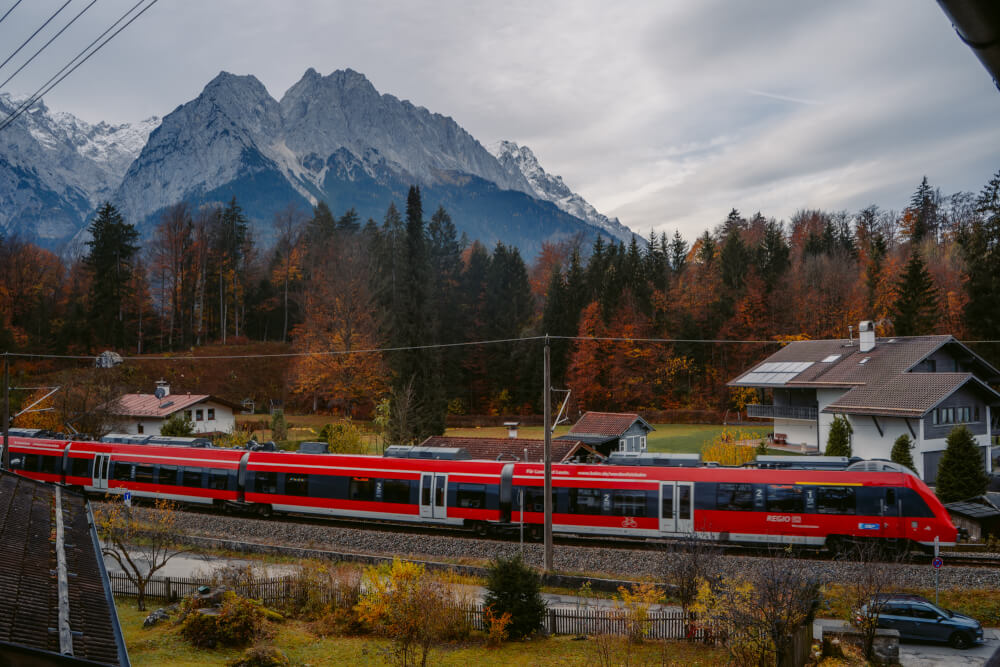
Always read the fine print
Lastly, especially when buying discounted offers for German trains, be sure to read the fine print!
With regional tickets for instance, it’s very common for there to be time restrictions on when the ticket is valid, or when it expires.
Likewise, there’s often restrictions on which types of trains you can take with your ticket, so be sure to read up on these or you may be fined as your ticket will be considered invalid.
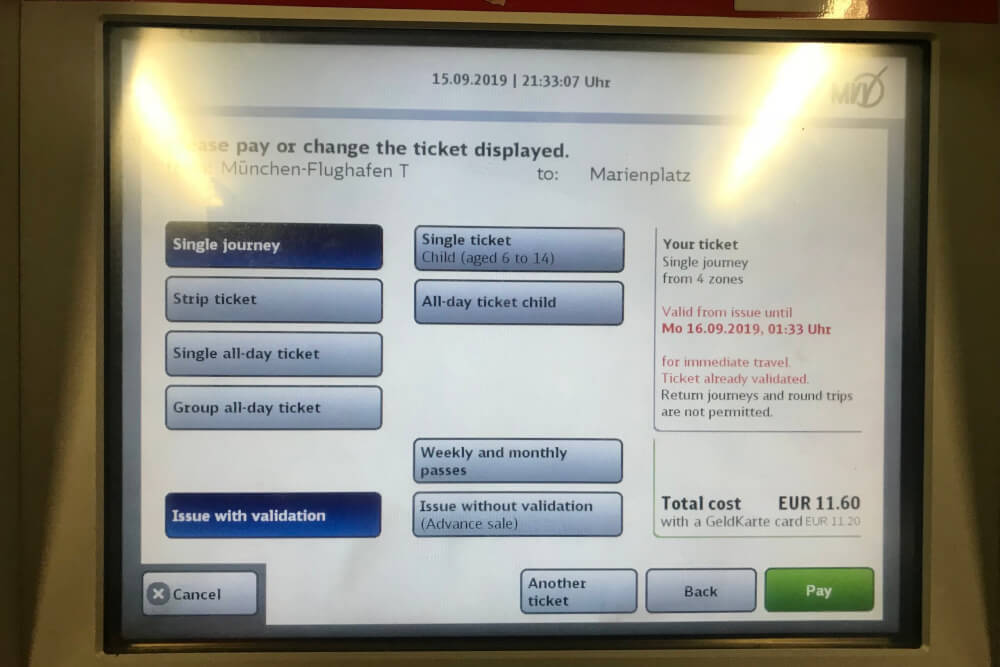
I Hope This Step by Step Guide on Taking Trains in Germany was Helpful!
Let me know in the comments if you have any more questions.
My Go-To Travel Favourites:
🧳 Eagle Creek: My favourite packing cubes
💳 Wise: For FREE travel friendly credit cards
🍯 Airalo: My go-to eSIM
🏨 Booking.com: For searching hotels
📷 Sony A7IV: My (amazing) camera
✈️ Google Flights : For finding flight deals
🌎 WorldNomads: For travel insurance
🎉 GetYourGuide: For booking activities
2 thoughts on “How to Take the Train in Germany: A Step by Step Guide!”
Thank you so much for putting this post together. This was extremely helpful for planning some train travel in Germany. The information is really clear and the pictures are super helpful.
So glad you found it helpful!! Safe travels 🙂
Leave a Comment Cancel reply
By using this form you agree with the storage and handling of your data by this website. *

Home » Destinations » Europe » Germany » 5-14 Day Germany Itinerary: A Guide For Planning Your Perfect Germany Trip
5-14 Day Germany Itinerary: A Guide For Planning Your Perfect Germany Trip
Links in this article may earn us a little money if you book/ order stuff. More here .

Plan Your Perfect Germany Itinerary with These Detailed Templates!
If you’re looking to plan the perfect trip around Germany, you are in luck! We’re passionate about exploring Germany because it’s a great country – and because Lisa is German!
Jokes aside, we’ve been lucky enough (and have made it a point) to see lots of different parts of the country – from the sea in the north to the mountains in the south. That said, Germany can be a tough country to plan a route or road trip through because there is just so much to see and do!
So, whether you’re looking for the best week in Germany or a Germany itinerary that covers 5 days or 14 days – here’s our master guide with 7 detailed Germany itineraries by train and/or by car! We’ve got cities, attractions, hotels and accommodations, directions, and distances to help you plan the best Germany travel route for you!
We’ve got other great posts to help you plan a visit to Germany:
- Must-Knows + Tips for Travelling to Germany for the First Time
- Helpful German Phrases to Get You By
- Discover 30 Beautiful Places in Germany
- Our Top Hostels in Germany (Stayed at all of them)
Table of Contents
Things to Consider When Travelling in Germany
Before you plan your trip to Germany, there are some things that you should know and keep in mind to make planning easier and to have a successful trip. While you probably know that the currency used in Germany is the Euro, here are some other topics that you should consider as well.
Best Time of Year to Visit Germany
Germany is actually a destination that you can visit year round – but it is important to plan accordingly and go in with the right expectations. If you’re planning a trip during the spring – let’s say from March to May – you could absolutely have beautiful weather… but it may also just rain a lot.
Unfortunately, the weather can be quite difficult to predict. However, as long as you prepare for different possibilities, you can have a great time no matter the weather! Generally you can say that Germany has a moderate climate with cool and rainy winters (more snowy the farther south you get) and warm – but not overly hot – summers.
July and August are usually the warmest months with an average temperature around 20°C. However, there can be days where you have 30°C. Of course, this can vary depending on the exact location you’re travelling to. Often, it is colder by the north coast than it is farther south.
We would honestly recommend that you avoid visiting the country in July if you dislike crowds since this is when the majority of kids are on their summer break from school. As a result, some cities can get quite busy.
Typically, we would recommend travelling in May or June and then from the end of August until the end of September (or even the middle of October). However, there is also a great reason to plan a Germany trip during the winter because of the many beautiful Christmas markets that you could visit at that time of year!
Public Transportation in Germany
Public transportation in Germany is quite good, especially when compared to North America. Yes, sometimes us Germans like to complain about the “Deutsche Bahn” – the German train company – but at the same time we are also super glad that it exists and works well.
If you’re wondering: Yes, all the itineraries mentioned below can absolutely be done if you want to take the train (minus the odd day trip to a castle here and there). If you want to check a train connection and/or buy tickets in advance you can do so on the DB Website . Alternatively, you can also download the DB app to your phone. We both have it and use it regularly.
As an alternative to the train, you can sometimes also use the bus to get from one city/town to another. Since 2013 (before this date it wasn’t allowed), long distance buses have established their presence in more and more cities and are now a popular way to get around for people who are more conscious of their money.
Unfortunately long distance train tickets can sometimes get quite expensive if you don’t book in advance – so the bus can be a good alternative in some cases.
The most popular long distance bus company in Germany is probably Flixbus. We have also used them multiple times to get between cities. If you want to look at the schedule and/or book a ticket, you can do so on their website .
In addition to the trains and long distance buses, the public transport within the cities is also usually pretty good – especially in bigger centres. Many of the cities – or transport associations – have their own transport apps. So, if you know where you are going and plan on using the local buses, trams, metros, etc. then downloading the local transport app would be a great idea!
Car Rental in Germany
If you want to rent a car and plan a Germany road trip, then that is certainly an option as well. Driving in Germany is generally pretty safe and people are not usually as reckless as in some countries in the south of Europe. However, it can get a little crazy in bigger cities like Berlin or Munich – especially if you are not used to driving in bigger centres.
In Germany, you drive on the right side as it is done in the United States, Canada, and many other countries as well. You have probably heard of the “Autobahn” – that’s simply the German name for our highway system. If you follow any of these itineraries, you’ll drive on many different highways.
While it is true that there is no speed limit in some parts of the Autobahn, there are lots of sections where there are actually speed limits in place. You can usually find limits imposed at/around construction zones along the way – so don’t think you can just speed all the time.
And PLEASE don’t drive on the Autobahn like you would on a highway in the United States or Canada – pass on the left and then get back over . If you’re going slower than other cars, there’s no need for you to be in the left (or even in the middle) lane. You can probably tell that this is something that Lisa complains about in Canada frequently, haha.
Since Germany is such a popular destination, there are lots of different rental car agencies to choose from. You can compare prices from different agencies for the duration of your trip with this handy rental car comparison tool . Please make sure to read the fine print so you know whether you need extra insurance, etc.
Also please be aware that many people in Germany drive cars with a stick shift. Rental cars with automatic transmissions exist, but the numbers available are usually lower and these cars might be slightly more expensive.
We’d also recommend that you reserve an automatic car well in advance if you need one – just so you can make sure that one is available for you. It probably wouldn’t be fun learning how to drive a stick shift while on a road trip in a foreign country.
Travel Insurance for Germany
If you’re planning a trip to Germany and you’re not from another EU country, then you should make sure to get travel insurance for the duration of your trip!
While you’ll probably be fine, accidents do happen and it could get really expensive if you’re not covered. That’s why we always travel with insurance.
If you live in another EU country and have health insurance there, you can get the blue health insurance card with which you are covered in other EU countries in emergency cases, as well.
If you don’t have that option – or are from outside of Europe – we recommend that you get private travel insurance.
Germany Itinerary 5 Days
If you only have a few days to travel through Germany, then have a look below at the two 5-day itineraries we have created. For these itineraries, we have assumed that you are not already in the country so they all start and end in bigger cities.
This should help make it easier for you to fly in/out of an airport with good connections if you are coming from overseas.
Depending on your preferences, you can choose between a trip through the northern part of Germany or a trip through the south of the country (mainly Bavaria). If you are interested in bigger cities and/or harbours, then we’d recommend the northern route.
In case you prefer half-timbered houses and beautiful old towns, then you should have a look at the southern route instead. Of course, you can always modify any itinerary to better suit your interests!
Germany Itinerary 5 Days – North
This 5-day Germany itinerary through the northern part of the country can certainly be considered a “sampler-type” of itinerary since you get to see the two biggest cities in the country – but not much more than that.
That’s completely fine though – you can only see so much in five days anyway. If you are interested in bigger cities and don’t have more than a few days, then this itinerary would be great for you!
The total driving time for this itinerary would be about 5 hours 30 minutes with a total distance of approx. 520 km. Of course, this can change depending on the route you are taking and the time of day you are travelling. Commuter traffic could add quite a bit of travel time to your journey.
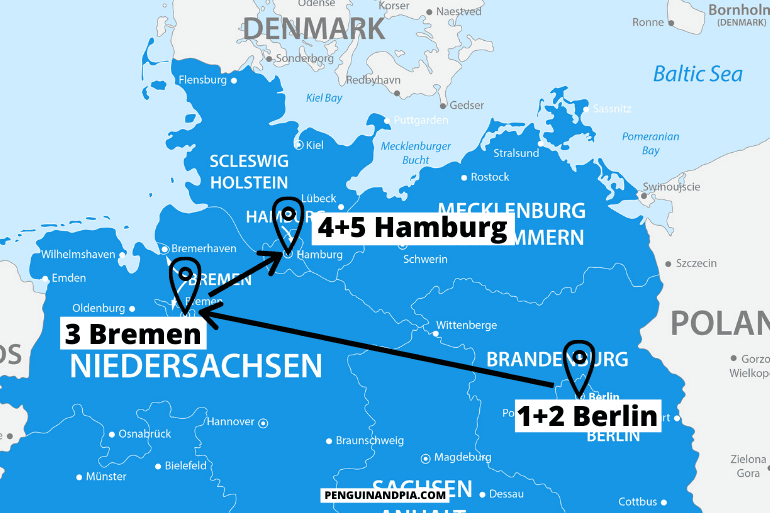
Day 1+2: Berlin Day 3: Bremen Day 4+5: Hamburg
Day 1+2: Berlin
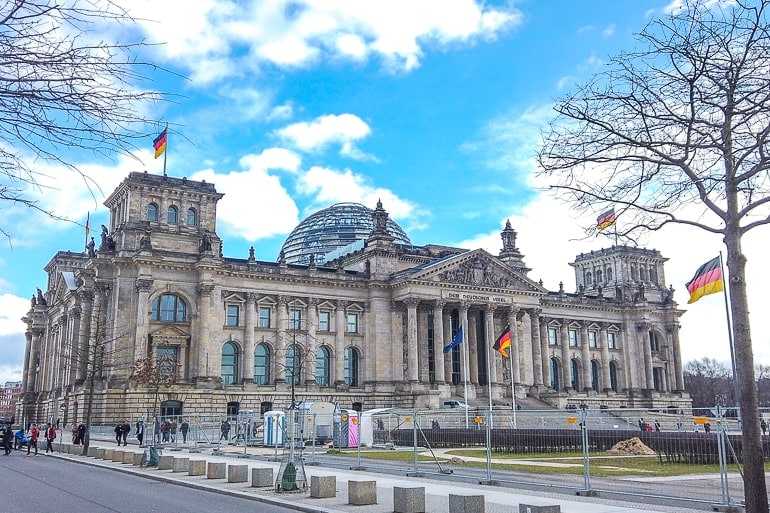
Berlin is a great place to start your adventure since it is the German capital, has multiple airports close by, and has really good train connections.
Since Berlin is such a popular tourist and business city, the car rental industry is well established and there are many different rental agencies to choose from.
— Compare prices from rental car companies in Berlin here
However, since you are only visiting bigger cities on this relatively short itinerary, we believe that a rental car is probably not necessary. Instead, for this trip, it might make more sense to take the train.
Since Berlin is such a big city with lots of things to do, it is worth it to spend (at least) two days in the city. So, remember to book your accommodation in Berlin for two nights .
Accommodation in Berlin : Berlin is a massive sprawling city with loads of different areas to stay and different accommodation options. You can check here for accommodations and hotels in Berlin .
If you are travelling to Berlin with a car, you’ll need a place to park. Check out Park Plaza Wallstreet Berlin Mitte for a stay right in the middle of the city close to Museum Island and other top attractions. It also has a tasty breakfast. Park Plaza has free parking on the street near the hotel (if available) or else it’s for a fee (but a reasonable price considering you’re in the middle).
If you are arriving into Berlin by train, you can check out NH Collection Berlin Mitte am Checkpoint Charlie . Located in the city centre right near the top sight “Checkpoint Charlie”, this popular hotel is in the heart of the action/attractions and is easy to get to via modes of public transit (metro – called the “U” for U-bahn).
If you are searching for a hostel/hotel, check out PLUS Berlin . Located over near the East Side Gallery (the piece of the Berlin wall with the artwork on it), Eric stayed here and really liked it! It’s also very easy to get to using public transit and is close to other areas to go out, etc.
Must-see Attractions in Berlin:
- Brandenburg Gate
- East Side Gallery (Berlin Wall)
We have also written a whole article about classic tourist attractions in Berlin in case you’d like some more inspiration. If you’re looking for some tips on how you could spend a day in Berlin, have a look at our One Day in Berlin Guide .
Day 3: Bremen
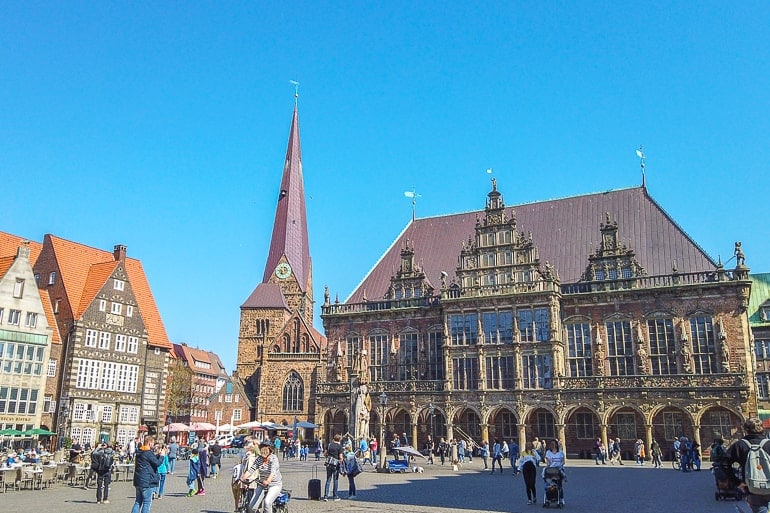
On the third day of your 5 days in Germany, you’ll head for Bremen. We’d recommend that you do the drive/train ride in the morning so you have enough time to explore the city once you get there.
Bremen is a hanseatic city with a nice old town – the market square with the town hall and the cathedral is especially popular. In German-speaking countries, the city is also known for a tale called the “Town Musicians of Bremen” by the Brothers Grimm. You’ll come across the animals of the tale (donkey, dog, cat, and rooster) many times as you stroll through the city.
The drive from Berlin to Bremen will take you approximately 4 hrs 10 min by car , but only around 3 hrs by train . If you take the train, try to book in advance if you can as this will usually save you some money.
Accommodation in Bremen: Bremen is a popular city to explore and it’s also on the larger side so you’ll find plenty of accommodations to suit your needs. There are hotels in the city centre/old town which put you within walking distance of the river and top attractions. You can check here for accommodations and hotels in Bremen .
For a popular choice in the historic middle, you should check out the very popular Radisson Blu Hotel Bremen . Funny story – we know there’s underground parking because we parked there when we visited Bremen by car.
If you want to stay closer to the train station just outside the historic centre (but still very central), check out the Dorint City-Hotel Bremen . This lovely and also very popular hotel is close to the pretty Windmill and flower gardens and has water views just outside the old city walls.
Must-see Attractions in Bremen:
- Marktplatz with Town Hall and Cathedral
- Böttcherstraße
- Schnoorviertel
If you want some more tips for Bremen, have a look at our detailed Things to do in Bremen Guide .
Day 4+5: Hamburg
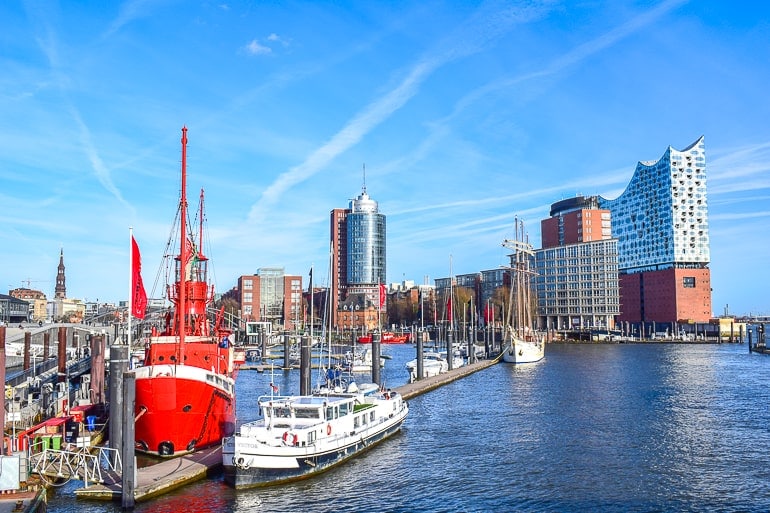
Hamburg is the second-biggest German city and the last stop on this short itinerary. We have been to Hamburg numerous times now and it is actually one of our favourite bigger German cities. You’ll find that the atmosphere of the city is very different than in Berlin. Not necessarily better or worse – just different.
Interesting (and slightly irrelevant) fact: The cities you visit on this itinerary are the three city states that exist in Germany in addition to the 13 area states such as Bavaria, Nordrhine-Westphalia etc.
The drive from Bremen to Hamburg is actually pretty simple and should only take around 1 hour 30 minutes by car and just around 1 hour if you take an ICE (fast train) . The train connection between these two cities is great with trains running pretty frequently. That should make it quite easy to find a train connection that works for your schedule.
Accommodation in Hamburg : Hamburg is popular city with loads of different accommodations and areas to stay in. You can check here for accommodations and hotels in Hamburg .
If you are travelling to Hamburg with a car, you might want to check out the Mövenpick Hotel Hamburg . Located in an old water tower, this unique hotel has a number of cool features with stunning views and parking onsite. It’s very popular – and also close to public transit for getting around!
If you are travelling to Hamburg by train, ARCOTEL Rubin Hamburg is a great hotel option for you to check out. Located in the cool area of St. Georg, you can easily walk to the hotel from the train station. It’s also walkable to other parts of the city centre and other attractions.
If you are looking for a hostel in Hamburg, you might want to check out Generator Hamburg as a reliable and popular hostel stay close to central station and the heart of the city.
If you want more details about accommodations in the city, we have a more detailed guide on where to stay in Hamburg .
Must-see Attractions in Hamburg:
- Speicherstadt
- Elbphilharmonie
- St. Pauli Piers
As one of our first ever articles on Penguin and Pia, we actually wrote a short Hamburg Guide . Have a look if you want some more Hamburg inspiration. Unfortunately it’s not nearly as detailed as our newer article – looks like it’s time for an update!
Germany Itinerary 5 Days – South
If you would like to explore the southern part of Germany instead of the north, then we would recommend the following 5 days Southern Germany itinerary. Compared to the northern itinerary, this trip includes stops in some smaller towns and cities. So, if you are interested in seeing some places of various sizes, beautiful old towns, and maybe a castle, then this might be a good itinerary for you.
The driving distance of this trip is just around 680 kilometres with a total driving time of approx. 7 hours . Depending on your mode of transportation, this can – of course – vary slightly.
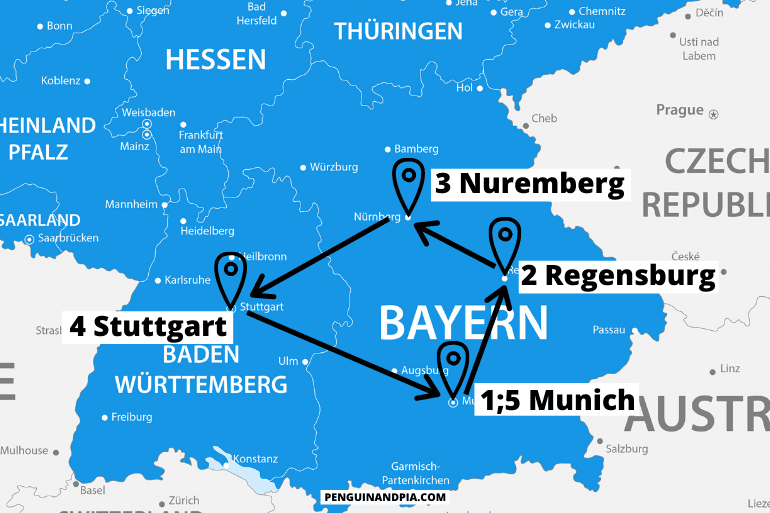
Day 1: Munich Day 2: Regensburg Day 3: Nuremberg Day 4: Stuttgart Day 5: Munich
Day 1: Munich

We are starting (and ending) this itinerary in Munich since it is an easy airport to fly in and out of from other parts of the world. If you are coming from another part of Europe by train, the connections to Munich are also usually pretty good.
Munich is the third-biggest German city and a very popular tourist destination. International travellers often mainly know the city because of the Oktoberfest which happens every year from the middle of September until October.
However, there is so much more to do and see in Munich than just the “Wiesn” (as the Oktoberfest is sometimes called as well). We are always happy to return to Munich because there is just so much to explore.
If you are thinking about renting a car for this itinerary, then you’ll be happy to know that it is quite easy to get a rental car in Munich. You can either pick it up directly at the airport after you land (if you arrive by plane) or in the city centre before you head to the next stop on this journey.
— Compare prices from rental car companies in Munich here
Accommodation in Munich: Munich is very large and popular city so finding a place to stay is no problem. The issue becomes that there are too many places to choose from! That said, you can check here for accommodations and hotels in Munich .
Specifically, we stayed at the very popular H2 Hotel München Olympiapark and we would highly recommend it for the value for money. The hotel has nice, cozy rooms, a super great breakfast buffet, and has a metro station steps from the front entrance to take you to the city centre.
There’s also onsite parking which makes this hotel perfect if you are travelling to Munich by car. The famous Olympic Park and BMW Museum are close by, too!
If you want to stay a little more in the city centre, then check out the Platzl Hotel Superior . This trendy hotel is in the heart of the Old Town just steps from top attractions like Marienplatz and the famous Hofbräuhaus. It’s also easy to get to the central train station either walking or on the metro.
If you are looking for more details on accommodations in this massive city, we wrote a detailed guide on where to stay in Munich .
Must-see Attractions in Munich:
- Marienplatz with New Town Hall
- Olympic Park
- Victuals Market
- English Garden
We also have a great little guide on how to spend one day in Munich if you want more details.
Day 2: Regensburg
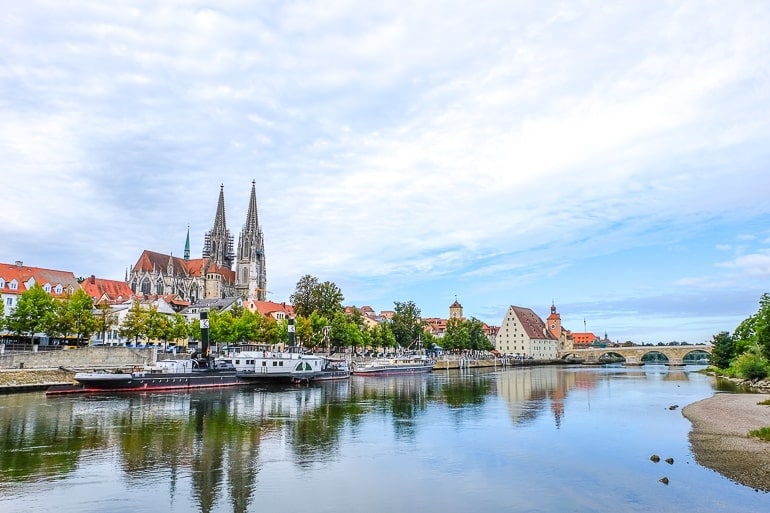
On day two of your trip you’ll be on your way to Regensburg, a small city in Bavaria on the Danube river. Due to its location by the river, Regensburg is a popular stop for people on a river cruise. So don’t be surprised if you see many different tour groups in the Old Town.
We recently spent a couple of days in Regensburg to get to know the city better and enjoyed our time there. One of the highlights is the Old Stone Bridge in the city centre which was built in the 12th century. We actually filmed a small YouTube video in Regensburg – which you can watch here if you are curious about what the city looks like.
The journey from Munich to Regensburg takes approximately 1 hr 20 minutes by car and around 1 hr 30 minutes by train . If you decide to travel by train – and especially if you are travelling with other people – we would recommend that travel with a “Bayernticket” (Bavaria Ticket). This ticket for train travel within the state of Bavaria usually allows you to save some money compared to regular prices.
Accommodation in Regensburg: If you are staying a night in Regensburg, you’ll have a number of great accommodations to choose from. To get started, you can check here for accommodations and hotels in Regensburg .
When we visited the city, we stayed at the Holiday Inn Express – Regensburg and really liked it. It’s a newer hotel and it really shows. The breakfast was excellent and there is even an onsite parking garage if you are travelling with a car. It’s not in the Old Town or near the river – but we did walk there one day and it only took about 15 minutes.
If you are travelling by train and you are on-foot, then check out the Altstadthotel Am Pach . This simple hotel is located right in the heart of the old town so you’re close to everything there is to see and do in Regensburg – including the beautiful Danube River. They also have breakfast included.
Must-see Attractions in Regensburg:
- Old Stone Bridge
- St Peter Cathedral
We are currently still working on our Regensburg Guide – but we’ll link it here once it is published.
Day 3: Nuremberg
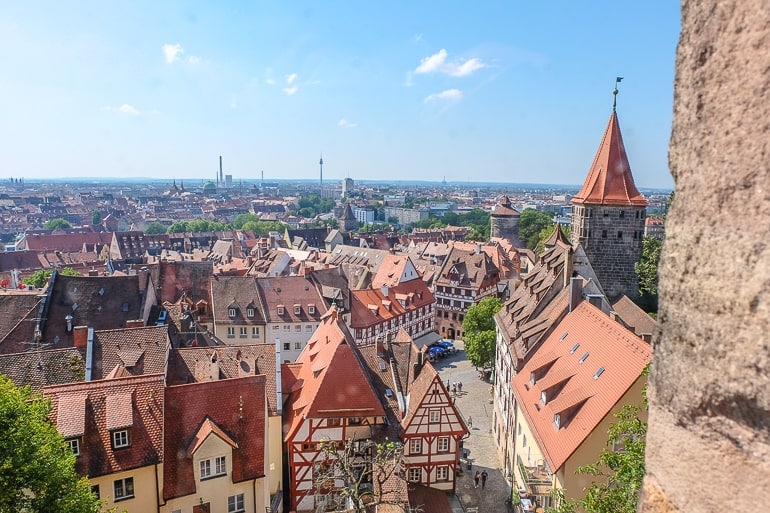
On the third day of this 5 day Southern Germany itinerary you’ll drive – or take the train – from Regensburg to Nuremberg. Nuremberg is a medium sized city in a part of Bavaria called Franconia. If you pay attention, you might notice that the dialect spoken here is quite different from that spoken in Munich and other places farther south.
Lisa actually grew up in this part of Germany so she has been to Nuremberg many, many times. Last year we also went to explore the city together and had a great time. Travellers from abroad mainly know the city for the Nuremberg Trials which took place there after World War II. You can certainly learn alot of history in this German city!
Since Nuremberg is quite close to Regensburg the drive won’t be long – giving you slightly more time to explore the city.
The journey takes approximately 1 hour 10 minutes by car and between 1-2 hours by train depending on which train you take (some stop more often than others). Once again, a regional ticket – such as the Bavaria Ticket – will probably save you some money if you travel with more people.
Accommodation in Nuremberg : Since Nuremberg is a very popular city to visit in Germany, there are many, many places to stay scattered throughout the city centre and around it. You can check here for accommodations and hotels in Nuremberg .
When we visited, we stayed at Five Reasons Hotel and Hostel and we really liked it. Located just inside the medieval city walls, we were really close to the train station and yet also steps from top attractions like the Germanisches Nationalmuseum. The place was bright and great value for the price which we liked a lot.
Close to Five Reasons, we had friends stay at the Sheraton Carlton Nuremberg and they loved it. We actually saw it with our own eyes – it had a pool with views of the city among other perks. There’s also a parking lot right across from the hotel if you’re coming to Nuremberg by car. It’s walking distance to the old centre and the central train station so best of all worlds!
Must-see Attractions in Nuremberg:
- Imperial Castle of Nuremberg (Kaiserburg)
- Documentation Center + Nazi Party Rally Grounds
- Albrecht Dürer’s House
As is the case with Regensburg, we are also still working on our article for Nuremberg. Once it’s live, we’ll link it here.
Day 4: Stuttgart
Stuttgart is the capital of the German state called Baden-Württemberg and the only place on this itinerary that is not located in Bavaria. The city is mainly known for being a “car hub” since both Mercedes-Benz and Porsche have their headquarters there. There are also museums dedicated to both car brands.
Stuttgart is a bit smaller than Munich but there is still a lot to see. In fact, one day won’t be enough to see the whole city – but it’ll allow you to get a good first impression. Next to the car museums, you could visit some of the many green spaces and/or old buildings that the city has to offer.
Driving from Nuremberg to Stuttgart by car will take you approximately 2 hours 15 minutes. If you have the time, you could even take a small detour and stop in Rothenburg ob der Tauber, known for its picturesque Old Town.
By train , the journey from Nuremberg to Stuttgart will take between 2 hrs 10 minutes and 2 hrs 30 minutes – depending on the type of train you are taking. Try to book your ticket in advance if possible as this can save you some money.
Accommodation in Stuttgart: There are many places to stay in Stuttgart – especially in the city centre. You can check here for accommodations and hotels in Stuttgart .
If you’re travelling to Stuttgart with a car, check out the Abalon Hotel ideal . Located very much in the city centre, this popular hotel has an underground parking garage and offers a good breakfast selection.
If you’re travelling to Stuttgart by train, you can check out the Pension am Heusteig . This guesthouse-style accommodation doesn’t have parking but offers a great breakfast and is a doable walk or metro ride from the train station. Funny enough, these two accommodations are very close to one another!
Must-see Attractions in Stuttgart:
- Schlossplatz
- Mercedes-Benz Museum
- Staatsgalerie Stuttgart
Day 5: Munich
On the last day of your trip you’ll make your way back to Munich since it is usually easier to leave Germany through the Munich airport than smaller airports in the surrounding area.
However, if you don’t have to get to an airport – and/or are taking the train home – you could also stay an extra night in Stuttgart if you wanted. Both cities are worth spending an extra few hours in – so you really just have to see what works best for you.
If you decide to get back to Munich, then the journey from Stuttgart to Munich will take approximately 2 hours 20 minutes by car and just slightly less (2 hrs 15 minutes) by train .
Accommodation in Munich : We already went over accommodations in Munich in Day 1 of this itinerary. So, you can head back up for the full details – but we would highly, highly recommend the H2 Hotel München Olympiapark as great value for money with great breakfast, parking, and a metro stop outside the front door.
Don’t forget we also have our detailed guide on where to stay in Munich if you want to have a deeper look at accommodations in the city.
We also have a post on spending one day in Munich if you want more details about the city!
Germany Itinerary 7 Days
If you have slightly more time to explore Germany, we have also created two 7 day Germany itineraries for you. Similar to the 5 day itineraries, we made two different itineraries since it’s pretty much impossible to see the whole country in just a week.
Instead of a northern and southern itinerary, this time we have focused on the western and eastern parts of the country. But please don’t read too much into that description – we use the terms quite loosely. As always, you’re welcome to modify any part of the itinerary to make it better fit your schedule/interests.
Germany Travel Itinerary 7 Days – West
For this itinerary, the total driving time would be around 14 – 15 hours and the distance would be slightly over 1100 km . For these calculations, we included the day trip to Monschau (and back to Cologne) as well as the day trip to Freiburg im Breisgau (and back to Stuttgart), which would be a longer day trip anyway.
So, depending on which day trips you decide to add on to (or remove from) this itinerary, your driving time and distance could be noticeably different than the estimates given above!
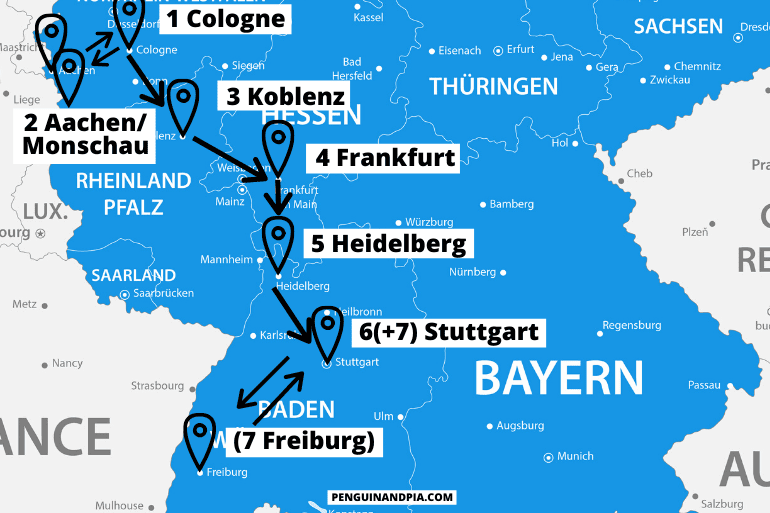
Day 1: Cologne Day 2: Day Trip to Monschau/Aachen Day 3: Koblenz Day 4: Frankfurt Day 5: Heidelberg Day 6: Stuttgart Day 7: Stuttgart / Day Trip to Freiburg im Breisgau
Day 1: Cologne
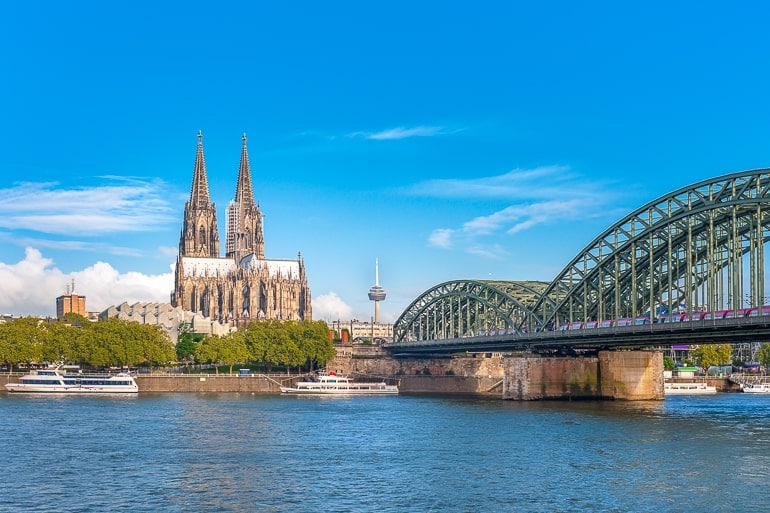
As we have already explained above, we like to start these itineraries in bigger cities to make it easier for people from overseas to get to Germany and start their adventure without hassle. Cologne is Germany’s fourth-biggest city (by population) and has two pretty good airports (Airport “Köln Bonn” and Airport “Düsseldorf”) close by for those coming from far away.
If you want to rent a car for this itinerary, it should be pretty easy to get one in Cologne since it’s quite an international city with lots of visitors.
— Compare prices from rental car companies in Cologne here
Cologne is a pretty spread-out city so you won’t be able to see the whole city in a day or two. However, the highlight of the city is certainly the Cologne Cathedral which is located right next to the central station and the Rhine River.
Make sure to plan some time to visit this impressive building – we always spend much longer in there than we originally plan. It’s free to enter so it can get very crowded depending on the day and time you’re visiting.
Accommodation in Cologne : Cologne is a very big city with multiple areas to stay in. As such, there are lots of accommodation options across the city. Wherever you book, remember to book your accommodation for two nights since you will go on a day trip and then return to Cologne on the second day. You can check here for accommodations and hotels in Cologne .
We have stayed in the Lindner Hotel City Plaza and loved it. The floors all have themes (we got Cologne Zoo with animals), the breakfast buffet is absolutely fantastic, and it’s a short walk to the Cathedral along one main street. There’s also parking available at/near the hotel for those with a car.
If you want to stay more in the heart of the city centre, check out something like the CityClass Hotel Residence am Dom . It’s popular, centrally located with shops and restaurants around, and only a short walk to the train station.
If you are looking for a hostel in Cologne, Eric once stayed at Cologne Downtown Hostel and it was honestly excellent. There’s a grocery store right below it and it’s located in the city centre. It also has a large balcony to enjoy the sunshine from!
Must-see Attractions in Cologne:
- Cologne Cathedral
- Cologne Chocolate Museum
Day 2: Day Trip to Monschau/Aachen
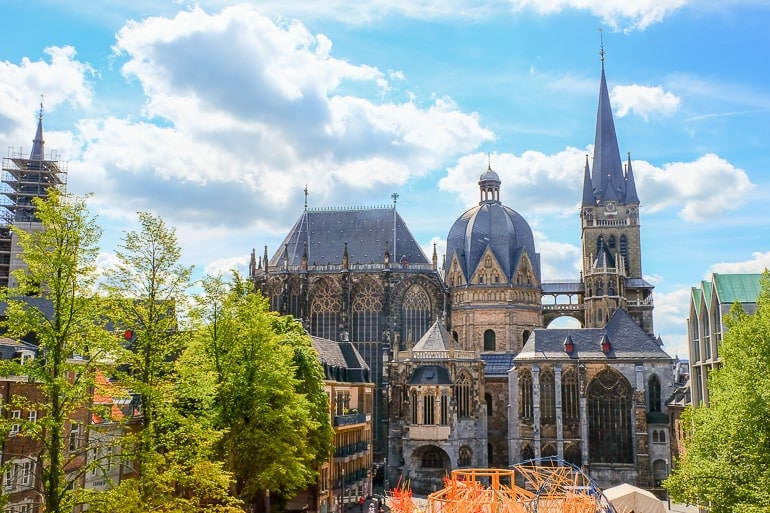
On the second day of this Germany itinerary, you have a few different option: you can either spend another day in Cologne if you feel like you haven’t seen enough of the city yet or take a day trip to Monschau or Aachen. Both of these are two places not too far from Cologne.
Monschau is a popular day trip in the area mainly because of its picturesque buildings in the old town. In fact, you probably have already seen photos of it on social media. To get to Monschau from Cologne, you can either drive or take a combination of trains and buses.
Getting to Monschau takes around 1 hr 40 minutes by car and approx. 2 hours by public transport . To visit Monschau by public transport, you can take the regional train from Cologne to Aachen-Rothe Erde and then take Bus #66 from there to Monschau.
Must-see Attractions in Monschau:
- Monschau Castle
If you want to go on a day trip but don’t want to venture that far, then Aachen would be another great option. This city is actually Germany’s most western city very close to the borders of The Netherlands and Belgium.
We’ve lived close to Aachen for a while and have written a whole guide full of things to do in Aachen that you should read if you want more information. In our opinion, one day is the perfect amount of time to explore the city since it doesn’t have that many attractions and the old town in the city centre is quite compact (but still very pretty).
Getting from Cologne to Aachen is also very easy. It takes approx. 1 hr 20 minutes by car and just around 50 minutes by regional train . You should look into getting a “Schönes Tag Ticket NRW” for the day if you’re travelling with more people as this can save you some money.
Must-see Attractions in Aachen:
- Aachen Cathedral
- Elisenbrunnen
Day 3: Koblenz
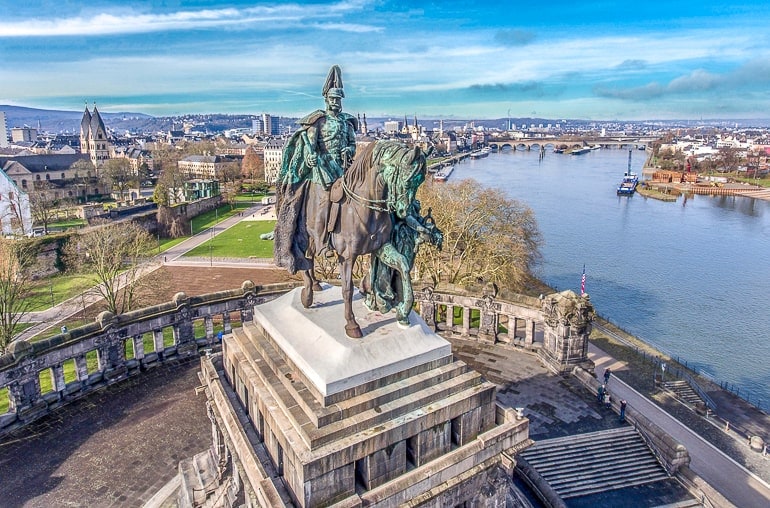
From Cologne, your journey continues to Koblenz – another city on the Rhine River. Koblenz is a smaller German city with a population of slightly over 110,000 inhabitants.
There are quite a few castles and nice hikes in the area which are easy to reach from Koblenz – just in case you decide that you don’t want to spend the day in the city. Depending on the time of year, you could also look into booking a boat tour on the Rhine river. This way, you get a unique perspective of the beautiful region.
Getting from Cologne to Koblenz is pretty easy and will take approximately 1 hour 30 minutes by car and between 50 minutes and 1 hr 10 minutes by train . We really like this train journey since the tracks follow the river for a majority of the trip. As a result, you get some really nice views – and might even spot some of the beautiful castles in the area!
Accommodation in Koblenz: Koblenz is certainly not a huge city – but you’ll still find a good number of places to stay for a night or two. You can check here for accommodations and hotels in Koblenz .
For a hotel right in the city centre, check out the Sander Hotel . This lovely hotel is super popular and close to shops and the rivers. If you are arriving to Koblenz by car, there is onsite parking at the hotel. However, since the city is smaller you can also easily reach the hotel by walking from the central train station.
Must-see Attractions in Koblenz:
- Deutsches Eck
- Ehrenbreitstein Fortress
- Koblenz Cable Car
Day 4: Frankfurt
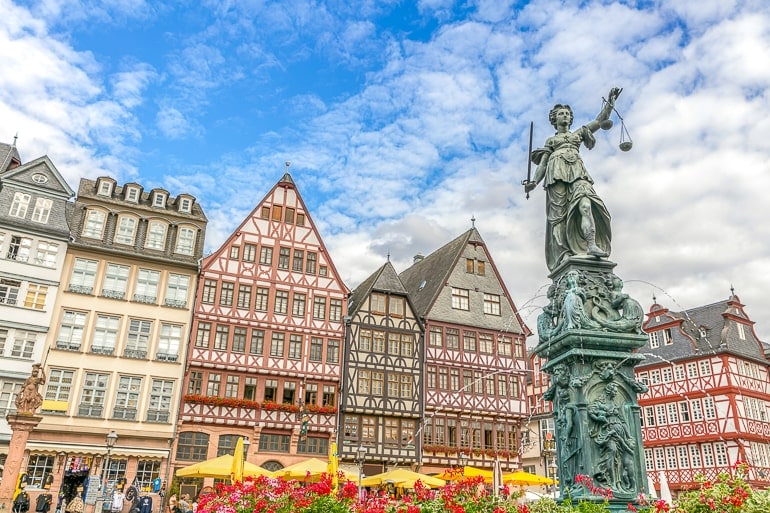
The next stop on your itinerary is Frankfurt, arguably one of the country’s most popular transport hubs due to the busy Frankfurt airport. Frankfurt is an interesting city that divided people: some people really enjoy it while other people don’t like it at all. To be fair, we haven’t spent enough time in the city to really solidify our opinion.
Either way, we do believe that Frankfurt is a stop that you shouldn’t miss if you are trying to get to know different areas of Germany. Known as the financial hub of Germany, this city with its many skyscrapers can feel quite a bit more modern than other German cities. However, the city also has a beautiful, historical market square that you should visit.
The journey from Koblenz to Frankfurt is another easy one – and if you are taking the train (we would recommend that!), you’ll once again follow the Rhine River for big parts of the journey and be rewarded with some great views.
The train ride will probably be between 1 hr 25 minutes and 2 hrs 12 minutes long – depending on the connection you choose. By car , the trip will take around 1 hr 30 minutes . Of course, this can vary depending on traffic.
Accommodation in Frankfurt : There are loads of places to stay in Frankfurt given its popularity and size. You can check here for accommodations and hotels in Frankfurt .
A great option in Frankfurt is the Motel One Frankfurt-Römer . Located very much in the heart of the city centre close to the old town and river, this cool hotel has underground parking if you are arriving to Frankfurt by/with a car. It also serves up a great breakfast!
If you are arriving by train to Frankfurt, you should check out Fleming’s Express Hotel Frankfurt . Located literally right beside the central station (which is in the city centre), this upscale hotel is very popular because it’s very affordable and also has a great breakfast.
Must-see Attractions in Frankfurt:
- Palmengarten
Day 5: Heidelberg
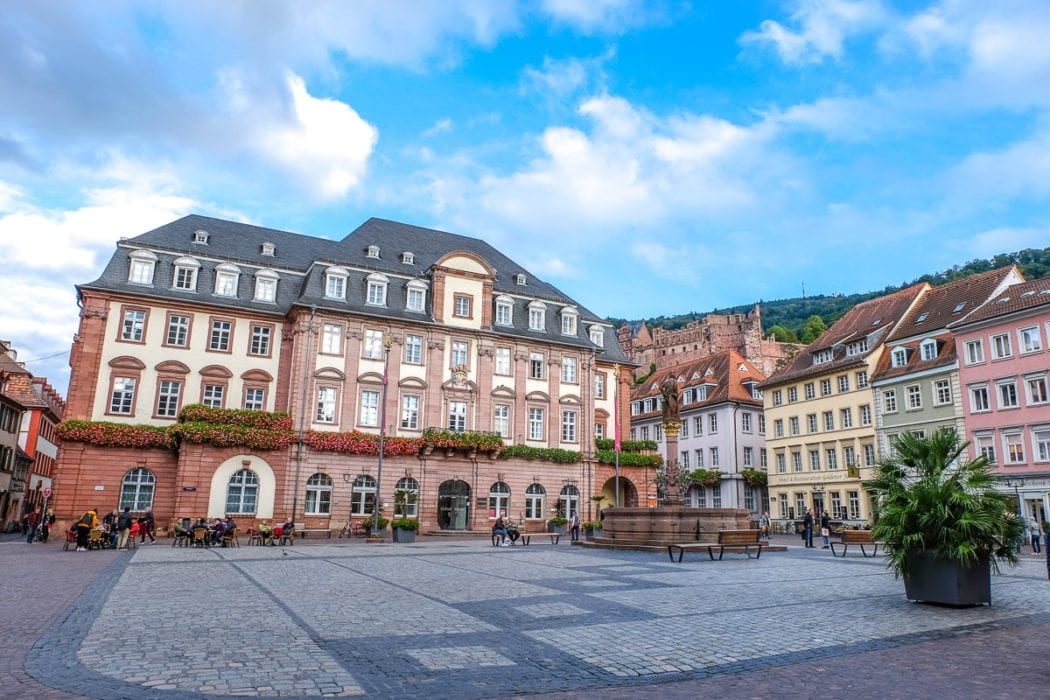
After your day in Frankfurt, you’re heading to Heidelberg which is actually one of our favourite German cities. The highlight of the city is certainly the castle on top of the hill which is visible from many different parts of the city.
Heidelberg is smaller than Frankfurt so you can see quite a bit in just 24 hours. The Old Town is beautiful and lots of attractions are located there. Our highlight was probably the tower climb of the Church of the Holy Spirit. From up there, you get a beautiful view of the Old Town. A very close second was the cable car ride up to the Königstuhl which was lots of fun – even in the rain.
Getting from Frankfurt to Heidelberg won’t take too long. The journey will be approximately one hour by car and between 45 minutes and 1 hr 30 minutes by train – depending on which type of train you are taking.
Accommodation in Heidelberg: If you’re heading for Heidelberg (good choice), there are lots of great places to stay. You can check here for hotels and accommodations in Heidelberg .
We stayed a little outside the old town – but close to the train station – at NinetyNine Heidelberg City . This hotel was really, really great. The beds were comfy and the decor has animals everywhere – you have to see it to understand!
There’s onsite parking (paid) and street parking (free, but not guaranteed) if you are travelling with a car. There’s also a tram stop right outside the hotel to get directly into the city centre in minutes.
If you are looking to stay in the historic old town, then check out colourful hotels like Hotel Holländer Hof which overlooks the river or Hotel Zum Ritter St.Georg which is literally overlooking the main Marktplatz.
Must-see Attractions in Heidelberg:
- Heidelberg Palace
- Church of the Holy Spirit (mainly tower climb)
If you want to learn some more about Heidelberg and what there is to do, you can read our detailed Heidelberg Guide here .
Day 6: Stuttgart
The next day you will drive to Stuttgart, a city that we’ve already mentioned in one of our Germany itineraries for 5 days. As we have already mentioned, you’ll probably really enjoy Stuttgart if you are interested in cars.
Even if you aren’t, there is still lots for you to explore. Did you know that wine also plays a huge role in Stuttgart and the surrounding region? If this is something that interests you and you’re there in the summer (specifically around the end of August), then you should stop by the “Stuttgarter Weindorf” (“wine village”) – but obviously, please don’t drink and drive.
As for getting from Heidelberg to Stuttgart, the journey will take you approximately 1 hr 20 minutes by car and between 40 minutes and 1 hr 30 minutes by train . As mentioned before, the time differs depending on the type of train you are choosing.
Accommodation in Stuttgart: Stuttgart has many places to stay so you can check here for accommodations and hotels in Stuttgart .
Be sure to see the Abalon Hotel ideal if you have a car. This hotel has underground parking available and a tasty breakfast. It’s also in the city centre which makes sightseeing easy.
Those coming to Stuttgart by train should look at the Pension am Heusteig . It’s a guesthouse that is located not too far from the first hotel here and it’s a doable walk or metro ride from the central station.
Day 7: Stuttgart / Day Trip to Freiburg im Breisgau
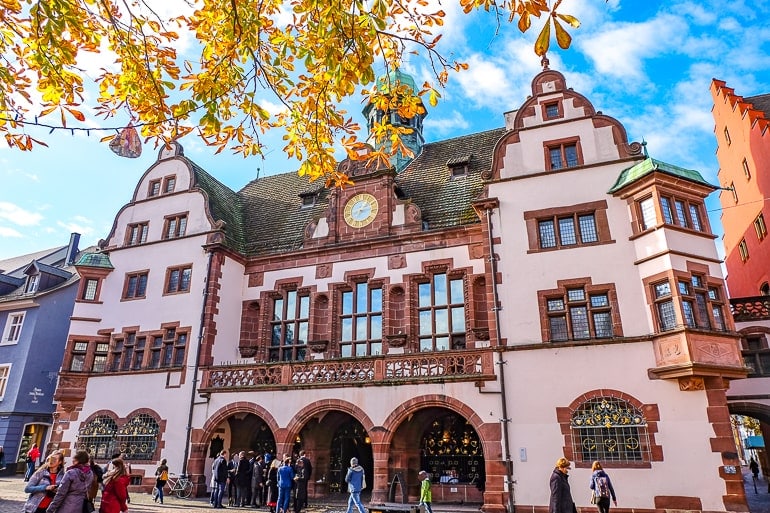
For this itinerary, you can decide how you would like to spend your last day. You could either spend another day to explore more of Stuttgart (and maybe relax for a bit) or you could head farther south and spend a day in Freiburg im Breisgau. We really enjoyed spending time in this small city in the south of Germany during our visit.
We are currently still in the process of writing our Freiburg guide, but we’ll link it here once it’s done. However, a good way to start your exploration of the city is by wandering the old town.
In Freiburg, you’ll find that many of the cobblestoney streets have small water-filled runnels – called Bächle – running alongside it. Sometimes they even have small yellow ducks in them!
The journey from Stuttgart to Freiburg im Breisgau is slightly longer than most other parts of this itinerary. It takes approximately 2 hrs 30 minutes by car and around 2 hours by train . Since this train journey will probably include at least one ICE (the fast train), we’d recommend that you book your train tickets early if you can to save some money.
Must-see Attractions in Freiburg:
- Freiburger Münster (Cathedral)
- Schlossberg + Tower
- New + Old Town Hall
Germany Travel Itinerary 7 Days – East
If the other week-long Germany itinerary doesn’t interest you and/or you really want to visit the German capital Berlin, then you might prefer this eastern route instead.
The driving time would be just slightly over 10 hours and would be approximately 900 km driving distance – including the day trip to Potsdam (which would honestly be easier with public transport, though)!
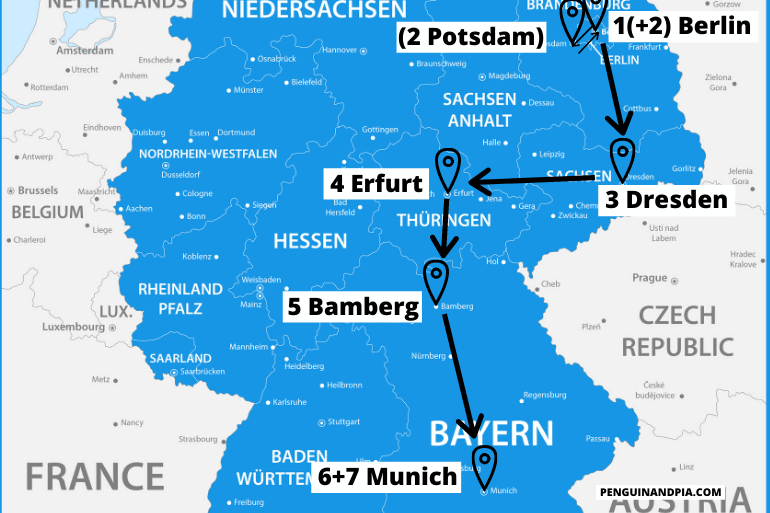
Day 1: Berlin Day 2: Berlin / Day Trip to Potsdam Day 3: Dresden Day 4: Erfurt Day 5: Bamberg Day 6+7: Munich
Day 1: Berlin
Once again, this itinerary begins in Berlin since it is one of the big cities that is easier to get to for people coming from overseas. Similar to the five day itinerary that started in Berlin, you’ll stay two nights in the German capital. There is just too much to see to spend only one day – and even in two days you wouldn’t be able to explore everything.
In case you’ve already been to Berlin on a different trip and/or aren’t a huge fan of big cities, we also give you the option of a day trip to Potsdam (a city close by) on the second day. More on that below.
Accommodation in Berlin : Finding a place to stay in Berlin can be tough because there are just so many options. You can check here for accommodations and hotels in Berlin .
If you have a car, check out Park Plaza Wallstreet Berlin Mitte . Located right in the middle of the city close to Museum Island, this hotel has a great breakfast and free parking on the street behind the hotel. Otherwise, parking is paid but for a decent price for the city centre.
Those without a car travelling by train should see the NH Collection Berlin Mitte am Checkpoint Charlie . If you want a hotel close to a top attraction that is easy to get to with public transport, this is definitely one of them!
Across the city, PLUS Berlin is a really good hostel/hotel that Eric stayed at a few years ago. It’s a big place but it was a great stay over by the East Side Gallery (part of the Berlin Wall with the graffiti on it).
As already mentioned above, if you want to read some more about Berlin, check out our articles on Things to do in Berlin and How to spend one day in Berlin .
Day 2: Berlin / Day Trip to Potsdam
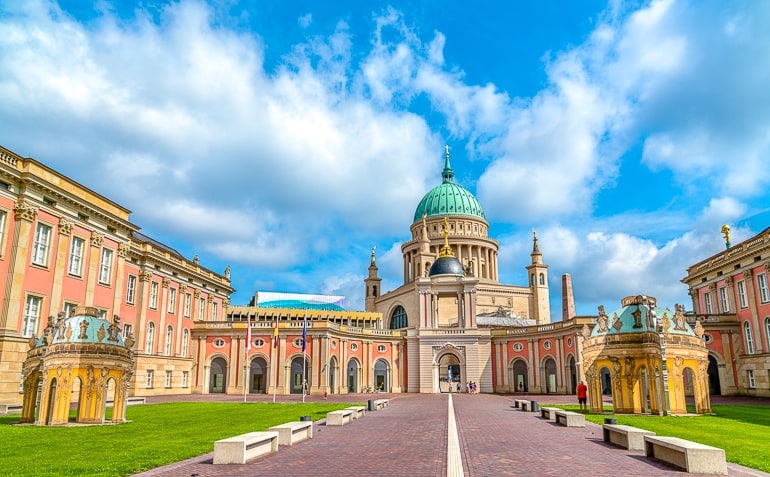
On your second day, you can choose between spending another day in Berlin to see more of the German capital or going on a day trip to Potsdam – which is a smaller city not far from Berlin.
Potsdam is actually the capital city of the German state called Brandenburg. It’s most popular attraction is probably Sanssouci Palace with the beautiful Sanssouci Park surrounding it.
During our visit, we also enjoyed walking through the Dutch Quarter with its small shops and cafes. Since the city isn’t too big, one day gives you a chance to get a good impression and check out some of the more popular sights.
It is also very easy to get to Potsdam from Berlin. If you decide to drive , it’ll take you approx. 40 minutes , but it could be longer – traffic depending. We would honestly recommend that you do this day trip by taking public transport. This way, you don’t have to worry about traffic and/or finding a parking spot.
For trains, you can take the S-Train #7 (S7) from Berlin Central Station (as well as other train stations) straight to Potsdam Central Station. The journey will take around 35 minutes with trains running very frequently throughout the day.
Must-see Attractions in Potsdam:
- Sanssouci Palace
- Dutch Quarter
- Cecilienhof
Day 3: Dresden
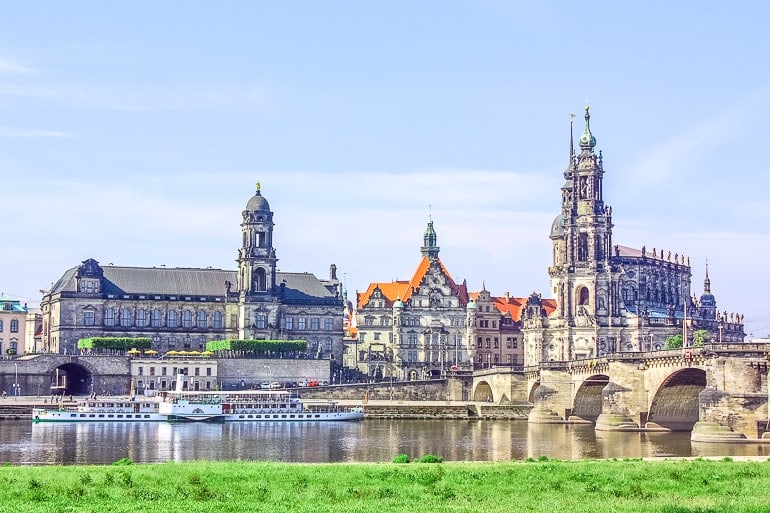
The third day of this Germany itinerary will take you from Berlin to Dresden which is a German city close to the Czech border. To be honest, we haven’t spend that much time in Dresden yet – and it’s certainly on our list of places to visit this year.
One of the city’s main attractions – the Zwinger – is known across the country and a sight that you shouldn’t miss during your visit. It’s a beautiful palace built in a baroque style.
Fun fact: When Lisa was a kid, she didn’t actually know that the “Zwinger” was a palace. Since that word can also mean “dog kennel” in German, she was always confused as to why people would want to visit it during their time in Dresden!
As for getting from Berlin to Dresden, the drive will take you around 2 hrs 10 minutes by car and around 2 – 3 hours by train. Once again, this depends on which connection you choose.
Accommodation in Dresden: There are a number of accommodations in the compact “Innere Altstadt” close to the River Elbe for you to choose from. You can check here for accommodations and hotels in Dresden .
For a great hotel option right in the old town, look no further than the Star Inn Hotel Premium Dresden im Haus Altmarkt . You’re a short walk to the train station, the river, and all the best old sights in Dresden if you stay here and arrive by train. If you come to Dresden by car, the hotel has discounted underground parking available.
Another option right in the old town (and even closer to the river) is Aparthotel am Schloss . Since this is an apartment-style hotel, it’s a great option if you are looking for more of a base to relax in a “home away from home”. It’s a very popular choice, too – and also has onsite parking.
Must-see Attractions in Dresden:
- Frauenkirche
Day 4: Erfurt
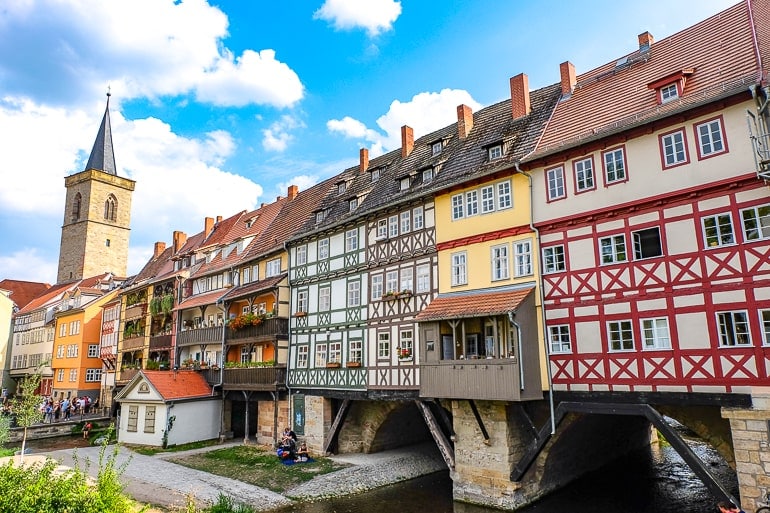
Erfurt is a popular city to visit in the middle of Germany – and it’s also the capital city of the German state Thuringia. We’ve spent some time in Erfurt a few months ago and instantly fell in love with the city. Its size is perfect (in our opinion) – giving you enough things to do without feeling overwhelming.
Maybe you’ve seen photos of one of the city’s most popular attractions, the Krämerbrücke. This bridge is not only pretty to look at and photograph, it’s also unique in the sense that there are buildings on the bridge and when you’re walking on it, you can’t actually see the water running below.
Visiting the bridge and climbing the tower of the Ägidienkirche, a church at one end of the bridge, is something we’d certainly recommend during your time in the city. We actually filmed a short video of our time exploring Erfurt. If you are interested in seeing what parts of the city look like, then you can find our video here .
Getting to Erfurt from Dresden won’t take you too long. It will take approx. 2 hours 20 minutes by car and between 2 and slightly over 3 hours by train .
Accommodation in Erfurt: Since Erfurt isn’t a huge city, there aren’t a ton of accommodations – but certainly more than enough to find one that works for your style and budget. You can check here for hotels and accommodations in Erfurt .
We stayed at Gästehaus in der Gotthardtstraße and really liked our stay. It’s located in a quiet neighbourhood just north of the city centre – a short walk to the Krämerbrücke. The host was lovely, the room was cozy, and there was secure onsite parking for those driving to Erfurt.
If you want to stay RIGHT in the city centre then you should check out Hotel Krämerbrücke Erfurt which is right beside the famous bridge. This might be a good place to stay if you are travelling to Erfurt by train and you’re on-foot.
Must-see Attractions in Erfurt:
- Krämerbrücke
- Erfurt Cathedral
- Citadel Petersberg
For more details, have a look at our Things to do in Erfurt article .
Day 5: Bamberg

Bamberg is a small city – or larger town – in the German state called Bavaria. It’s actually located in a region called Franconia, which is noticeably different from the Bavaria that you might know in the area surrounding Munich, etc.
We’ve been to Bamberg multiple times over the years (it’s also close to the part of Germany where Lisa grew up) and are always happy to come back. Bamberg is known for its cute, historic old town which is actually a declared UNESCO World Heritage Site.
One of the most popular buildings the city has to offer is the Old Town Hall (shown above) which is built on an artificial island. The story behind it is quite interesting.
The drive from Erfurt to Bamberg is doable and will take approx. 2 hrs by car and around 3 hrs by train . On the way, you’ll drive through quite a few tunnels since you’ll drive through an area known as “Thuringian Forest”.
Accommodation in Bamberg: Bamberg is a small place to visit so there aren’t a ton of options but still enough to find what you’re looking for. You can check here for accommodations and hotels in Bamberg .
Anywhere you stay is basically in or close to the old town/city centre. For a place to stay with parking (for those arriving by car), check out Welcome Hotel Residenzschloss Bamberg . It’s located right on the river.
You might also want to see Palais Schrottenberg to stay right in the middle of the Old Town! For reference, the train station is a short walk to the north of the river – not far from these places in the centre.
Must-see Attractions in Bamberg:
- Bamberg Cathedral
- Old Town Hall
- Alte Hofhaltung
If you want some more information about Bamberg, please read our detailed Bamberg, Germany Guide .
Day 6+7: Munich
From Bamberg, your journey will continue to Munich which will be the last stop on this 7 day eastern itinerary. Not only is this the third biggest city of the country, it is also one of the most internationally known destinations in Germany.
Whenever we come back to Munich, we always enjoy our time there. For some reason, the atmosphere always feels more laid back than in other big German cities and the people are usually quite friendly. We might also be a little bit biased, though, since Lisa grew up in this part of the country and is more used to the mentality, dialect etc. than in other parts of Germany.
For this itinerary, you’ll spend two days in Munich since there is quite a lot to see. Next to the obvious attractions like the Marienplatz with the New Town Hall and the Frauenkirche close by, there are also lots of museums and other things that you can explore.
If you’ve already been to Munich before and/or decide that one day in the city is enough for you, you could also opt for a day trip on one of these days. We’ve just recently written a whole Day Trips from Munich Guide , which you can browse through to get some inspiration!
Driving from Bamberg to Munich will take about 2 hrs 20 minutes by car and between 2 and 3 hrs by train . If you decide to only take regional trains instead of the ICE (fast train), you should look into getting the Bayernticket. This can save you some money, especially when you’re travelling with more people.
Accommodation in Munich: Since Munich is so large and popular to visit, there is definitely no shortage of places to stay! You can check here for accommodations and hotels in Munich .
That said, we loved our stay at H2 Hotel München Olympiapark . Located up by the famous Olympic Park, we’d highly recommend it since it was amazing value for money. The breakfast was huge and delicious and there’s a metro station outside the lobby door that takes you into the heart of the old town in minutes. There’s also parking if you are arriving by car.
For a hotel that is a little more central, you should see the Platzl Hotel Superior this hotel is really popular – and for good reason. It’s located around the corner from attractions like Marienplatz and the famous beer hall, Hofbräuhaus.
For more help looking into accommodations and neighbourhoods in Munich, check out our where to stay in Munich guide .
(Check out our guide to one day in Munich if you want more details on things to do and see.)
Germany Itinerary 10 Days
Although we have tried to create short itineraries that allow you to see more than just the standard cities, it is no doubt easier to see more of Germany if you are able to travel for longer than one week. To give you a couple different options that you could look at (and then potentially modify), we have created two 10-day Germany itineraries.
Once again, we believe that ten days would not be enough time to see the whole country – and even if you managed to do that it would be too stressful (in our opinion). Both of the following itineraries give you a good mix of bigger and smaller cities as well as a few interesting day trips. So, have a look and see which one you like better!
Germany Itinerary 10 Days – North
If you’re interested in seeing more of the northern part of Germany and experiencing the mentality and way of life of people in the flatter part of the country, closer to the sea, then have a look at the following 10-day itinerary!
The total driving time would be slightly less than 17 hours with a distance of approx. 1470 kilometres. For these calculations, we have included the day trips to Schloss Drachenburg, Lübeck, and Flensburg. So, if you decide to skip any of these, your driving time and distance would obviously be slightly lower.
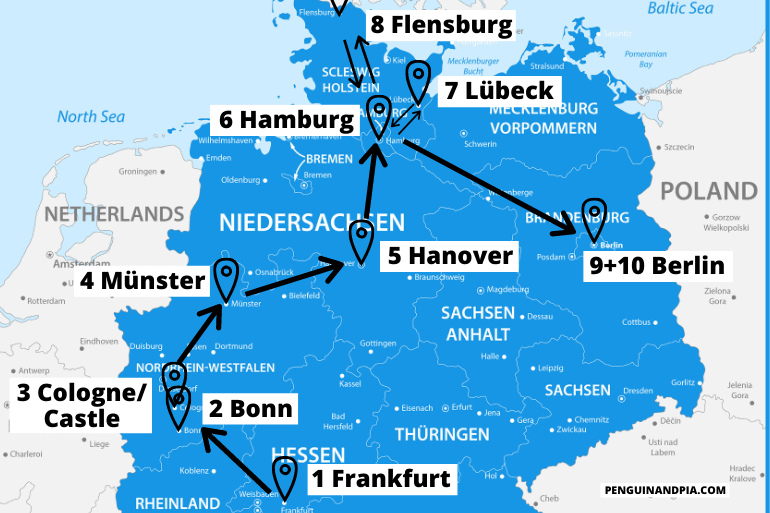
Day 1: Frankfurt Day 2: Bonn Day 3: Day Trip to Schloss Drachenburg / Cologne Day 4: Münster Day 5: Hanover Day 6: Hamburg Day 7: Day Trip to Lübeck Day 8: Day Trip to Flensburg Day 9+10: Berlin
Day 1: Frankfurt
Similar to some of the other itineraries mentioned in this article, we start this 10-day itinerary in Frankfurt. By now you should probably already know why – Frankfurt has the biggest airport of the country which should make it easier for people coming from overseas to get to Germany and start their adventure.
Furthermore, Frankfurt is quite centrally located so it is easy to get to many different cities from here. So even if you decide against following our itineraries step-by-step, Frankfurt would be a good starting point!
— Compare prices from rental car companies in Frankfurt here
Accommodation in Frankfurt : You’ll find plenty of places to stay in Frankfurt. You can check here for accommodations and hotels in Frankfurt .
One really popular hotel in Frankfurt is the Motel One Frankfurt-Römer . This Motel One is near the river and walking distance to lots of things in the city centre. If you are coming to Frankfurt with a car, Motel One has underground parking which can make life easy! They also have a nice breakfast.
A hotel option closer to the train station is Fleming’s Express Hotel Frankfurt . This hotel is just to the north of the main station which makes it a great option if you are arriving by train and have no car. It’s popular because it has a great breakfast and is good value for money.
Day 2: Bonn
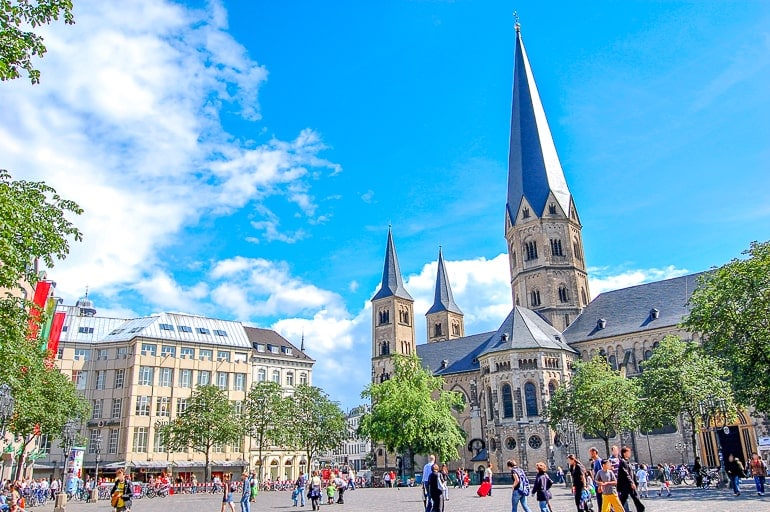
On the second day, you’ll head from Frankfurt to Bonn. As you might know, Bonn used to be the capital of the Federal Republic of Germany during the time that Germany was split into two countries. Later, the capital was relocated from Bonn to Berlin.
If you are interested in learning more about the history of Germany during your time in the country, then Bonn would be a good city to do that in. For example, you could visit the so-called “Haus der Geschichte” which is a museum about the history of the Federal Republic of Germany.
It won’t be difficult to get from Frankfurt to Bonn since the two cities are not too far apart. The journey will take approximately 1 hr 50 minutes by car and between 1 hr 20 minutes and 2 hrs if you take the train . Once again, we’d recommend that you book your train ticket in advance if possible.
Accommodation in Bonn: There are a number of accommodation options in Bonn which you can choose from – many are right in the city centre/old town. You can check here for accommodations and hotels in Bonn .
Keep in mind to book your accommodation for two nights for this itinerary. (You could also spend the following night in Cologne if you day tripped to there, though).
For a great hotel in the heart of the old town, check out BrauHotel Bonn . You can easily walk here from the central train station but they also have a and parking garage close by if you arrive by car. There’s also a craft beer bar on the ground floor!
Another option is the Hilton Bonn . This hotel offers you amazing views of the Rhine River. It’s a bit north of the city centre but still very much close to it. There is parking but it can be expensive so keep that in mind when you book.
Must-see Attractions in Bonn:
- Bonn Minster
- House of the History of the Federal Republic of Germany (Haus der Geschichte)
Day 3: Day Trip to Schloss Drachenburg / Cologne
On day three of this itinerary, you can choose to stay in Bonn, or go on one of two day trips: to Schloss Drachenburg (a castle not far from Bonn) or to Cologne which is also close by.
Schloss Drachenburg is actually a private villa/mansion that was built to look like a castle in the 19th century. Today, it is a popular attraction in the area.
From Bonn, you can either drive to Königswinter by car (and then leave your car at the car park) or take public transport to the Königswinter/Clemens-August-Straße station. You can find more information about that and opening hours etc. on the offical website .
If you are not a huge fan of castles, then you might opt for a day trip to Cologne instead. In this case, you might even decide to change your base and spend the night in Cologne instead of returning to Bonn at the end of the day. That is definitely an option that you can choose since there are lots of accommodation options in Cologne as well.
Getting to Cologne from Bonn will take you around 40 minutes by car (this can obviously depend on traffic) and only approx. 25 minutes by train . Just a quick warning: Trains can get very full if you are travelling during rush hour traffic – so try to avoid that if you don’t like being surrounded by lots of people in a small space.
Day 4: Münster
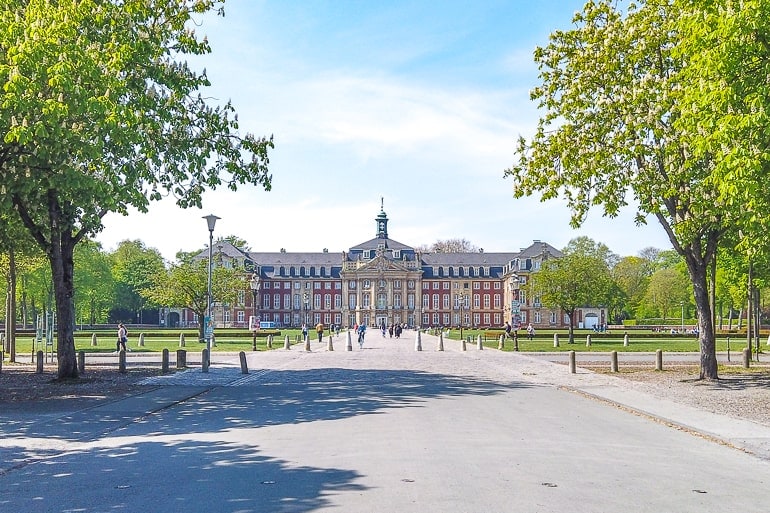
The next day you’ll head from Bonn – or Cologne – to Münster. Since Bonn and Cologne are so close, the journey wouldn’t really differ much from either city.
Münster is a smaller German city that we really enjoy. To be honest, it sometimes reminds Lisa of Copenhagen – mainly because of the many bikes that you can see all around the city. The University of Münster plays a big role in the city and the vibe – depending on which part of the city you are in – is noticeably younger.
One of the highlights of the city – for locals and visitors alike – is the lake Aasee which is located quite centrally. When the weather is nice, there are always people sitting on the grass enjoying the sun and maybe even out on the water (depending on the time of year). You can rent a small paddle boat to explore the lake from a unique perspective.
The journey from Bonn to Münster should take you slightly less than 2 hrs by car and between 2 hrs and slightly more than 3 hrs by train . If you want to save some money and are travelling with other people, then you should look into getting an “NRW Schönes Tag Ticket”. With this ticket, you wouldn’t be allowed to travel on ICE’s (the fast train), but the connections using only regional trains wouldn’t be much longer.
Accommodation in Münster: Münster might feel small but it’s actually pretty spread out and offers accommodations for all styles and budgets. You can check here for accommodations and hotels in Münster .
If you want a popular hotel option right in the centre, the H4 Hotel Münster is a short walk to the heart of the historic centre. It also has onsite parking for those travelling to Münster by car – but you can easily walk there from the train station in the south of the city centre.
Must-see Attractions in Münster:
- Münster Prinzipalmarkt
- Historic Town Hall
- Münster Cathedral
For a more detailed guide, have a look at our Things to do in Münster, Germany article .
Day 5: Hanover
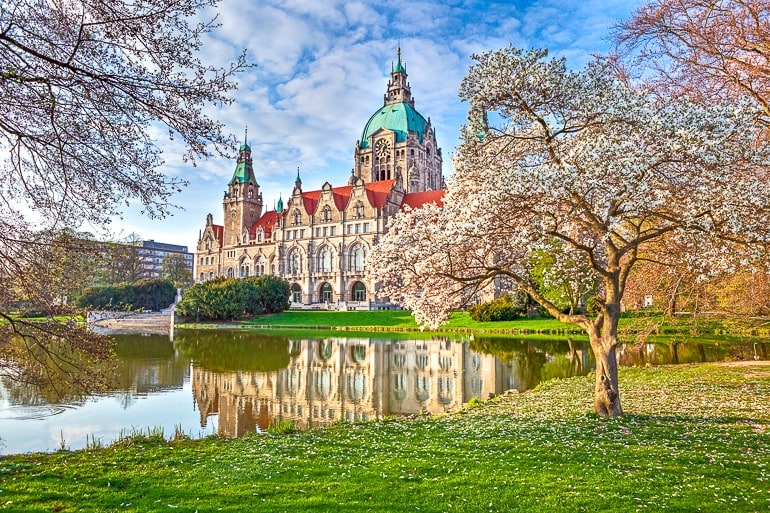
The following day you are travelling from Münster to Hanover. In German “Hannover” is actually written with two “n”, so don’t be surprised if you see it being written slightly differently.
Hanover is the biggest city and the capital of the German state called Lower Saxony. Compared to some other cities on this itinerary it is a less popular tourist destination. To be fair, even we haven’t spent that much time in Hanover yet. Hopefully we’ll be able to change that soon. However, that’s not to say that Hanover is not worth a visit.
Not only can you explore some beautiful gardens and interesting museums in the city, but it is also located pretty much halfway between Münster and Hamburg. That makes it a great stop to break up the journey and spent another day in a city that allows you to explore without too many other (international) tourists around.
By car , the journey from Münster to Hanover will take you around 2 hrs . If you choose to travel by train instead, it will take you approximately the same amount of time .
Accommodation in Hanover: Hanover is a larger city but the accommodation are still relatively packed together in and around the historic city centre. You can check here for accommodations and hotels in Hanover .
For a stay right in the city centre, check out the Hotel Loccumer Hof . This popular hotel is a very short walk from the central station which is perfect if you are arriving to Hanover by train. That said, they also have parking onsite so this hotel works well if you arrive by car!
For another hotel option, check out the Arthotel ANA Prestige am neuen Rathaus . This boutique hotel is directly across from the beautiful New Town Hall in the south end of the city centre by the greenspace and water! They also have a really nice breakfast and parking available.
Must-see Attractions in Hanover:
- New Town Hall
- Marktkirche
- Herrenhausen Gardens
Day 6: Hamburg
On day six of this 10-day itinerary you’re on your way to Hamburg. If you’ve read the details of any of the shorter itineraries in this article, you’ll know that we really like Hamburg.
The city offers modern areas, such as “HafenCity”, mixed with historic (e.g. “Speicherstadt”) and alternative areas (“Sternschanze”) . This makes exploring the city all the more interesting – there is truly something for everyone. During your time in the city, we’d also recommend that you climb the tower of the St. Michael’s Church. From up there, you get a beautiful view of most parts of the city.
The journey from Hanover to Hamburg won’t be long. Depending on the route you are taking (Highway A7 or A1), it’ll take between 1 hr 30 minutes and 2 hrs by car . If you opt for the train , you can expect the journey to take between 1 hr 15 minutes and 1 hr 30 minutes . This depends on the connection you choose.
Accommodation in Hamburg : Hamburg has many, many places to stay. You can check here for accommodations and hotels in Hamburg .
The Mövenpick Hotel Hamburg might be a good option if you have a car while you travel around Germany. This cool hotel is inside an old water tower which gives guests stunning views of the city around. There’s also parking onsite and it’s close to a transit stop for getting around the city.
Located not too far from the central train station, ARCOTEL Rubin Hamburg makes for a good hotel option if you don’t have a car. It’s located in St. Georg which is a lively area within walking distance of the city centre.
Those that need hostel for their stay in Hamburg might be happy with Generator Hamburg . It’s a popular hostel in the city and is close to the train station for easy getting around. If you’re unsure about where to stay, you can always check out our detailed guide on where to stay in Hamburg .
Once again, if you’d like to read our (very) short Hamburg guide, you can find our Things to do in Hamburg article here .
Day 7: Day Trip to Lübeck
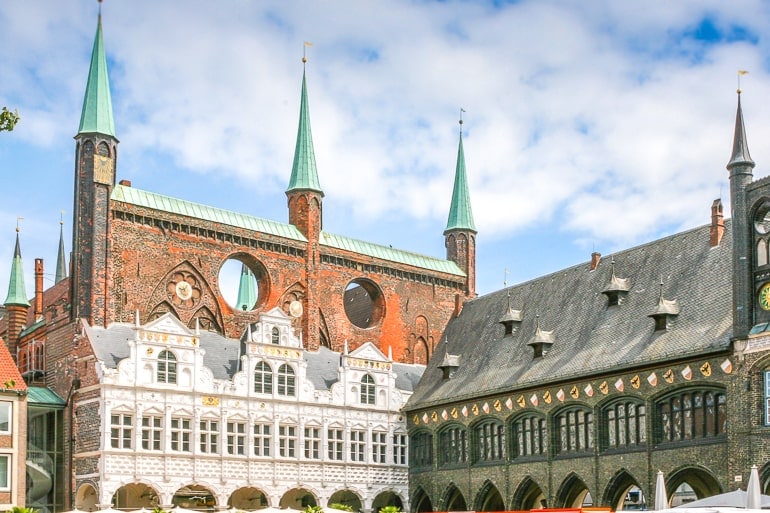
For the next couple of days, we decided to include some day trips from Hamburg. This allows you to stay in one accommodation for longer than just one night and gives you the option to see some more of Hamburg as well. If you don’t want to visit any other cities and want to spend more time in Hamburg instead, then feel free to skip one or both of the day trips mentioned.
Lübeck is the closer one of the two day trips mentioned from Hamburg. Within Germany the city is mainly known for its delicious “Lübecker Marzipan” (Lübeck Marzipan) – but of course there is much more to the city than just that. One of the highlights is the Holsentor, a red-brick city gate dating back to the 15th century.
The journey from Hamburg to Lübeck will take you slightly over 1 hr by car and just around 45 minutes by train . In our opinion, that’s great for a day trip since it gives you lots of time to actually see the city instead of spending a lot of time in the car/on the train.
Must-see Attractions in Lübeck:
- Marienkirche
- Heilig-Geist-Hospital
Day 8: Day Trip to Flensburg
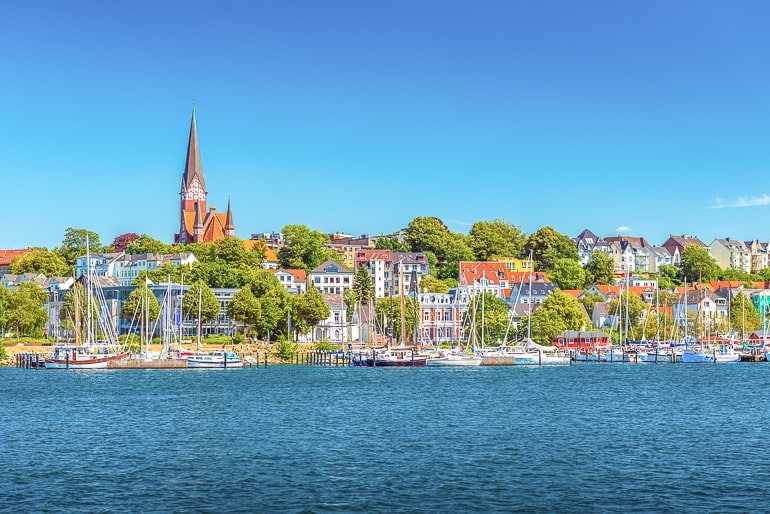
For the following day, we have another day trip option for you. The journey to Flensburg is slightly longer than to Lübeck – but it would be worth it. Flensburg is a smaller German city in the north of Germany, very close to the Danish border.
Since it is located close to the water, shipping plays an important role in the city to this day. If you’re interested in learning more about that, then the Maritime Museum would be a good place for you to visit.
Another thing we would recommend is a walk along the Rote Straße. Here you’ll find different “Hinterhöfe” (similar to backyards) with cute cafes and small shops.
Getting to Flensburg from Hamburg should take slightly less than 2 hrs by car and the same amount of time by train . As already mentioned, it would be a longer journey than to Lübeck, but if you want to experience a smaller, maritime city, the trip would be worth it!
Must-see Attractions in Flensburg:
- Historischer Hafen (Historic Harbour)
- Flensburger Schifffahrtmuseum (Maritime museum)
- Museumsberg Flensburg
Day 9+10: Berlin
On the second to last day of this itinerary, you’ll head from Hamburg to Berlin where your journey ends. This allows you to spend two days in the German capital. Since there is so much to do in Berlin, we’d recommend that you do some research beforehand to narrow down which attractions you’d like to visit.
If you’ve never been to Berlin before classics like the Brandeburg Gate and the Reichstag would be a good place to start. We’ve written a few different articles about Berlin – one about classic attractions (link below). Maybe these will be a good starting point to gather some more information!
The drive from Hamburg to Berlin will be one of the longest mentioned as part of this itinerary – so you should keep that in mind. It’ll take approximately 3 hrs 20 minutes by car (with traffic it could be longer), but just 1 hr 50 minutes by train .
It’s a popular train route since it connects the two biggest German cities so trains run frequently throughout the day. Once again, we’d recommend to book your train ticket in advance to get one of the discount tickets and save some money.
Accommodation in Berlin : As the capital city, there are lots of accommodation options for Berlin. You can check here for accommodations and hotels in Berlin .
Those travelling to Berlin with a car should look into the Park Plaza Wallstreet Berlin Mitte for a hotel in the city centre with free street parking available. There’s always paid parking for a reasonable fee if those are full and you’ll be close to top attractions.
The NH Collection Berlin Mitte am Checkpoint Charlie is a popular hotel option for those coming to Berlin by train since it’s close to attractions in the city centre and you can get there very easily with the metro.
Finally, if you need a hostel/hotel, check out PLUS Berlin . This is where Eric stayed a few years back and really enjoyed it. You’ll be close to the East Side Gallery – the part of the Berlin wall with the artwork on it. It’s also easy to get in and out of the city centre from here.
Also feel free to have a look at our guide on Berlin Attractions and tips for a day in Berlin .
Germany Itinerary 10 Days – South
This 10 day Germany itinerary begins and ends in Frankfurt – so it’s pretty much a small loop through the southern part of the country. If you want to be closer to the mountains (for part of the trip at least) instead of the sea, then this itinerary might be better suited for you than the other 10 day version.
For this itinerary, the total driving time would be slightly over 17 hours with a total distance of approx. 1330 kilometres. This includes the day trips to Neuschwanstein Castle, Garmisch-Partenkirchen, and Tübingen. So depending on if/how you modify the itinerary, these estimates could differ.
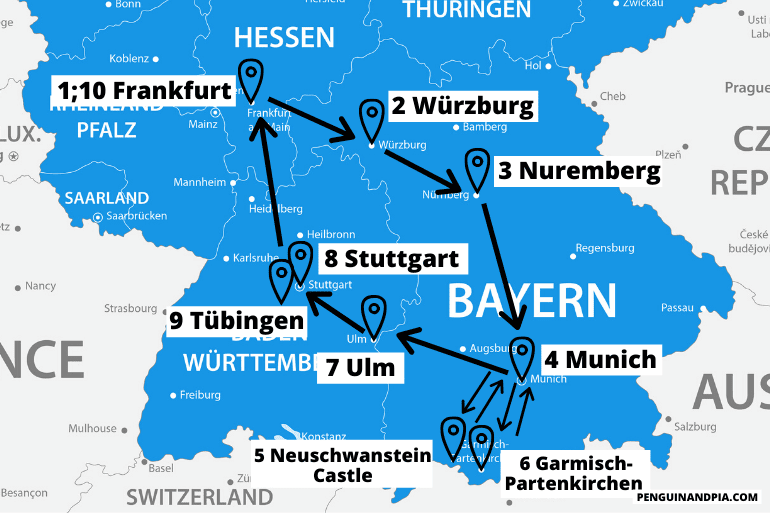
Day 1: Frankfurt Day 2: Würzburg Day 3: Nuremberg Day 4: Munich Day 5: Day Trip to Neuschwanstein Castle Day 6: Day Trip to Garmisch-Partenkirchen Day 7: Ulm Day 8: Stuttgart Day 9: Day Trip to Tübingen Day 10: Frankfurt
Similar to the northern version of this itinerary for 10 days, you begin your adventure in Frankfurt. During your day in the city, you shouldn’t forget to visit the Römerberg with the beautiful half-timbered houses. If you want to get a nice few of the city from above, then you should look into visiting the Main Tower as well.
Frankfurt is also a great place to pick up your rental car – if you decide to complete this itinerary by car instead of using public transport. You can either pick up a car at the airport or at different spots in the city centre. This obviously also depends on the rental company you choose.
Accommodation in Frankfurt: Frankfurt is full of accommodation options – from the city centre to the airport. You can check here for accommodations and hotels in Frankfurt .
For a hotel in the heart of the city, check out the Motel One Frankfurt-Römer . Complete with underground parking, good breakfast, and a top location in the centre and close to the river, this hotel is a decent option if you are travelling around with a car.
For those not travelling with a car (and taking the trains around Germany), check out Fleming’s Express Hotel Frankfurt . This nice looking hotel is really popular for its breakfast, price, and the fact that it’s steps from the central train station.
Day 2: Würzburg
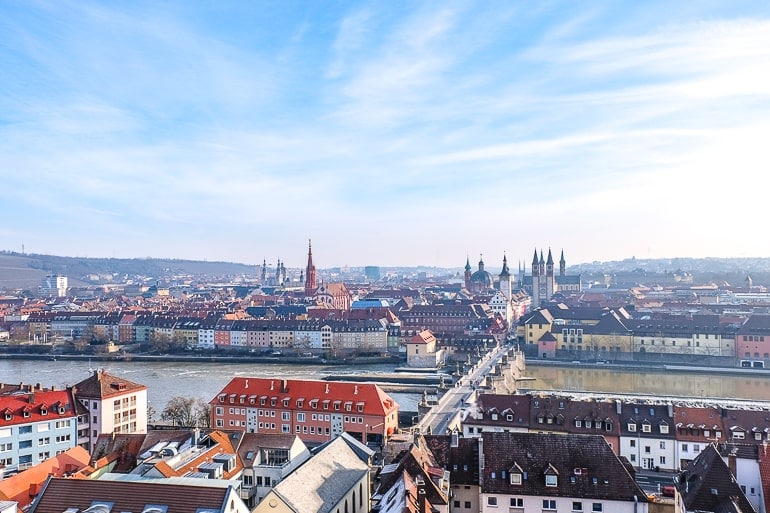
On day two of this itinerary, you’ll be on your way to Würzburg, a small German city that we’re always happy to return to. Similar to Stuttgart, Würzburg is located in a region that is known for its wine.
As such, it comes as no surprise that a highlight in Würzburg is to drink a glass of (white) wine on the Old Bridge across the Main river. We’ve done that multiple times and would especially recommend it during the evening when it gets dark.
Another thing you shouldn’t miss in Würzburg is the short walk up the hill to Marienberg Fortress. Up there you can not only explore the old fortress, but you also get a beautiful view of the old town and other parts of the city.
We actually wrote a whole guide about Würzburg (link below) where we not only talk about things to do but also mention some great cafes and restaurants!
The drive from Frankfurt to Würzburg will be a short one. It should only take you around 1 h 20 minutes by car and between 1 h 07 minutes and 1 hr 50 minutes by train depending on the type of train you’re taking (ICE vs. regional train).
Accommodation in Würzburg: Würzburg isn’t a huge city so you’ll find a number of places to stay packed together in the city centre and a number of other hotels and guesthouses around. You can check here for accommodations and hotels in Würzburg .
On a recent trip, we stayed at the Best Western Hotel Würzburg-Süd . It’s a little south of the city centre but the tram stop is right outside the hotel so you’re into the historic city centre in minutes. There is also an onsite parking lot if you’re arriving to Würzburg by car. We booked this one last minute but we would stay again.
If you want to stay a little more central, then you can check out Hotel Strauss . With a location close to the river, the train station, and the city centre – it’s a great option fo those arriving by train.
We also once stayed at Hostel Babelfish for a budget accommodation and it was honestly not too bad, either. It’s right across from the train station for easy access in and out of the city.
Must-see Attractions in Würzburg:
- Marienberg Fortress
- Würzburg Residence
If you want more tips for visiting Würzburg, have a look at our detailed Things to do in Würzburg Guide (+ insider tips) .
The next day you’ll be on your way to Nuremberg, which is another city in Bavaria that we really like. In German, Nuremberg is actually written/called “Nürnberg” – just an FYI, so you’re not confused when you see this written somewhere.
As we have already mentioned in the description of one of the shorter itineraries, there is a lot of history to be found in the city. Not only can you explore an old castle in the middle of the city, you can also learn a lot about Germany’s dark history if you’re interested.
Getting from Würzburg to Nuremberg will take approx. 1 hr 20 minutes by car and between 53 minutes (ICE) and 1 hr 13 minutes (regional) by train . If you’re travelling with more people and decide to just take a regional train, look into getting a “Bayernticket” as that could save you some money.
Accommodation in Nuremberg : Nuremberg is a larger and well-travelled city in Germany so you will have no problem finding a place to stay! You can check here for accommodations and hotels in Nuremberg .
We ended up staying in the very popular Five Reasons Hotel and Hostel and we enjoyed our stay. The room was bright with new furnishings. It’s also located just inside the old city walls so we were close to the metro, a short walk to central train station, and also close to the heart of the old town!
Very nearby was the Sheraton Carlton Nuremberg – we had friends stay there. They really liked this hotel which had a swimming pool with city views and other great perks. If you are arriving to Nuremberg by car, there’s a parking lot across the street from the hotel as well as street parking around. The train station is very close as well so it’s a great location overall.
- Documentation Center Nazi Party Rally Grounds
Day 4: Munich
On day four of this Germany trip, you’ll be on your way to Munich. As you might know Munich is the capital of the German state called Bavaria and there are lots of things to do in this city.
That’s why you’ll spend three nights in Munich. This way you can explore the city in more detail if you want or go on a couple of day trips from Munich to see other popular attractions as well. It’s really up to you.
The journey from Nuremberg to Munich won’t be overly long and it’s a route Lisa has driven many times. It’ll take you around 2 hrs by car (of course traffic depending) and between 1-3 hrs by train.
Since this is a popular train route, there are lots of different connections of varying length – some are quick and others are slower trains with more stops. Since that’s the case, we’d recommend that you plan in advance and try to catch a better connection to avoid an unnecessarily long train ride!
Accommodation in Munich: Since Munich is such a popular and large city, there are plenty of accommodation options for you to choose from. You can check here for accommodations and hotels in Munich . Just remember to book your accommodation for three nights if you are following this itinerary!
We stayed at the H2 Hotel München Olympiapark which is a very popular hotel because of the price and the value. It was a prefect stay. The breakfast was amazing, they had parking, and the location was great – only a quick metro to the heart of the city centre. You also have the Olympic Park and BMW Museum as top attractions nearby!
If you’re itching to stay right in the heart of the action in Munich, check out the Platzl Hotel Superior . This is a hotel around the corner from Marienplatz in the old town with the famous beer hall Hofbräuhaus just steps away. The central train station is also walkable from here.
Of course, you can learn all about the best areas to stay in more detail with our Munich accommodation and neighbourhood guide .
Learn more about Munich with our one day in Munich post!
Day 5: Day Trip to Neuschwanstein Castle
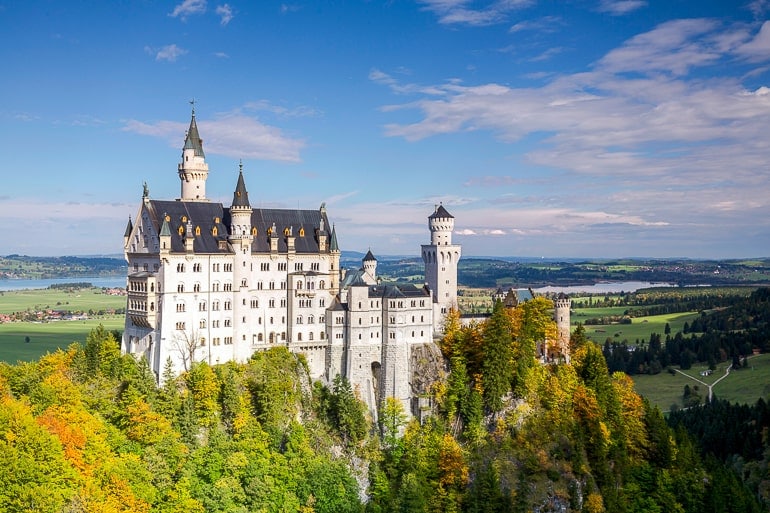
Neuschwanstein Castle probably doesn’t need a lot of introduction – it is arguably one of the most popular day trips from Munich. If you want to see this fairy-tale castle with your own eyes, then this day trip might be for you.
However, it is such a popular attraction that depending on the time of year it can get incredibly crowded. So if you are planning this itinerary for the middle of summer, we’d honestly recommend that you think twice about whether you really want to do this day trip. A second day in Munich wouldn’t be so bad either, would it?
If you are set on visiting Neuschwanstein Castle, then have a look at our Day Trips from Munich Guide . In that article – under the Neuschwanstein Castle section – we talk about all the different ways you can get to the castle.
In case you don’t want to stress too much about logistics and are not travelling with a rental car, you could always look into a day tour that brings you to Neuschwanstein Castle and then back to Munich. Here are some examples:
- Neuschwanstein and Linderhof Palace – A very popular tour to check out two castles in one day!
- Just Neuschwanstein Castle – Grab your live guide and check out the classic castle you came to see!
- Neuschwanstein Castle and Füssen – Explore the surrounding area on this day trip + see that great castle!
Day 6: Day Trip to Garmisch-Partenkirchen
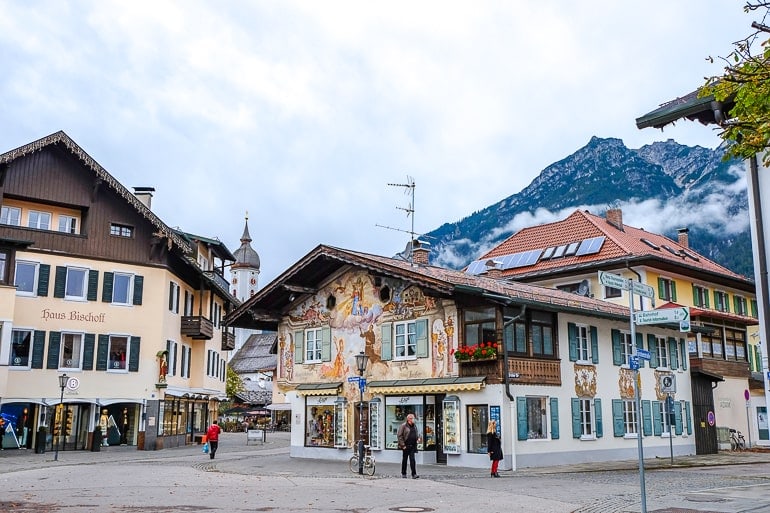
Another popular day trip from Munich – and the one we would recommend for Day 6 of this itinerary – is a trip to Garmisch-Partenkirchen in the south of Bavaria, close to the Austrian border.
We have been to Garmisch-Partenkirchen recently and really enjoyed our day there. However, that was during the shoulder season, so we can’t really say much about how busy it gets in the summer or during the ski-season.
There are a few good reasons for visiting Garmisch-Partenkirchen. The obvious one is that the town is super close to the mountains and it is very easy to reach the “Zugspitze” (Germany’s highest mountain) from here.
Of course, you don’t have to go that high up – there are also lots of other mountains and great hiking trails in the area if you’re looking for a day in nature.
Other reasons why people come to Garmisch-Partenkirchen is to visit the Partnach Gorge which is quite beautiful and/or the old town where you can admire the decorative paintings found on many houses.
It’s actually quite easy to get from Munich to Garmisch-Partenkirchen. By car , it should take you around 1 hr 10 minutes and by train the journey would be approx. 1 hr 22 minutes . It’s actually a nice drive/train ride since you’ll get some great views of the mountains as you get closer to your destination.
Must-see Attractions in/close to Garmisch-Partenkirchen:
- Partnach Gorge
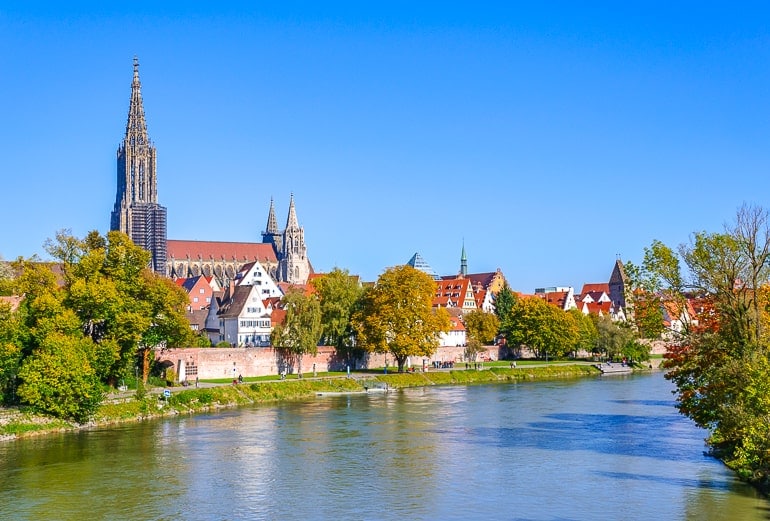
The following day you’ll travel from Munich to Ulm, a small city in the German state of Baden-Württemberg. It is actually located right by the border with Bavaria – “Neu Ulm” in fact is a city on the Bavarian side. When you’re there, it sometimes feels like it is just one bigger city. For you as a visitor, this doesn’t really matter – just an interesting side note.
Ulm is mainly known for having the church with the tallest steeple in the world – so that is something you shouldn’t miss during your visit. Other than that, we’d also recommend that you check out the Fishermen’s Quarter where you can find some beautiful, half-timbered houses.
Getting from Munich to Ulm won’t take you long. The journey will take approx. 1 hr 40 minutes by car and between 1 hr 19 minutes and 2 hrs by train. Once again, this depends on which type of train connection you choose (ICE vs. regional trains).
Accommodation in Ulm: It’s best to stay in the centre of Ulm since it’s not huge and the attractions can mostly be found there. You can check here for accommodations and hotels in Ulm .
For a boutique hotel option right in the city centre, check out Boutique 005 Ulm City . This hotel is super walkable to the train station if you are arriving by train but also offers an option for parking. It’s location makes it really close to all the top attractions in the city.
For a stay closer to the river, you can check out the Hotel am Rathaus – Hotel Reblaus . With onsite parking available and a really good breakfast, this more “authentic” hotel is an experience not to be missed in Ulm.
Must-see Attractions in Ulm:
- Ulmer Münster
- Fishermen’s Quarter
Day 8: Stuttgart
From Ulm, you’ll head to Stuttgart on the next day. Stuttgart is a city that we have mentioned a few times in this article already. If you’ve read some of the other itineraries, you’ll know that Stuttgart is known for both cars and wine.
Of course, there’s more to see in the city than that. If you’re interested in architecture, you might enjoy visiting the New Palace at the “Schlossplatz” and if you’re into art, the Staatsgalerie (an art museum) might be for you.
Getting to Stuttgart from Ulm will only take slightly over 1 hr by car and approx. the same amount of time by train . There are slower trains – called RB instead of RE which stands for “Regional Express” – that take longer than that. However, if you plan ahead, you shouldn’t have a problem catching an RE or ICE Train since they run frequently throughout the day.
Accommodation in Stuttgart: Since there are a number of places to stay in, you can check here for accommodations and hotels in Stuttgart .
Those with a car can check out the Abalon Hotel ideal because it has an underground parking garage while those travelling to Stuttgart by train can check out the Pension am Heusteig since it’s easy to get to walking or with the metro.
Day 9: Day Trip to Tübingen
On day 9 of this itinerary, you have the choice between either spending a second day in Stuttgart or taking a day trip to Tübingen, a university town not far away.
Tübingen is a popular day trip from Stuttgart and is mainly known across the country for its old university. In fact, some of Lisa’s friends have studied there. When in town, you shouldn’t forget to visit the market square with its 15th century town hall. Another popular attractions is the Hohentübingen Castle on the hill which nowadays is home to a museum.
It won’t take you long at all to get to Tübingen from Stuttgart. That makes it great for a (half-)day trip. The journey should only take around 42 minutes by car and between 43 minutes and 1 hr 30 minutes by public transport – depending on the connection you choose.
Must-see Attractions in Tübingen:
- Hohentübingen Castle
- Market Square with Town Hall
- Hölderlinturm
Day 10: Frankfurt
On the last day, you’ll make your way back to Frankfurt. This is where your itinerary ends since it will hopefully be easy for you to get back home from here.
The journey from Stuttgart back to Frankfurt will probably be the longest one for this trip – but it’s still easily doable. It should take you approx. 2 hrs 25 minutes by car and between 1 hr 17 minutes and 3 hrs 30 minutes by train. Once again, this is dependent on the connection you choose (ICE vs. regional trains).
Accommodation in Frankfurt: Since you’re back in Frankfurt, we already went over accommodations in Day 1 of this same itinerary. That said, you can check here for accommodations and hotels in Frankfurt and specifically check out the Motel One Frankfurt-Römer for a central hotel with parking.
Germany Itinerary 14 Days
This Germany itinerary is the longest one that we have for you – for now. If anyone is interested in a 21 day version, please let us know!
The distance you’d cover with this 14 day itinerary would be around 1960 kilometres . The driving time would be approx. 22.5 hours – but of course, this varies depending on traffic and the exact route you decide to take.
As you’ll see below, sometimes the driving time between two cities is longer than 3 hours. So, while this itinerary is totally doable in two weeks – if you wanted to slow down the pace a bit, you could just as easily spend more time in some of the cities and complete the itinerary in more days.
Since you have probably already read about most of these places in some of the itineraries above, we’ll try to keep the descriptions short and not get too repetitive.
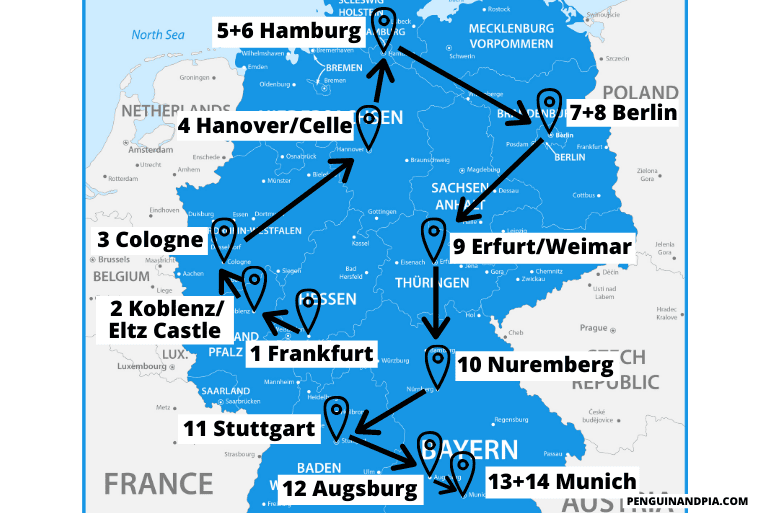
Our version here is written as an “incomplete route” from Frankfurt to Munich. However, as with most of our itineraries, you are welcome to reverse the direction if that works better for you and/or start and end in the same city. So, to see a big part of the country, your 14 day Germany itinerary could look something like this:
Day 1: Frankfurt Day 2: Koblenz / Eltz Castle Day 3: Cologne Day 4: Hanover or Celle Day 5+6: Hamburg Day 7+8: Berlin Day 9: Erfurt or Weimar Day 10: Nuremberg Day 11: Stuttgart Day 12: Augsburg Day 13+14: Munich
Once again we begin this itinerary in Frankfurt since it is an easy city to get to. As we have mentioned before, there are a few things to see in the city so you can start exploring on day one!
Frankfurt is also a great city to pick up a rental car. Since many international (business) travellers fly into Frankfurt, there should be many cars available with automatic transmissions. In smaller German towns you’ll find that this is not always the case.
Accommodation in Frankfurt: If you are making a stop in Frankfurt, you can check here for accommodations and hotels in Frankfurt .
As for accommodation options, the Motel One Frankfurt-Römer has parking available and is located in the city centre close to the Main River. That’s important if you have a car with you but it’s also walkable to the train station, so you know.
Another great hotel option that is even closer to the train station is Fleming’s Express Hotel Frankfurt . This hotel is known for its prime location to the north of the station, its tasty breakfast, nice decor, and fair price. This is definitely a popular place you should at least look into if you are travelling by train around Germany.
Day 2: Koblenz / Eltz Castle
On day two of this itinerary, you’ll be on your way to Koblenz, a small German city on the Rhine river. You can either explore the city or use it as a base to visit one of the many castles close by.
Our suggestion would be a visit to Eltz Castle which is a beautiful medieval castle surrounded by a forest. Please keep in mind that the castle is not open year round. You can check opening hours here .
You could also visit Eltz Castle as a day trip from Frankfurt but then you’d have to return to Frankfurt at the end of the day. This wouldn’t make much sense unless you want to spend some more time in Frankfurt anyway, as Cologne (your next destination) is closer to Koblenz and Eltz Castle than Frankfurt.
The drive from Frankfurt to Koblenz should take around 1 hr 30 minutes by car . If you want to take the train , the journey would take between 1 hr 30 minutes and 2 hrs 15 minutes . From Koblenz, it is only about a 30 minute drive to Eltz Castle.
Accommodation in Koblenz: Since Koblenz isn’t that large, you should have no problem finding and choosing an accommodation that works for you. You can check here for accommodations and hotels in Koblenz .
If you want a popular option right in the heart of the city centre, you should see the Sander Hotel . This hotel is located within walking distance to the rivers as well as restaurants and shops in the centre. If you travel by car to Koblenz, they have onsite parking which is handy. That said, you can also easily walk from the hotel to the train station in minutes.
Day 3: Cologne
The next stop on your 14 day Germany itinerary is Cologne, a city we have mentioned already in some of the previous itineraries. As you might know, the highlight of the city is the Cologne cathedral which is quite an impressive sight. As the city is located on the Rhine river, a boat tour might also be a great activity depending on the time of year you are visiting.
Getting to Cologne from Koblenz takes around 1 hr 15 minutes by car and between 50 minutes and 1 hr 15 minutes by train . The train tracks follow the Rhine river for part of the journey which allows for some beautiful views!
Accommodation in Cologne : There are lots of great places to stay in Cologne. You can check here for accommodations and hotels in Cologne .
We recently stayed at the Lindner Hotel City Plaza which was great value for money. The breakfast buffet is incredible and it’s an easy, short walk into the city centre near the Cathedral. It also has parking available for those with a car.
If you want to stay a little closer to the river and the Old Town, check out the CityClass Hotel Residence am Dom . With many things around to keep you busy – like attractions, food, and/or drinks – you’re just a short walk to the central train station if you stay here.
For those looking for a hostel, Cologne Downtown Hostel was a great stay for Eric a number of years ago. It’s really popular, in a great location, and has a nice rooftop balcony to enjoy.
Day 4: Hanover or Celle
Day 4 of this itinerary will take you to either Hanover or Celle depending on your preference. Celle is a noticeably smaller city/town than Hanover and the two places are only a few minutes apart.
Getting from Cologne to Hanover will take approximately 3 hrs 10 minutes by car and between 2 hrs 40 minutes and 3 hrs 5 minutes by train .
Accommodation in Hanover: Since Hanover is a well-travelled city for people moving around Germany, there are a number of accommodation options in and around the city centre. You can check here for accommodations and hotels in Hanover .
To stay very close to the central train station in the city centre, you should see the Hotel Loccumer Hof . The location makes it great if you are travelling by train and on foot. They also have onsite parking if you are arriving to Hanover with a car!
To the south of this hotel, the Arthotel ANA Prestige am neuen Rathaus is an option right across from the New Town Hall. This hotel has a beautiful, light style and is also close to the water/parks. Complete with breakfast and onsite parking, you can’t go wrong here!
If you want to spend a night in a smaller German city instead, then Celle is a good option as it is not far from Hanover. That will make it easy to reach the next stop on your itinerary without too much of a detour. The journey from Cologne to Celle would be slightly longer and take around 3 hrs 30 minutes by car and 3 hrs 19 minutes by train .
Accommodation in Celle: Celle isn’t that big at all – so there are only a handful of places to stay. That said, there are still some great options. You can check here for accommodations and hotels in Celle .
Of note, check out Hotel Borchers . This hotel – one of only a handful located in the heart of “city centre” is a top pick with a tasty breakfast and an underground car park. You can also walk there from the Celle train station which is located not too far across town.
Must-see Attractions in Celle:
- Celle Castle
- Bomann Museum
- French Garden
Day 5+6: Hamburg
An itinerary across a large part of the country wouldn’t really feel complete without including Hamburg. Since there is quite a bit to see in this hanseatic city, you’ll spend two nights in the city to give you more time to explore.
Getting from Hanover to Hamburg will take you approx. 1 hr 45 minutes by car and between 1 hr 15 minutes and 2 hrs 30 minutes by train . As mentioned before, this varies depending on the type of train connection you choose.
The journey from Celle to Hamburg will be approximately 15 minutes shorter at 1 hr 30 minutes by car . If you opt for the train, you can expect travel times between 1 hr 10 minutes and 2 hrs .
Accommodation in Hamburg : Since Hamburg is a well-travelled city, it makes sense that there are loads of places and areas to stay in. You can check here for accommodations and hotels in Hamburg .
The Mövenpick Hotel Hamburg might work for those with a car since they have onsite parking. This old water tower is a different hotel than you might be used to but it’s a great experience overall.
Something closer to the central station to get to on foot would be the ARCOTEL Rubin Hamburg which is located in St. Georg. This is an area with shops and restaurants and is very much part of the city centre.
Those looking for a budget accommodation can check out Generator Hamburg which is a popular hostel close to the train station. If you’re ever unsure or want more advice, we have a detailed guide on where to stay in Hamburg .
Day 7+8: Berlin
Of course, we couldn’t forget to include a stop in the capital of the country when planning a longer trip through Germany. Since there is so much to do and see in Berlin you will spend two nights there.
This will also give you some more time to recover from all the driving you have done so far on this journey. Getting from Hamburg to Berlin takes approximately 3 hrs 20 minutes by car (obviously traffic depending) and just about 1 hr 50 minutes by train .
Accommodation in Berlin : There are lots of hotel options in Berlin. You can check here for accommodations and hotels in Berlin .
The Park Plaza Wallstreet Berlin Mitte is a good option in the city centre for those coming to Berlin with a car while the NH Collection Berlin Mitte am Checkpoint Charlie is located right at the attraction “Checkpoint Charlie” in the city centre.
A great option for a hostel/hotel where Eric stayed a few years back is PLUS Berlin . You can find it near the famous East Side Gallery which is a very popular attraction to check out.
As mentioned a few times now, we also have more articles on t hings to see in Berlin and a one day Berlin itinerary .
Day 9: Erfurt or Weimar
For the following day you have the choice between Erfurt or Weimar as your next destination. Both are small cities in the state of Thuringia with Weimar being smaller than Erfurt. If you know anything about Martin Luther, an important figure in the Protestant reformation, then you might have heard of one or both of these places before.
If you’re looking for a place with a beautiful old town and some nice churches as well as buildings for you to explore, then we’d really recommend Erfurt. We had a great time during the days we spent there. The city also has some really nice, cozy cafes if that is something that you care about.
Getting to Erfurt from Berlin will take a while – but it is a great stop on the way to the south of Germany. You can expect the journey to take approx. 3 hrs 40 minutes by car and just around 1 hr 50 minutes by ICE (fast train) .
Accommodation in Erfurt: With Erfurt being a smaller city with a smaller central area to explore, finding a place to stay isn’t too difficult. You can check here for hotels and accommodations in Erfurt .
When we visited Erfurt, we booked the Gästehaus in der Gotthardtstraße . This was a simple guesthouse with a nice host and cozy rooms located just a short walk north of the Krämerbrücke. There’s also a small parking lot onsite if you’re coming to Erfurt with a car.
For a stay that is more central, check out Hotel Krämerbrücke Erfurt . It’s located basically right beside the Krämerbrücke making it a great option if you are travelling by train and you’re on foot.
Once again, if you want to learn some more about Erfurt before you visit the city, check out our detailed Erfurt Guide here .
If you instead preferred to learn some more about the well-known German writers Goethe and Schiller – or about Germany’s dark past – then you should plan to visit Weimar instead.
Two of the highlights there are Goethe’s and Schiller’s House – now turned into museums. Close to Weimar there’s also the Buchenwald Memorial which was a former Nazi concentration camp. This was the first KZ-Memorial Lisa ever visited. It was a somber experience, but also an important one in regards to understanding more about Germany’s past.
The journey from Berlin to Weimar will be slightly shorter than to Erfurt – at least by car. It’ll take approx. 3 hrs 15 minutes by car and around 2 hrs 20 minutes by train .
Accommodation in Weimar : There are a handful of places to stay in Weimar since it’s a smaller city – but you still have good options. You can check here for accommodations in Weimar .
In particular, check out Amalienhof Hotel und Apartment . This classic and very popular hotel is just south of the heart of the city centre. It features parking onsite and an excellent breakfast. It’s also not too far to walk to the train station if you are arriving on foot.
Must-see Attractions in/close to Weimar:
- Buchenwald Memorial
- Goethe’s House
- Schiller’s House
Day 10: Nuremberg
On day 10 of your itinerary, you’ll drive – or take the train – from Erfurt/Weimar to Nuremberg. This Franconian city has also been mentioned in some of the shorter itineraries.
The journey from Erfurt to Nuremberg will take approx. 2 hrs 40 minutes by car in a southern direction. The drive from Weimar to Nuremberg will just be a couple minutes longer.
If you decide to take the train, the journey would take between 1.5 hrs and 2 hrs from Weimar and between 1 hr 10 minutes and 1 hr 30 minutes from Erfurt .
Accommodation in Nuremberg : Nuremberg is a city with loads of history and attractions so it’s very popular. As such, you will find hotels and accommodations all over the city – from the old town to the surrounding areas. You can check here for accommodations and hotels in Nuremberg .
We booked a stay at Five Reasons Hotel and Hostel and we would recommend it. You can find the place inside the massive old city walls so the location was great – walkable to the central train station and also to go find top attractions.
On the same trip, friends of our stayed at the Sheraton Carlton Nuremberg . It was close to where we stayed and they really enjoyed it. There’s this great pool on an upper floor with city views as well as a parking lot across the street if you travel to Nuremberg by car. The train station is close as is the old town by walking so it’s great option overall, too.
Day 11: Stuttgart
The following day you will be on your way from Nuremberg to Stuttgart – once again, a city we have mentioned multiple times now during this article. From Nuremberg, it’ll take you around 2 hrs 15 minutes by car and between 2 hrs 10 minutes and 2 hrs 30 minutes by train to get to Stuttgart.
As we’ve mentioned before, if you are driving and have the time, you could take a small detour and stop in Rothenburg ob der Tauber for a stroll through its beautiful old town. We’ll leave that up to you!
Accommodation in Stuttgart: You can check here for accommodations and hotels in Stuttgart .
The Abalon Hotel ideal has parking for those with a car while the Pension am Heusteig is a guesthouse close by but is easy to get to by the metro system if you arrive by train to central station and you are walking.
Day 12: Augsburg
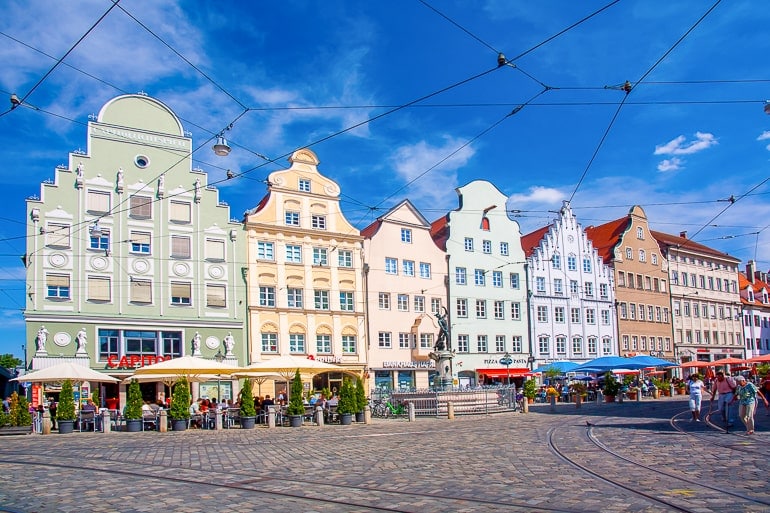
On day 12 you’ll be on your way from Stuttgart to Augsburg, a small city in Bavaria and one of Germany’s oldest cities. Around Germany, most people have heard of Augsburg because of its “Fuggerei” – a historic social housing complex where rent has increased very slowly over the centuries. It’s certainly worth a visit!
It’ll take you around 2 hrs by car to get from Stuttgart to Augsburg. If you opt for the train , then you can expect the journey to take approx. 1 hr 40 minutes .
Accommodation in Augsburg: In Augsburg, you will find a number of places to stay around the city centre. You can check here for accommodations and hotels in Augsburg .
For a reliable stay, check out Hotel Augusta . This popular hotel – located right in the city centre – features breakfast and has parking available if you are travelling to Augsburg by car.
The nice thing about Augsburg is that because it’s a smaller city, you can easily walk to the hotel from the train station if you are arriving by train.
You might also check out City Hotel Ost am Kö which is another hotel in the heart of the centre walkable to the station. It also has breakfast and parking garage right nearby.
Must-see Attractions in Augsburg:
- Augsburg Cathedral
- Perlach Tower
Day 13+14: Munich
On your second to last day of this itinerary you will drive from Augsburg to Munich. That’s the last stop on your two week Germany adventure. In Munich, there is more than enough to see to spend two days in the city.
Munich also has an airport with good international connections in case you’re coming from overseas and need to take a plane to get back home. If that’s not the case, we’d encourage you to see whether the train would be an alternative to get you back home as well.
The journey from Augsburg to Munich should take just less than 1 hr by car and between 30 and 48 minutes by train. So it’s certainly one of the shortest transitions mentioned in this article.
Accommodation in Munich: If you’re exploring Munich while in Germany, there is no shortage of places to stay and areas to check out. You can check here for accommodations and hotels in Munich . For this itinerary, remember to book your Munich accommodation for two nights.
We really liked our stay at the H2 Hotel München Olympiapark . From the really good breakfast, nice rooms, and excellent location with metro access nearby – you cannot beat the price for Munich. There’s also parking available if you’re travelling with a car to Munich.
For a spot right in the heart of Munich’s charming old town, check out the Platzl Hotel Superior . This is a trendy hotel that puts you super close to all the action at busy Marienplatz and is steps from Hofbräuhaus, the beer hall made famous decades ago. You can also catch the metro or walk to the central train station from here.
If you are looking for more details on accommodations in this city, we wrote a detailed guide on where to stay in Munich .
To learn more about the city – as we have mentioned before – check out our post on Munich in a day if you want more details about the city!
And there you have it – one massive Germany guide with more than one Germany itinerary to suit your travel needs! Whether you’re looking for a short 5 day or a wild 14 day itinerary – we’re sure you’ll have a great time exploring Germany. We’re actually really happy to have created this post – Lisa especially. It’s always fun to help others explore your home country!
As always, Happy Germany Itinerary Waddlin’, – L&E
- Compare flights on Skyscanner
- Check for Hotel Deals or Book A Hostel
- Get A Rental Car (depending on the destination)
- Research plug types and possibly get a travel adapter
- Go over our packing list
Pin it for later!

As an Amazon Associate we earn from qualifying purchases.
Destinations
Privacy policy
Disclaimer & Affiliate Disclosure
Terms of use
© 2024 Creativlier Media Inc.

How to Travel Through Europe by Train Like a Pro
Last Updated on June 8, 2023
Traveling through Europe by train is a wonderful experience that offers a unique and authentic way to explore the continent. It is a cost-effective and sustainable way to travel that gives you a chance to see the breathtaking scenery of Europe.
However, train travel can also be overwhelming for first-timers. That’s why we’ve put together this guide on traveling through Europe by train like a pro.
Make an Itinerary
The first step to traveling through Europe by train like a pro is to plan ahead. Research your destinations and create a rough itinerary of the places you want to visit, as well as the duration of your stay. You can use websites such as Rail Europe or Eurail to plan your train journeys and book tickets in advance. This can save you money, time, and heartache on your adventure!
Buy a Rail Pass
If you plan to take multiple train journeys during your trip, buying a rail pass is worth considering. A rail pass allows you to travel on most trains in Europe without purchasing individual tickets for each journey. Different types of rail passes are available, depending on the length of your trip and the countries you want to visit.
Utilize Nearby Luggage Storage
When traveling through Europe by train, you may find yourself in a situation where you need to store your luggage temporarily. This can happen if you arrive at your destination before your hotel check-in time or want to explore a city without carrying heavy bags.
Fortunately, many train stations in Europe offer luggage storage facilities. For example, if you’re spending the day in St. Pancras, simply look for luggage storage in St. Pancras . Now, you can explore the city with peace of mind — and no heavy bags weighing you down.
Choose Your Train
When traveling through Europe by train , you can take high-speed trains, regional trains, or overnight trains. High-speed trains, such as the Eurostar or TGV, are faster and more expensive than regional trains. However, they are a smart option for longer journeys or days you want to travel between two distant cities in a short amount of time.
Regional trains, on the other hand, are slower but cheaper. They are an option if you want to explore smaller towns and villages along your route. Overnight trains, such as the Nightjet, allow you to save time and money by combining transportation and accommodation.
One of the advantages of traveling through Europe by train is the ability to easily move from one place to another. However, this can be difficult if you are carrying a heavy suitcase. Therefore, it is important to pack light and only bring the essentials. A backpack or a small suitcase is ideal for train travel.
Arrive Early
You should arrive at the train station at least 30 minutes before your train departure time. This allows you to find your platform, check the train timetable, and board the train stress-free. After all, when a train says it leaves at 10:00, you best believe it’ll be on the move promptly at 10:00.
Additionally, arriving early can give you time to grab a coffee or a snack from one of the many cafes at the train station.
Validate Your Ticket
If you have purchased individual train tickets, don’t forget to validate them before boarding the train. You can do this at the yellow validation machines located at the train station. Failure to validate your ticket can result in a fine if you are caught by a ticket inspector on the train.
Keep Your Ticket Handy
Once you have boarded the train, it is important to keep your ticket handy. Ticket inspectors may ask to see your ticket any time during the journey, so it is best to have it easily accessible. Additionally, some trains have a designated area for luggage storage, so be sure to keep your bags in the appropriate area.
Bring Your Own Food
While some trains have dining cars or food carts, it is always a good idea to bring your own food and snacks for the journey. This can save you money and ensure that you have something to eat if the train has no food options or limited options.
Enjoy the Scenery
Last but not least, one of the most important things to remember when traveling through Europe by train is to take the time to enjoy the scenery. Europe is home to some of the world’s most beautiful landscapes and architecture, and traveling by train allows you to see it all from a unique perspective.
Happy Travels!
Traveling through Europe by train is a fantastic experience that offers a unique and authentic way to explore the continent. With these tips, you can travel like a pro and make the most of your journey. Remember to plan ahead, pack light, and most importantly, enjoy the beautiful scenery along the way.
Related posts:
- Why you should travel by train in Europe (and how to book tickets)
- Exploring France by train: Our top five train rides in France
- How to Travel around Europe on the Cheap
- Things to Know Before You Board a Train from Vienna to Prague

Politics latest: Angela Rayner labels Rishi Sunak a 'pint-sized loser'; PM insists defence spending pledge 'fully-funded'
While Rishi Sunak spent the day heralding his defence spending commitment on a trip to Germany, Oliver Dowden and Angela Rayner stood in the prime minister and the Labour leader at PMQs.
Thursday 25 April 2024 02:05, UK
Please use Chrome browser for a more accessible video player
- Sunak insists rise in defence spending is 'fully-funded'
- Beth Rigby: PM seeking to position himself as a strong leader prepared to defend the country
- Sophy Ridge: There are cracks underneath the apparent unity on defence spending
- Rayner presses Dowden on no-fault evictions - and raises Sky News report - after joke about 'obsession' with her living arrangements
- Labour deputy leader labels Sunak a 'pint-sized loser'
- Local elections: Sam Coates on why they matter | Who can I vote for? | What Sunak and Starmer will be hoping for
- Live reporting by Tim Baker
That's it for today.
We're wrapping up the Politics Hub, but make sure to join us again tomorrow.
And remember, at 7pm tomorrow there's a special episode of the Politics Hub with Sophy Ridge.
It will come live from one of our Target Towns, Grimsby, and will feature brand new polling and a live audience.
Before you go, here are some of today's main stories.
By Alexandra Rogers , political reporter
Defence Secretary Grant Shapps has said he wants the new NATO target for defence spending to increase from the current 2% of gross domestic product to 2.5%.
Mr Shapps said it would make a "real difference" if the countries signed up to the military alliance met his proposed target.
He told Kay Burley on Sky News: "We're now saying we think that should be 2.5%. We think in a more dangerous world that would make sense.
"I will be arguing that, and I know that the prime minister feels strongly about it, when we go to the NATO 75th anniversary summit which is in Washington DC."
The defence secretary's intervention comes after Rishi Sunak pledged to increase UK defence spending to 2.5% of GDP by 2030 to tackle the "growing threats" posed by hostile states including Russia, Iran and China.
Speaking alongside NATO Secretary General Jens Stoltenberg at a press conference in Warsaw yesterday, the prime minister said he planned to steadily increase defence spending by the end of the decade, rising to 2.4% a year until 2027-28 - then hitting 2.5% by 2030-31.
Funding will rise from £64.6bn in 2024 to £78.2bn in 2028, and then jump to £87bn in 2030-31.
Read more here:
"There isn't a single safe prosecution brought by the Post Office in the last couple of decades," Conservative MP and former minister David Davis has told Sky News.
He was responding to comments made by a lawyer representing former sub-postmasters, who told Sky News the Post Office scandal extends "greatly beyond" faulty Horizon software (see previous post).
Paul Marshall said problems with other systems which have been "overlooked" mean there are "no convictions" secured by the Post Office against any sub-postmaster "that could or should properly be treated as safe".
Sir Davis says although the government has done a "great deal already" to exonerate Horizon victims, "we probably have to do more".
He cites a report which he says found there are other cases that "at least deserved a very close look and probable exoneration, and that didn't happen".
He estimates the courts could go through " nearly all the cases in three or six months if we set ourselves the task of doing it".
He describes the Post Office as "a public body which wasn't serving the public".
By Adele Robinson , business correspondent
The Post Office scandal extends "greatly beyond" faulty Horizon software, according to a lawyer for victims.
Paul Marshall, representing former sub-postmasters, says problems with third party systems in branches, such as ATMs, have been "overlooked".
A 2013 report commissioned by the Post Office, and not made public at the time, states: "Removing the ATM reduces the risk of (the sub-postmaster) being suspended... as does the presence of lottery tickets, (banking) services, and DVLA processing."
It indicates there were issues known to the Post Office with third party systems within branches - separate to Horizon software.
Barrister Paul Marshall believes, as a result, there are "no convictions" secured by the Post Office against any sub-postmaster "that could or should properly be treated as safe".
He says evidence of third party errors, such as ATMs, shows "the scandal extends considerably beyond, greatly beyond, it might be said, the limited focus of bugs in Horizon".
Blanket exoneration legislation being introduced this summer will only quash convictions brought about "by erroneous Horizon evidence".
Mr Marshall asserts that postmasters who have had appeals against convictions rejected by the Court of Appeal may have lost because their offences didn't fall within the "narrow scope" of Horizon issues.
By Daniel Dunford , senior data journalist
There might not be a general election just yet, but there are important votes that will define how the areas around us are run for the next four years.
See what's happening where you are here:
With a general election looming, what counts as gains and losses for the main parties in next week's locals?
Sky's election analyst Michael Thrasher tells us what to look out for:
The Sky News live poll tracker - collated and updated by our Data and Forensics team - aggregates various surveys to indicate how voters feel about the different political parties.
With the local election campaign well under way, Labour is still sitting comfortably on a roughly 21-point lead, averaging at 43.5% in the polls, with the Tories on 23.5%.
In third is Reform UK on 12.2%, followed by the Lib Dems on 9.3%.
The Green Party stands at 6.3%, and the SNP on 3.0%.
See the latest update below - and you can read more about the methodology behind the tracker here .
By Beth Rigby , political editor
This was a trip with two aims: to refocus the world's attention on Ukraine and announce a big boost in defence spending - with an eye, of course, on national security, but also on the general election.
When it comes to Ukraine, this was a co-ordinated effort across the Atlantic.
As Rishi Sunak arrived in Berlin, overnight in Washington the US was finally approving a $600m military aid package for Kyiv.
This was all designed to send a message to Russia - allies are in lockstep and will stand behind Ukraine for as long as it takes.
The prime minister used the Poland leg of the trip to commit the UK to spending 2.5% of GDP on defence by 2030, while in Berlin, Mr Sunak announced a formal bilateral security partnership with Germany to deepen co-operation on defence and military manufacturing.
It was all part of his agenda to position himself as a wartime leader, speaking of the UK's defence industry going onto a war footing as Europe stood at a turning point.
"The world we are living in is increasingly dangerous and the axis of authoritarian states are working together to undermine our security," he told his audience in Berlin.
"We need to do more. Germany has done more and we have met the NATO standard [on spending], and you see global defence spending is rising."
Mr Sunak added: "I do believe we will look back at this moment in time and recognise this inflection point, where the old paradigm is no longer the case and we need to adjust for a new paradigm."
Read Beth's full analysis here:
That's all for tonight.
But make sure to join us again tomorrow - Sophy is heading to Grimsby to discuss why so many people have turned off politics.
There'll be a live audience and new polling laying out the situation in one of our Target Towns, so make sure to tune in at 7pm on Thursday.
By Jennifer Scott , political reporter
Labour's Angela Rayner has attacked the Conservatives for "obsessing" over her living arrangements while renters continue to face uncertainty over the government's promise to end no-fault evictions.
The party's deputy leader has come under scrutiny over the sale of her former Stockport home before she was an MP, with claims she did not pay the right amount of capital gains tax and may have registered to vote at the wrong address - allegations she denies.
Greater Manchester Police are now looking into the latter issue, which could be a breach of electoral rules, following a complaint from Tory MP James Daly.
But standing in at Prime Minister's Questions on the day the much-delayed Renters' Reform Bill returned to the Commons, Ms Rayner said: "I know this party opposite is desperate to talk about my living arrangements, but the public want to know what this government is going to do about theirs."
Ministers first promised to scrap no-fault evictions - or Section 21s - in April 2019, but agreed to an indefinite delay to outlawing the mechanism after a group of Conservative backbenchers, including some landlords, raised concerns that the courts were not prepared for the legal cases that could replace them.
A new clause being added to the bill by the government today would, if approved, order an assessment of the courts before any ban could be enacted. But it offers no timetable for when the probe would have to take place.
Read more below:
Be the first to get Breaking News
Install the Sky News app for free


IMAGES
VIDEO
COMMENTS
The history of rail transport in Germany can be traced back to the 16th century. The earliest form of railways, wagonways, were developed in Germany in the 16th century.Modern German rail history officially began with the opening of the steam-powered Bavarian Ludwig Railway between Nuremberg and Fürth on 7 December 1835. This had been preceded by the opening of the horse-drawn Prince William ...
Germany's rail history started modestly: the country's first line, which ran between Nuremberg and Fürth and opened in 1835, was just 6 km long. The "Adler" - the locomotive imported from Britain to operate the line - introduced a new means of travel to an astonished public: fast and comfortable, affordable for all and extremely profitable ...
As of 2021, Germany had a railway network of 33,399 kilometres (20,753 mi), of which 20,540 kilometres (12,760 mi) were electrified and 18,556 kilometres (11,530 mi) were double track. Germany is a member of the International Union of Railways (UIC). The UIC Country Code for Germany is 80.. Germany was ranked fourth among national European rail systems in the 2017 European Railway Performance ...
The history of rail transport in peninsular Spain begins in 1848 with the construction of a railway line between Barcelona and Mataró. In 1852, the first narrow gauge line was built. In 1863 a line reached the Portuguese border. By 1864, the Madrid- Irun line had been opened and the French border was reached.
But sometimes German efficiency does not match its reputation. More on The German Way. About Germany's 9-Euro Monthly Public Transport Ticket. During the summer of 2022 Germans and visitors alike could travel on local public transport and regional trains for only 9 euros a month in June, July and August.
Let's try. Railways existed as early as 1550, in Germany. These pathways of wooden rails called "wagonways" were the beginning of modern rail transport, making it easier for horse-drawn wagons or carts to move along dirt roads. Horses pulling loaded coal waggons make one final delivery along The Little Eaton Gangway wagonway (open 1795 ...
Even today, the high-speed train between the two cities is not a huge amount quicker, taking 1 hour and 43 minutes. In 1936, a Flying Hamburger broke the 200 km/h barrier, dashing between the two ...
Deutsche Bundesbahn - West Germany: 1949 - 1994. V200 Diesel Locomotive pulling a passenger train in West Germany in the early 1960s. The first task for the DB was rebuilding the damage done to the network during the war. West Germany was not subject to war reparations, so the influx of capital made reconstruction a lot easier than in the east.
One of the best ways to discover Germany is by train. The German railway system is very well developed and reliable, and you can reach almost every city in Germany by train; not to mention that watching the German landscape stream by your window is a very relaxing and comfortable way of traveling. The German National Railway is called Deutsche ...
Deutsche Bahn AG, the railway system of Germany created in 1994 by the merger of the Deutsche Bundesbahn (German Federal Railway), the state rail system in the former West Germany, with the Deutsche Reichsbahn (German State Railway), the state system in the former East Germany.At the time of German reunification, the system route length totaled about 25,800 miles (41,500 km), of which two ...
This unique train journey never ceases to amaze: soon after leaving the station in Hamburg, the route leads through the quintessential North German marshland landscapes and, shortly after, crosses the North-Ostsee Canal on the Hochdonn High Bridge, at a height of 42 metres! On a clear day, you can gaze all the way to the port facilities of ...
A guide to Germany for train travellers. A great number of visitors will be particularly interested in Germany's historical sights such as it's cathedrals and castles, or it's traditions such as Bavarian food and the beer culture. But at the same time, it is a very modern country that offers a cutting-edge music scene, superb night life ...
Local S-Bahn trains link the hauptbahnhofs to city centre locations in Berlin, Frankfurt (Main), Hamburg, Leipzig, Munchen and Stuttgart. The ICE trains travel up to 300 km/h on these high-speed routes: Berlin ↔ Wolfsburg. Seigburg/Bonn ↔ Frankfurt Flughafen. Mannheim ↔ Stuttgart.
A guide to travelling southern Germany by train with visits to Munich, Stuttgart, Heidelberg, and Nuremberg including a detailed history of the region . . . The convenience of the European rail system makes it easy to visit multiple locations in a small amount of time. This adventure was all about making a loop through the southern half of ...
Long-Distance Trains. Yes. For high-speed/long-distance trains in Germany, you should book early to get the best price—fares rise as the departure date approaches. For example, a ticket purchased on the day of travel can cost 3x-4x the price as one bought a month or two in advance. These high-speed trains include InterCity Express (ICE), ICE ...
Follow a Finland-trained itinerary for discovering rich history, stunning landscapes, and diverse culture of Germany. This blog reveals how train travel can offer the best immersive experience and ensure seamless travels across Germany. Follow a Finland-trained itinerary for discovering rich history, stunning landscapes, and diverse culture of ...
Free bus travel (reservation only) is an extra benefit of the German Rail Pass. Travel from Germany to Italy, France, Switzerland, the Netherlands, and many more countries. ... Berlin The city of Berlin is a wonderland mixed with history, culture and extraordinary landmarks. With the Eurail Pass, you can travel to the city of Berlin by train ...
Inter-city train tickets from €12.90. Deutsche Bahn (German Railways) high-speed IC and ICE trains are easily the best way to travel between major town & cities all over Germany, in comfort at ground level. DB's ICE trains travel at up to 186 mph from city centre to city centre, and if you pre-book direct with the operator you can find some ...
Cologne (Köln), Germany. The magnificent Cologne Cathedral (Kölner Dom) welcomes you when you arrive in Cologne - it lies on the doorstep of the main train station. Reach the top of the South Tower's spiral staircase and be rewarded with a sweeping view over the river Rhine. The nearby Hohenzollern Bridge is covered with love padlocks.
Relax and enjoy the journey, with no train-specific travel and the ability to make a stopover or travel at a different time. ... Discover Europe by train: 33 countries, 1 ticket, 40,000 European destinations to choose from. Select your destination Select your destination for Interrail. Go back one element Go forward one element.
Step Two: Buy Your Germany Train Tickets. The pricing of trains in Germany is dynamic, meaning the cost changes depending on when you buy it and what demand is like. It is totally bananas to me that a ticket, when booked early, can be 20 euros but if you wait until the day before/day of it can go up to 180 euros.
9 Days | 8 Nights. City. History. Arts and Culture. Travel through Germany's beautiful and historical cities by rail, from the skyscrapers of Frankfurt to the cathedrals of Cologne, from Hamburg, one of Germany's most beautiful cities to history-rich Berlin. Explore Itinerary Personalize My Tour. Starting From $3,564 per person based on ...
The total driving time for this itinerary would be about 5 hours 30 minutes with a total distance of approx. 520 km. Of course, this can change depending on the route you are taking and the time of day you are travelling. Commuter traffic could add quite a bit of travel time to your journey. Day 1+2: Berlin.
The first step to traveling through Europe by train like a pro is to plan ahead. Research your destinations and create a rough itinerary of the places you want to visit, as well as the duration of ...
If you are young and looking for a budget-friendly way to explore Europe, there's good news. The EU is giving away 35,500 free rail passes to 18-year-olds under the DiscoverEU scheme.
Image Credit: Getty Images, Frans Lemmens.Image Location: Concertgebouw, Amsterdam, Netherlands. Venice, Italy: a serenade under the stars In 1989, the band played a concert on a floating stage on the Grand Canal in Venice, an event that remains etched in the city's history.While the exact location is a common public space, taking a gondola ride at dusk with Shine On You Crazy Diamond ...
The bullet train, known as Shinkansen in Japan, is known for its efficiency as well as speeds of up to 320 kilometers per hour (200 mph). Commuters in Japan have come to expect its reliability.
By Tim Baker, political reporter. Frank Field, the former Labour MP and minister, has died at the age of 81. A statement from his family said: "He will be mourned by admirers across politics but ...